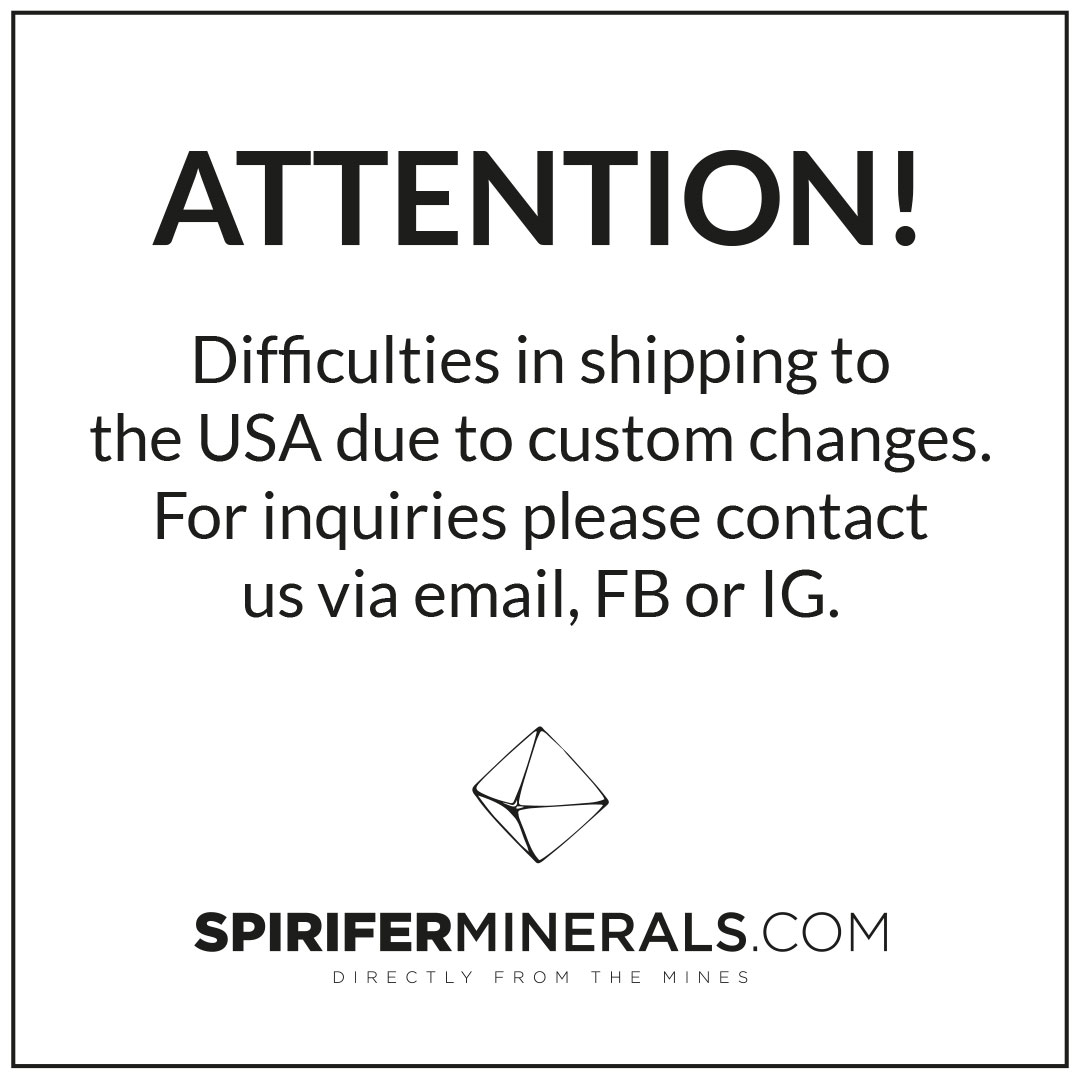STORE AUCTIONS ALL SPECIMENS ON SALE MINERALS ACCESSORIES BOOKSTORE RULES REGISTER LOGIN ABOUT US CONTACT US MAILING
SPECIMENS
now available:
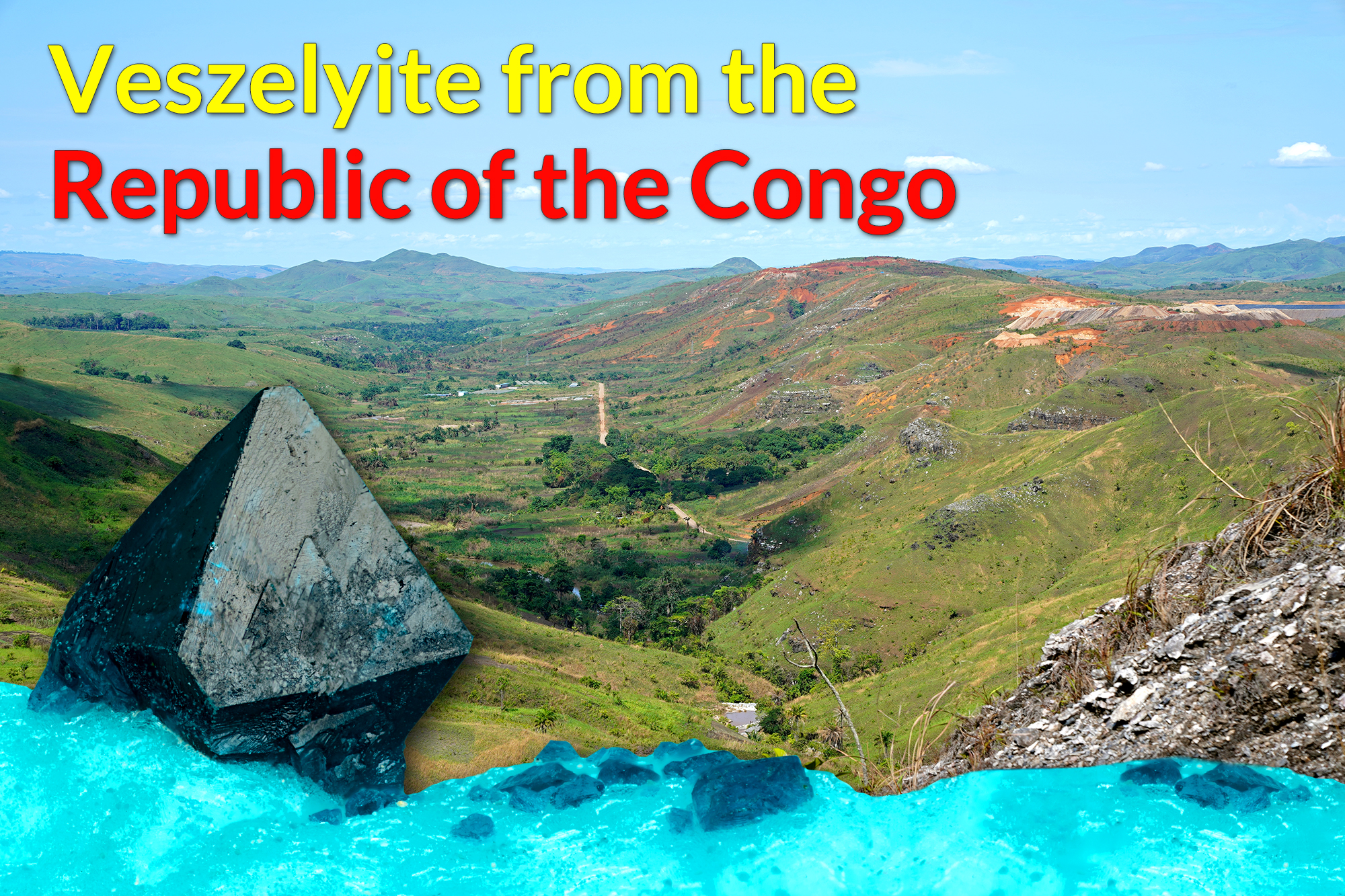
Veszelyites from Palabanda, and other recent finds from the Republic of the Congo
by Tomasz Praszkier
INTRODUCTION
Republic of the Congo, frequently mistaken with the Democratic Republic of the Congo, has been known wider as source of specimens from two localities – M'fouati and Reneville. So far the mineralogical richness of the Niari Basin has never been properly explored and documented.
For the last few years Spirifer team has been working intensively in the country, exploring both – the old and new mineralogical localities. Our research has resulted in documentation of several new occurrences. We have discovered several mineral species previously not know for the country. The correct localities for several mineral finds, mistakenly connected with the wrong locations, were determined. And we discovered spectacular veszelyite-hemimorphite mineralization from a new occurrence.
Months spent in the country by our team were full of good and sometimes not so good adventures. These include negotiations with the local partisans; dealing with really bad roads; cars in horrible conditions; the demeaning wet season weather; drinking local beer and eating interesting local food; and of course great days spent in a field with beautiful landscapes.
In this preliminary article we present a few of the places where we conducted research and briefly present the new and incredible find of veszelyite from Palabanda.
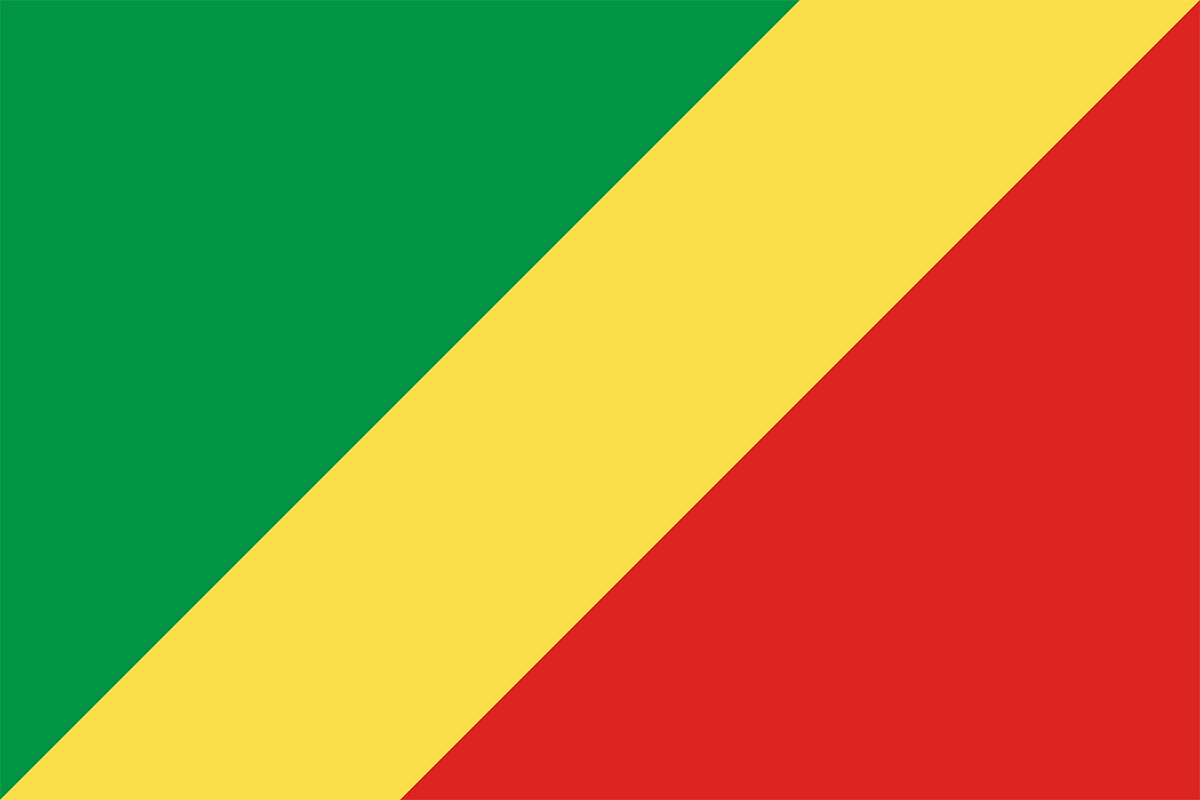
Flag of the Republic of the Congo (called also Congo-Brazzaville).
.jpg)
Republic of the Congo with marked area described in the article.
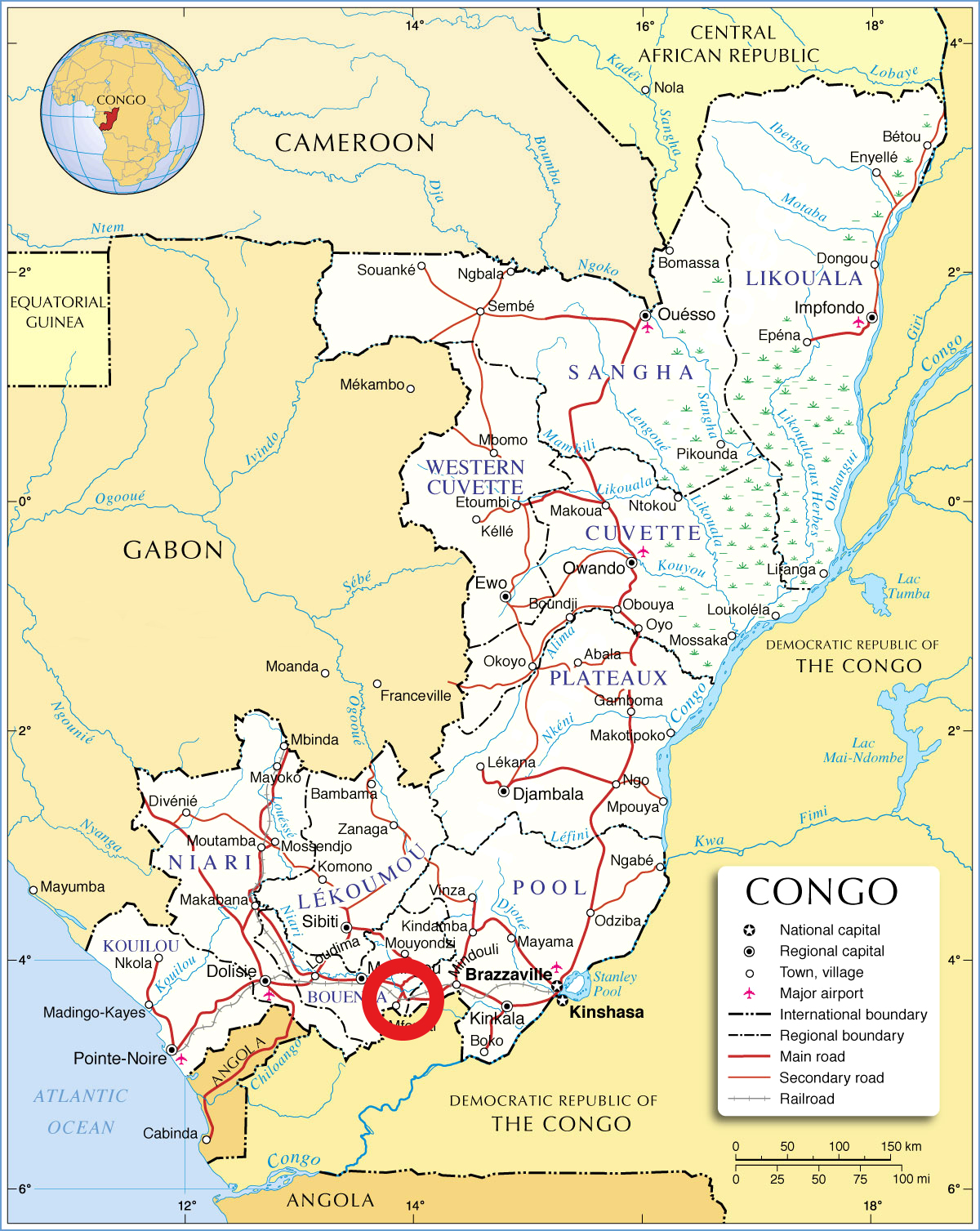
Map of the Congo with marked area described in the article.
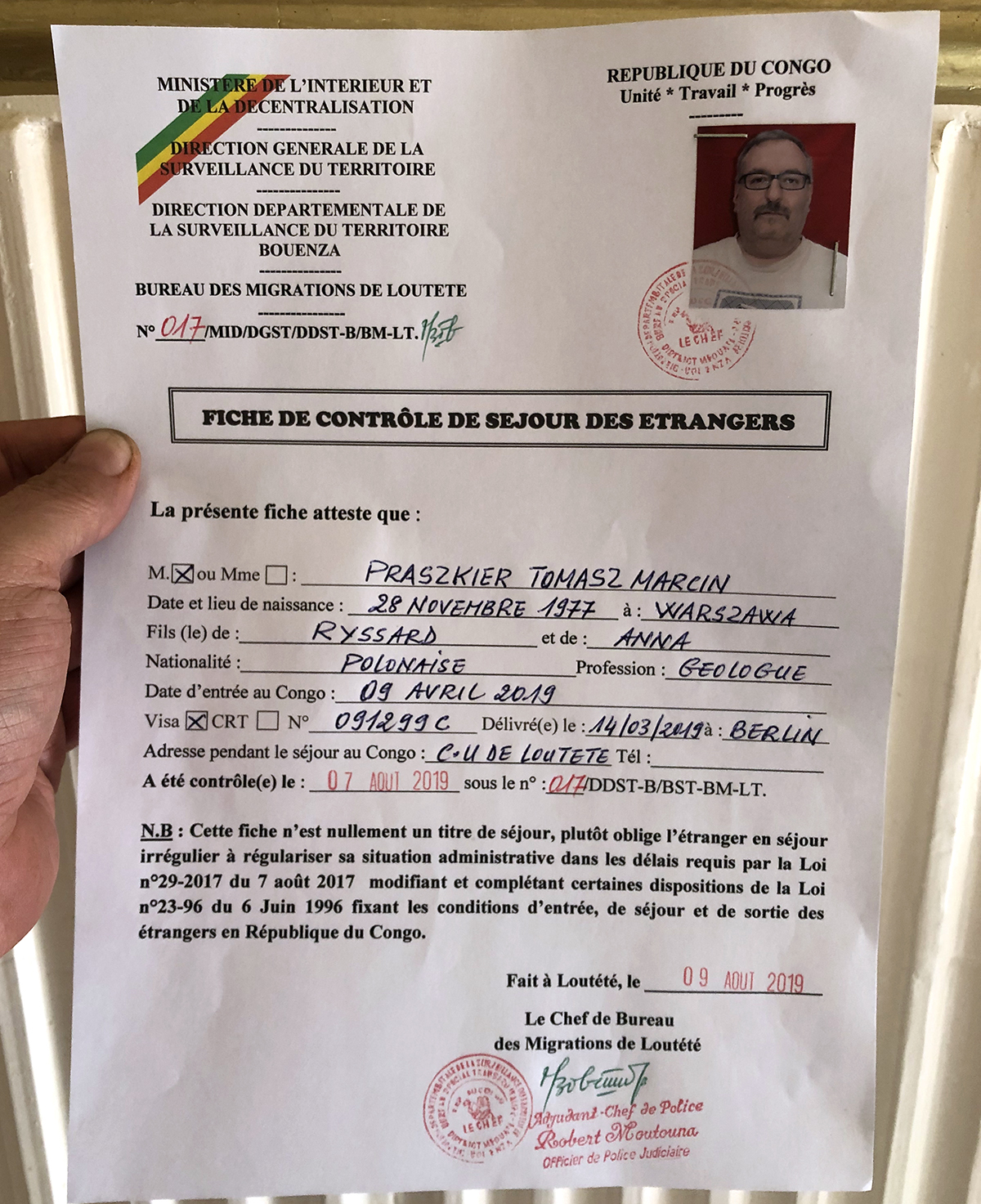
Congo is a typical bureaucratic country, to stay there longer one needs to register with the local authorities.
It is almost impossible to buy any good quality equipment in Congo (Chinese counterfeits are everywhere) so we had to bring in our luggage all essentials part by part.
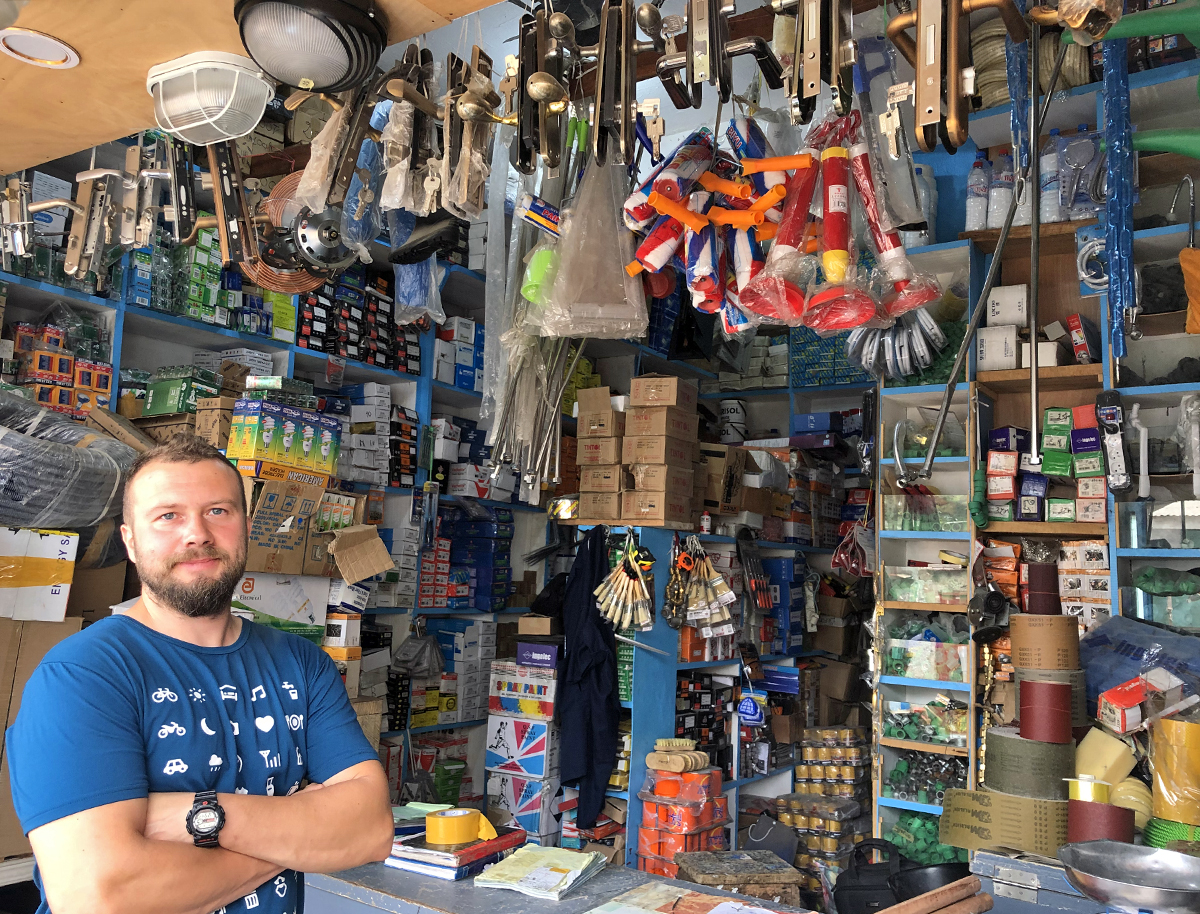
Usually we start our visit by shopping in a hardware store. Mariusz in the photo – one the Spirfer crew members.
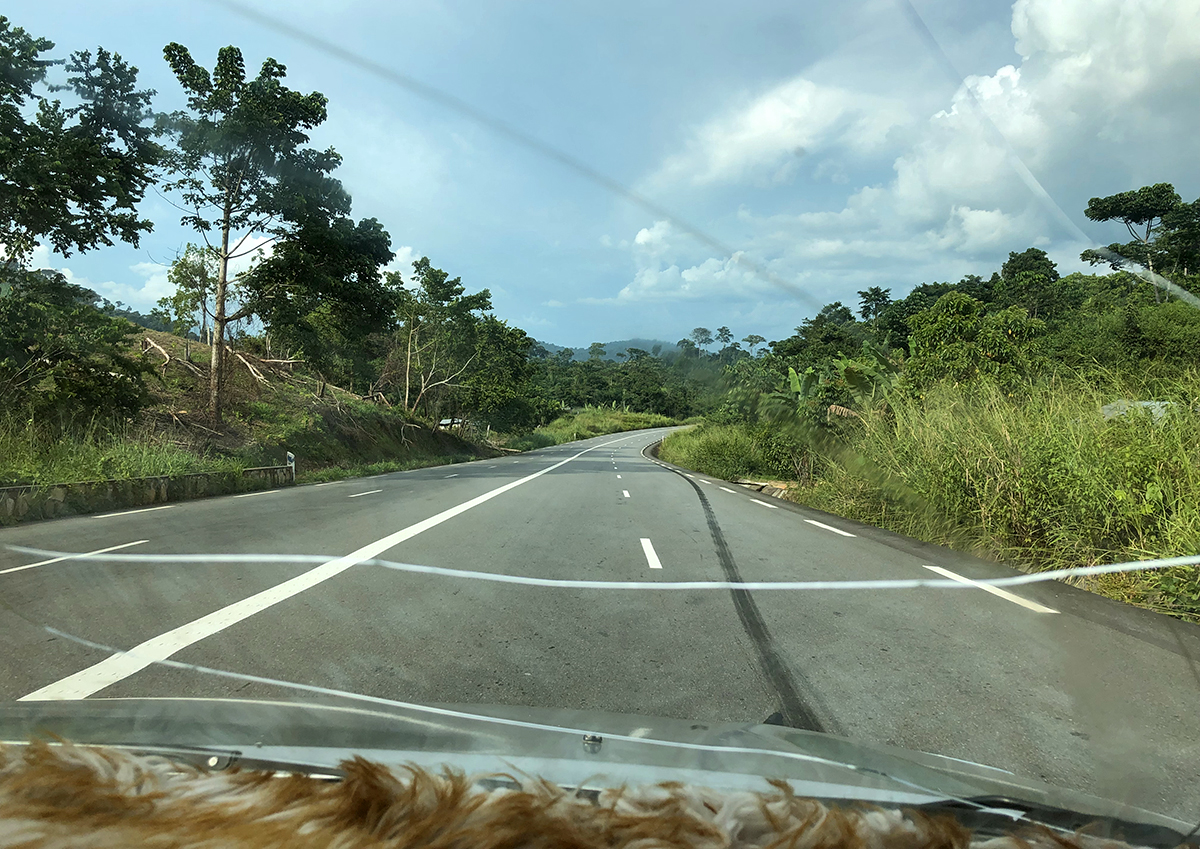
Main roads in the country are quite good, unfortunately cars not so much.
Traveling through the country you need to get used to breaking cars...

... all types of cars.
Most people in Congo are generally friendly and helpful ...
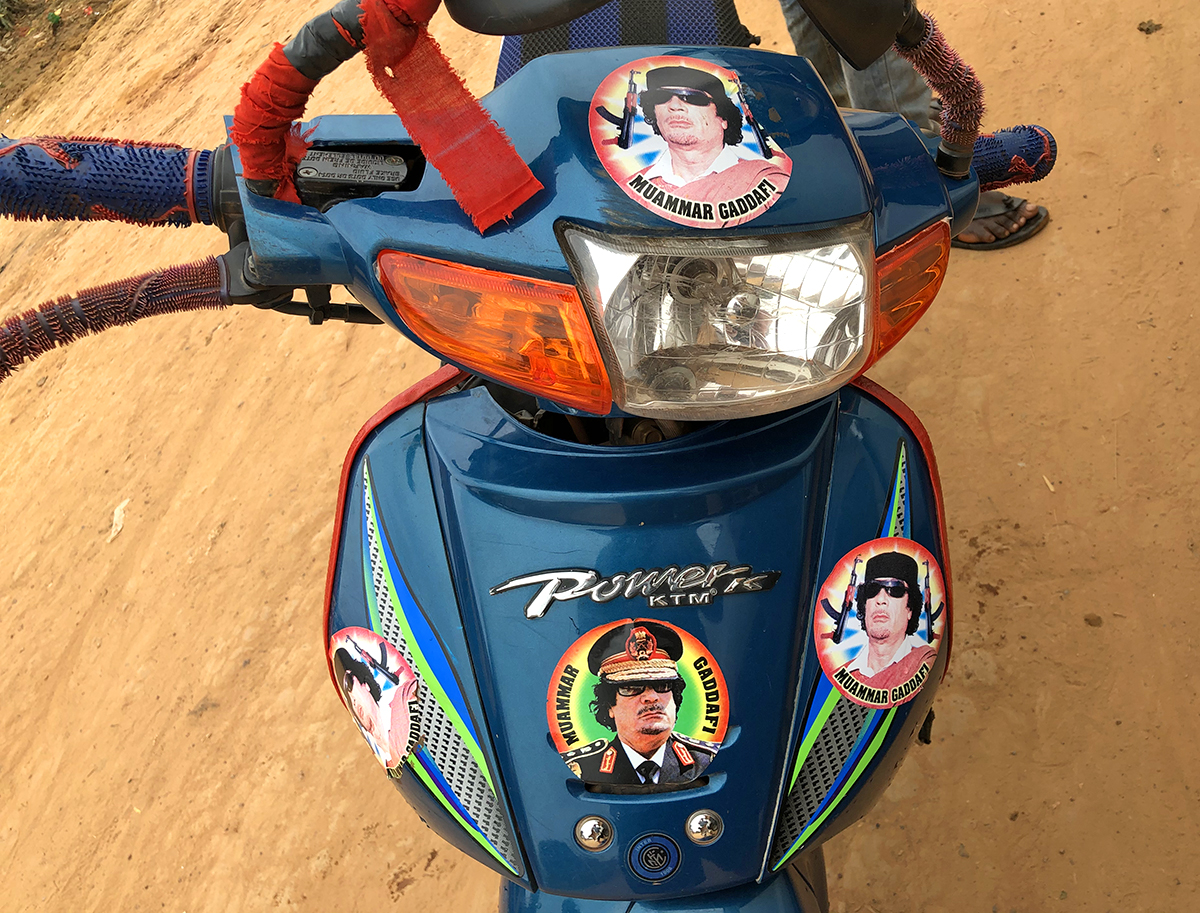
... some of them have interesting passions ...
... and sometimes you have to deal with partisans too.
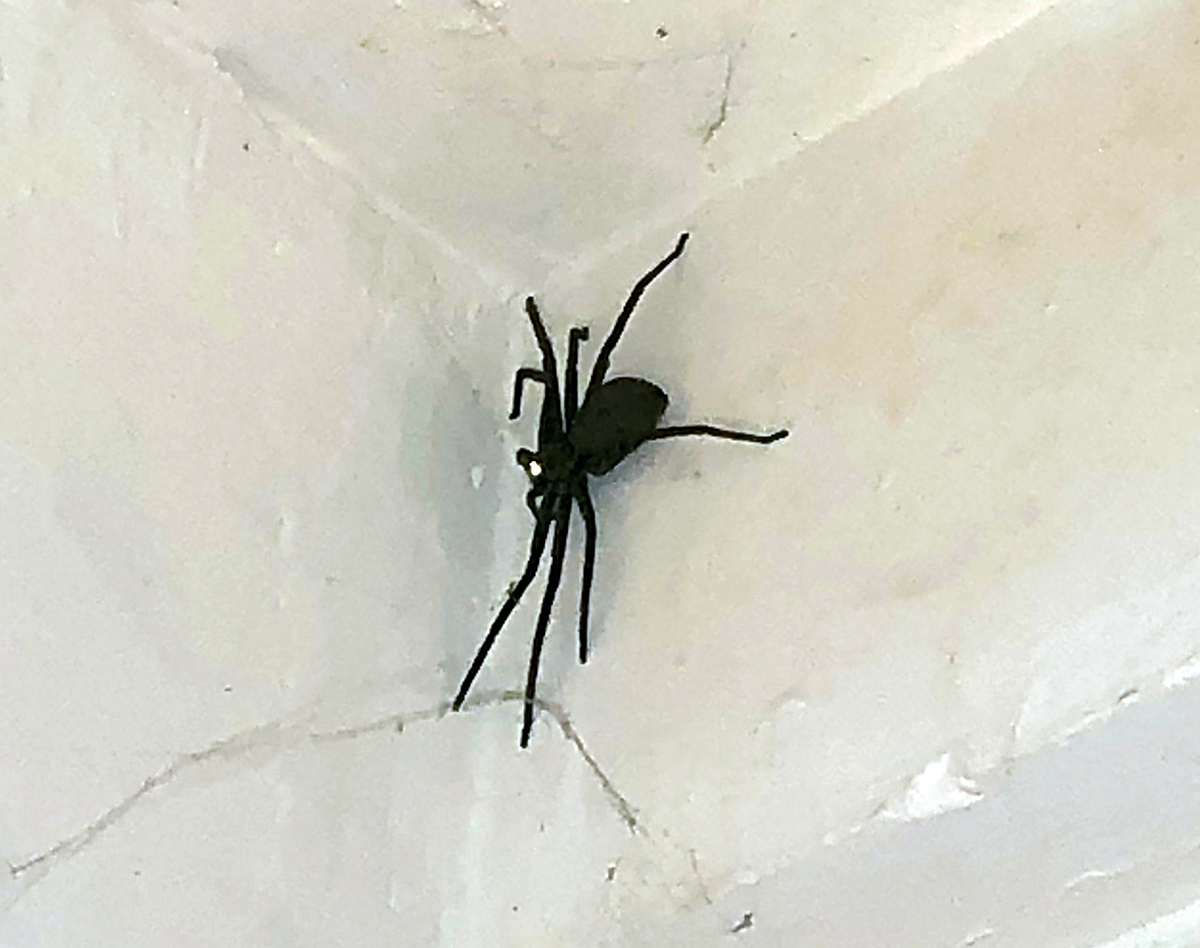
We also met some appealing animals (frequently in the hotel rooms).
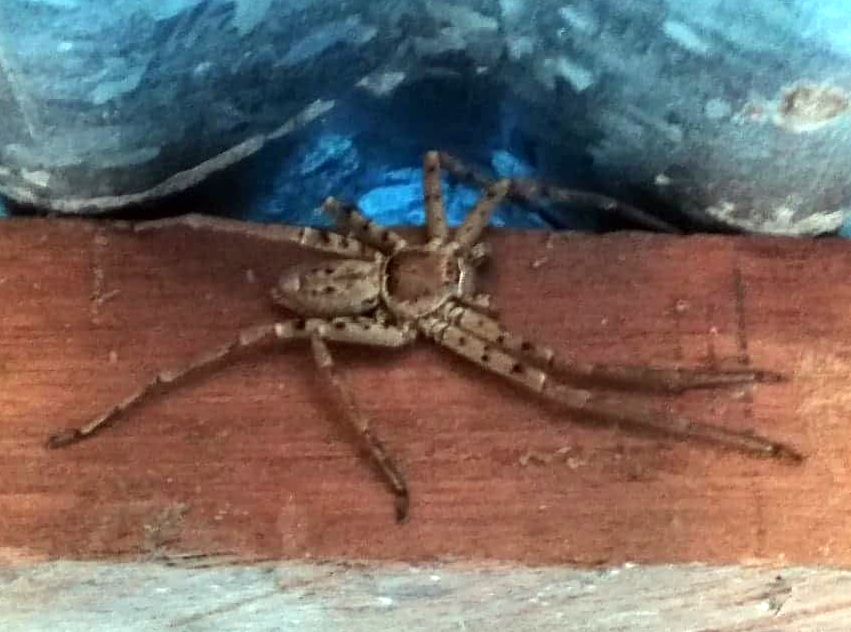
Another nice pet.
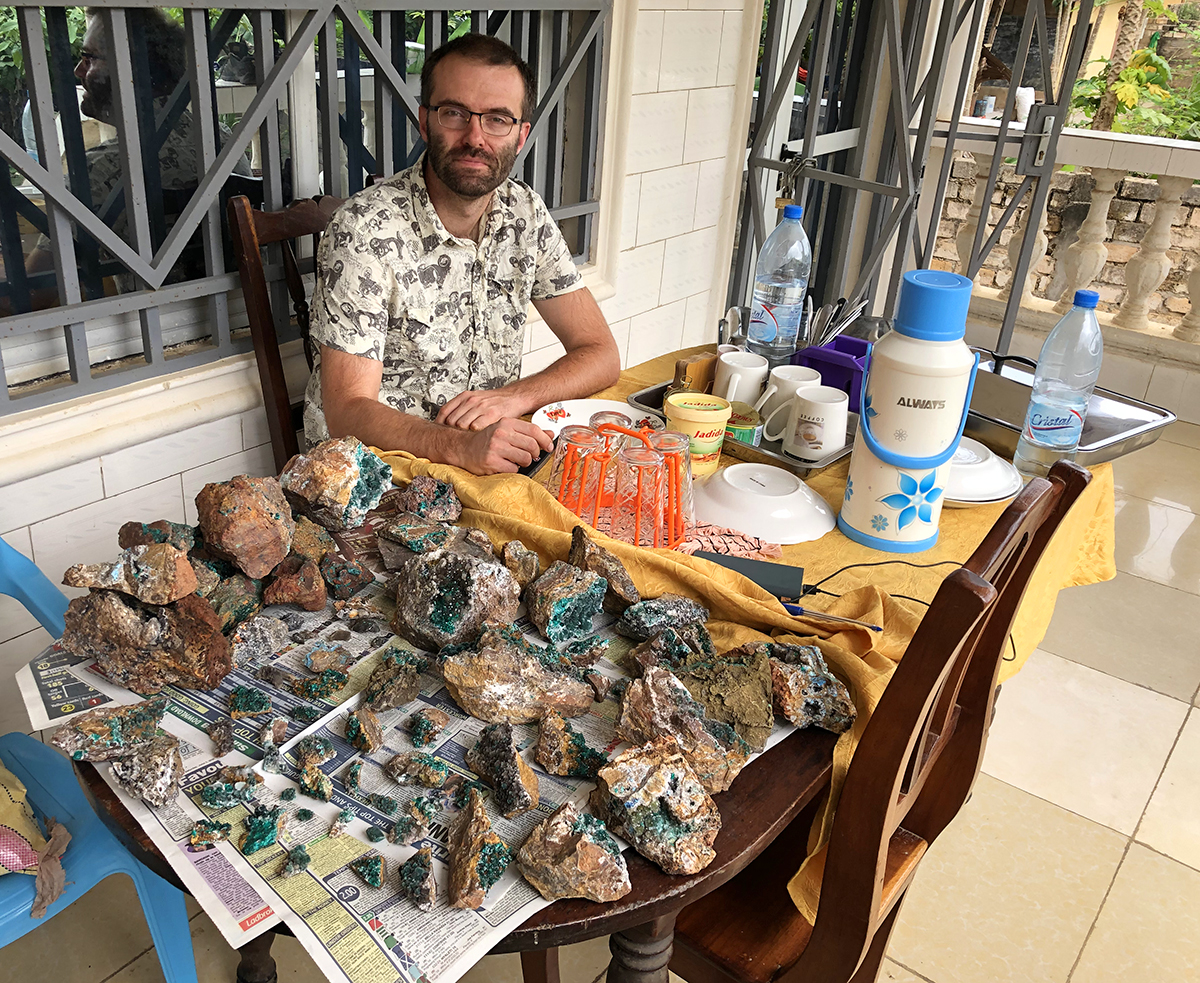
We ate the finest food (here S?awek from Spirifer crew, at "breakfast with minerals").
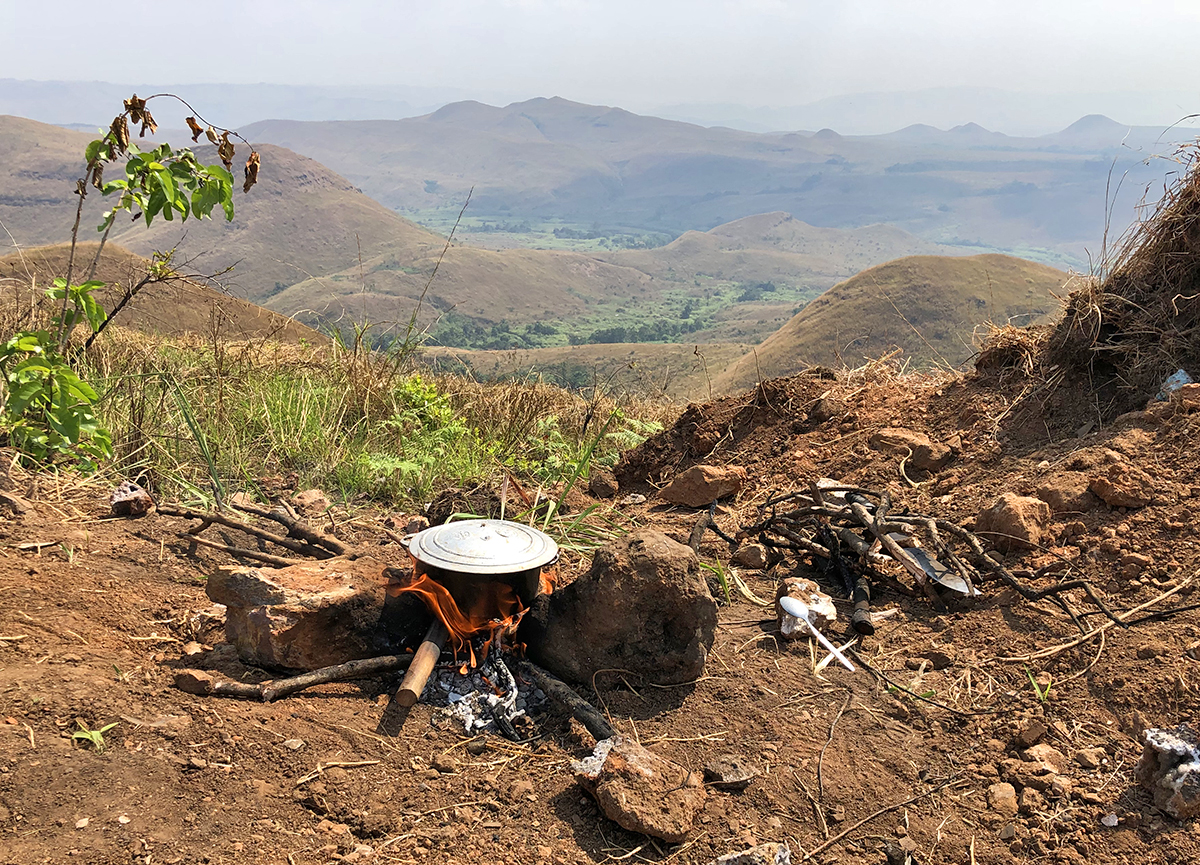
Here we prepared the finest food ...
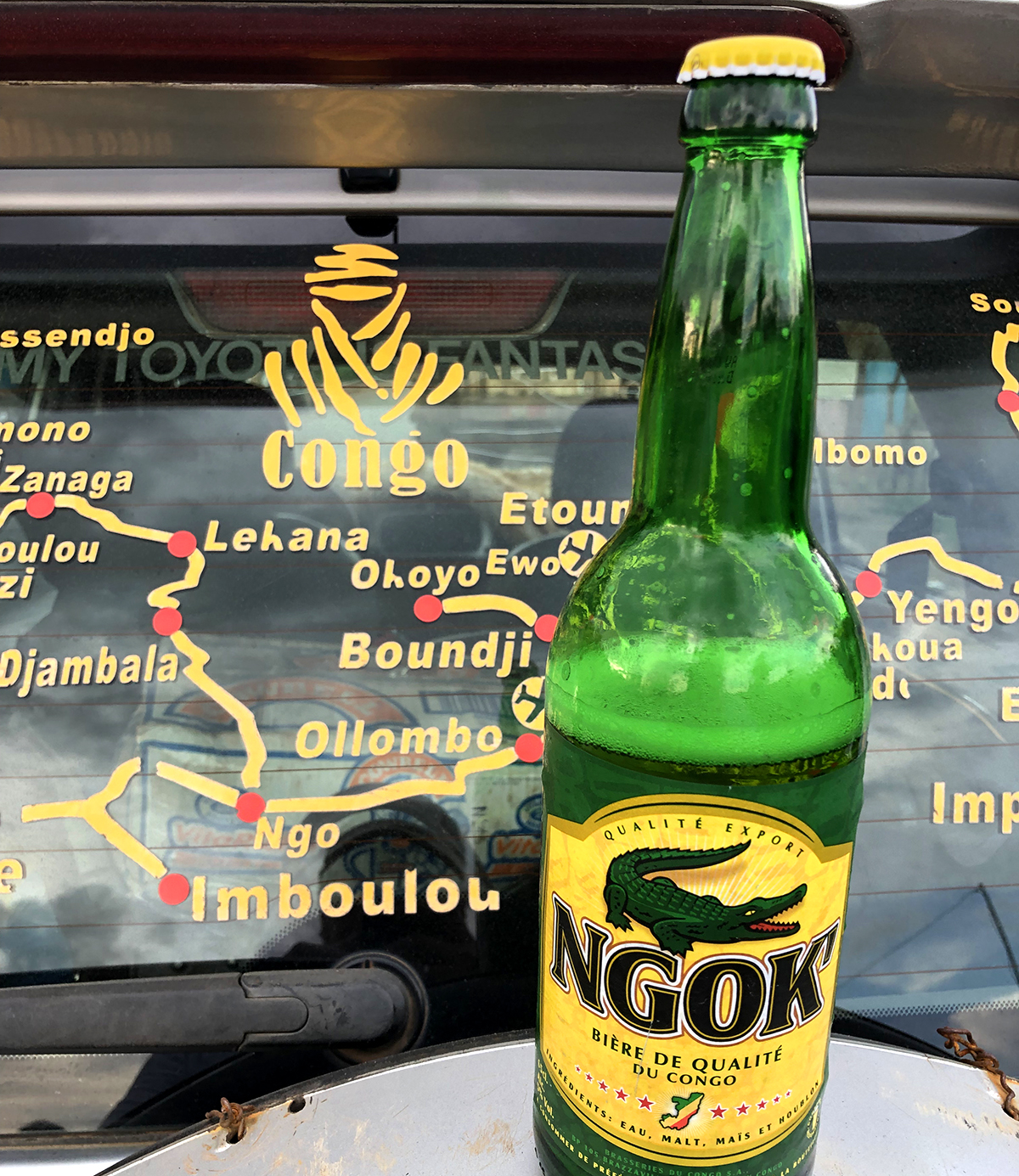
... and later we drank the finest drinks!
GEOLOGY
The Republic of the Congo has never been famous for mineral specimens for several reasons. It has never been extensively mined; most of the areas are covered by dense vegetation; and only one area has historically produced good quality specimens. This area is a Neoproterozoic unit known as Niari Basin. Located along the Congo river, on the border with Democratic Republic of the Congo, in the southern part of the country. The Niari basin extends for over 150 km, trending NW-SE, and hosts a large number of the metalliferous deposits of metals such as Cu, Zn and Pb. Deposits are usually very small, and only very few are big enough to be industrially mined.
The Niari basin is built by rocks belonging to upper part of the West Congo Supergroup (WCS). The upper central part of the WCS is known as Schisto-Calcaire Group (SCG), dated roughly from 541 to 635 Ma. SCG is a marine sedimentary sequence, about 800 m thick, built mostly by siliciclastics and carbonates representing three transgresive-regresive cycles. Ore deposits are hosted in the central part of the SCG, know as SCII (previously C4) Subgroup dated roughly at 575 Ma.
Mineralization in the Niari Basin is clearly controlled by tectonics. The most interesting mineralogical specimens come from two types of the supergene mineralization. First is the one located usually in the close vicinity of the faults, where hydrothermal karstic dissolution cavities are present (e.g. Palabanda, M'fouati). The second type of mineralization producing specimens are veins occurring on faults (Sanda). Voids present in both types of the deposits host wide variety of secondary Cu-Pb-Zn minerals such as dioptase, malachite, cerussite, wulfenite, mimetite, duftite, plancheite, hemimorphite and recently discovered veszelyite.
Although previously the origin of the mineralization was believed to be connected with deep lateritic weathering, recent research led to a more classic model with deeper hypogene ore bodies, and more shallow supergene mineralization. Minerals interesting from the collectors’ point of view are connected almost exclusively with the supergene mineralization.
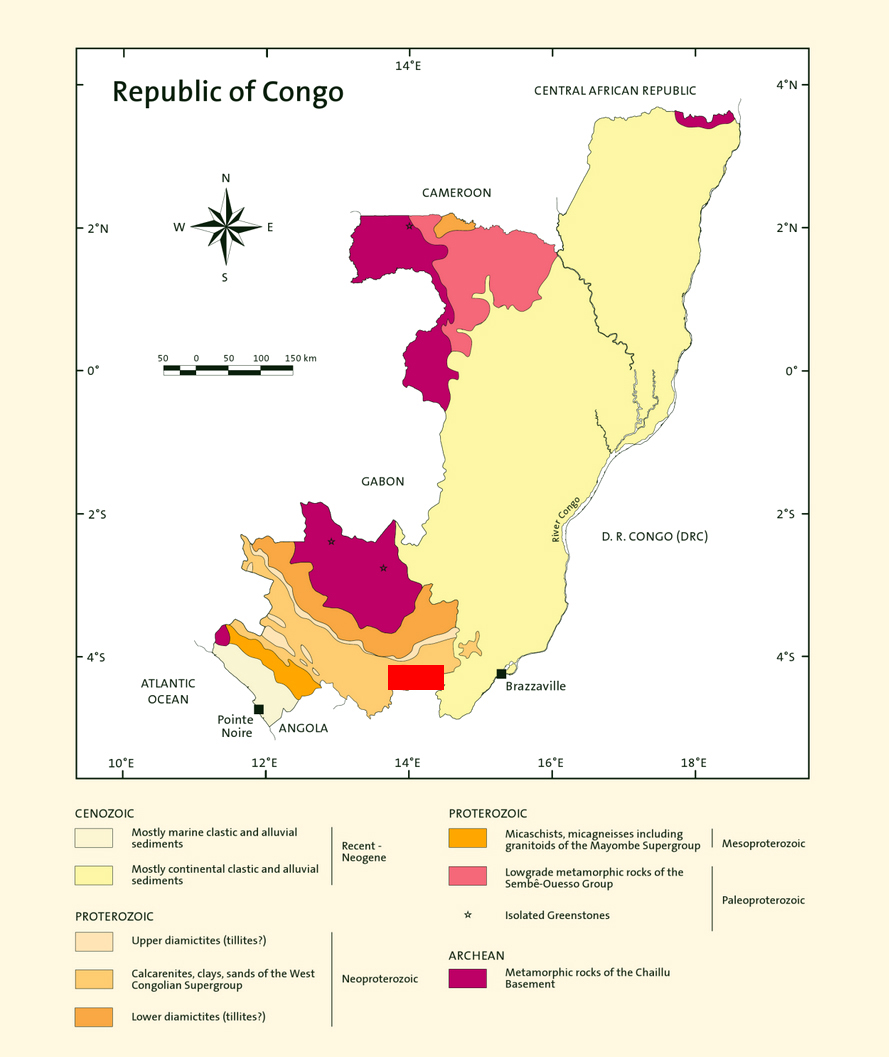
Simplified geological map of the Republic of the Congo, red square shows Niari Basin (see detailed map below), where the most interesting secondary Cu-Pb-Zn mineralization occurs.
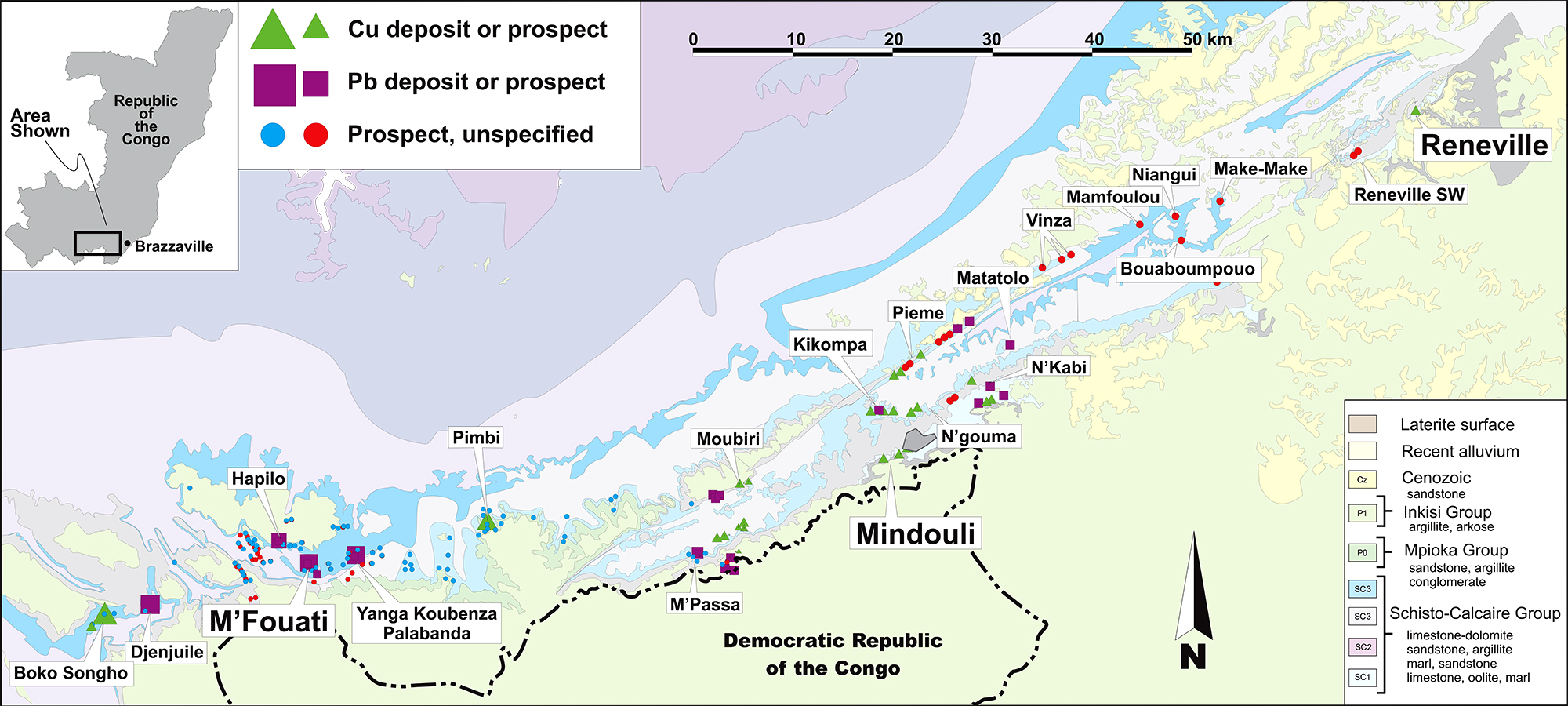
Niari Basin is built by Neoproterozoic sedimentary rocks divided in 3 groups. The most important Cu-Pb-Zn deposits (marked in the map) are hosted in so called "Shisto-Calcaire Group" build mostly by carbonates such as limestones, dolomites and marls. Map by S. Olson.
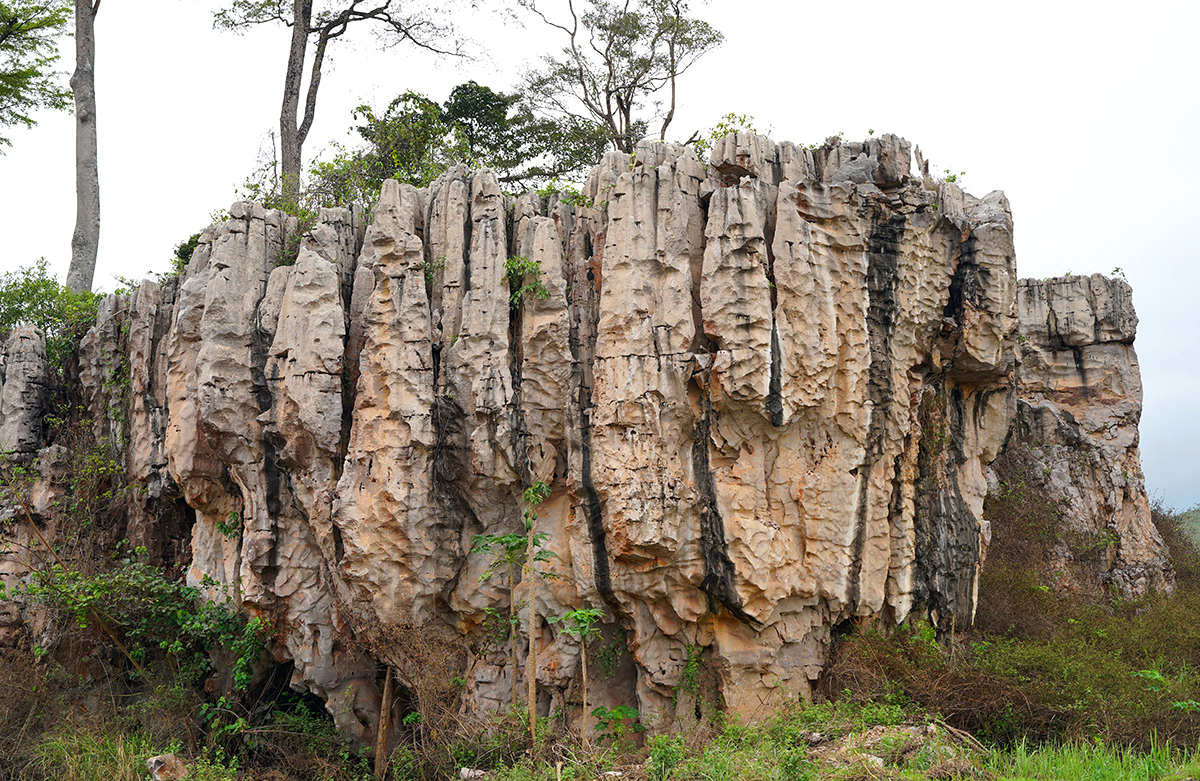
Niari basin is built by Neoproterozoic (+/- 600-700 Mya old) sedimentary rocks, such as limestone (on the photo with karstic formations), sandstones, shales etc.
EXPLORING MINERAL LOCATIONS
The Spirifer crew started to explore the Niari Basin 3 years ago, and since then many field expeditions have been run. Our first goal was to understand the local geology, style of the mineralization. Further, we wanted to determine where “the real” locations are and which specimens come from which localities; then to choose the best prospects to start our own diggings. In that time we visited countless outcrops, old and new workings, quarries and mines. This resulted in the discovery of several new locations as well as re-discovery of a few old ones. As there is a lot of misinformation about the Congolese localities and the specimens that come from them, we present a few of the more important areas where we were active and conducted our research. In the future we are planning more detailed publications about some of these localities, as well as to continue our mining projects on a previous scale as soon as COVID pandemic retreats.
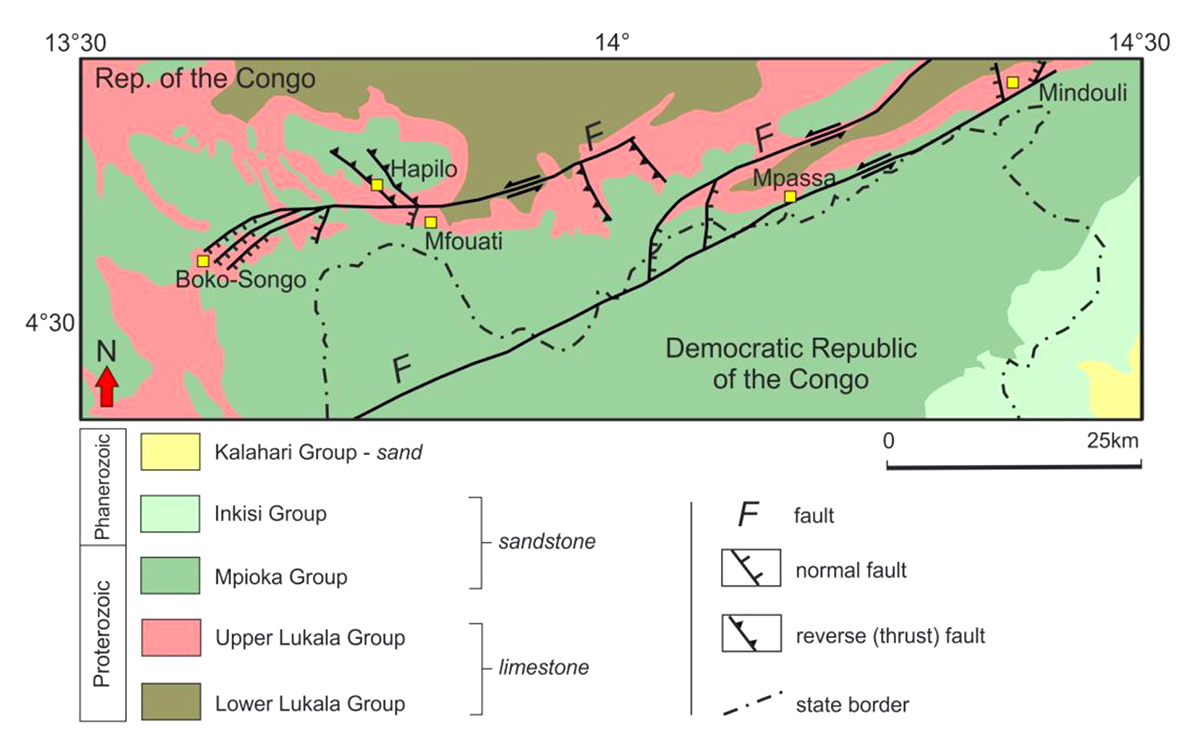
Simplified geological map of the Mindouli-Loutete area with most important Cu-Zn-Pb deposits. "Lukala Group" is a synonym of the "Shisto-Calcaire Group".
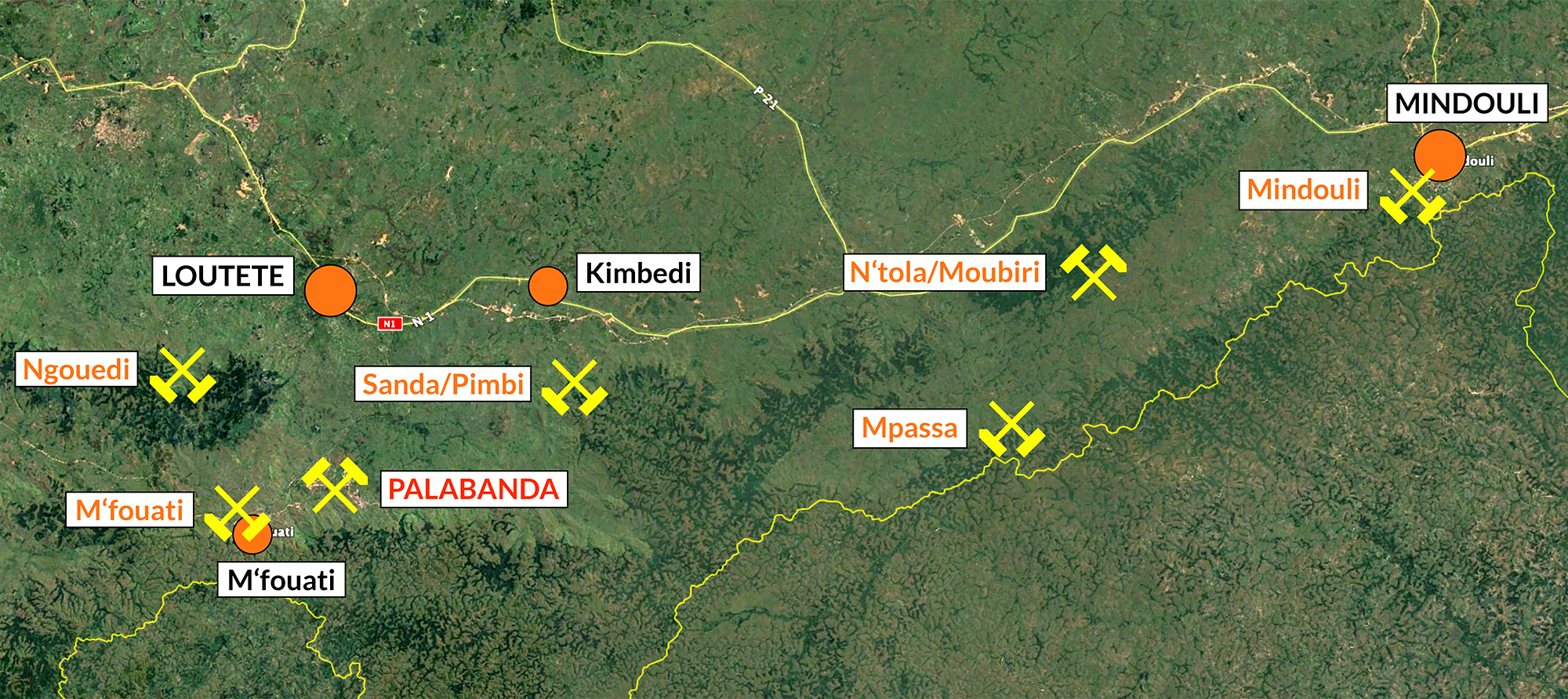
Satellite photo of the Mindouli-Loutete area with the most important mineralogical localities. One of the main places we explored during Congo travels was N'tola mine.
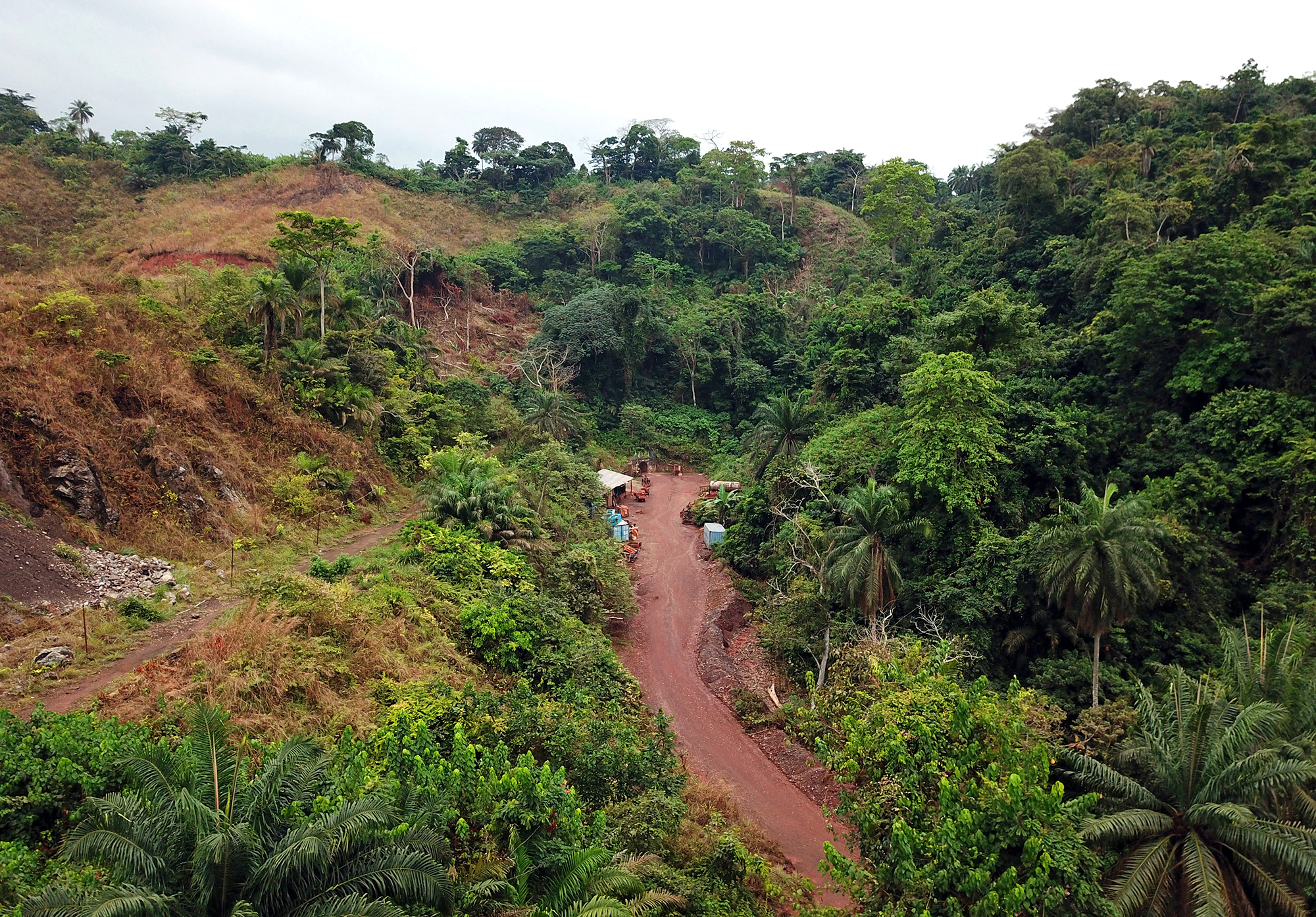
Aerial photo of the entrance to the N'tola mine. We were the first westerners who tracked the origin of specimens from "unknown location in the Mindouli area" and as well the first (and only?) to visit the mine.
Mining camp of the N'tola mine.
Getting ready to go underground.
On the way to the mine adit.
S?awek next to the N'tola mine portal.
Walking through the main N'tola adit.
Walking through the main N'tola adit.
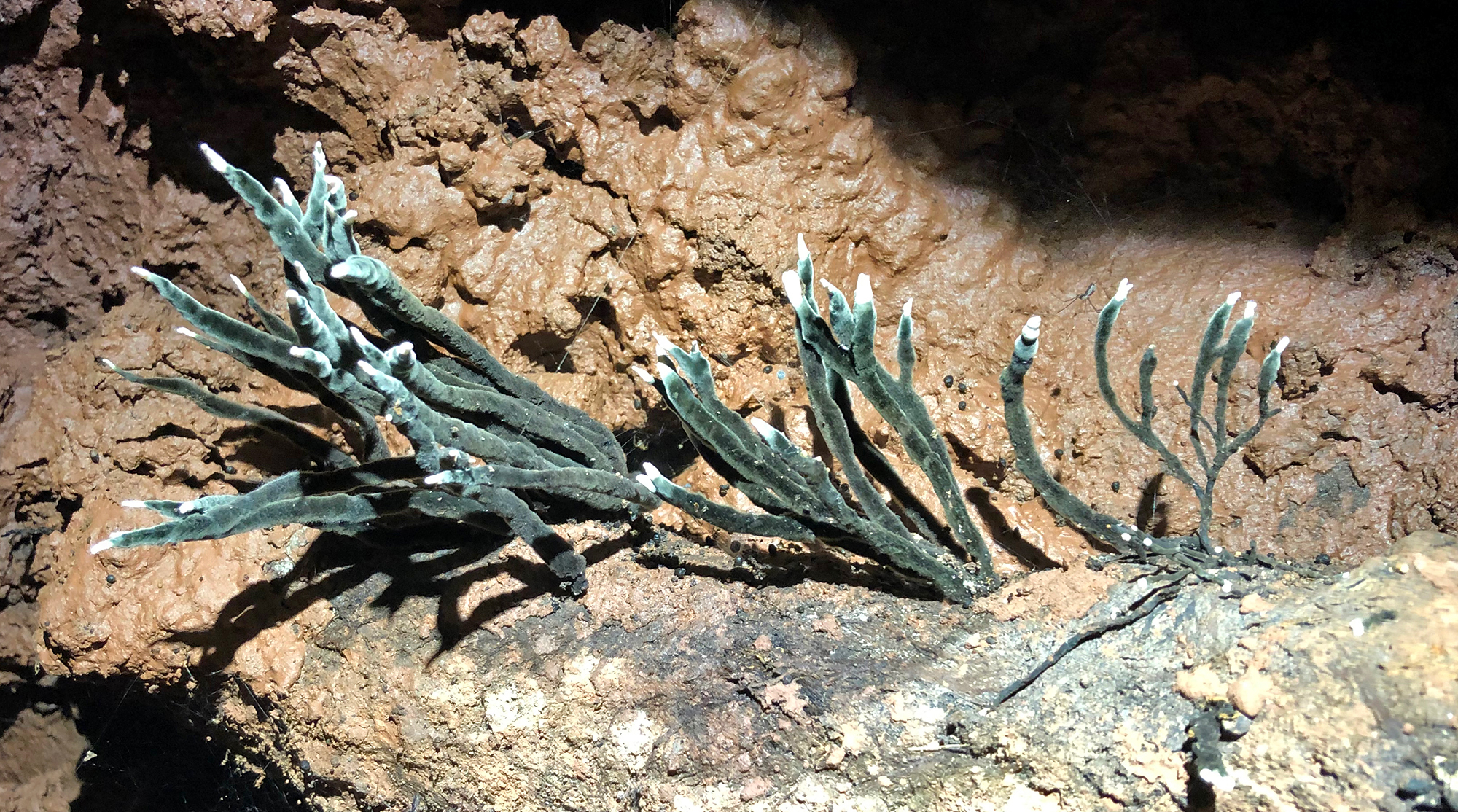
Unusual fungi in the N'tola mine.
Exploring pockets in the partly flooded tunnels.
Flooded part of the mine with abundant dioptase (see the ceiling).
Dioptase masses on the walls.
Small dioptase crystals on the cracks in the limestones.
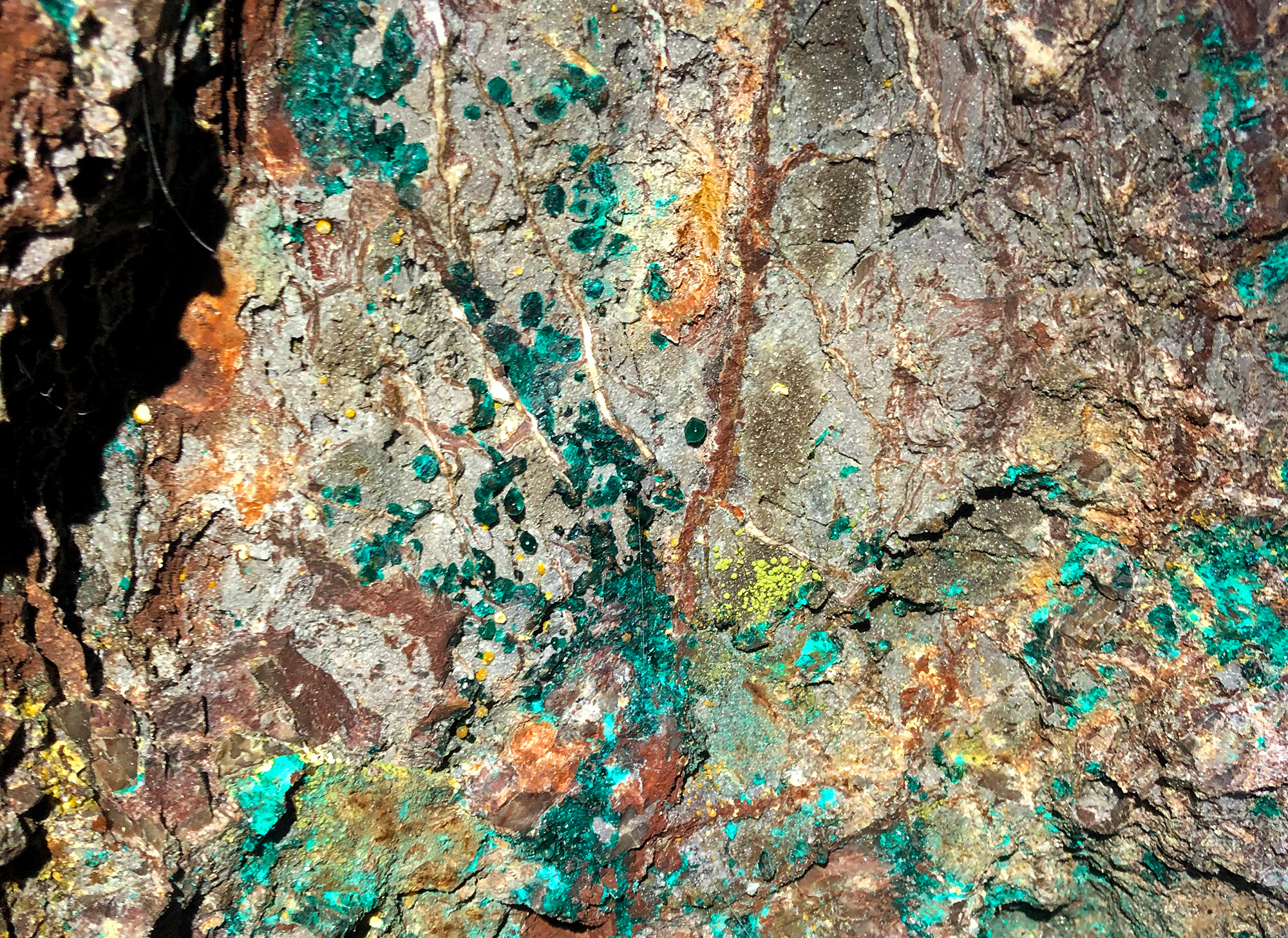
Pocket in situ in N'tola mine with bright dolomite, dark green dioptase and bright green duftite.
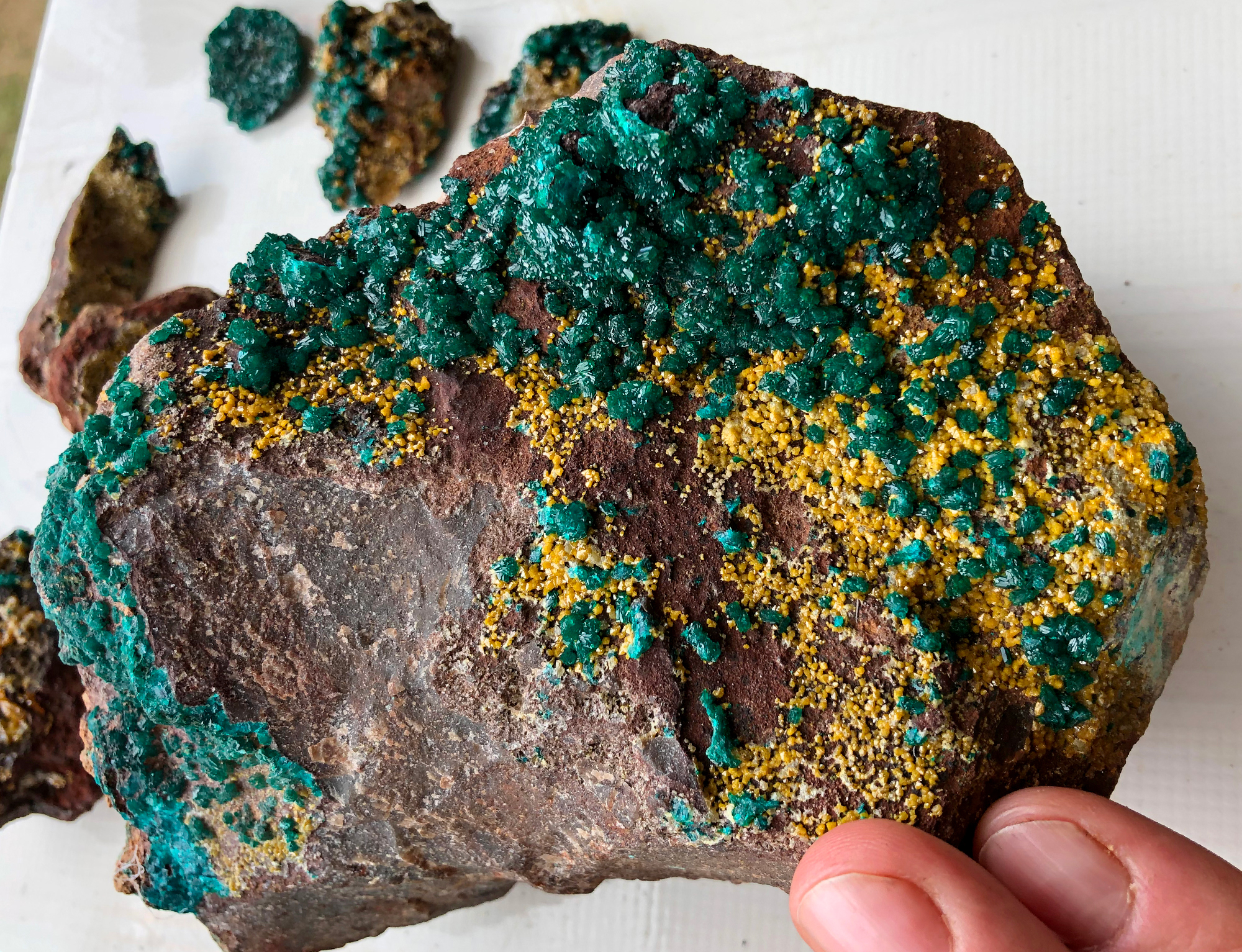
Typical N'tola specimen – combination of the dioptase with mimetite.
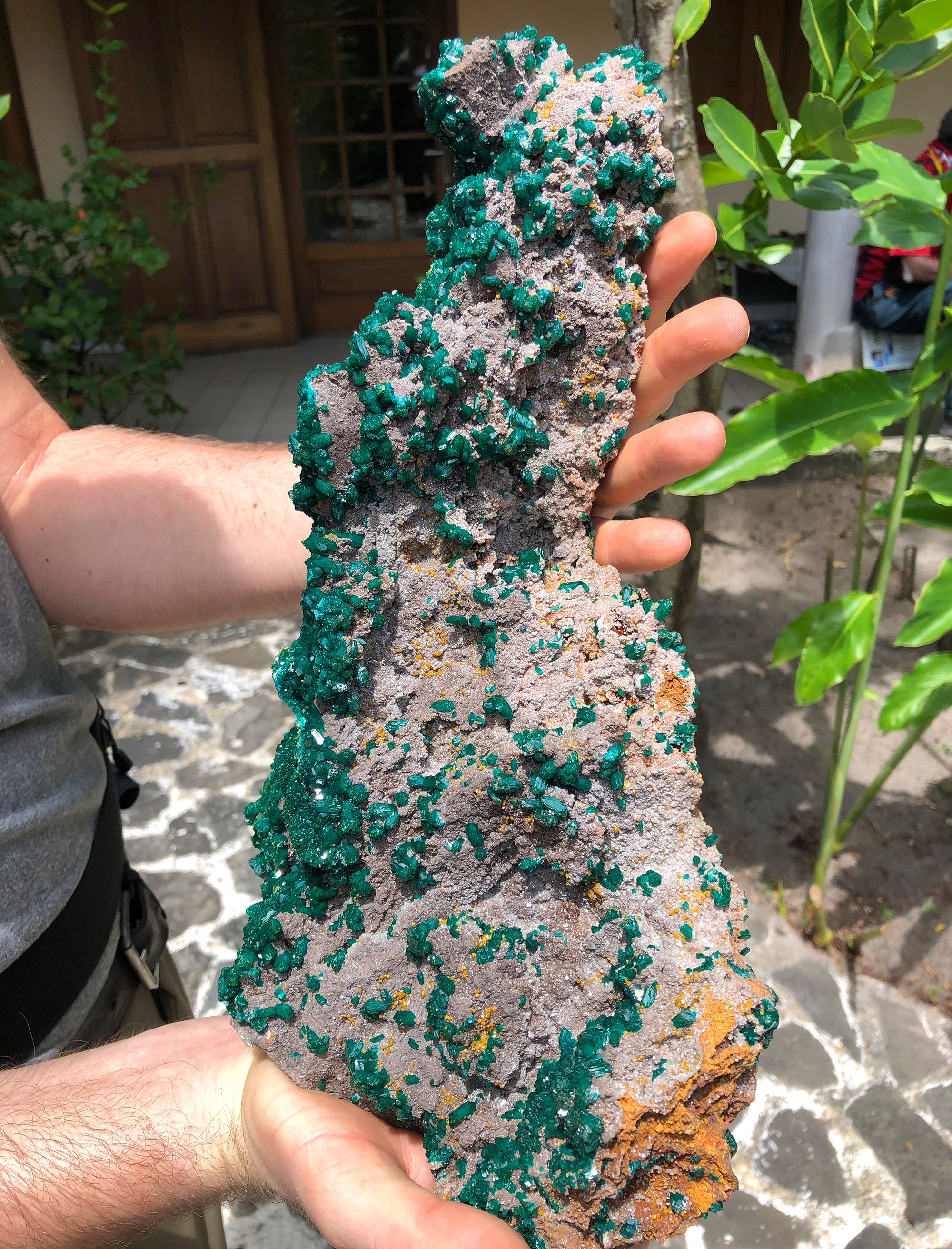
Spectacular specimen from N'tola mine – dioptase and mimetite on dolomite.
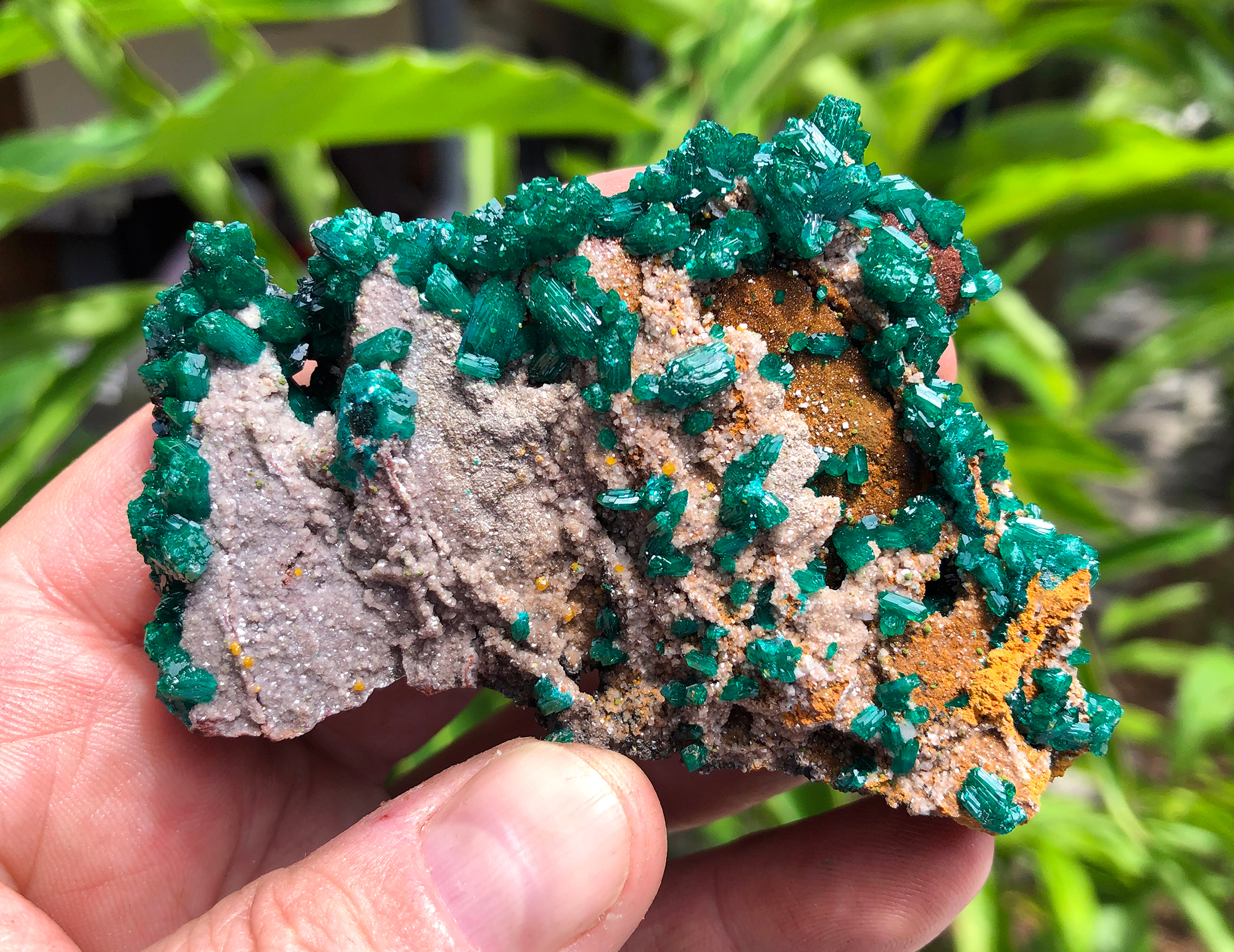
Typical N'tola specimen – dioptase on dolomite.
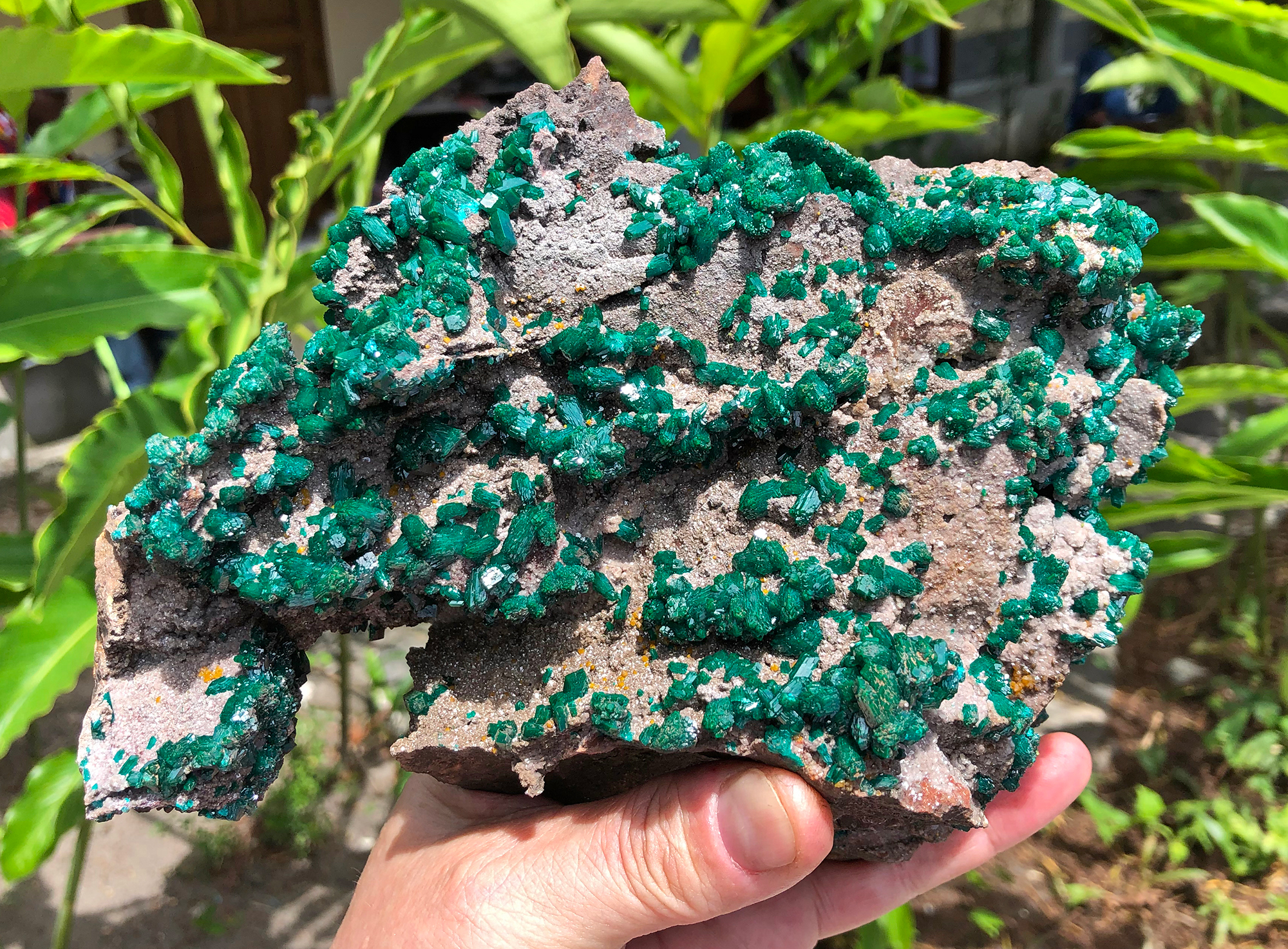
Spectacular specimen from N'tola mine – dioptase on dolomite. Spirifer specimen.
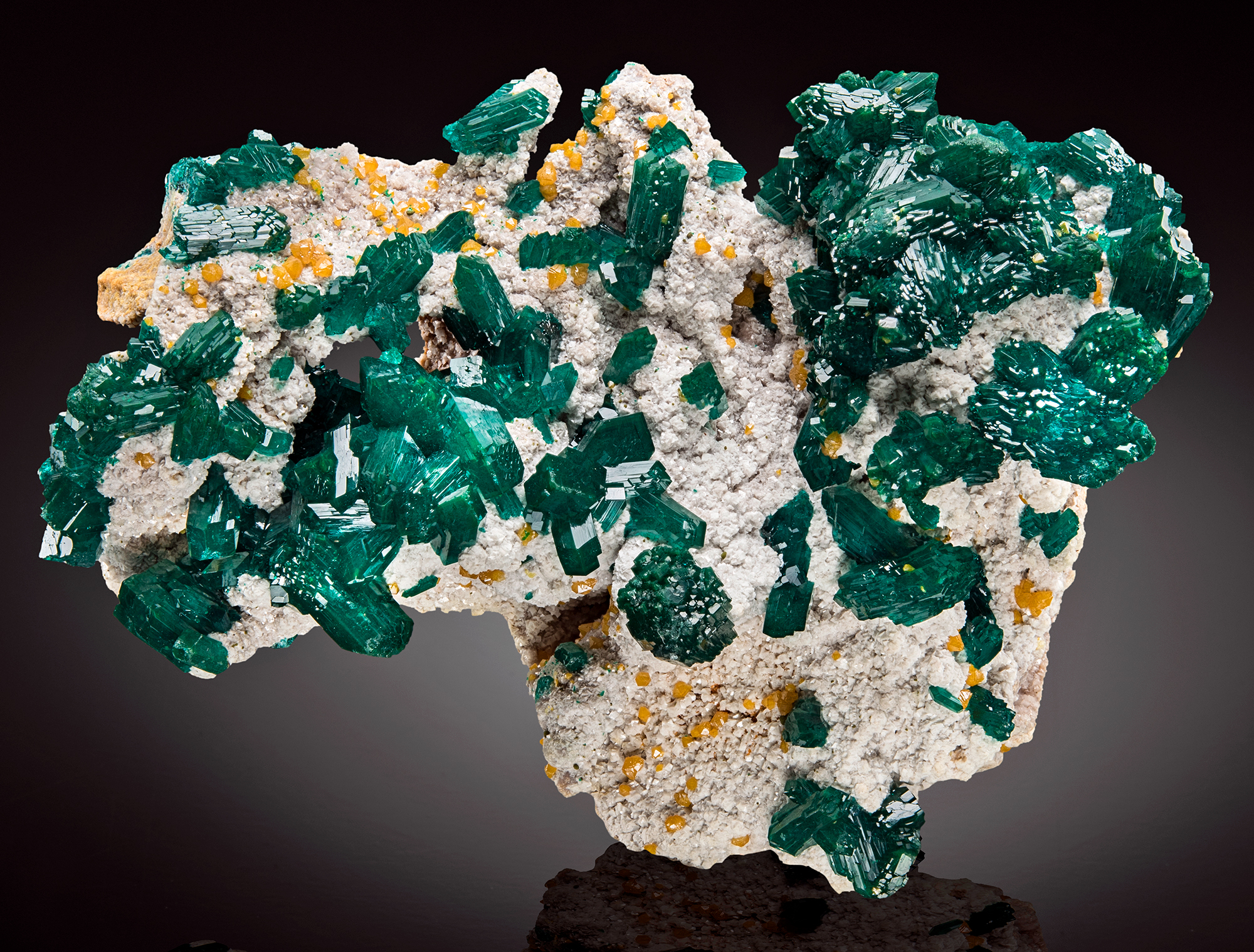
Typical N'tola specimen – dioptase and mimetite on dolomite. Specimen 6.5 cm wide. Spirifer specimen. M. Mauthner photo.
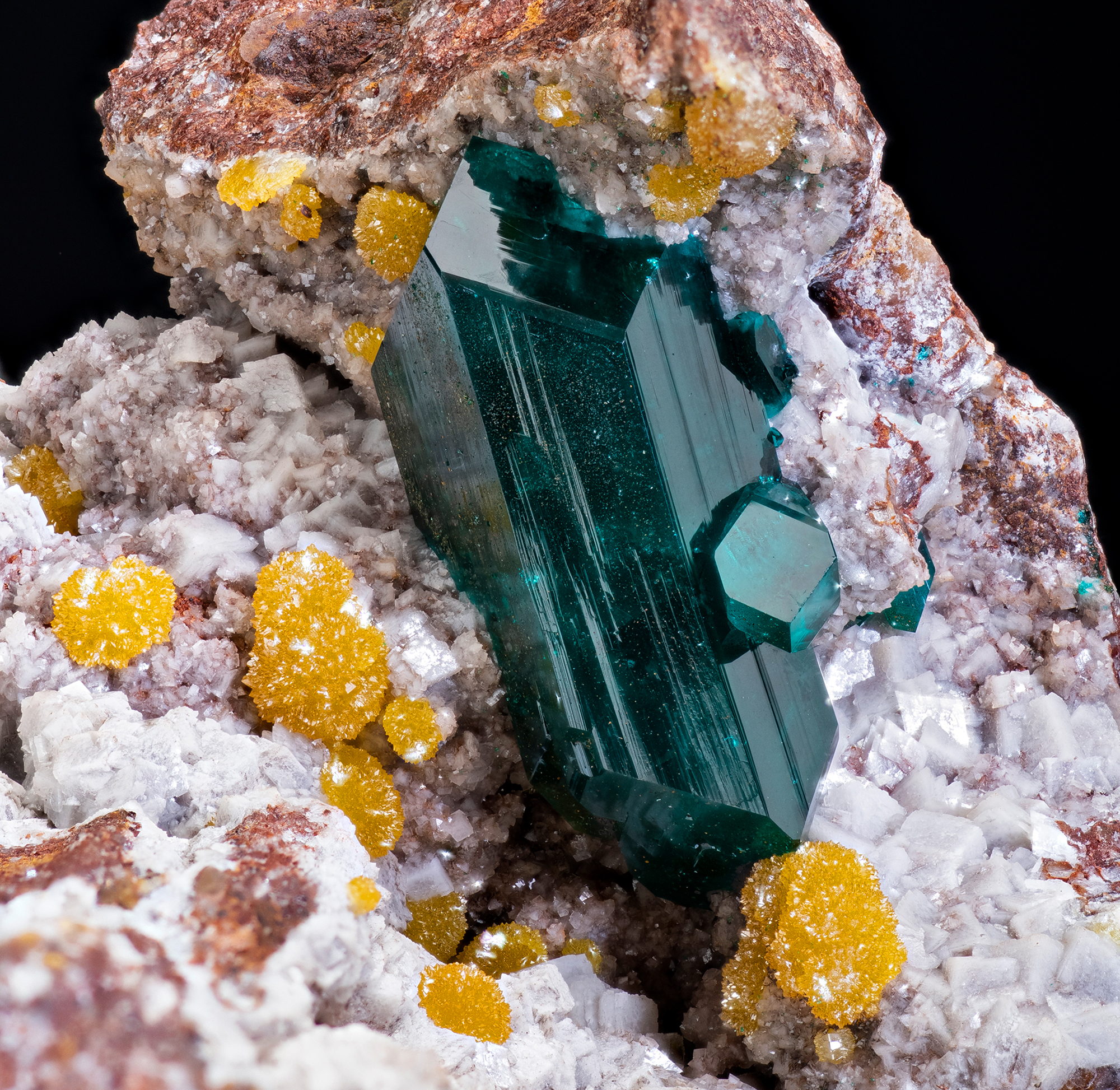
Well formed dioptase crystal (2 cm tall) with mimetite aggregates on white dolomite from N'tola mine. Spirifer specimen. J. Scovil photo.
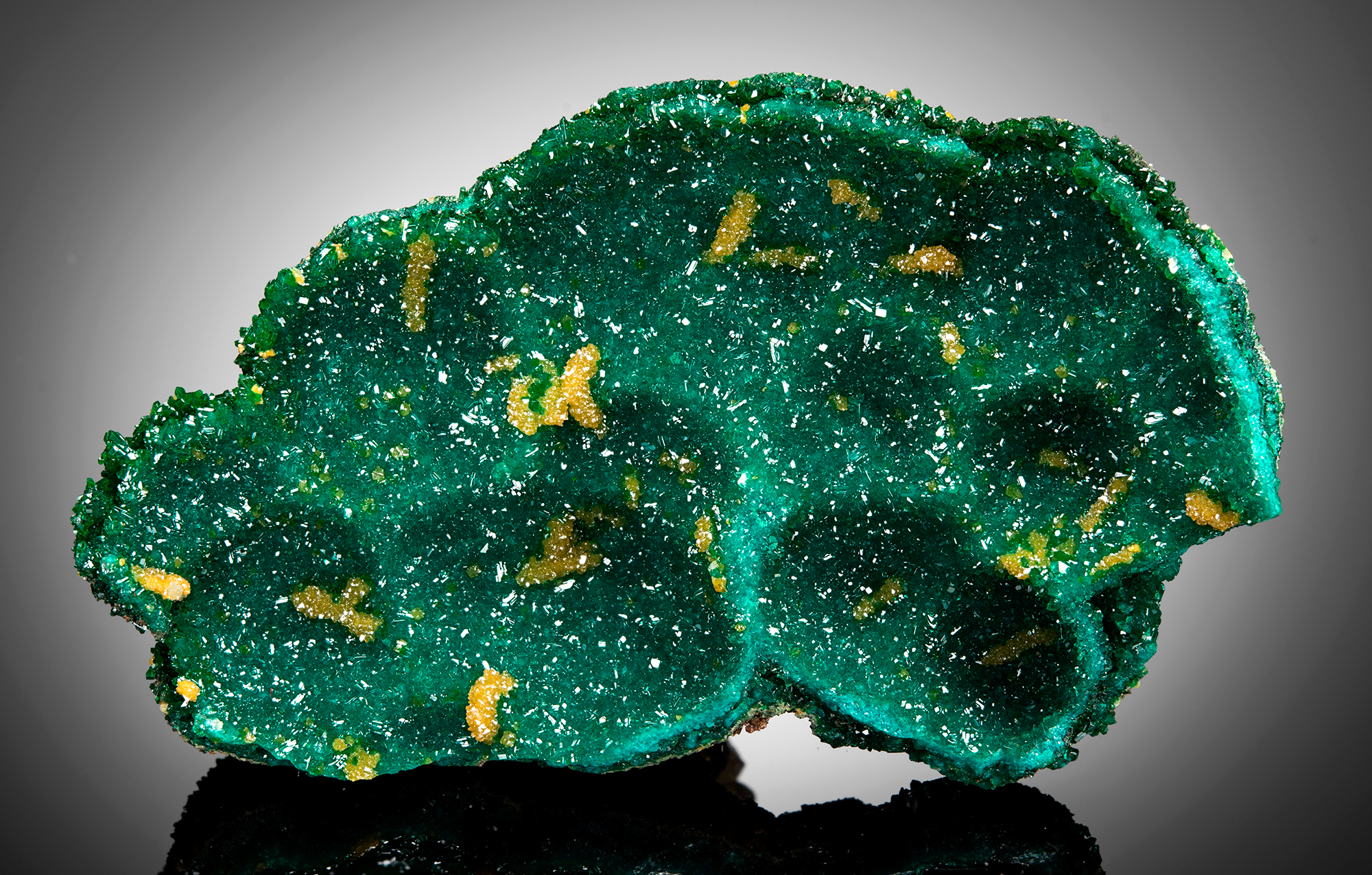
Unusual, and known exclusively from N'tola mine, perimorphoses of the dioptase with mimetite after unknown kidney shape mineral – probably chrysocolla or plancheite. 8.6 cm across. Spirifer specimen. M. Mauthner photo.
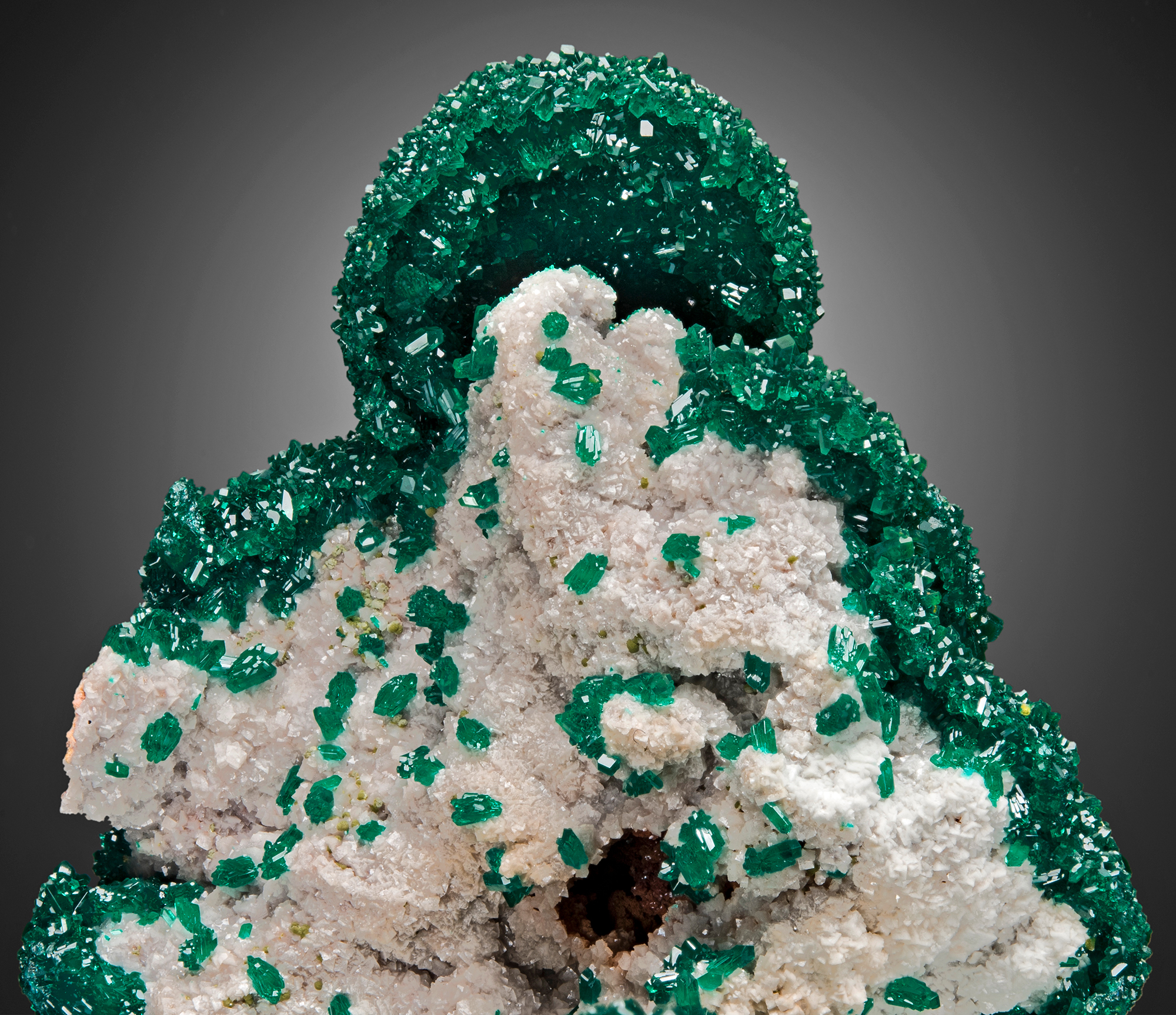
Unusual, and known exclusively from N'tola mine, perimorphose of the dioptase after unknwon kidney shape mineral – probably chrysocolla or plancheite – on dolomite. 4.7 cm across. Spirifer specimen. M. Mauthner photo.

Another region intensively explored by Spirifer team in the last years is Kimbedi area with Sanda hills.
Exploring workings in the Kimbedi area. Sanda hills, which we mostly explored visible in the background.
Dioptase on the Neoproterozoic limestones near to Kimbedi.
The most interesting in the area are Sanda hills with many mineralized veins. Here fragment of the hills visible in a drone photo.
Upper part of the Sanda hills in the drone photos. Visible recent surficial workings.
Old exploration tunnel in the upper Sanda (probably constructed during the French times in 60's).
Exploring the old tunnel.
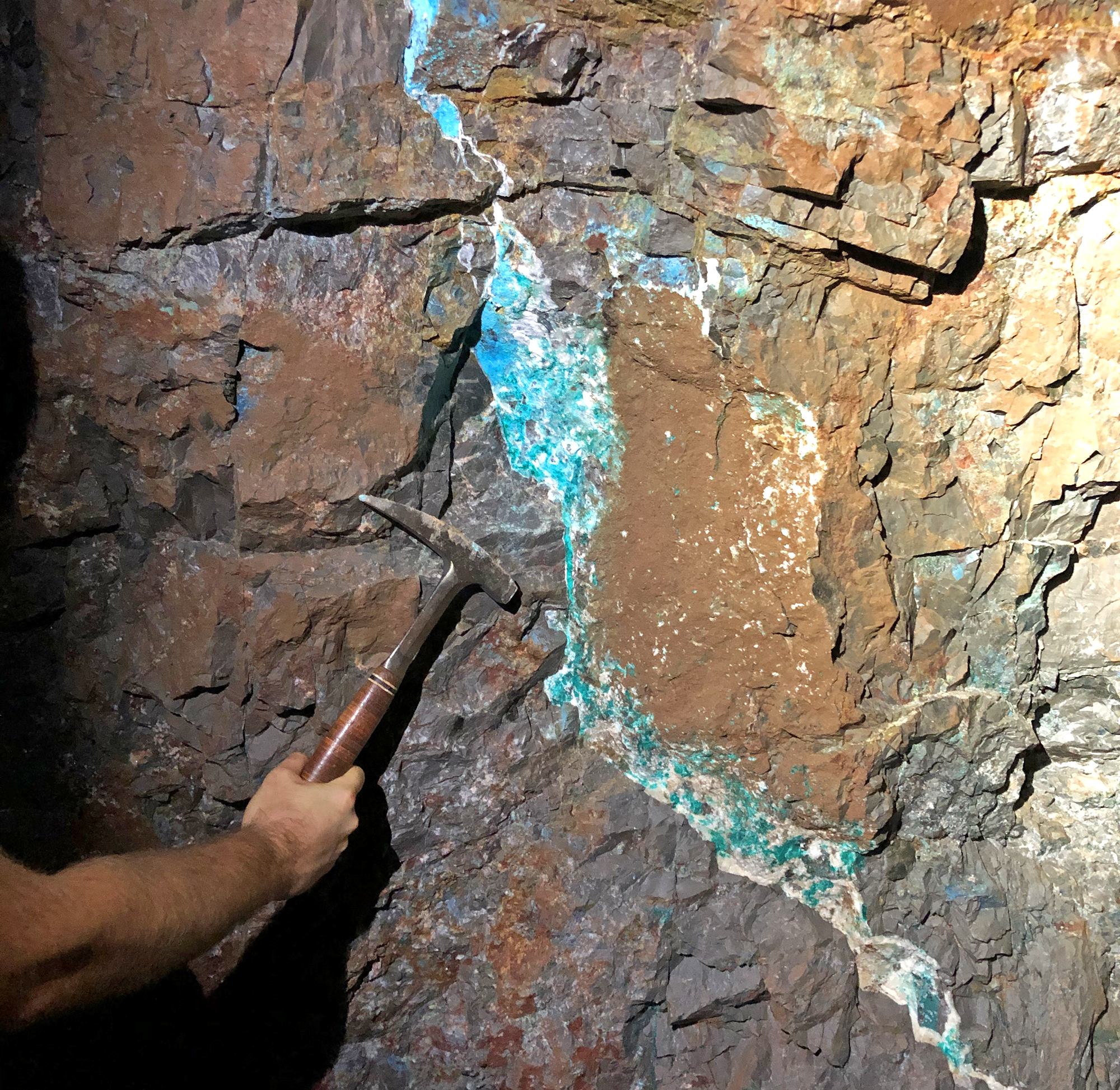
Dioptase mineralization in the tunnel walls.
Dioptase and calcite mineralization in the tunnel walls.
Very colorful ore bodies built by cuprite changed mostly to plancheite and dioptase. Sanda is the type locality for plancheite.
Very colorful ore bodies built by cuprite changed mostly to plancheite and dioptase. Sanda is the type locality for plancheite.
Small pocket in the tunnel with dioptase and quartz.
Workings outside of the Sanda tunnel. Dioptase occurs in the cracks in the Neoproterozoic limestones.
Dioptase and plancheite in the cracks in the Neoproterozoic limestones.
Plancheite bodies visible on the surface in the upper Sanda.
One of our workings in the lower part of Sanda. In this area limestones are highly silicified.
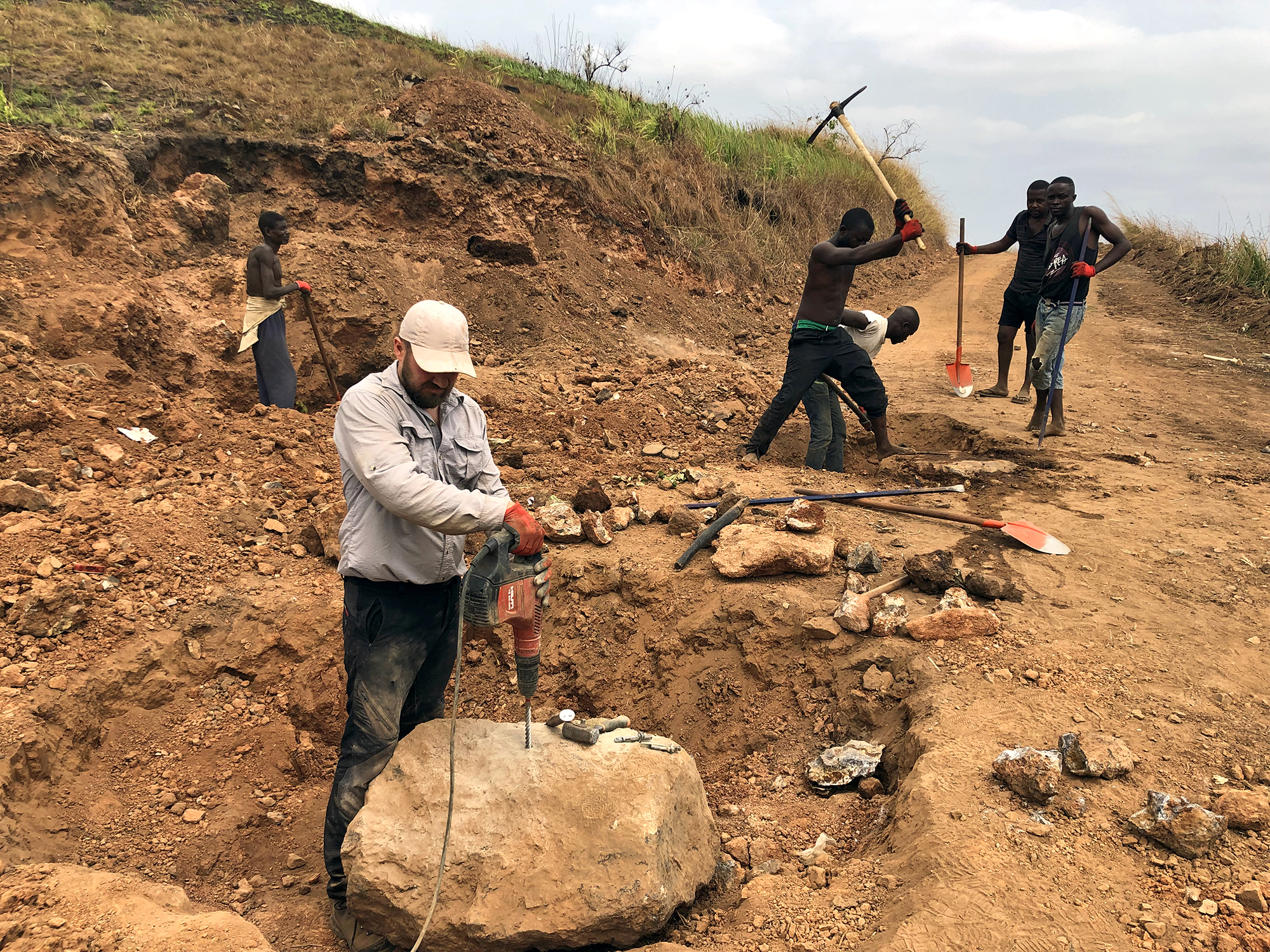
Our workings in the mineralized vein, partly cutting the road (yes, we repaired it afterwards).
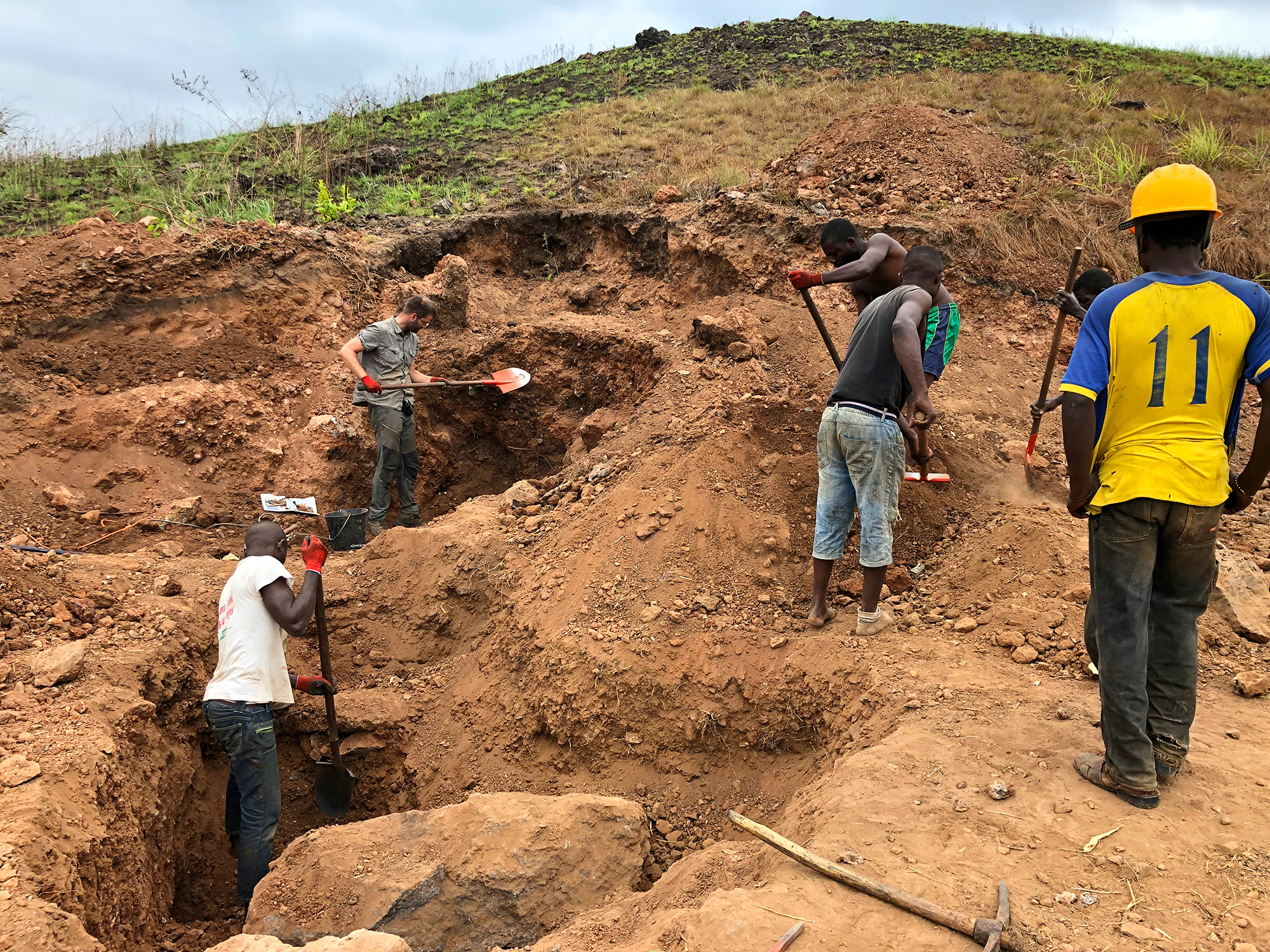
Our workings in Sanda.
Tom and Mariusz working on hard silicified limestones in Sanda.
Mariusz working in silisified limestones.
Tomek and Mariusz are splitting hard fragments of the vein.
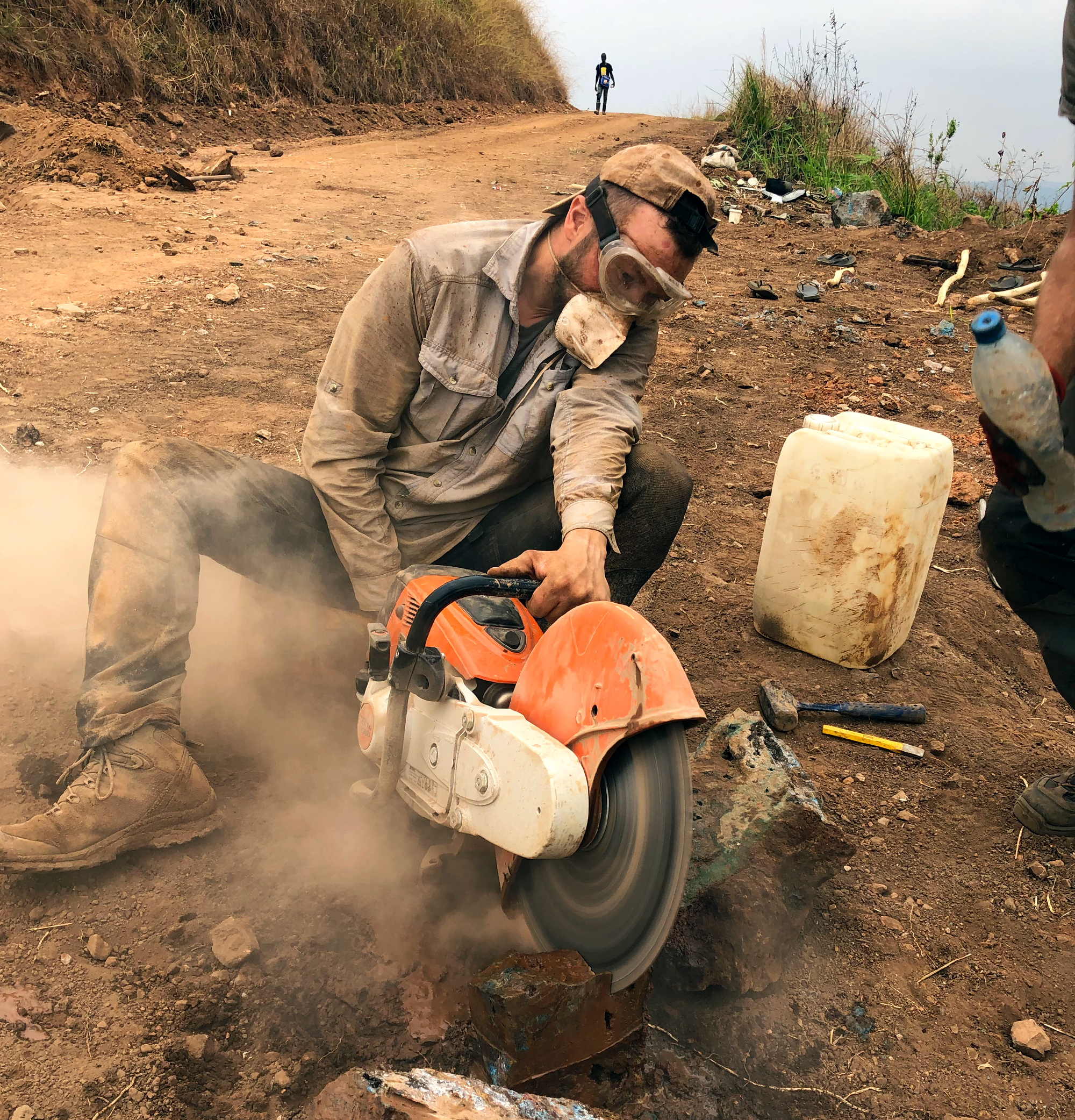
Mariusz sawing fragile specimens out of very hard, silicifed limestones. Equipment such as this big saw had to be transported from Poland.
Dirty Mariusz after trimming specimens.
40 cm big pocket in situ in Sanda with plancheite, cerussite and quartz perimorphoses after hemimorphite.
Pocket in situ in Sanda with dioptase, wulfenite and quartz.
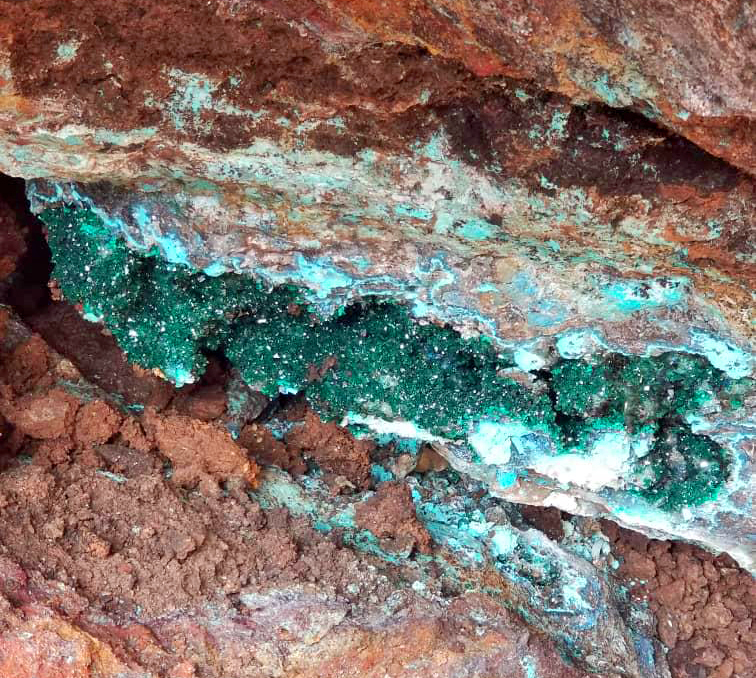
Big pocket (about 1 m) in situ with dioptase, quartz and plancheite.
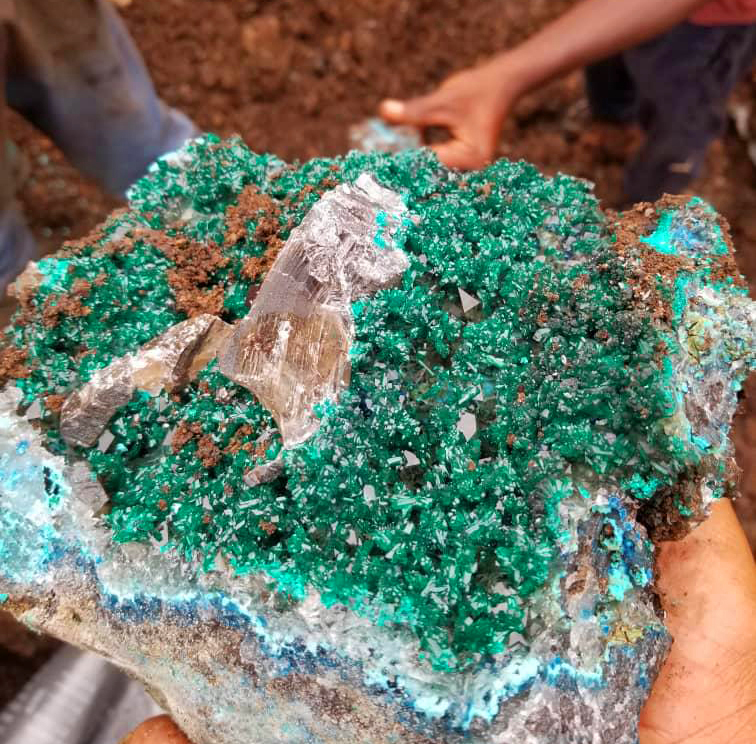
Freshly collected specimen of the dioptase on quartz and plancheite with cerussite.
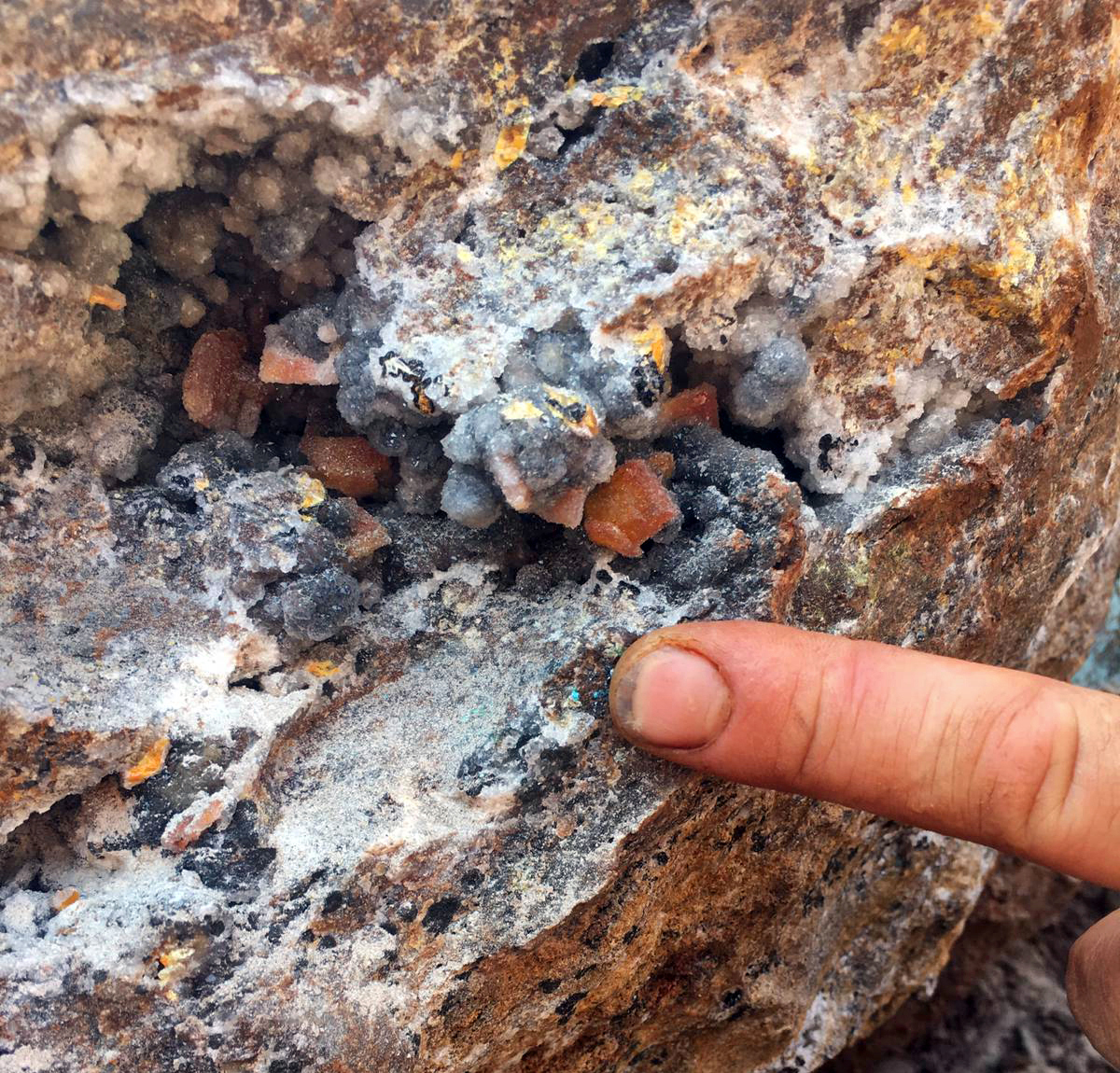
Pocket in situ in Sanda with wulfenite coated by quartz.
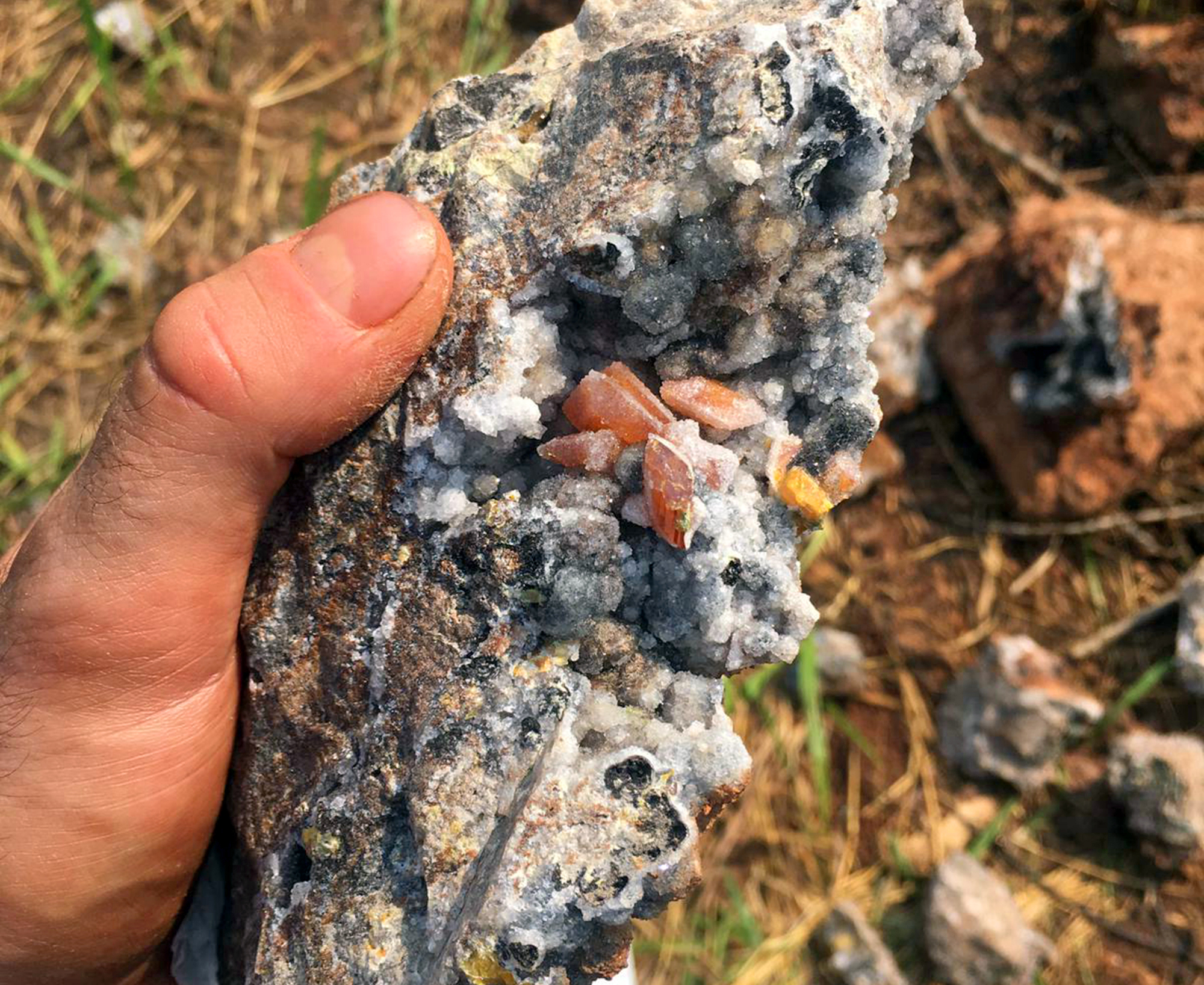
Freshly collected specimen of wulfenite coated by quartz.
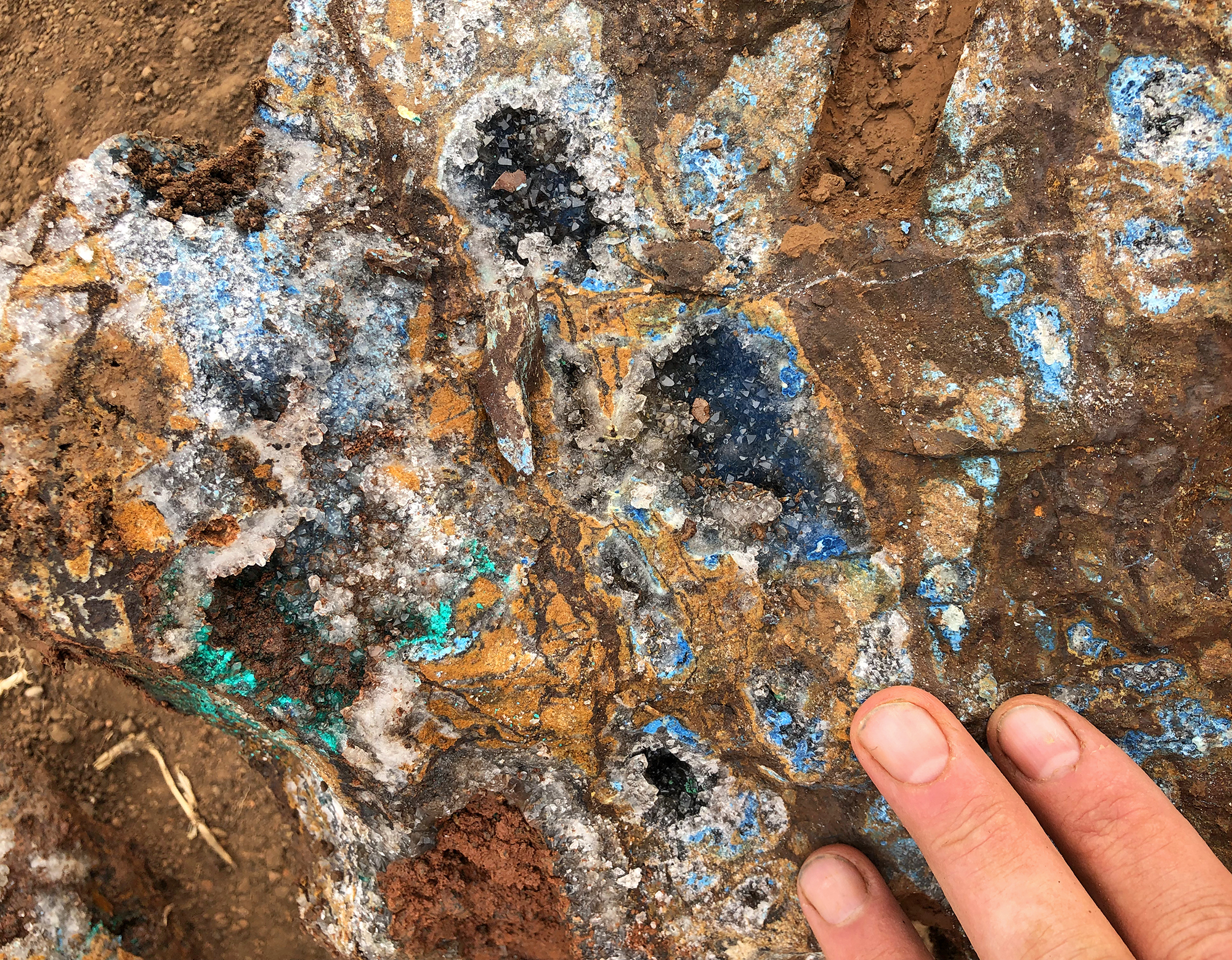
Numerous colorful pockets exposed in the mineralized vein with quartz, plancheite and dioptase.
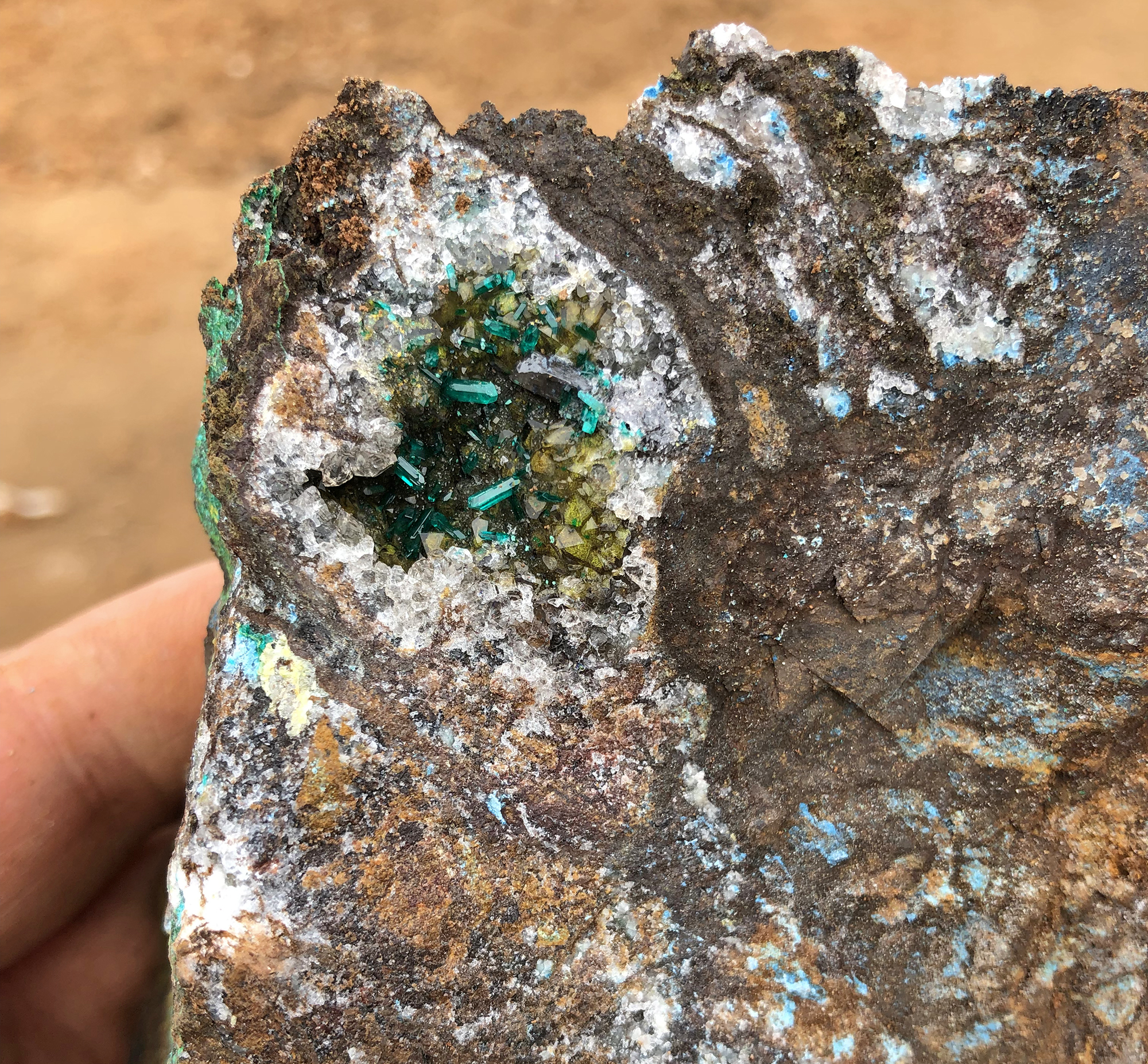
Freshly collected small pocket with dioptase on quartz.
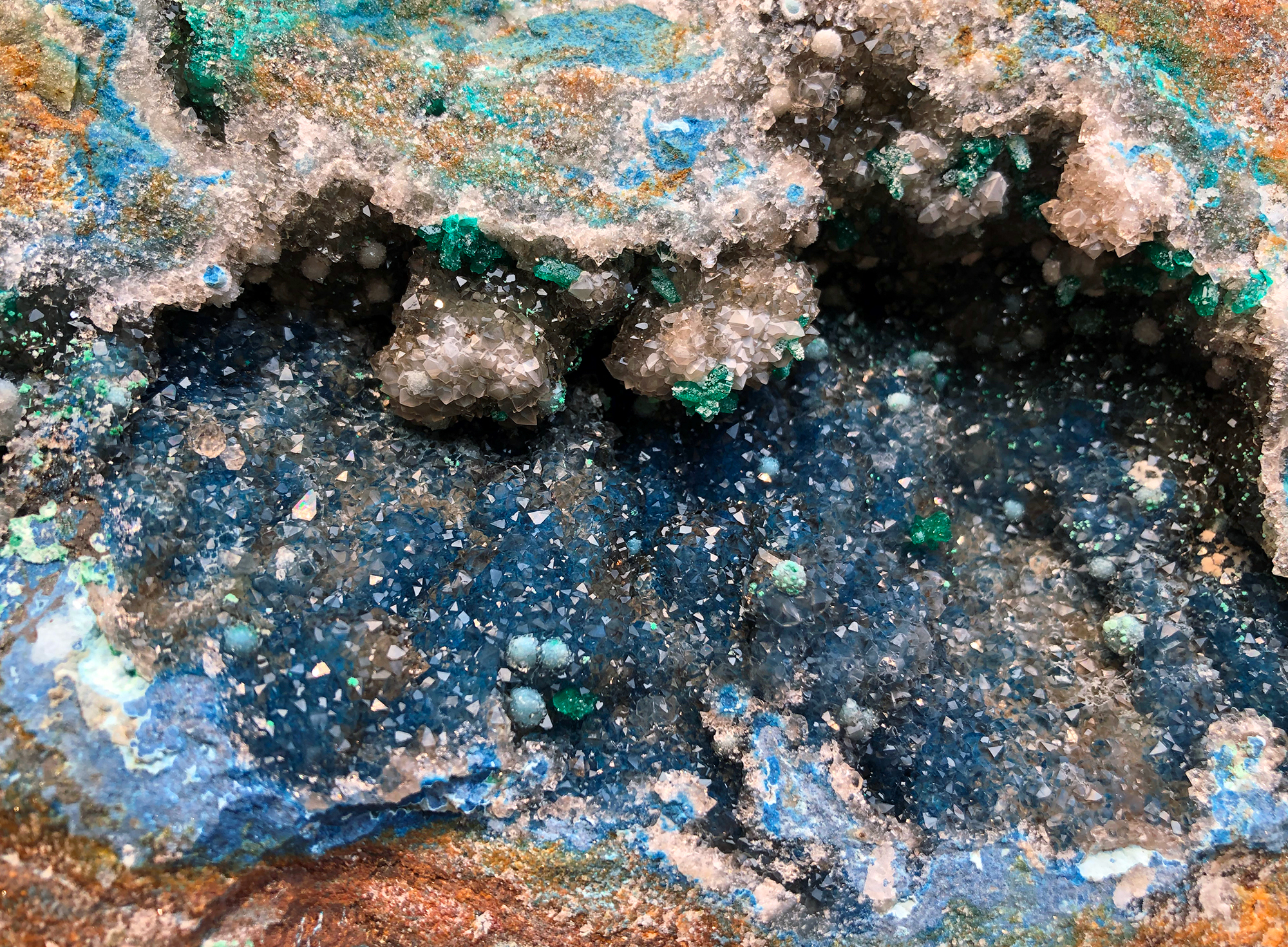
Classic from Sanda – quartz with plancheite and mlalachite.
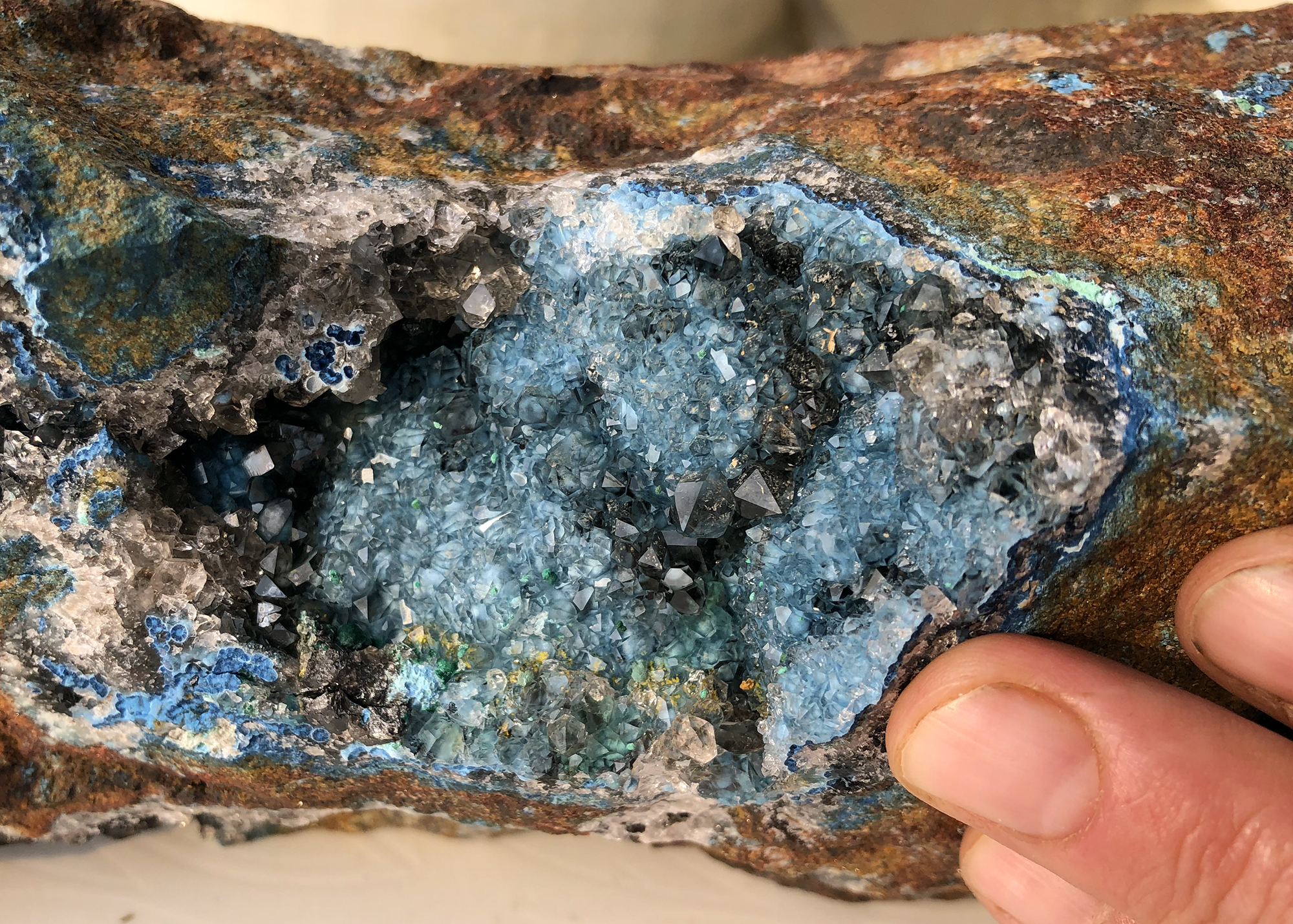
Classic from Sanda – quartz with plancheite.
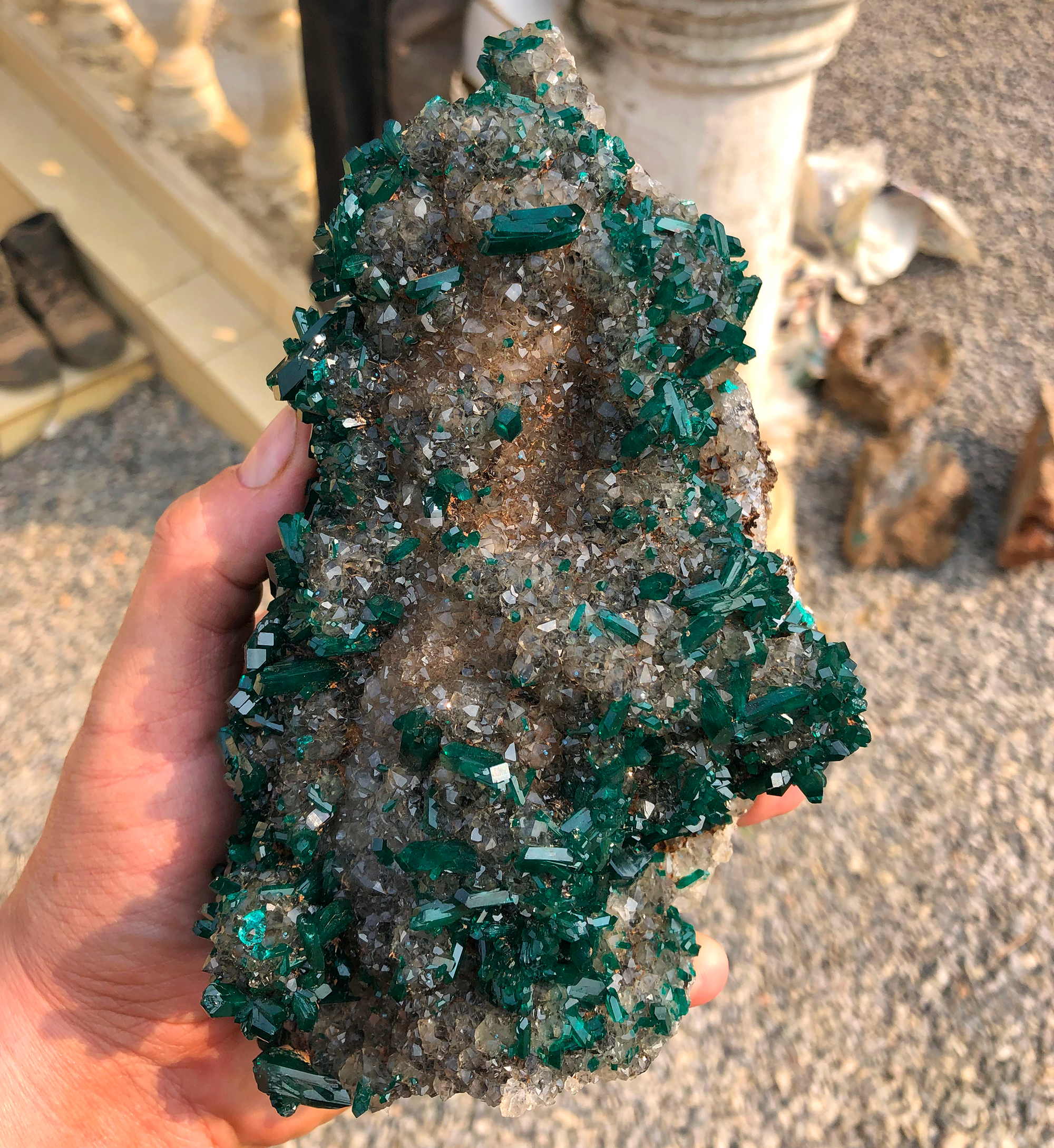
Dioptase from Sanda can be very high quality – gemmy, glossy, sharp and big growing on drusy quartz.
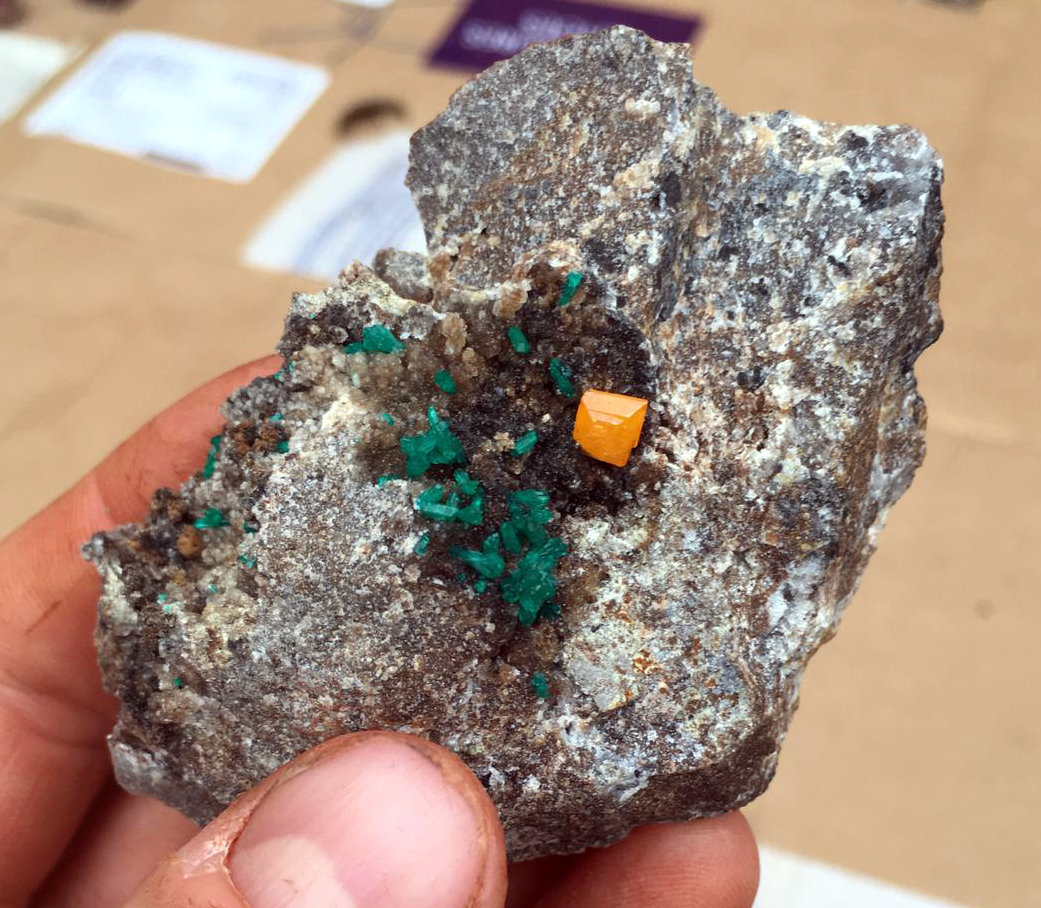
Sanda is also known for superb combinations of dioptase with wulfenite.
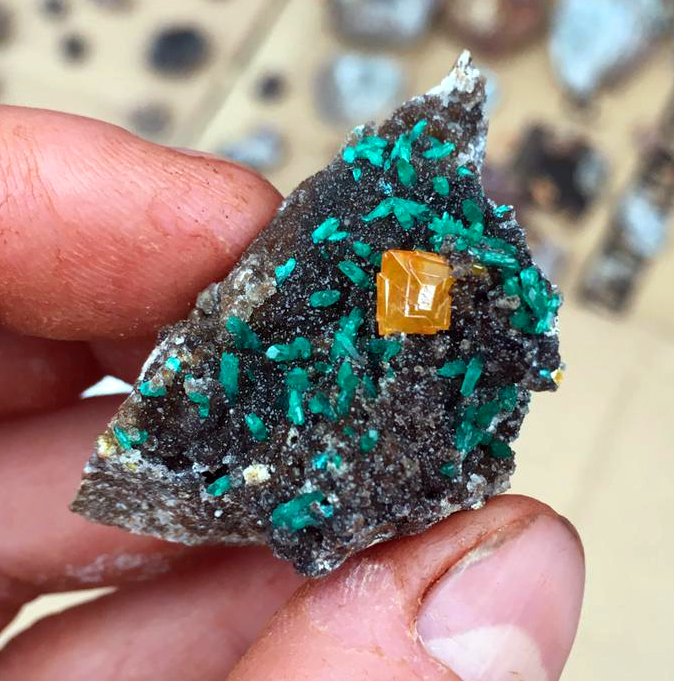
Sanda is also known for superb combinations of dioptase with wulfenite on quartz.
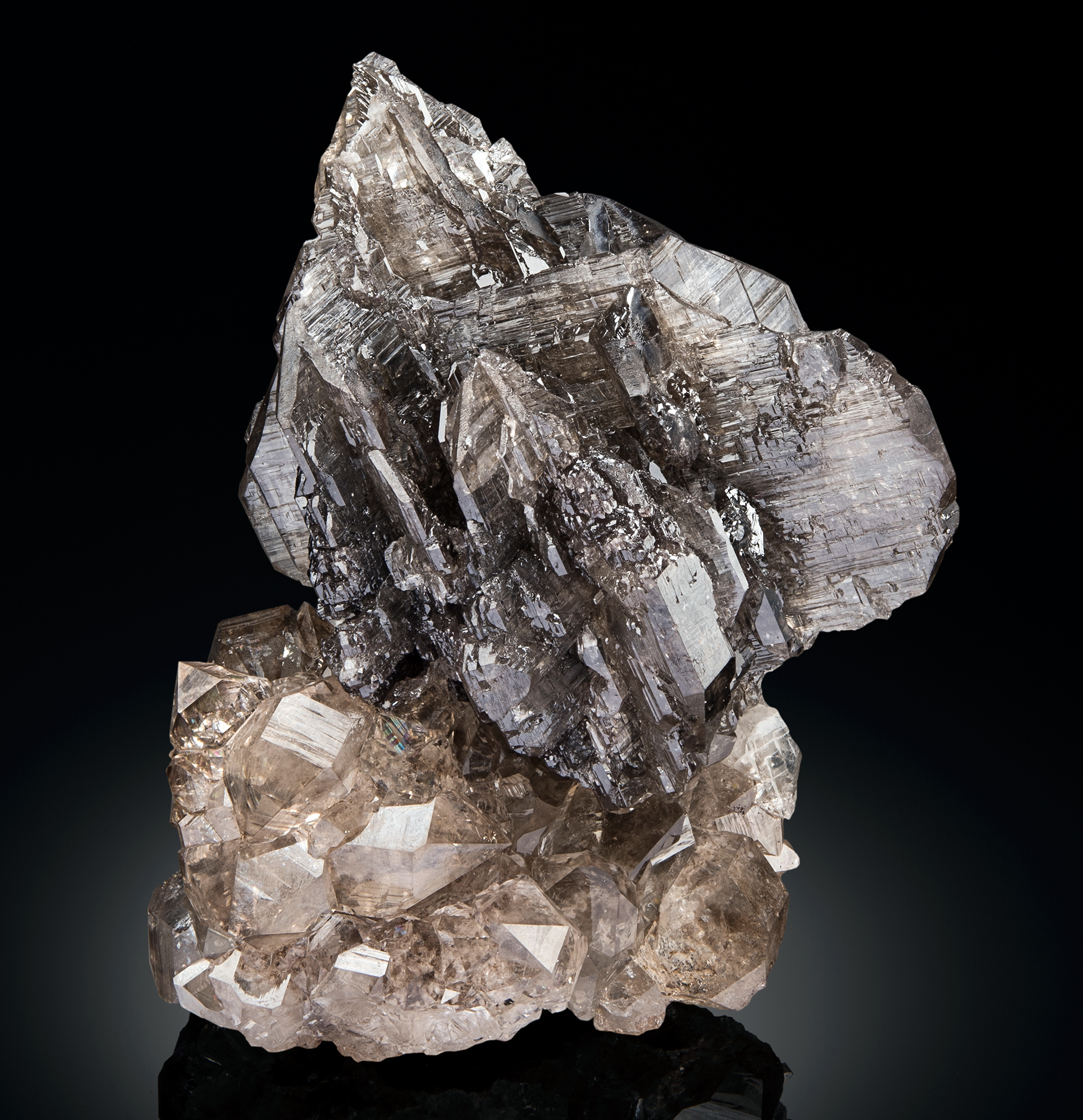
Smoky twinned cerussite on quartz from Sanda. 4.2 cm tall. Spirifer specimen. M. Mauthner photo.
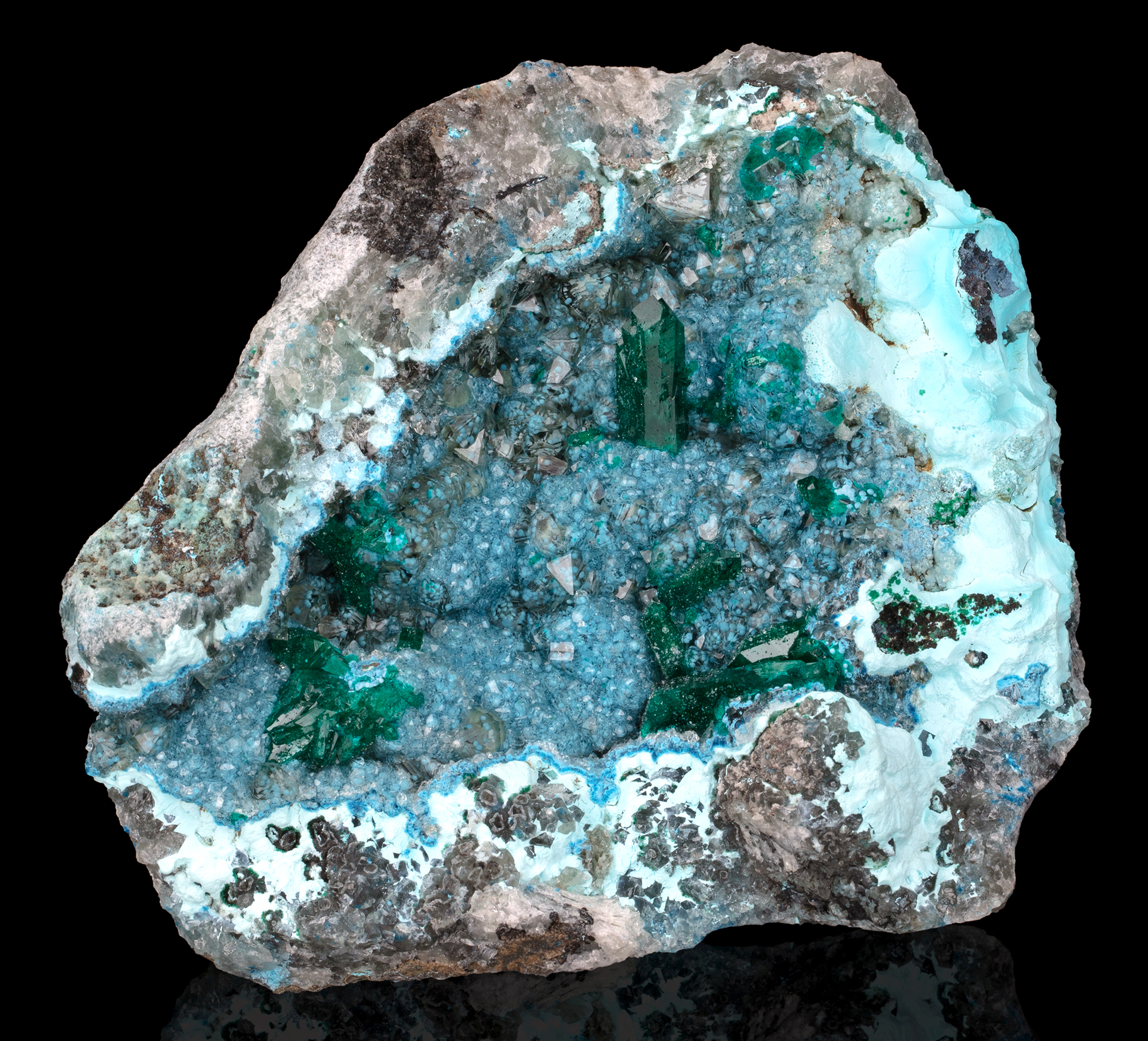
Sanda classic – dioptase on quartz growing on blue plancheite. 10 cm tall. Arkenstone specimen and photo.
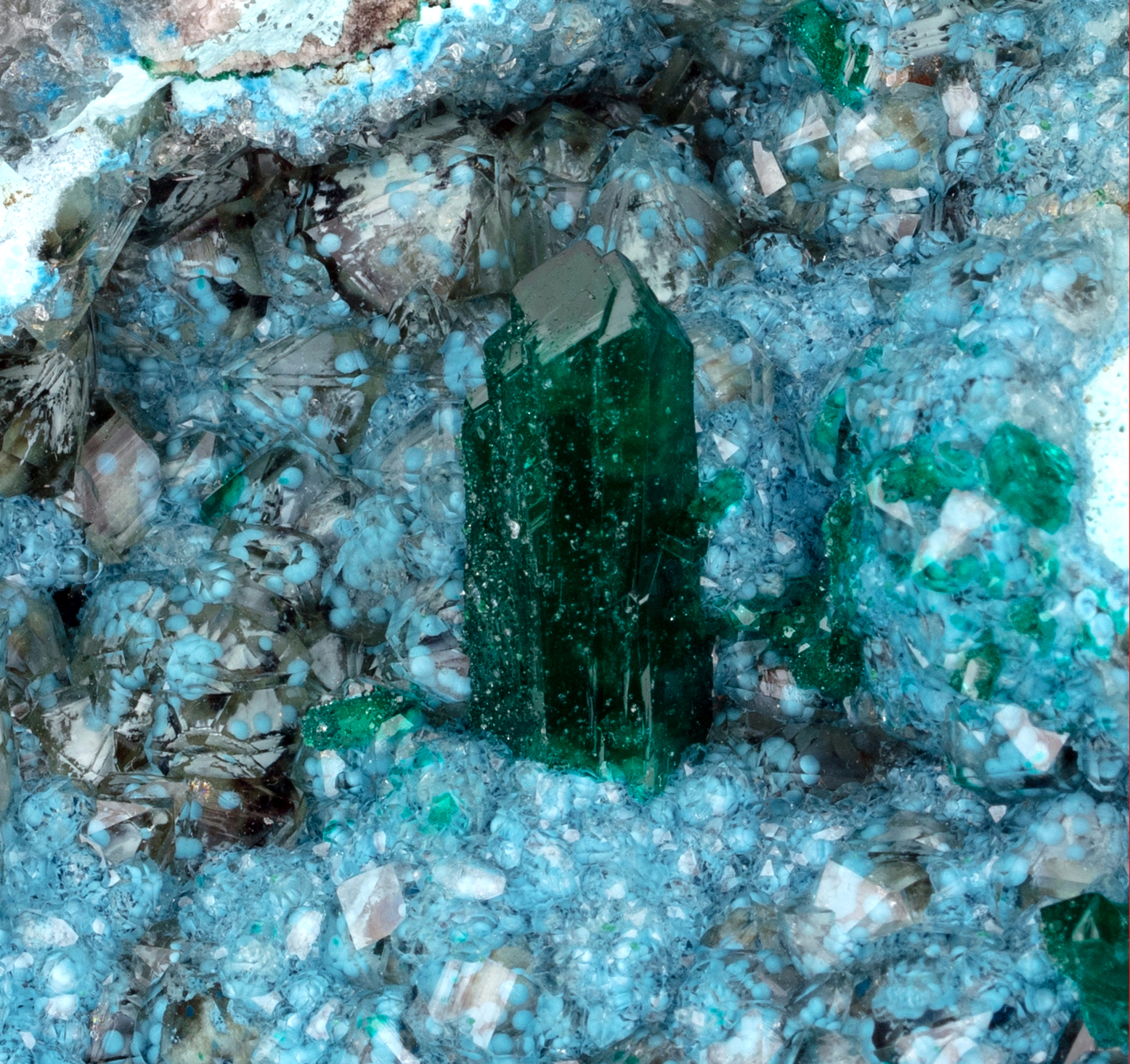
Close-up of the specimen above, note the spheroidal plancheite inclusions in quartz. Arkenstone specimen and photo.
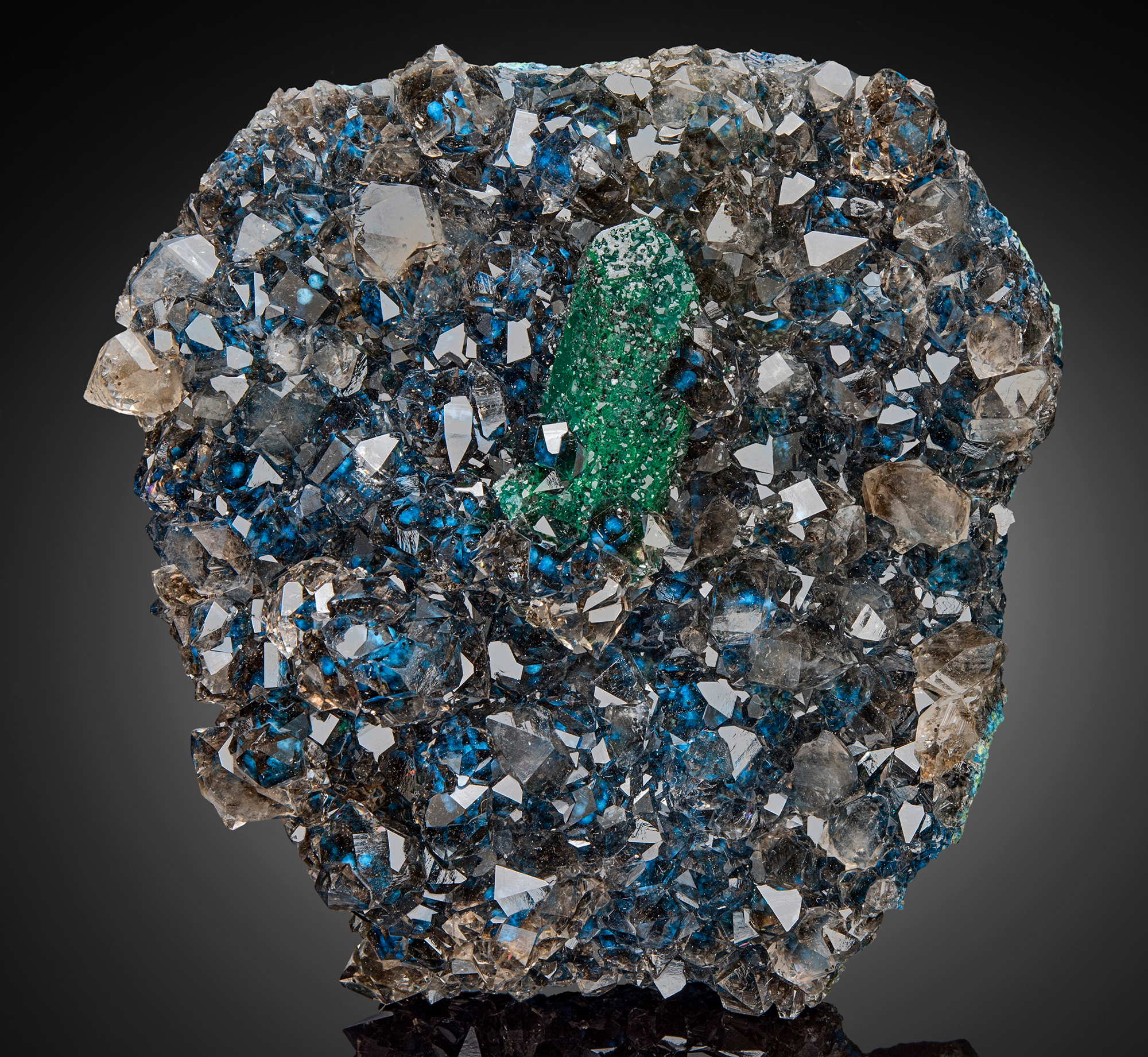
Sanda classic – dioptase on quartz growing on blue plancheite. 9 cm tall. Spirifer specimen. M. Mauthner photo.
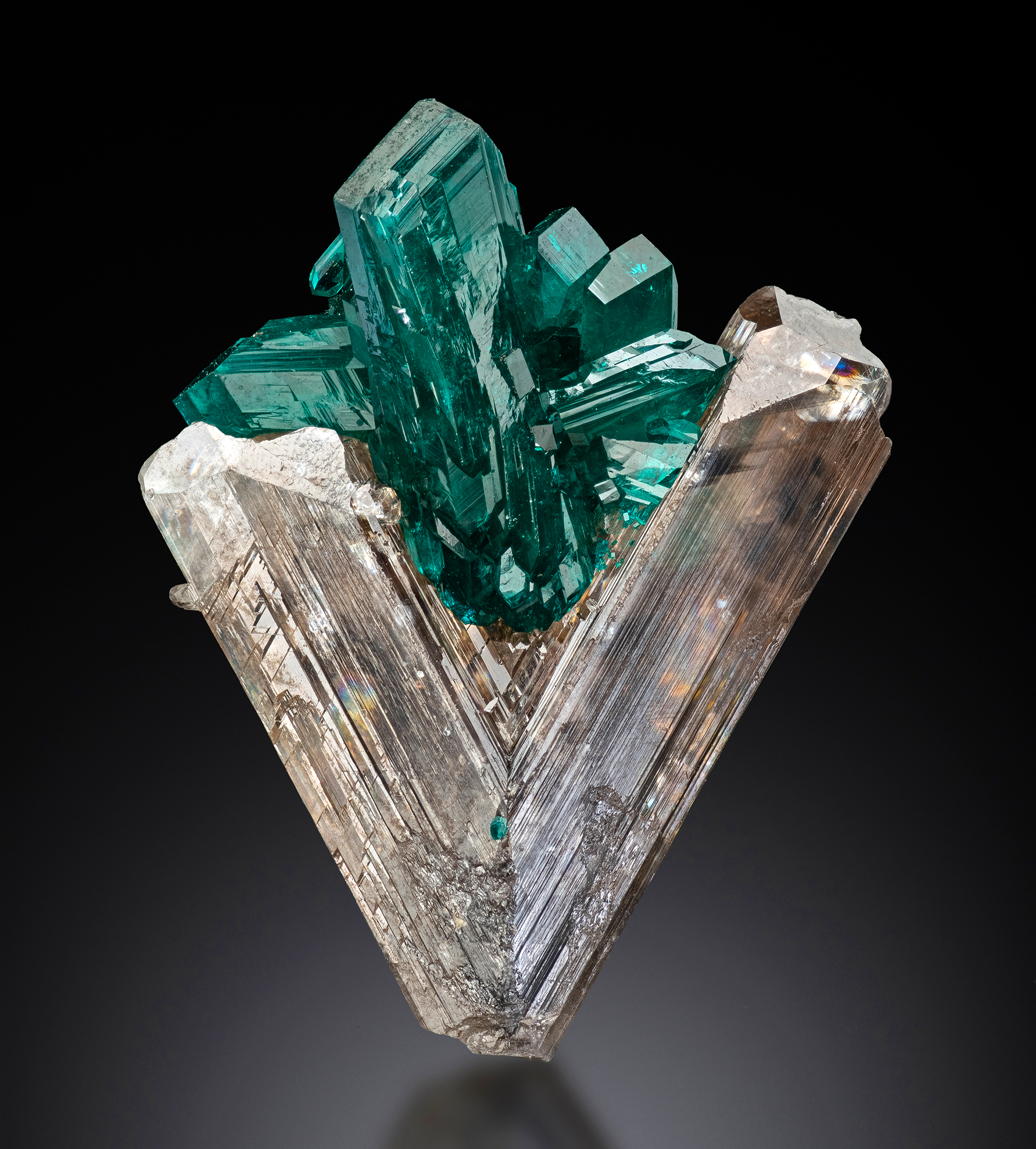
A dream specimen from Sanda – V-shape twin of cerussite with dioptase. 3.5 cm tall. Spirifer specimen. J. Scovil photo.
Our crew after whole day of mining ready to go home – dirty and happy.
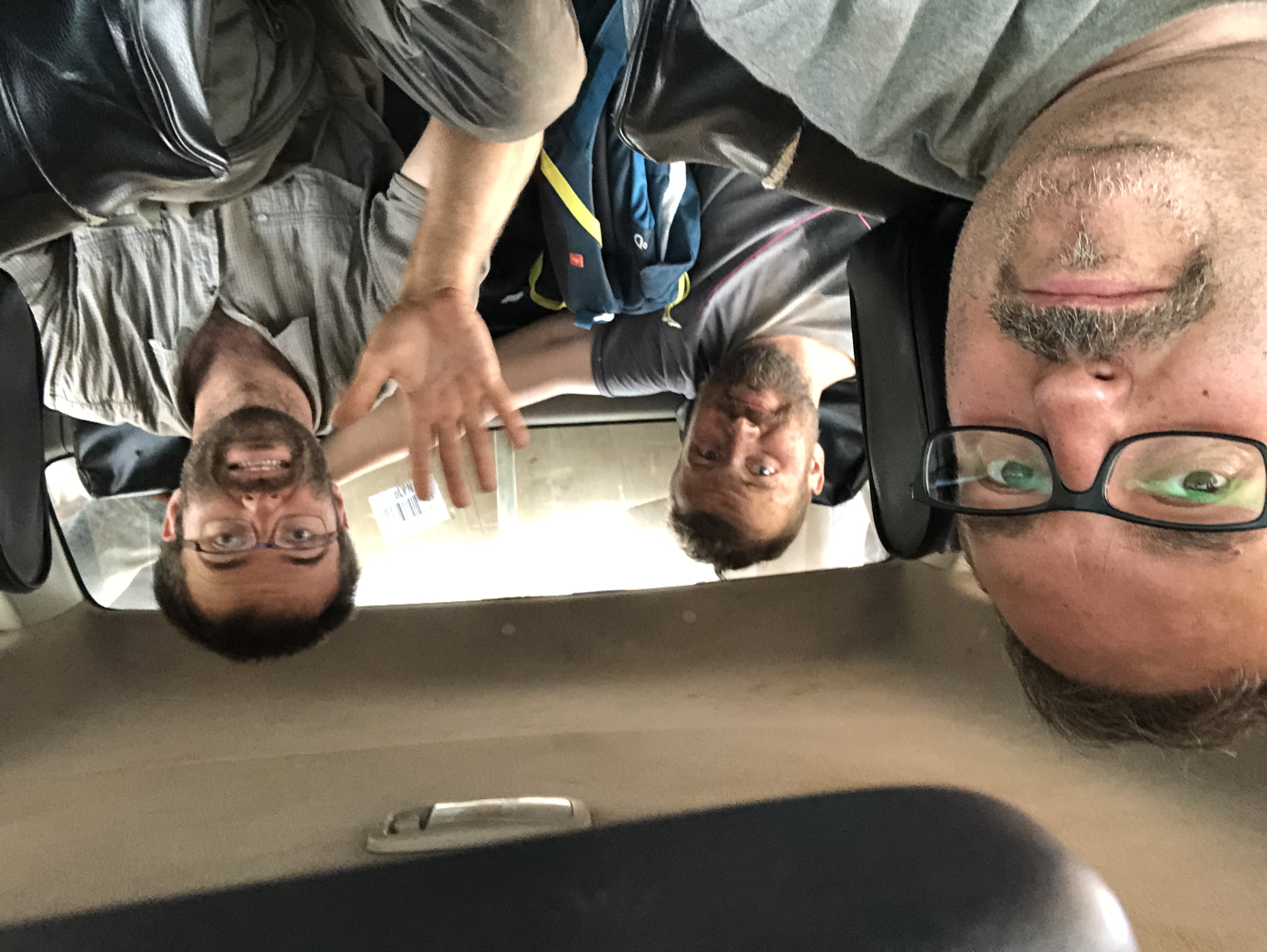
Dirty and happy after another day of mining.

Another area which we briefly explored were the workings close to Ngouedi.
Asia on the way to Ngouedi workings.
Spectacular folds in Neoproterozoic limestones near to Ngouedi workings.
Mineralization in Ngouedi occurs in the stream.
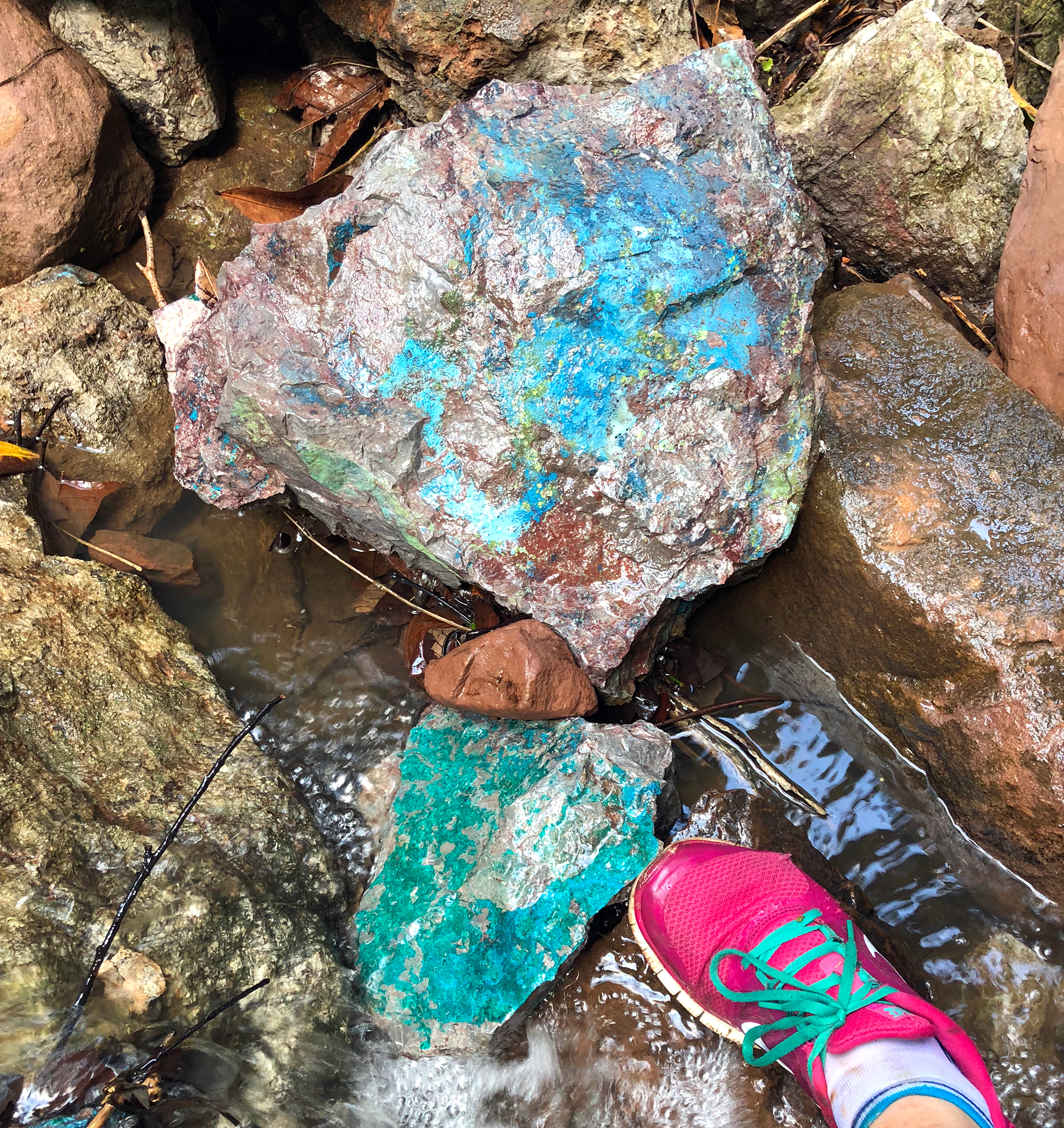
Blocks in the stream with dioptase and probably chrysocolla.
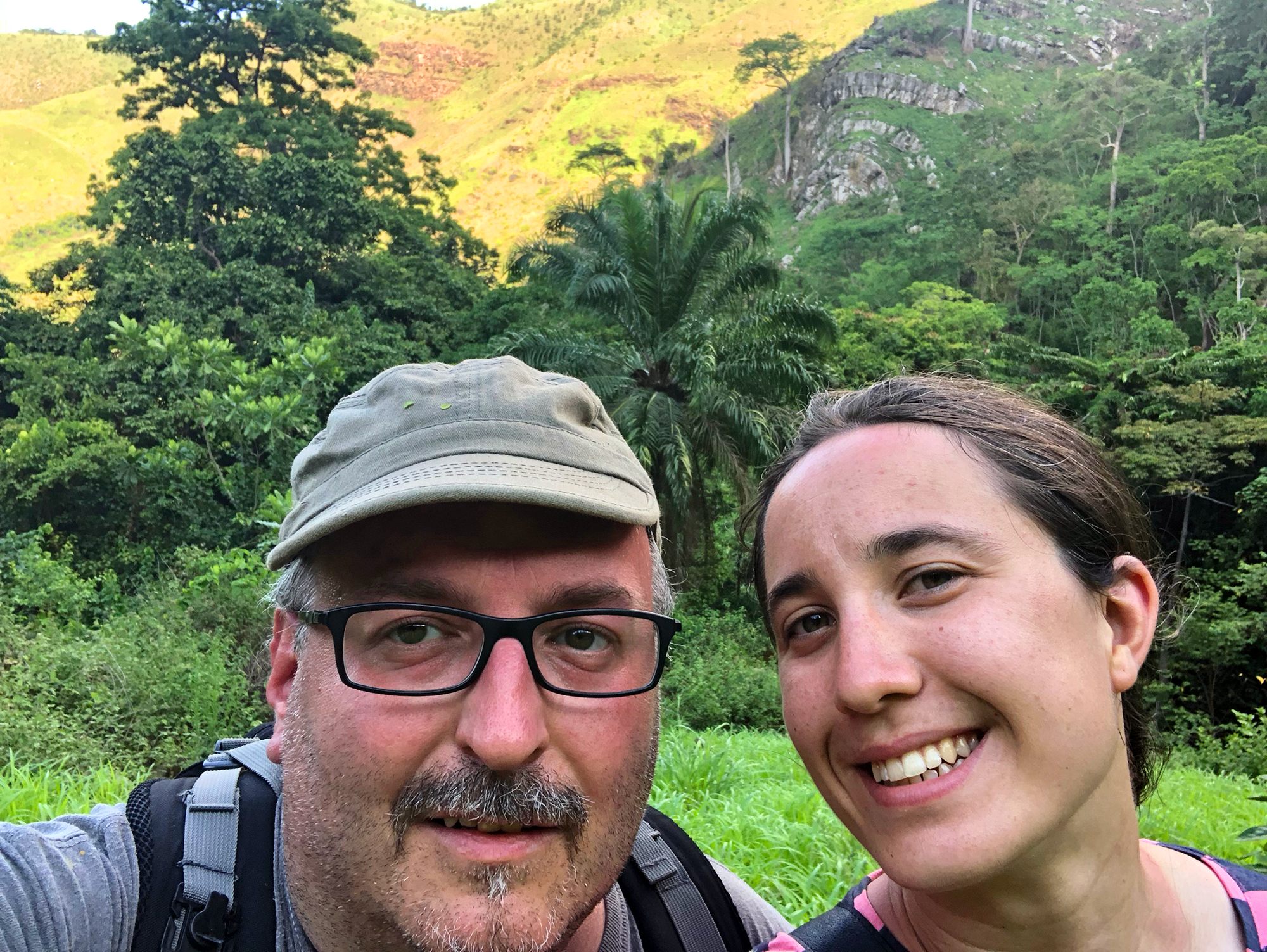
Tom and Asia after happy day in the field in the Ngouedi area.

Probably the most famous Republic of the Congo location is M'fouati. We spent there quite a lot of time exploring and digging.
Drone view to the M'fouati village and old mines.
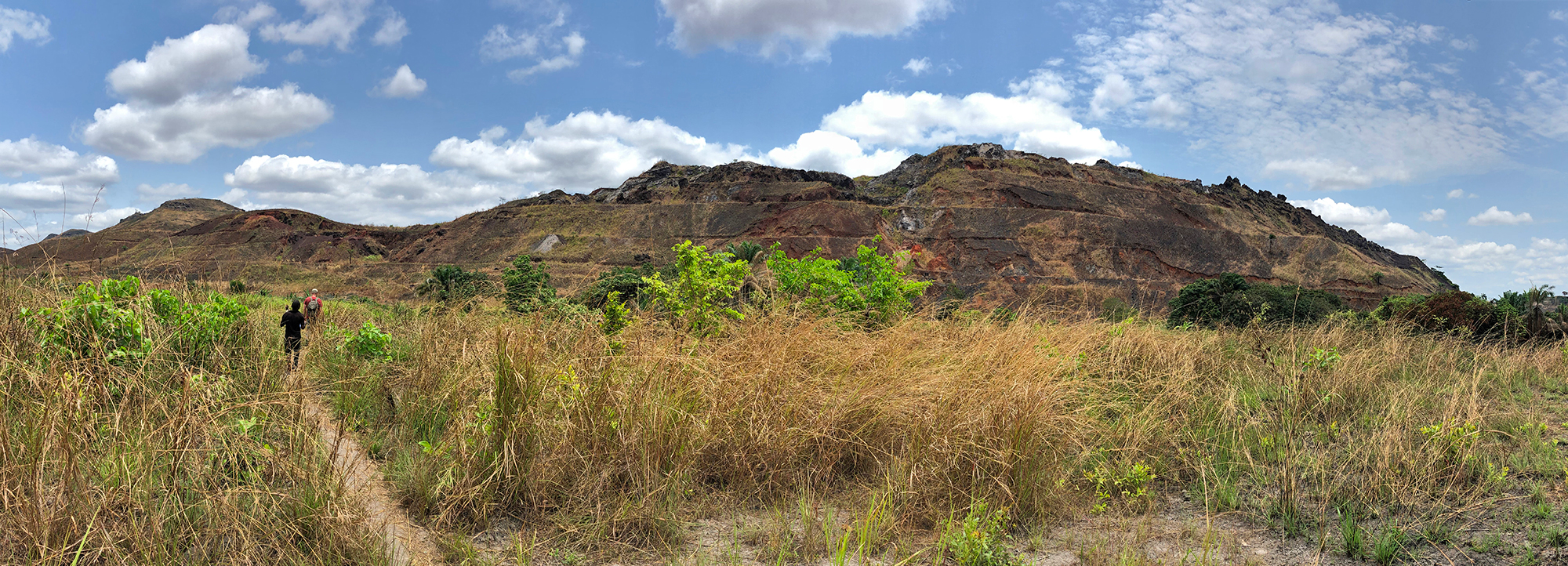
M'fouati hill that was mined for decades, by the Russians, Congolese and French, as a zinc and lead ore.
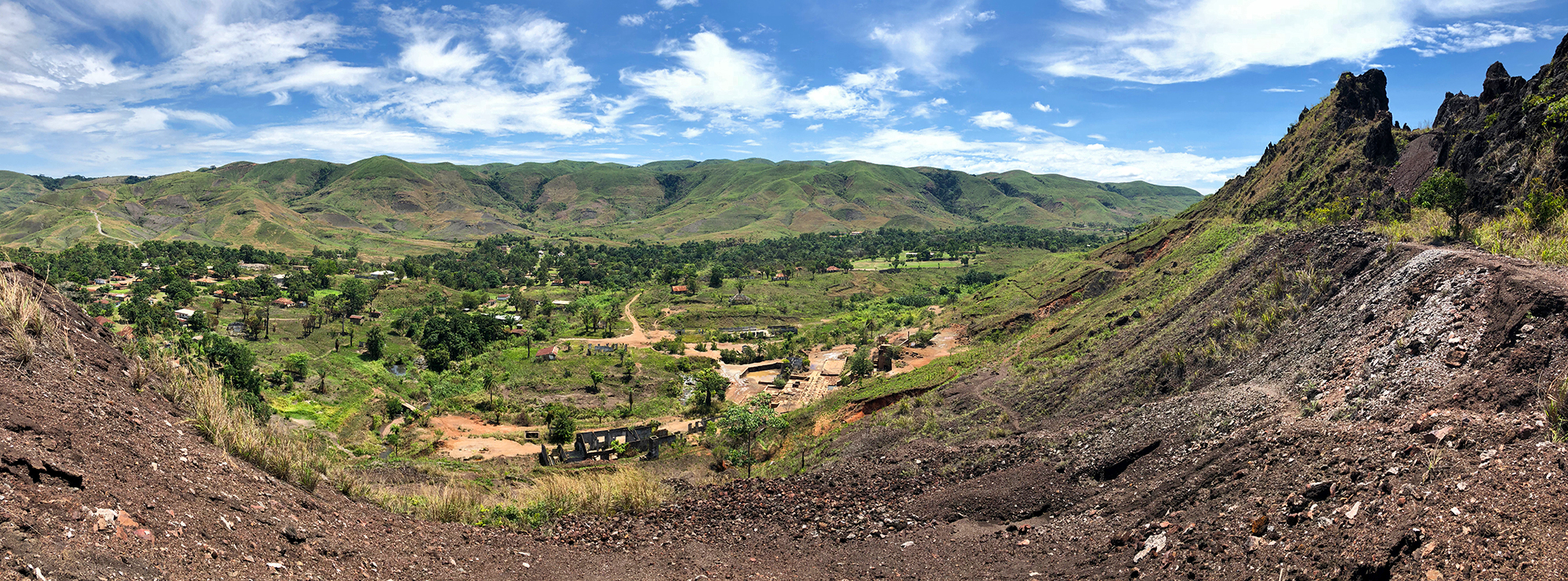
View to the M'fouati village from the hills.
Mining crew in Mfouati with a lot of equipment.

Workings in the western part of the hill famous for red wulfenite crystals.
Exploring workings in the western part of the hill famous for red wulfenite crystals.
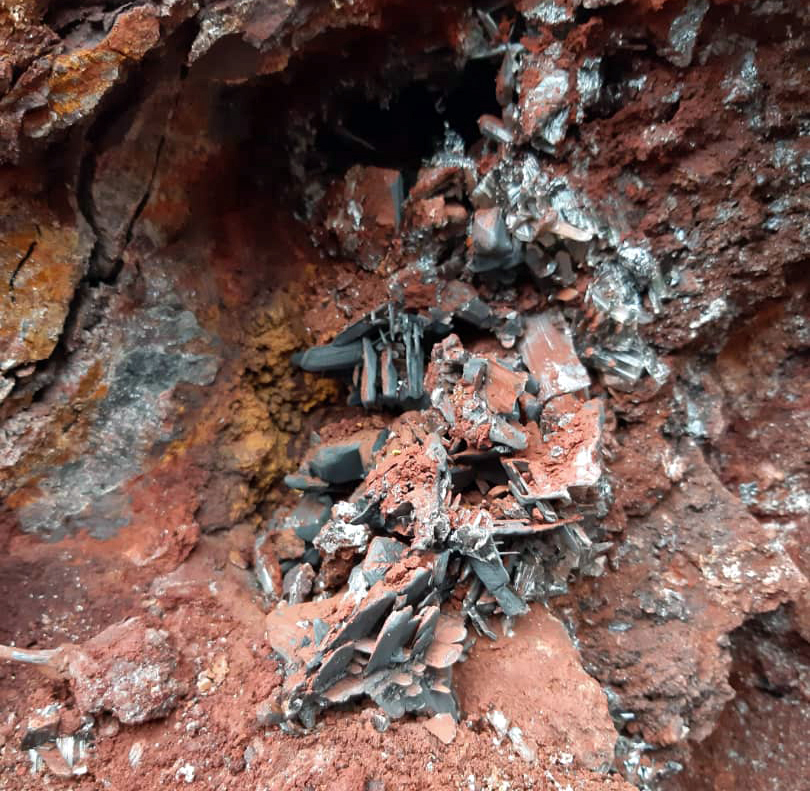
Reticulated smoky cerussite in situ in the workings in the western part of the hill.
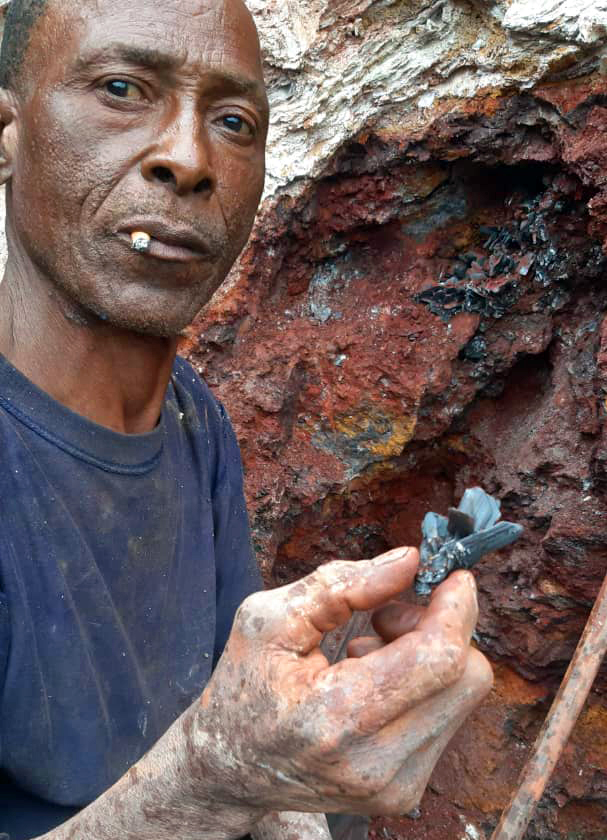
Freshly collected twinned cerussite.
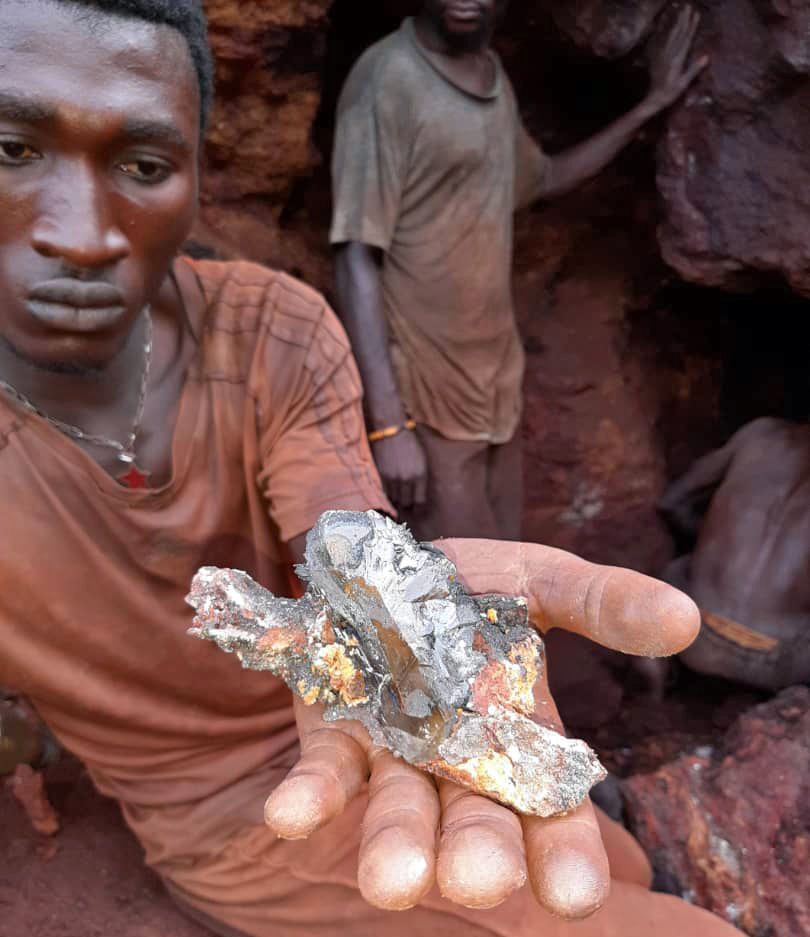
Freshly collected twinned cerussite.
Many of the cerussites and wulfenites from M'fouati are rounded, highly etched. Here cerussite twin with spot of the mimetite.
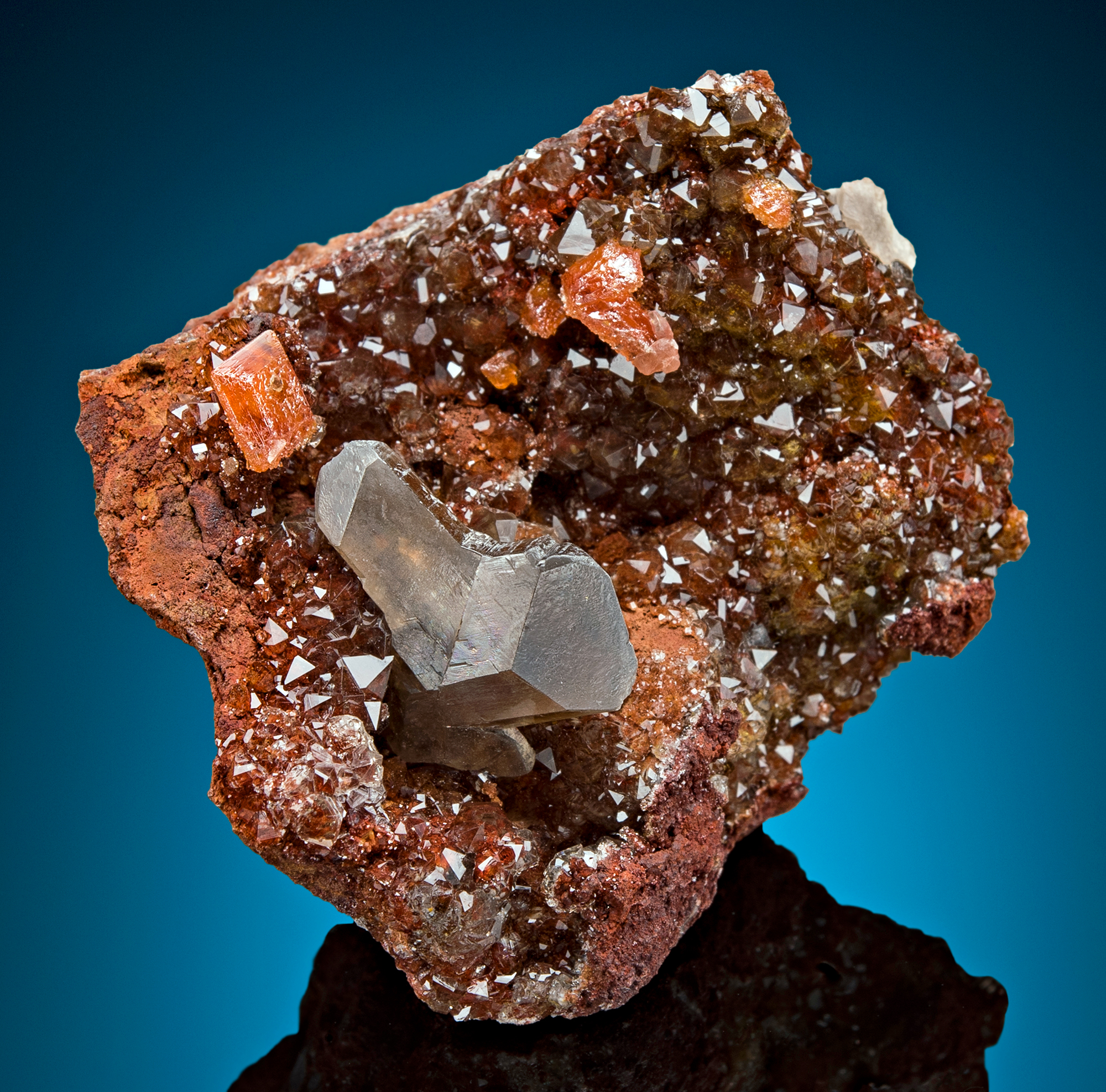
Typical M'fouati specimen – smoky cerussite with wulfenite on quartz.
Eastern part of the hill is known for hemimorphite, mimetite and also cerussites.
Digging in gossans is always fun. Mariusz collects mimetites in the eastern part of the hill.

Andrzej and Mariusz after day of collecting mimetites.
Freshly collected mimetite specimen.
Freshly collected mimetite specimen.
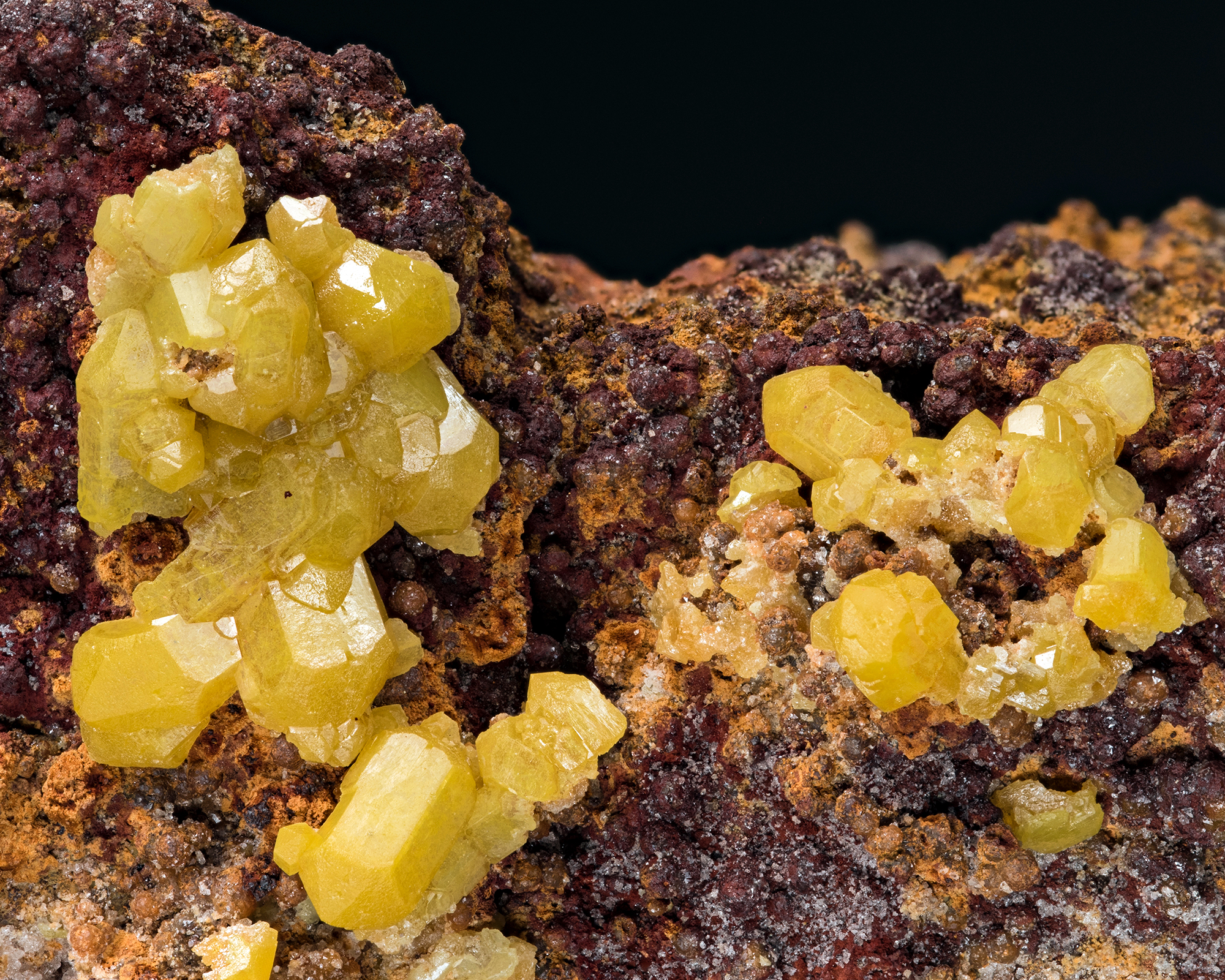
Mimetite collected in the area shown above. Field of view 3 cm. M. Mauthner photo.
Freshly collected blue hemimorphites with yellow mimetite and cerussites, from the eastern part of the M'fouati hill.
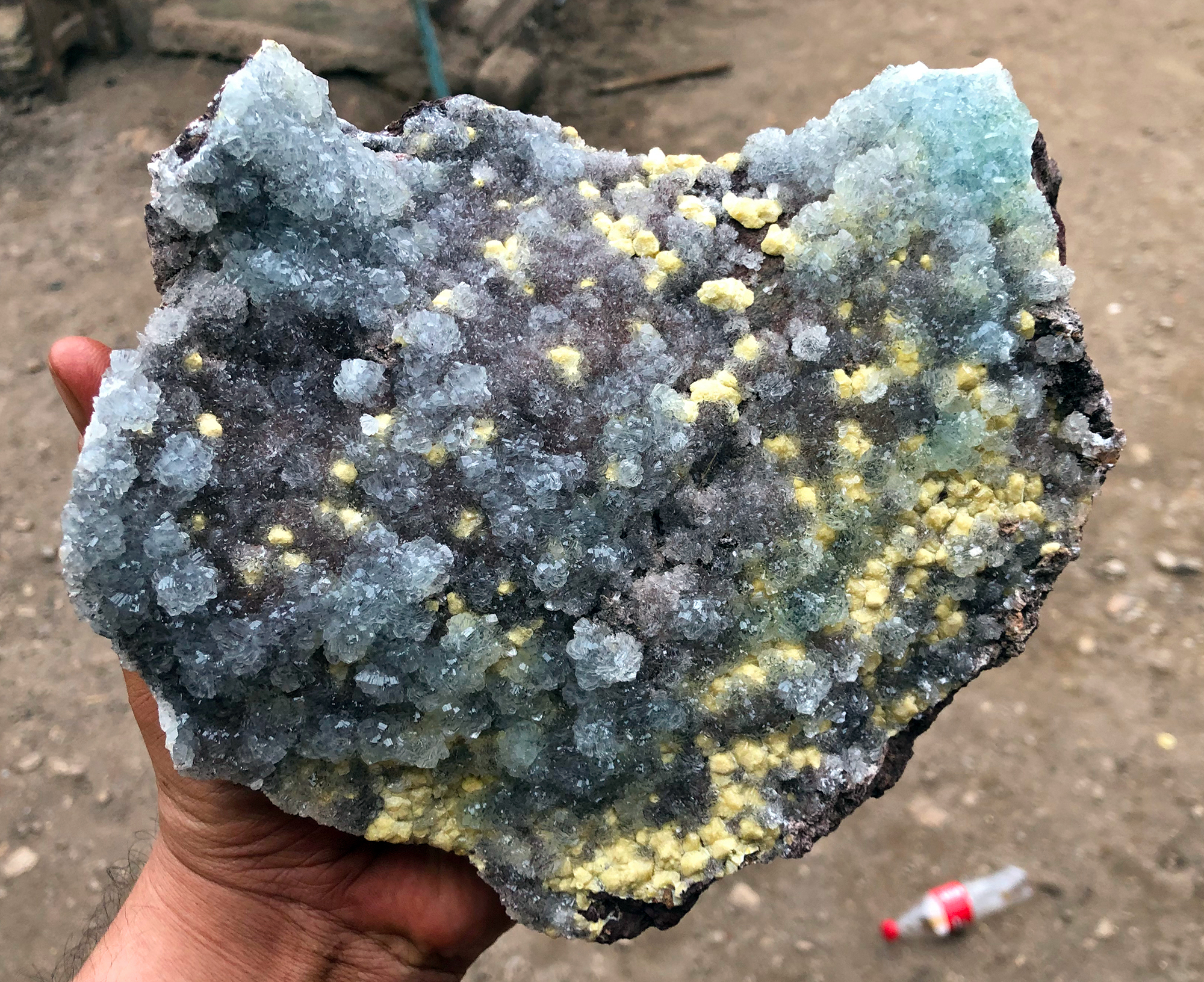
Freshly collected blue hemimorphite with yellow mimetite.
Freshly collected blue hemimorphite.
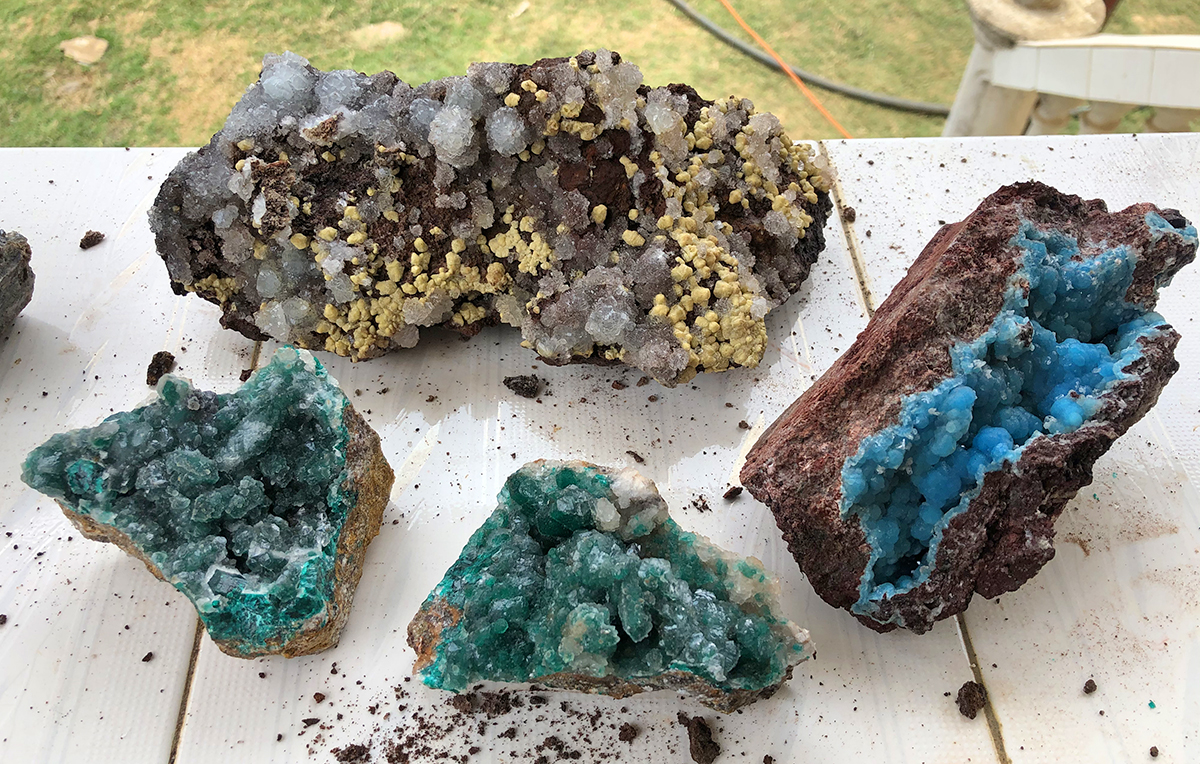
Freshly collected specimens from M'fouati (hemimorphite and mimetite) and Sanda (dioptase with quartz).
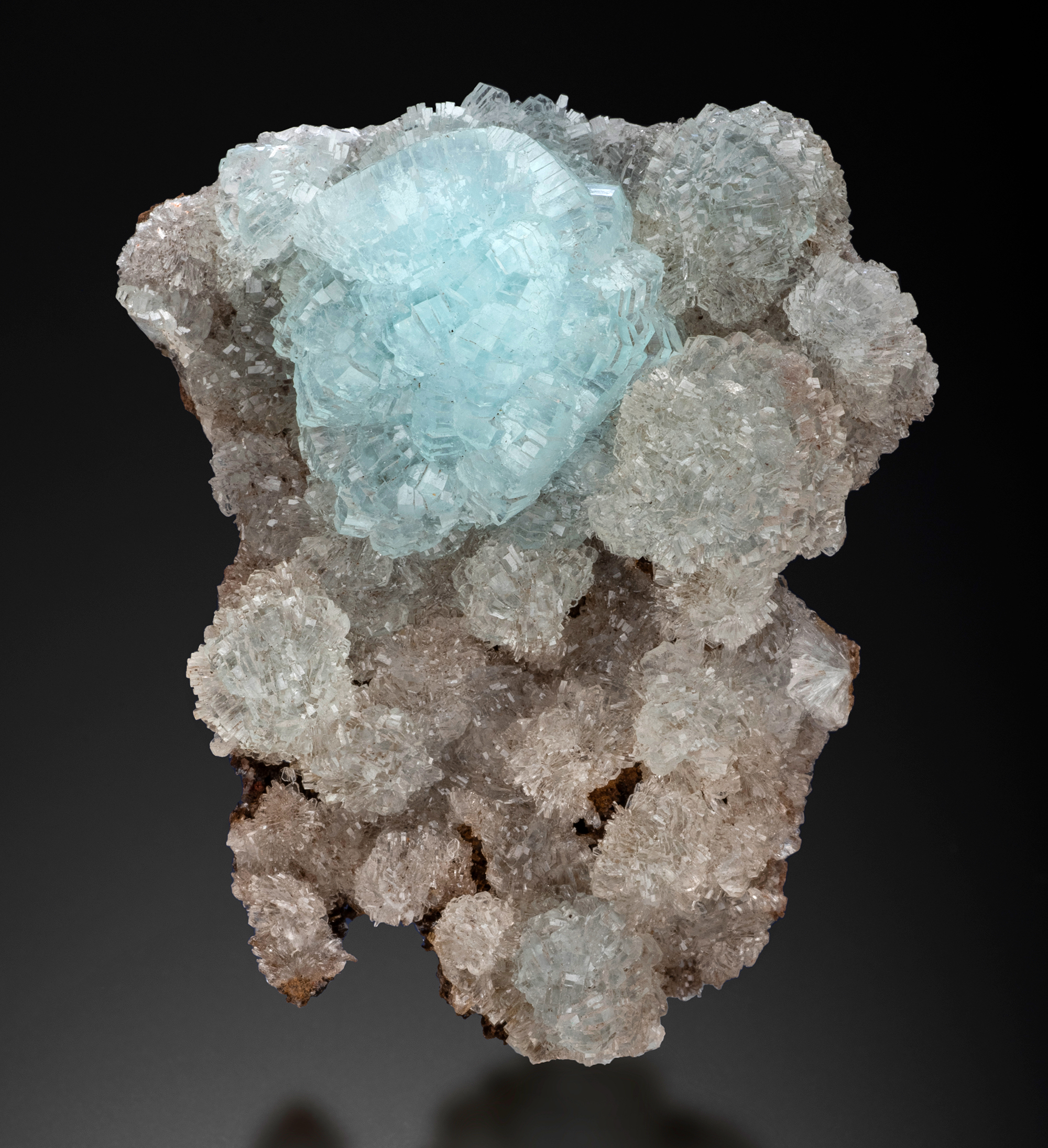
Spheroidal aggregate of the blue hemimorphite on colorless hemimorphite, from M'fouati. 6 cm tall. Spirifer specimen. J. Scovil photo.
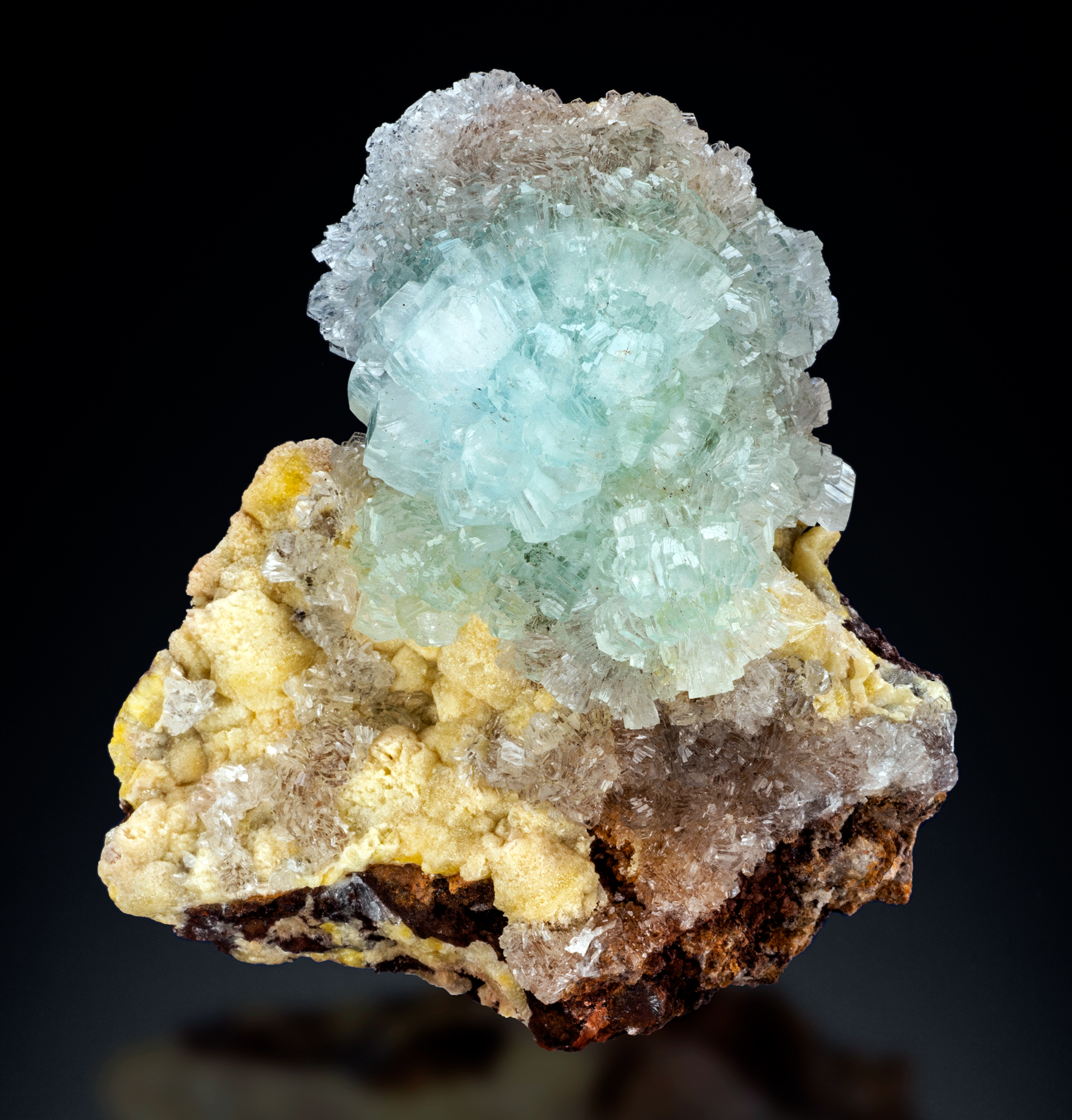
Blue hemimorphite on yellow mimetite, from M'fouati. 7 cm tall. Spirifer specimen. J. Scovil photo.
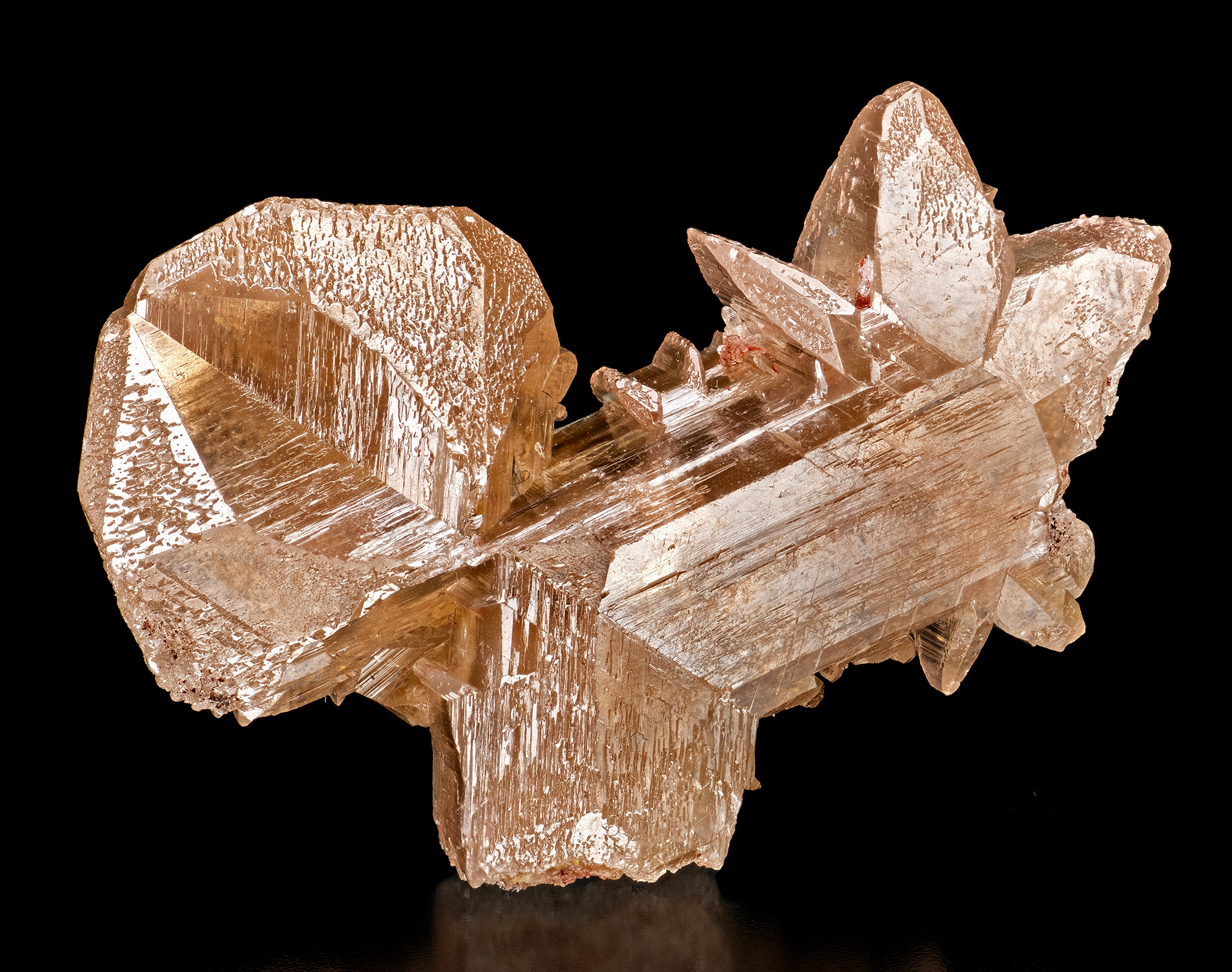
Twinned cerussite from the eastern part of the M'fouati hill. 3 cm across. Spirifer specimen. J. Scovil photo.
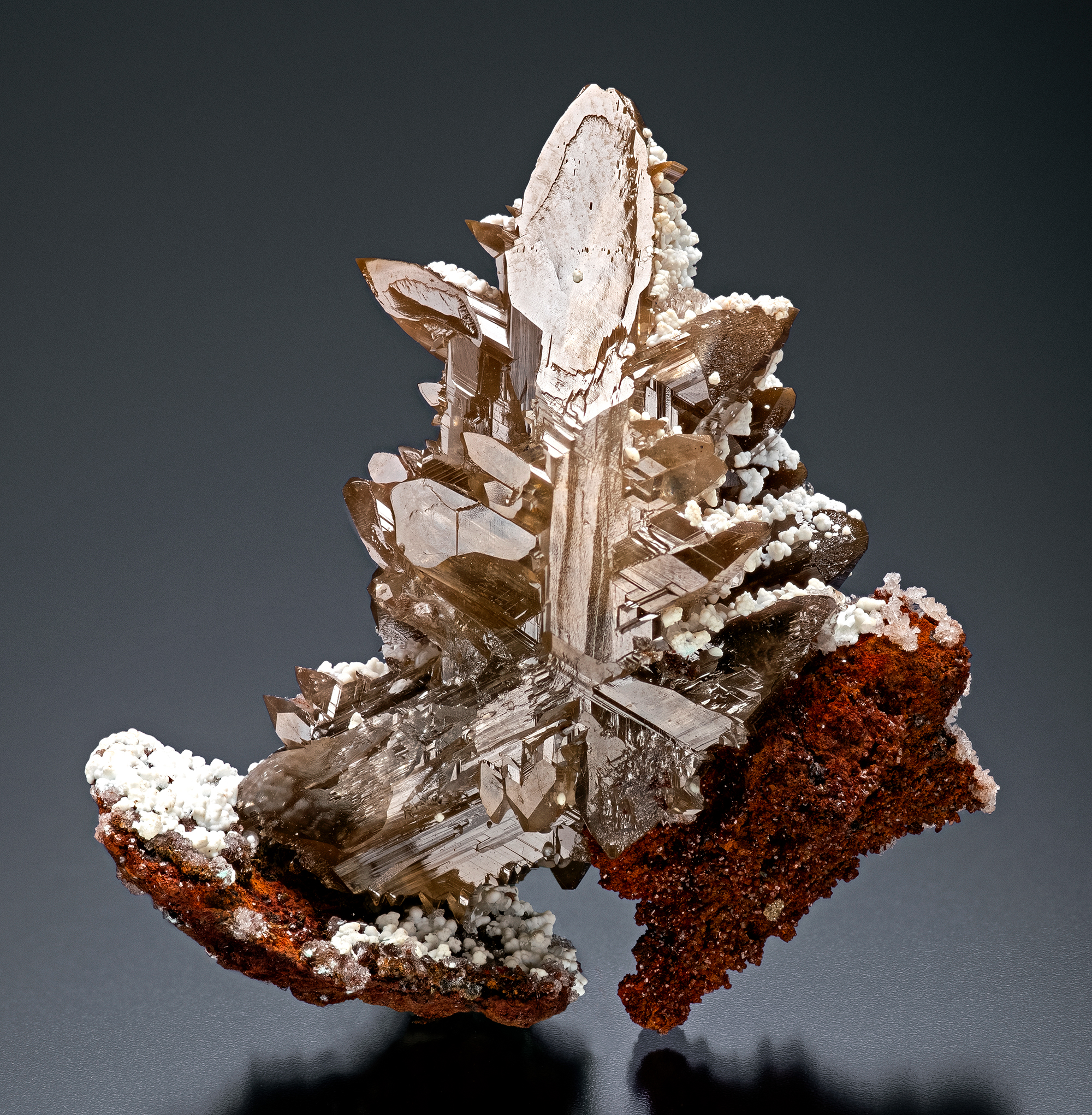
"Snowflake" of the cerussite with calcite, from the eastern part of the M'fouati hill. 3.5 cm tall. Spirifer specimen. J. Scovil photo.
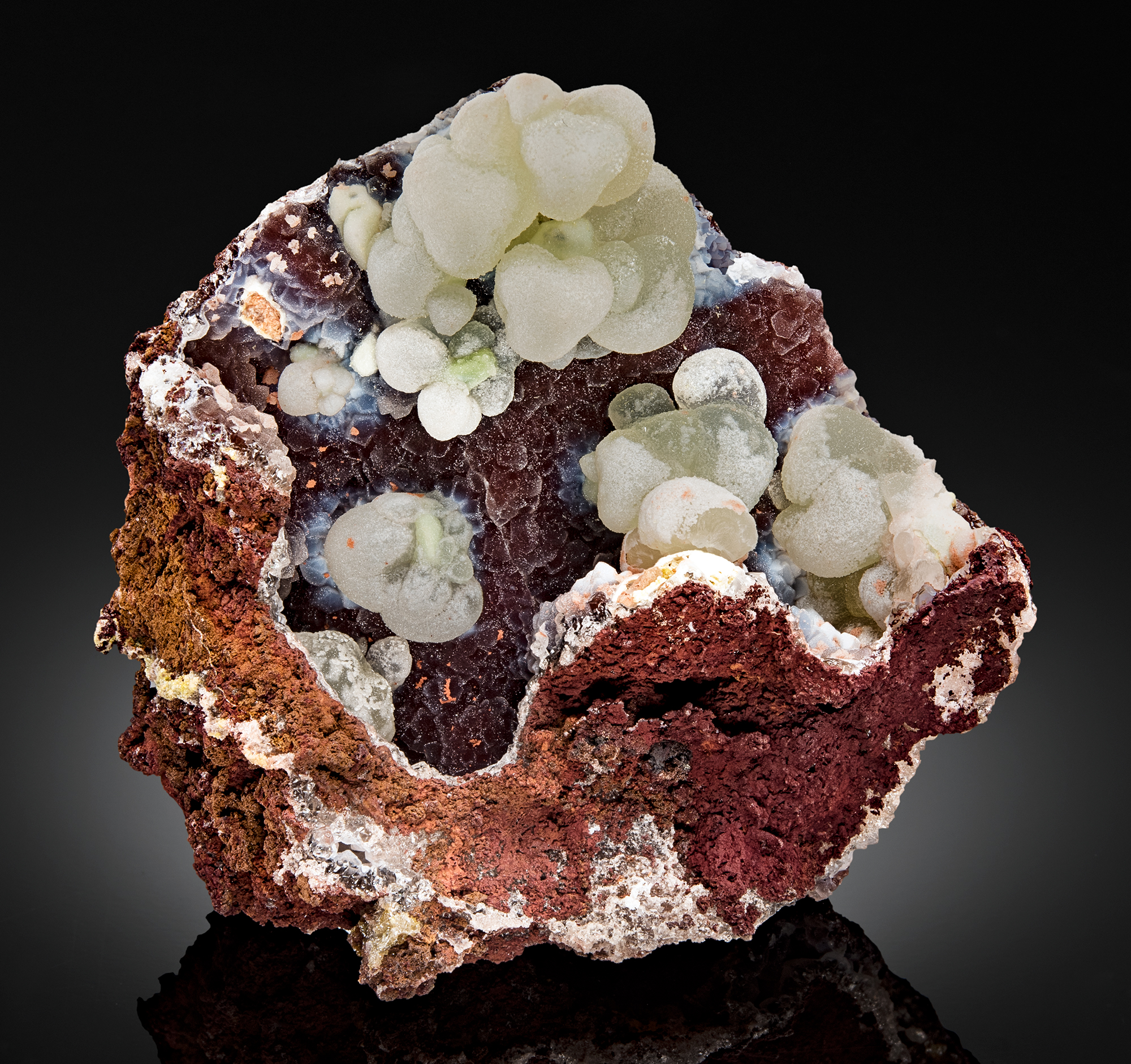
Unusual specimen for the M'fouati – botryoidal smithsonite coated by a thin layer of the quartz. 6 cm across. Spirifer specimen. J. Scovil photo.
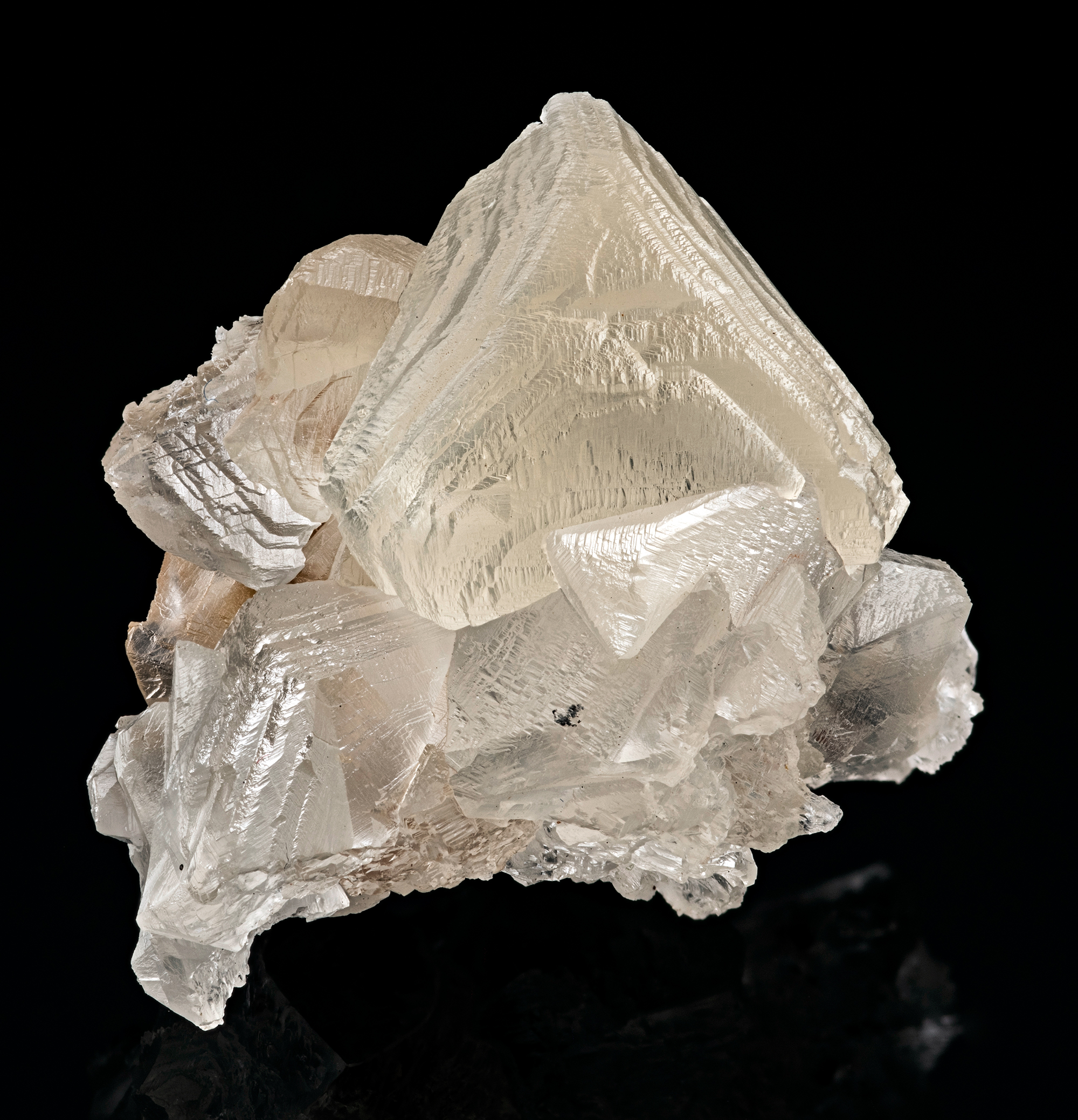
Unusual specimen for the M'fouati – well formed smithsonite crystal. 2.5 cm across. Spirifer specimen. J. Scovil photo.
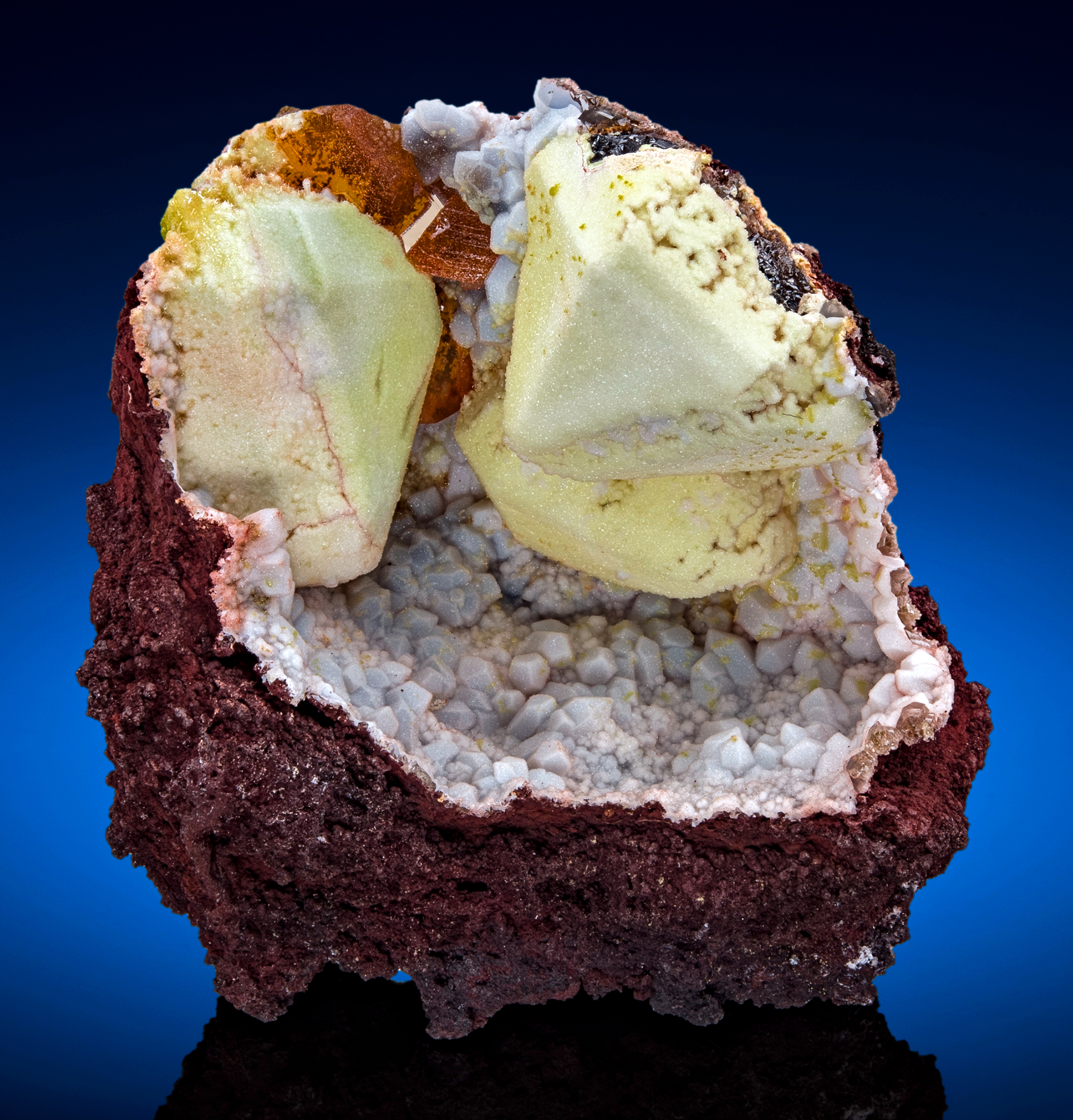
Another unusual specimen from M'fouati – twinned cerussites on quartz coated by pyromorphite. 4 cm tall. Spirifer specimen. M. Mauthner photo.
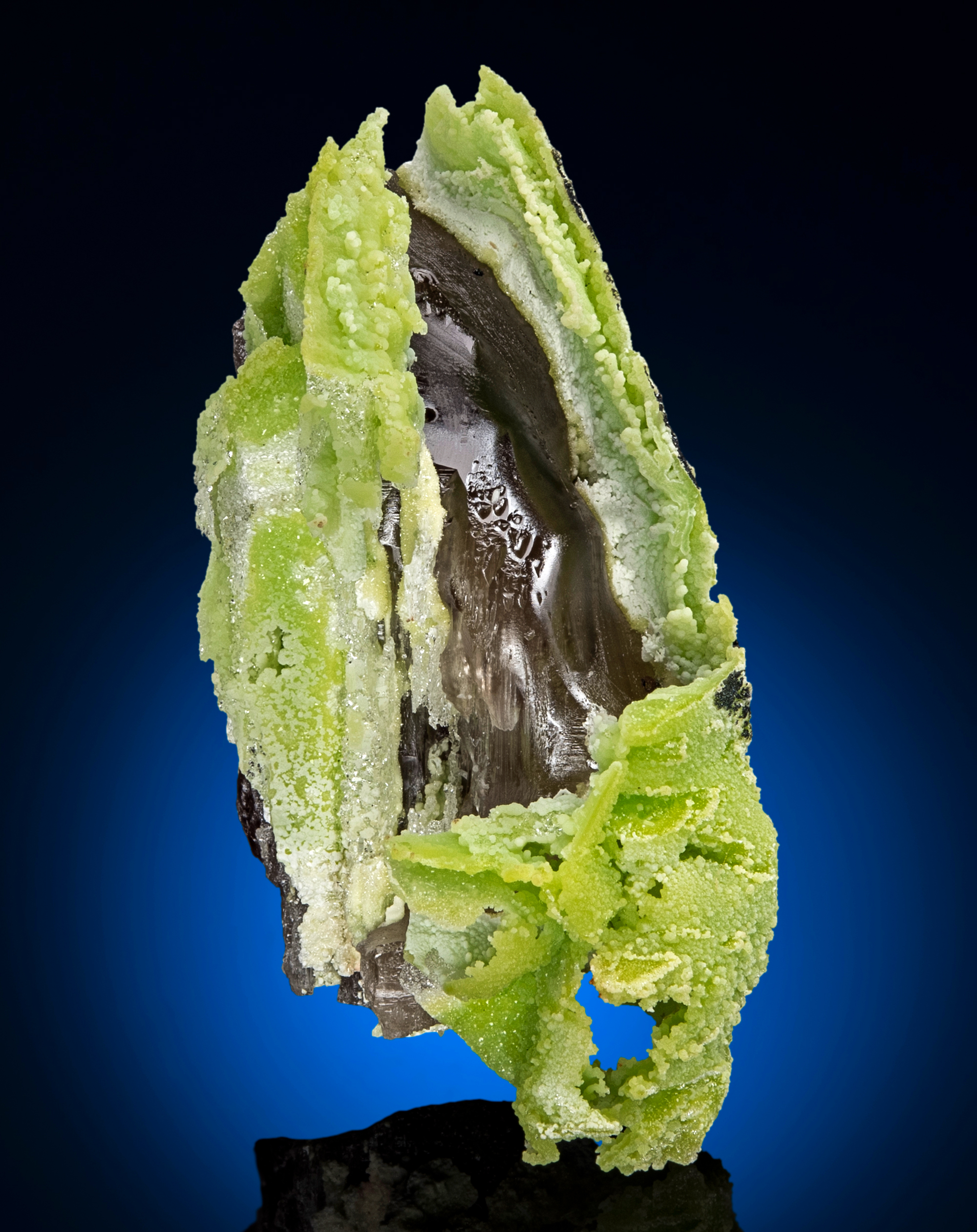
Another unusual specimen from M'fouati – pyromorphite perimorphose on partly etched rounded cerussite. 4.7 cm tall. Spirifer specimen. M. Mauthner photo.
PALABANDA DEPOSIT
The Palabanda and Yanga Koubenza deposits occur in the upper part of the Schisto-Calcaire Group, in so called SCII (previously SC4) Subgroup, built mostly by the shallow marine dolomites, locally silicified, dated for +/- 575 Mya. Dolomites locally display an intense karstification with collapse breccias, built by residuals from decalcification of the carbonates (mostly clays). Mineralization is clearly controlled by local structures and connected with sub-vertical faults. The main ore is so called “calamine” – a mixture of the smithsonite and hemimorphite replacing carbonates and filling voids and fractures. The mineralized horizon in the area is very irregular and roughly 90 m thick.
In Palabanda quarry the most interesting zones, from the collectors’ point of view, are located in the NW corner. There, in a very close vicinity of literally a few meters, two mineralized zones are present, with very distinctive mineral assemblages. Both occur in the kartstic origin breccias, with numerous voids present between the clasts (mostly weathered dolomite, calamine and clays).
On the northern side of the zone malachite-cerussite mineralization is present. Velvet crusts up to 1-2 cm are completely coating braccia clasts. In some areas numerous white twinned cerussite “snowflakes” sit on malachite. Specimens coming from this zone have great contrast and colors, but usually are very fragile. They remain very similar to the material collected in Boko-Songho area and many of them are impossible to distinguish.
A few meters to the east a hemimorphite zone is present. This zone is much bigger and more mineralogically diverse. The size of the open pockets in that zone is much larger than the malachite ones – up to over 50 cm. In general, as in the malachite-cerussite zone where malachite coats breccia clasts and voids in dolomite, in this zone hemimorphite occurs similarly. It forms layered crusts with thickness from 1 to 5 mm. Colors of the “bands” vary from white, through blue-greenish to a strong sky-blue color. In some places additional inclusions of the zincolibethenite add some green shades to the druse. In most of this zone other mineral species are almost absent.
The area where veszelyite occurs was located within the hemimorphite zone and was relatively small. It was dispersed irregularly, in some places forming even 2 cm thick crusts, and in others occurring as crystals sprinkled on hemimorphite. This rare phosphate usually grows on the hemimorphite, or more rarely, directly on the breccia fragments. Kipushite, another rare phosphate, occurs on all species mentioned above, and is one of the youngest minerals in the paragenesis.
Another mineral that is found in the paragenesis is smithsonite. Although its temporal relationship with other species is not fully clear, it was noted as growing on hemimorphite but also on veszelyite. Aurichalcite, although not present exactly in the veszelyite occurrence, is probably, together with smithsonite, one of the youngest in the paragenesis.
Palabanda – Yanga Koubenza deposits were most extensively explored in 1950-60's. Large scale mining started in the area in the late 2010's, by a company named SOREMI. Since 2016, within a 2 year period, an ore plant, flotation pond, and quarries had been constructed. In the first years of operation the majority of the ore processed there came from the Boko-Songho deposit. It was permanently closed in 2019. Quarries in Palabanda were exploited mostly in 2017-2018 and then abandoned. Future plans for returning with industrial exploitation to this place remain uncertain.
Soon after the quarry was abandoned by SOREMI local small-scale miners looking for ore started their exploration. Their first interest was malachite. While digging this mineral as copper ore they encountered voids with cerussite crystals. These were the first specimens collected in Palabanda as early as mid-2018. Soon after that the security guards were brought back to the quarry and digging became impossible. The quarry became accessible again in the late 2019, and then the first specimens of blue hemimorphite were collected. Around November 2019 the first specimens of the blue unknown crystals occurring on hemimorphite were discovered. As our crew was not present on the spot, we based our guesses of what the mineral was on poor quality miners’ photos and several species were thought to be possible. The Spirifer mining crew started more extend diggings in the early January (after the New Year feast that usually lasts two weeks in Africa). For the next 5 months the zone was explored and many specimens were recovered. The mining conditions were very difficult as using only very simple tools were available. After the first 3 months the zone looked like it had been completely exhausted but we continued to mine for almost 2 more months. In this time almost nothing more was found. The result of the whole operation was about 1500 kg of specimens – from small pieces to big rock lumps needing serious trimming – probably the biggest (in terms of volume) veszelyite find in the history.
Digging for malachite ore continues in Palabanda and some malachite-cerussite specimens had been found recently (Oct 2020) but so far there are no further signs of veszelyite.
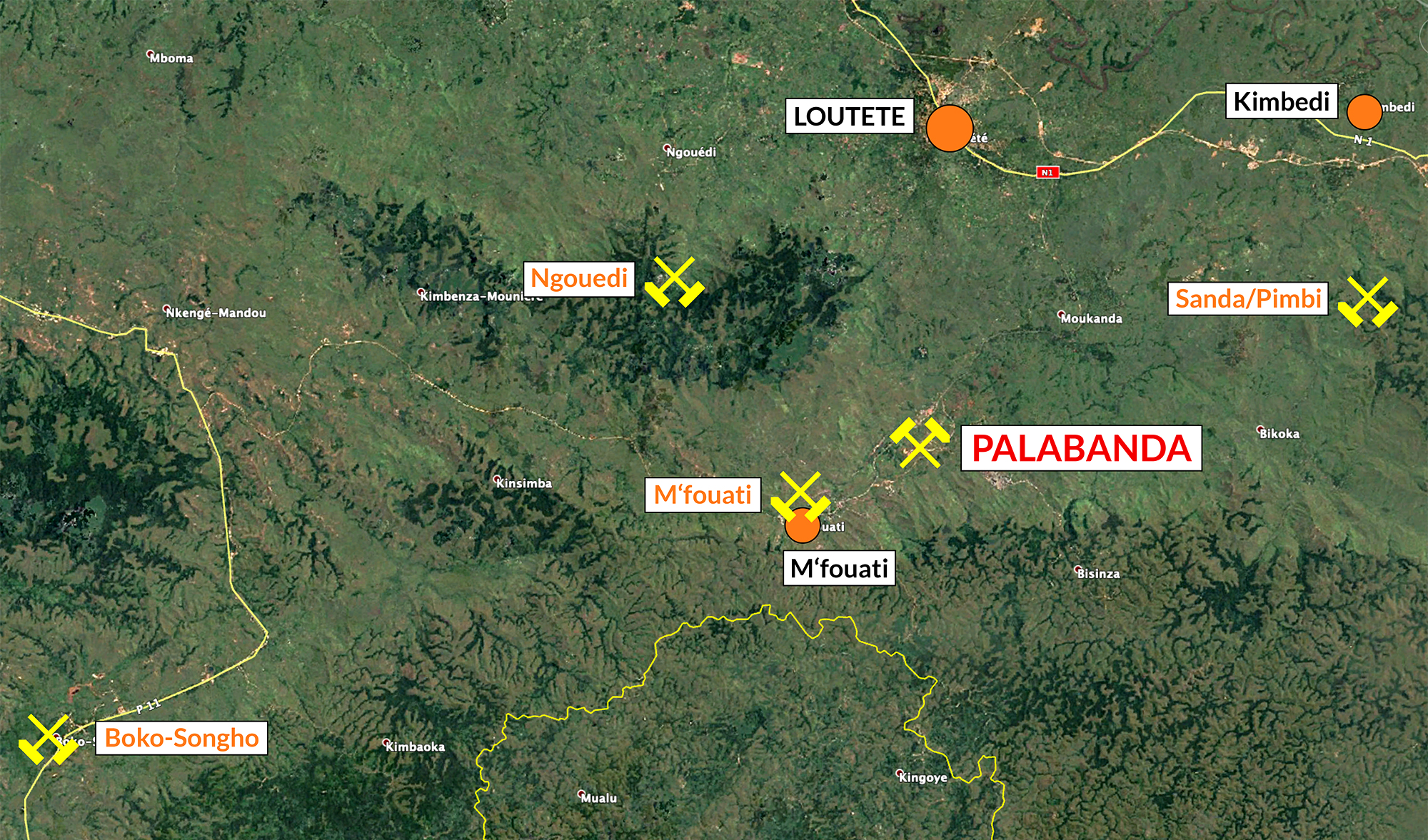
Palabanda quarries are located not far from M'fouati. Although they were intensively explored in the 1940's and 1960's, real mining started as recently as 2016.
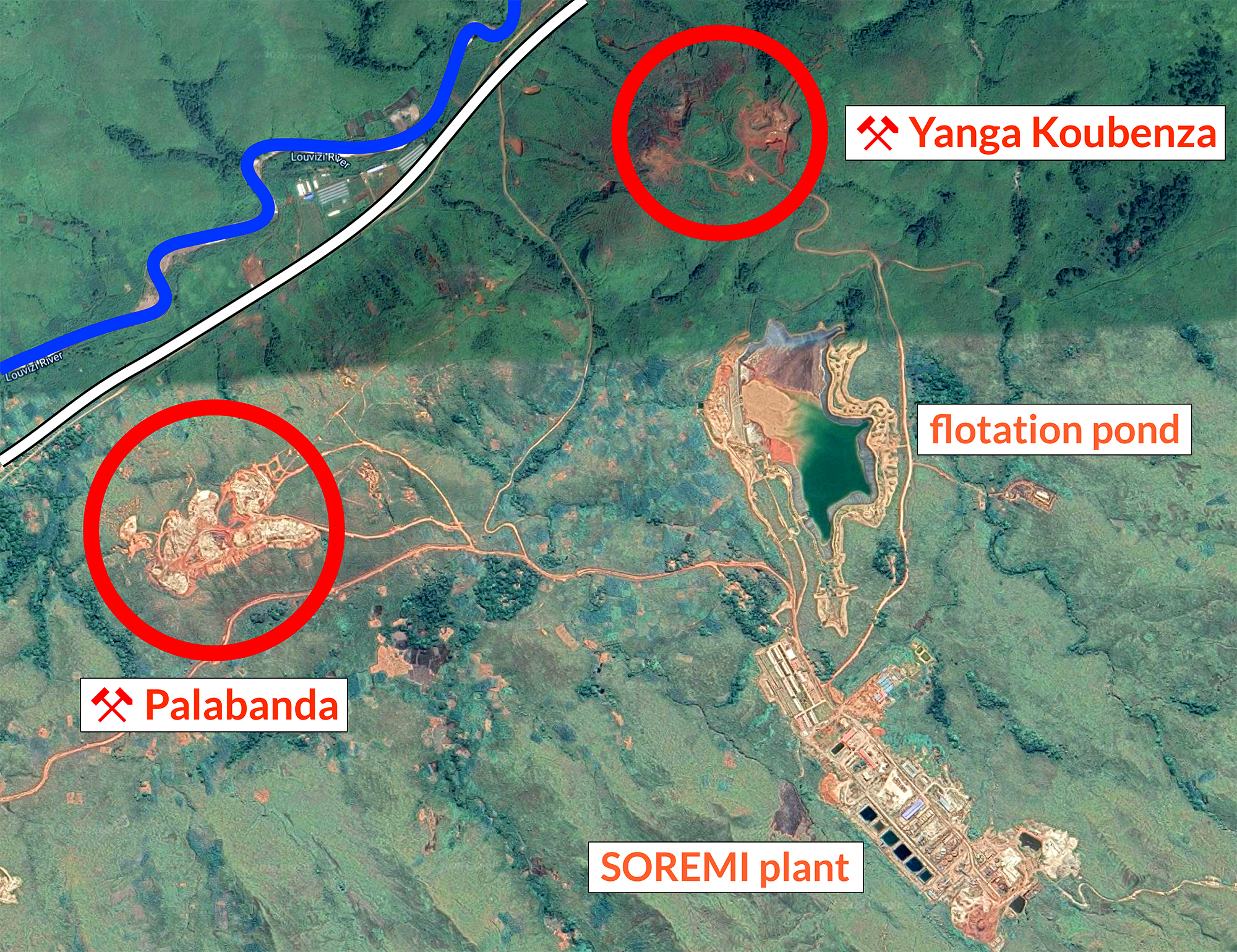
Satellite view to Palabanda, Yanga Koubenza quarries, SOREMI ore plant and flotation pond.
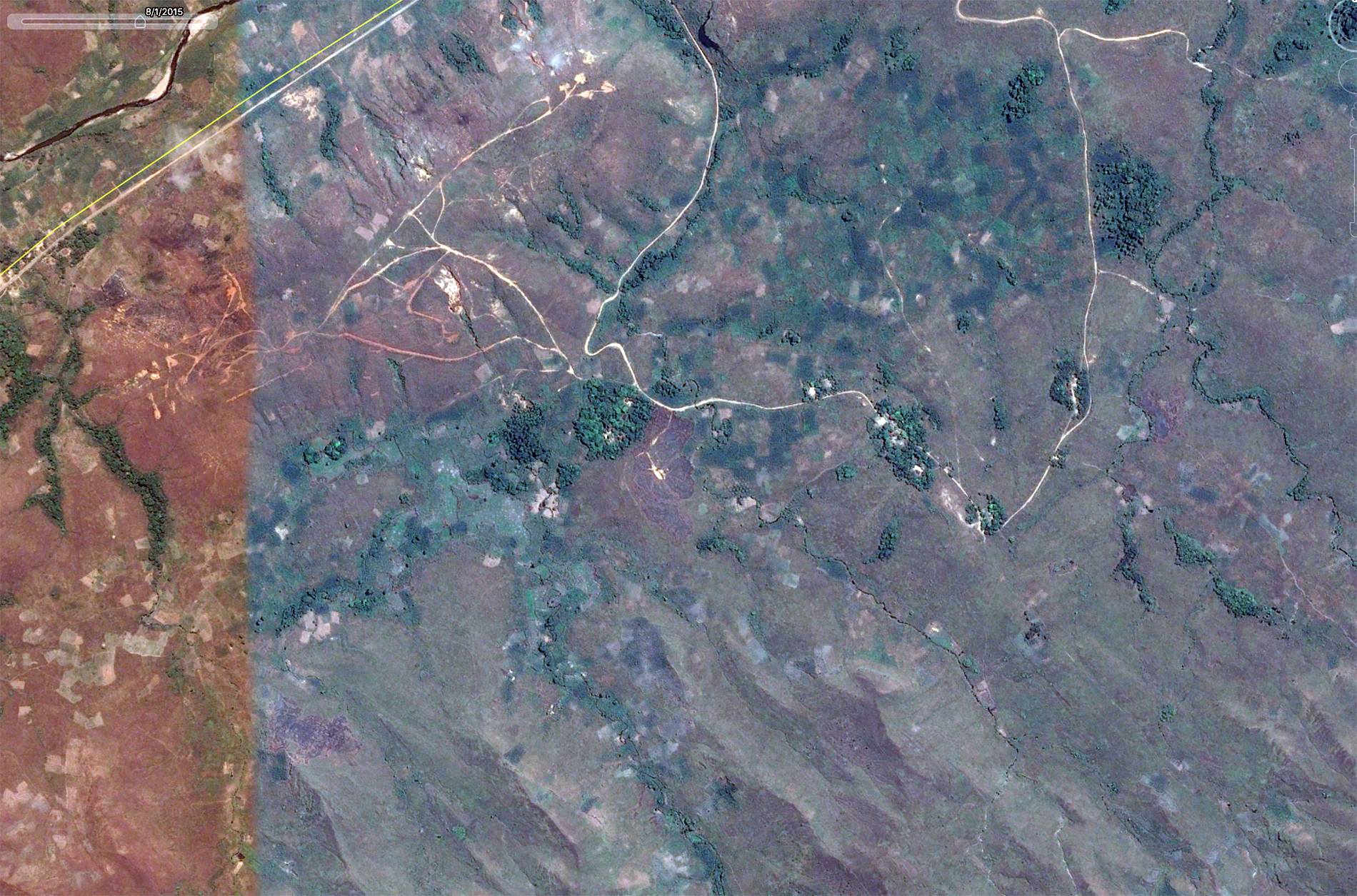
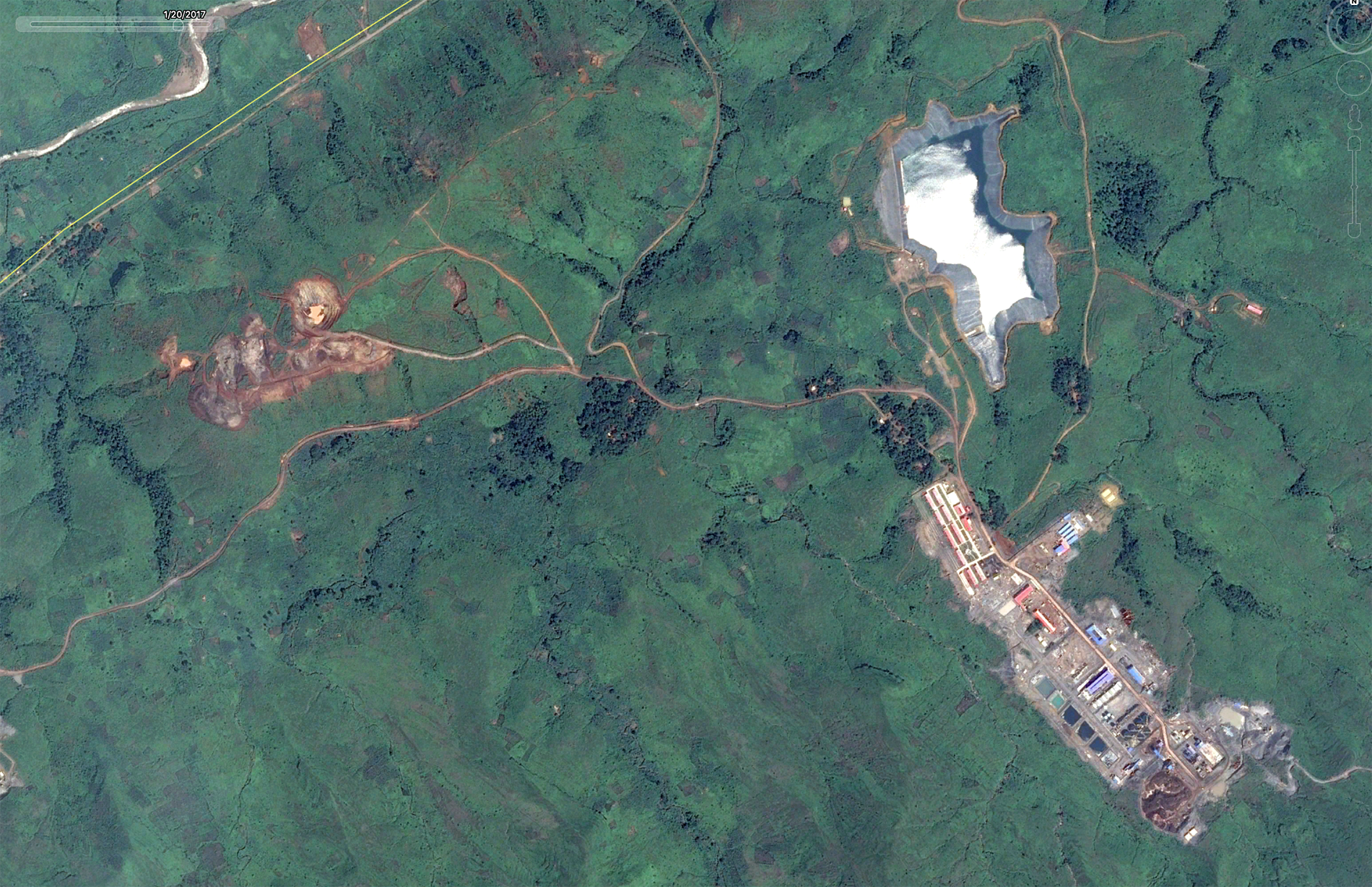
Satellite view to Palabanda area in 2015 (upper photo) and the same area in 2017! In only 2 years ore plant, flotation pond and quarries had been constructed.
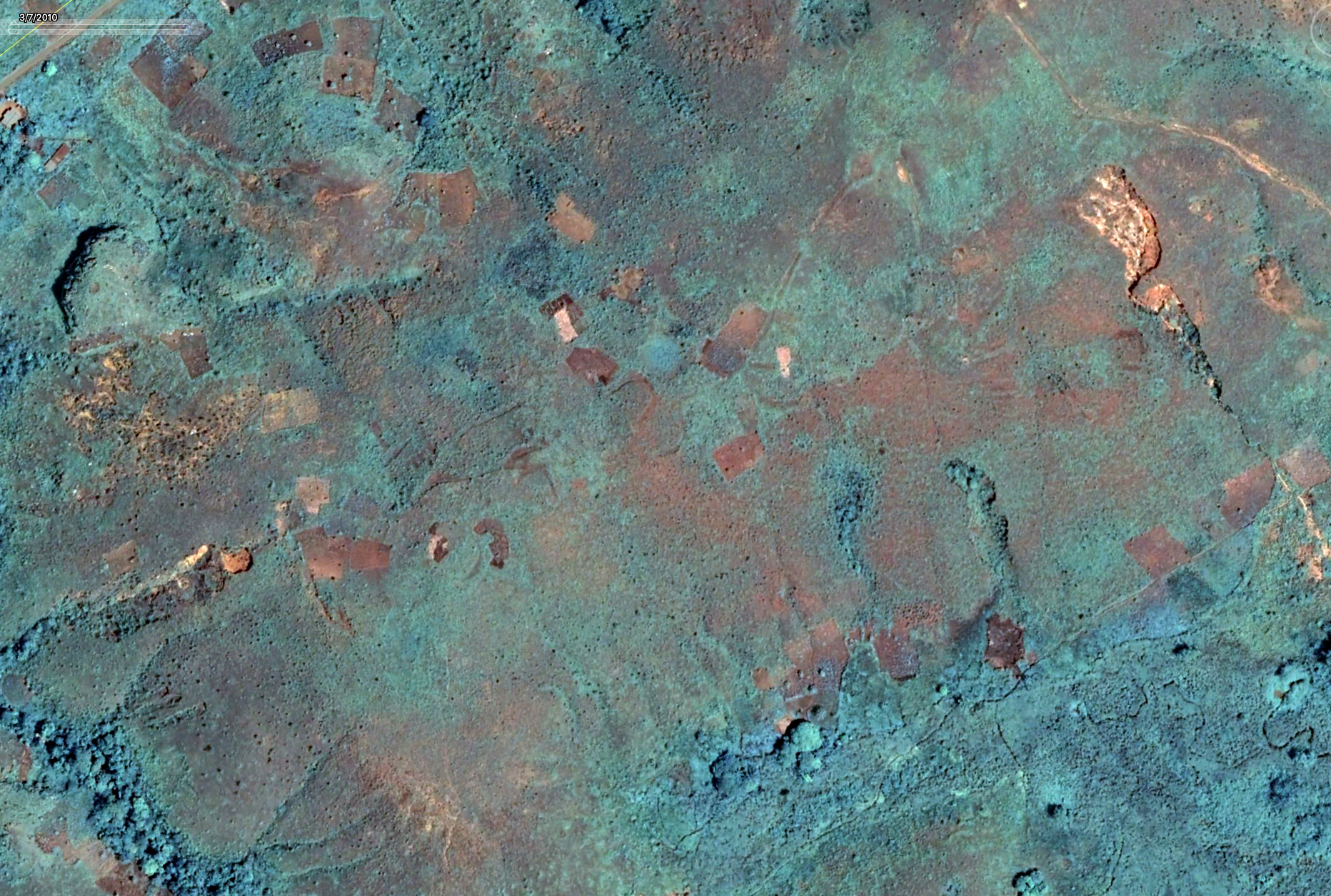
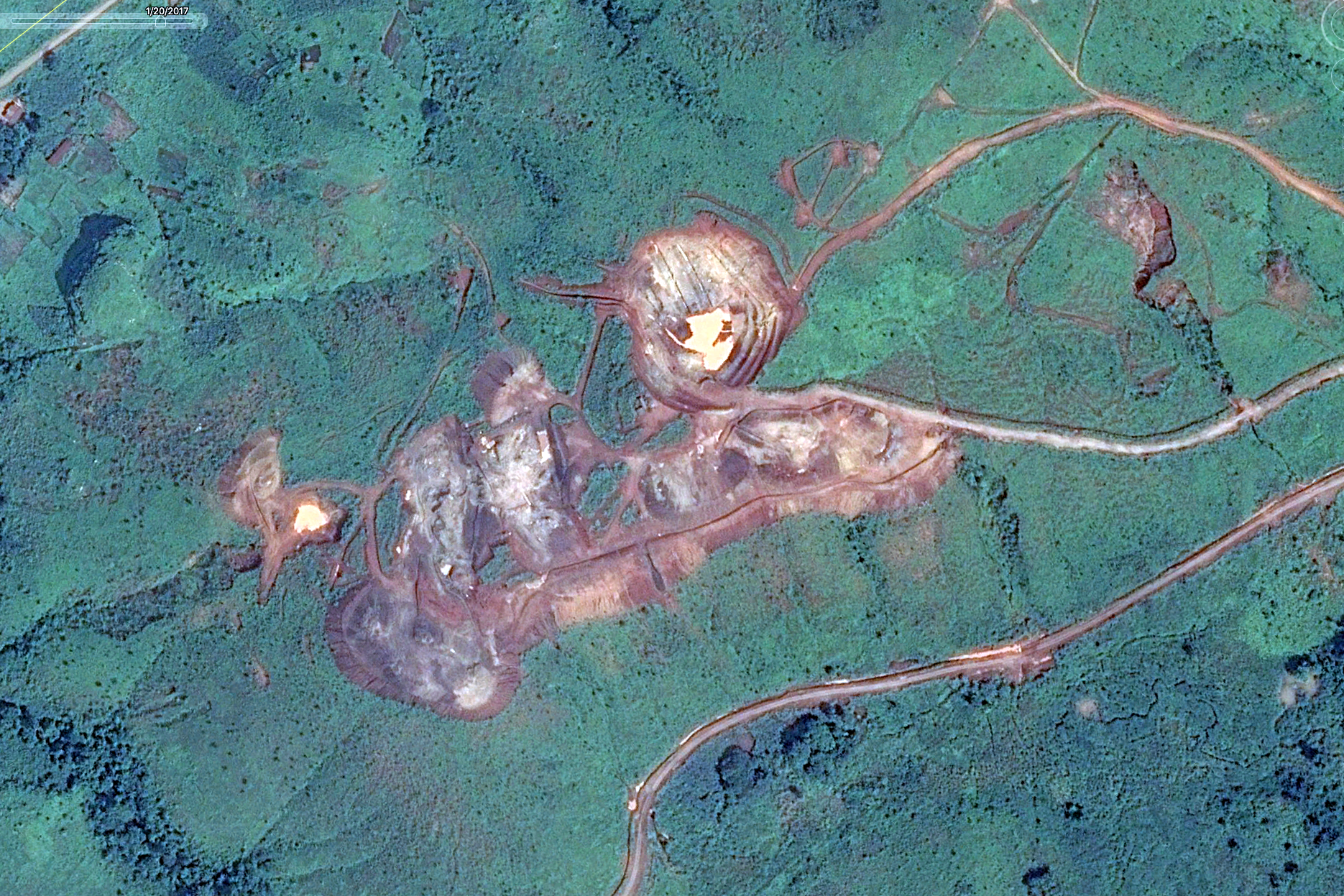
More close-up view to the Palabanda deposit in 2015 (upper photo) and same area in 2017!
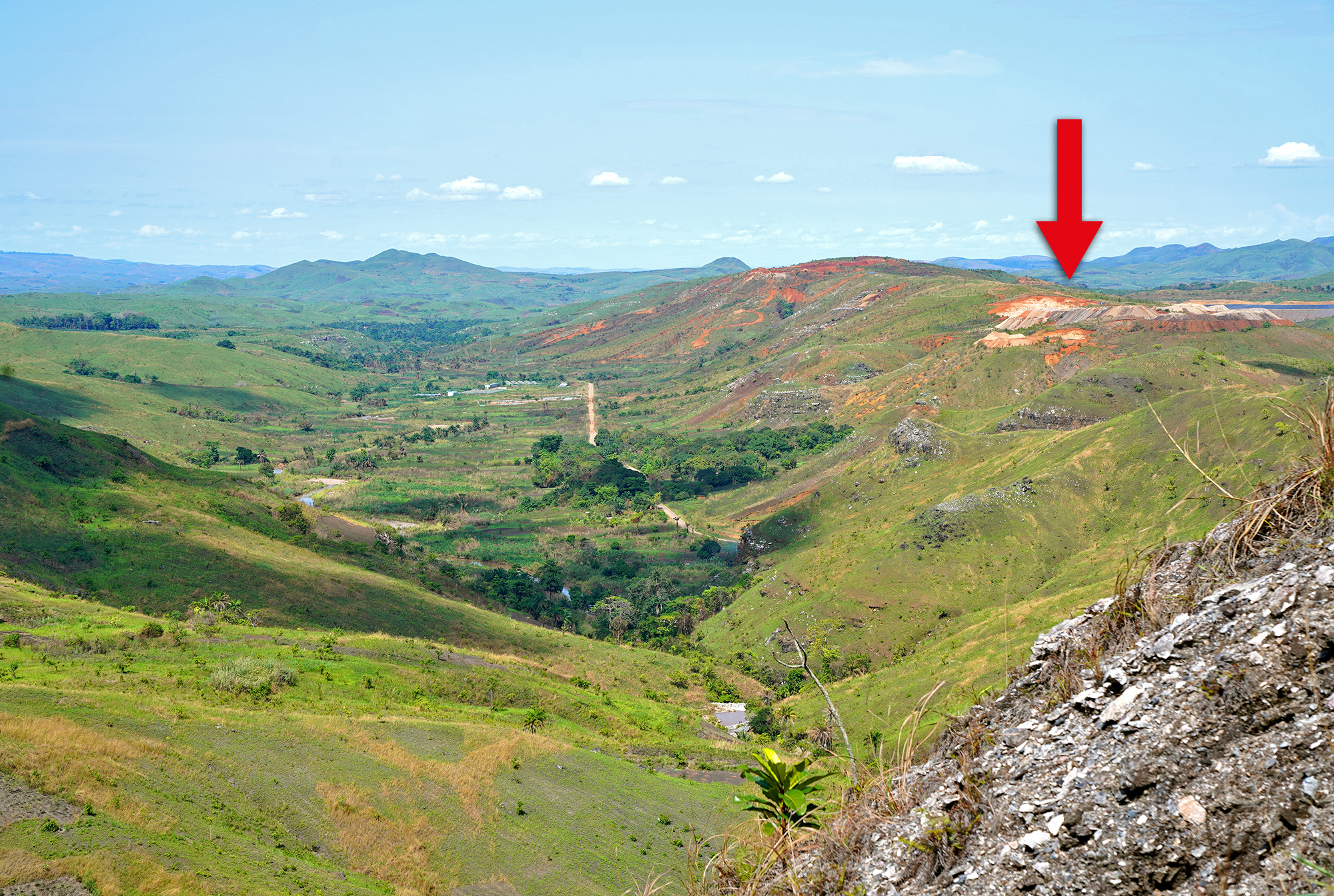
View to the NE from M'fouati hill - Palabanda quarries are marked.
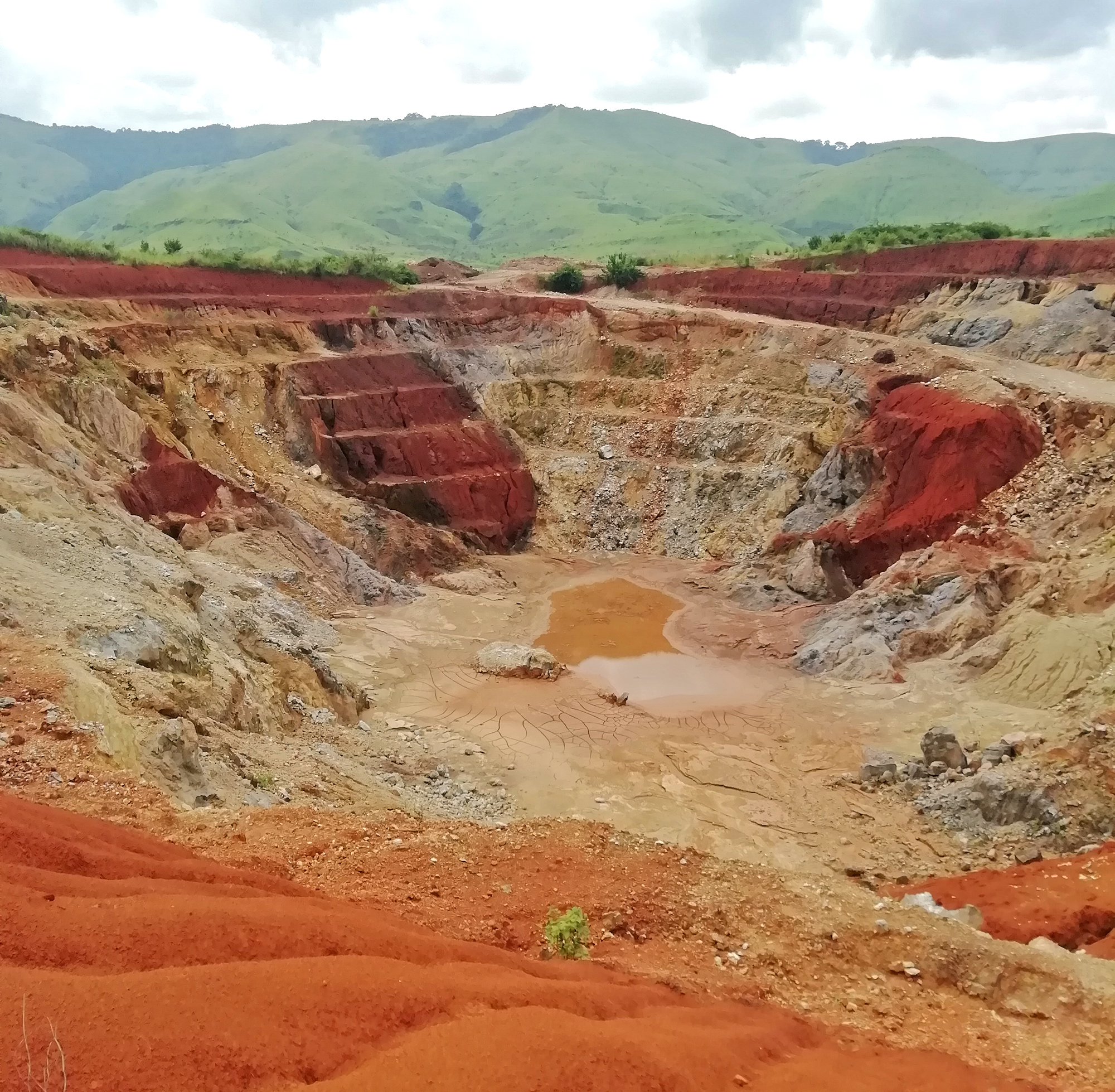
Palabanda quarry was mined mostly in 2016-2018, recently it's been abandoned.
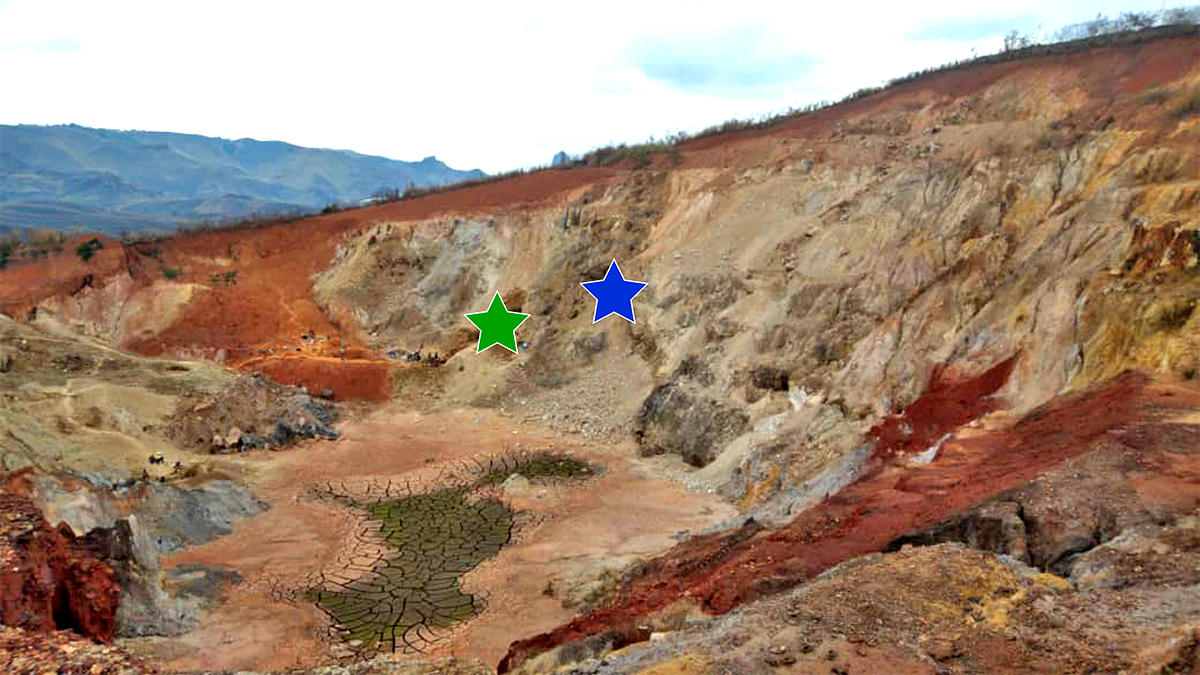
Palabanda quarry with marked two mineralized zones described in this article – blue star shows hemimorphite-veszelyite zone, and the green star – malachite-cerussite zone.
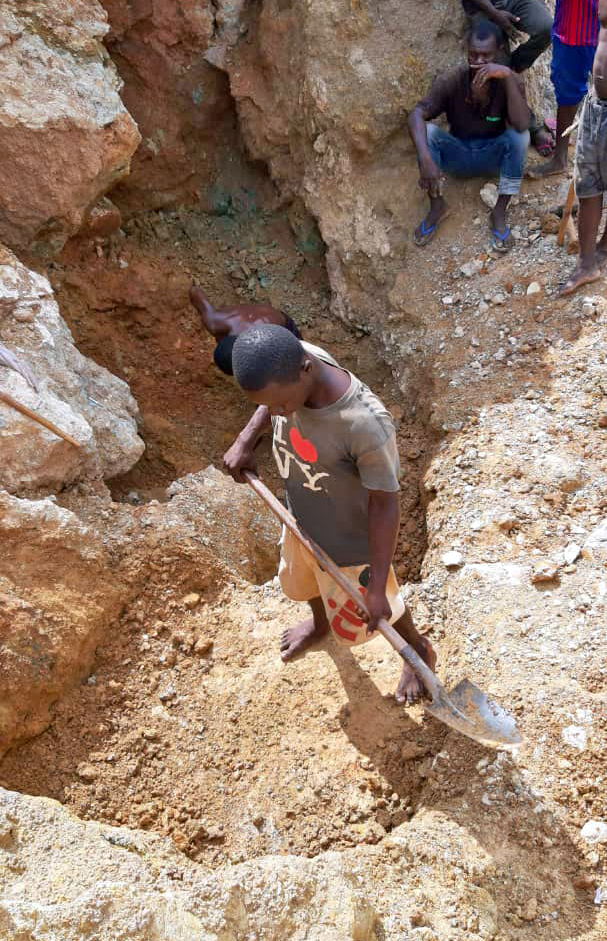
Diggings in the malachite-cerussite zone.
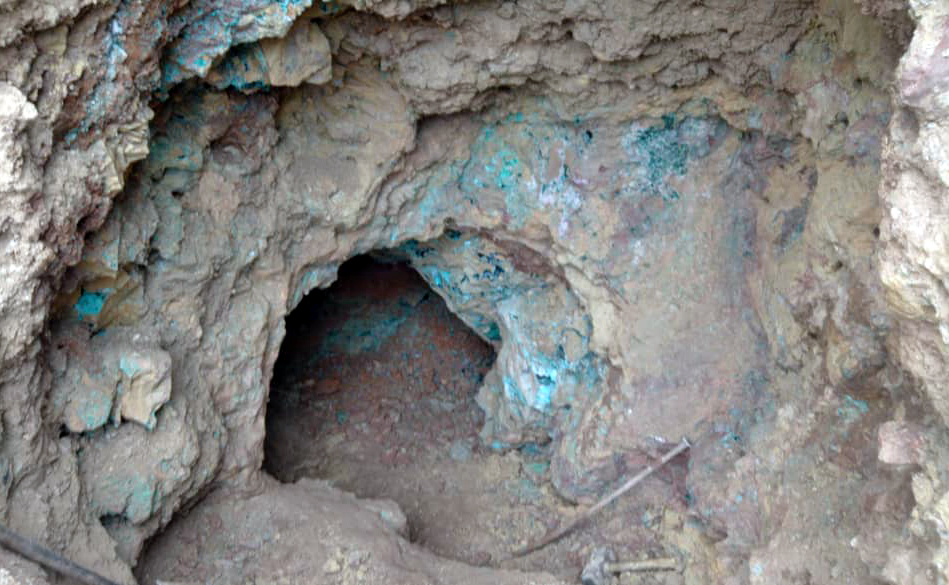
Workings with visible malachite pockets, some of them contain also reticulated cerussite.
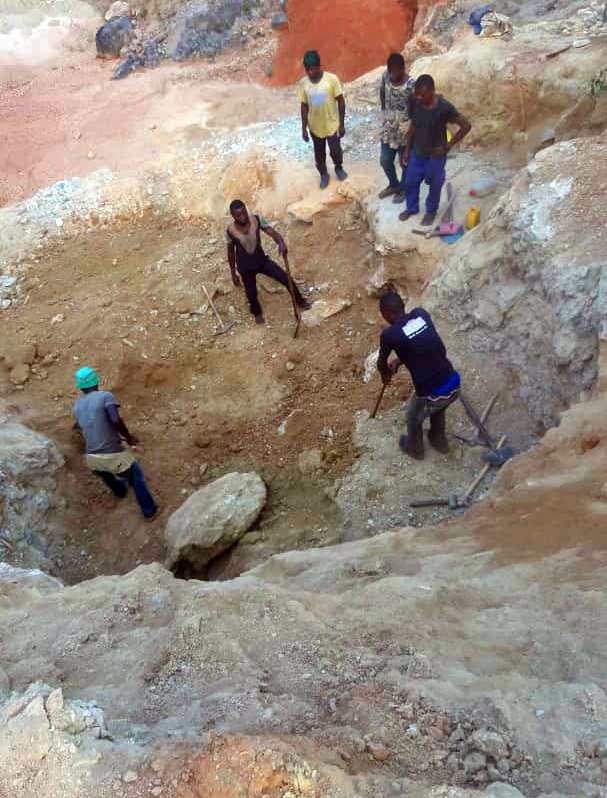
Digging in the hemimorphite zone.
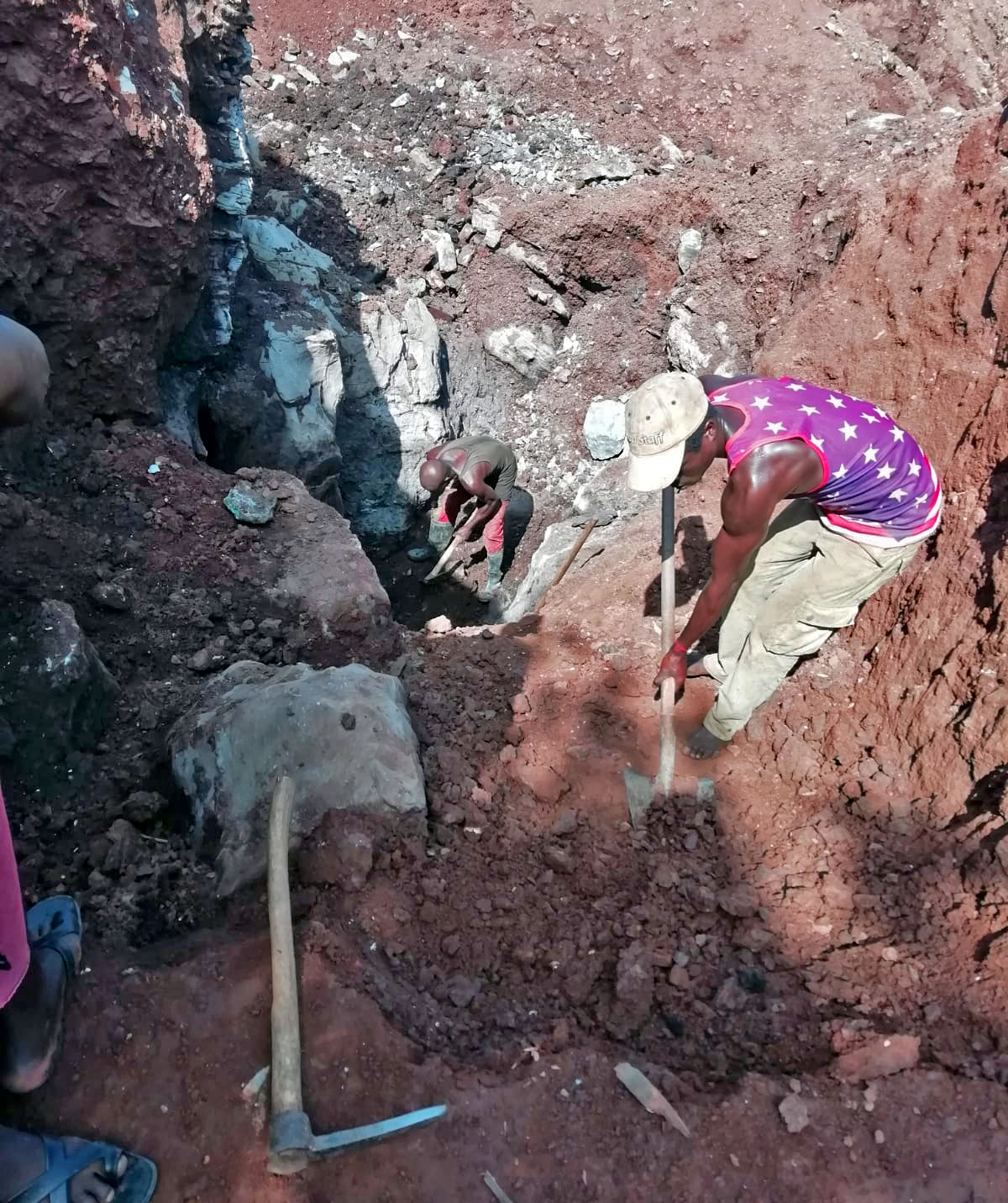
Digging in the hemimorphite zone.
.jpeg)
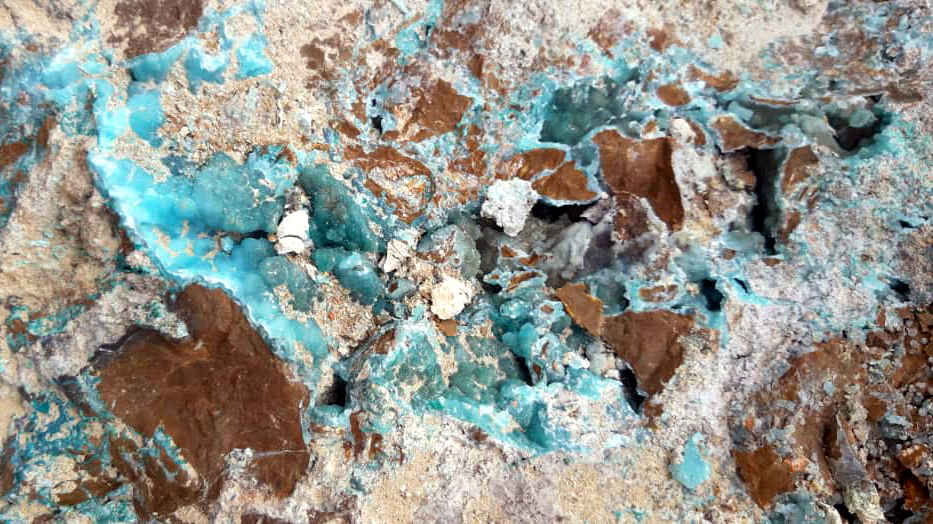
Brecciated dolomites with cavities coated by blue hemimorphite.
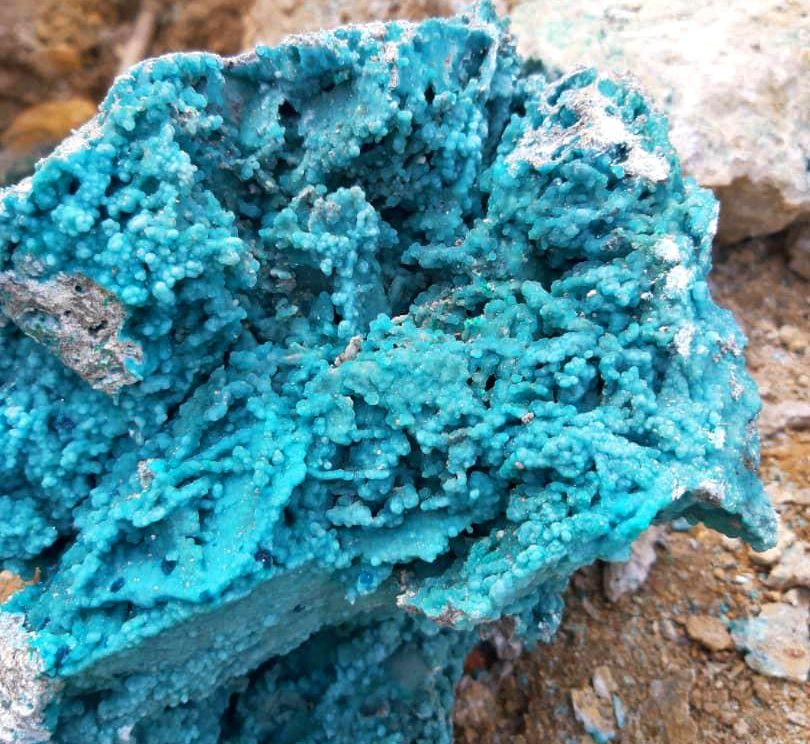
Just extracted specimen of the grape-shape aggregates of the deep blue hemimorphite, Palabanda.
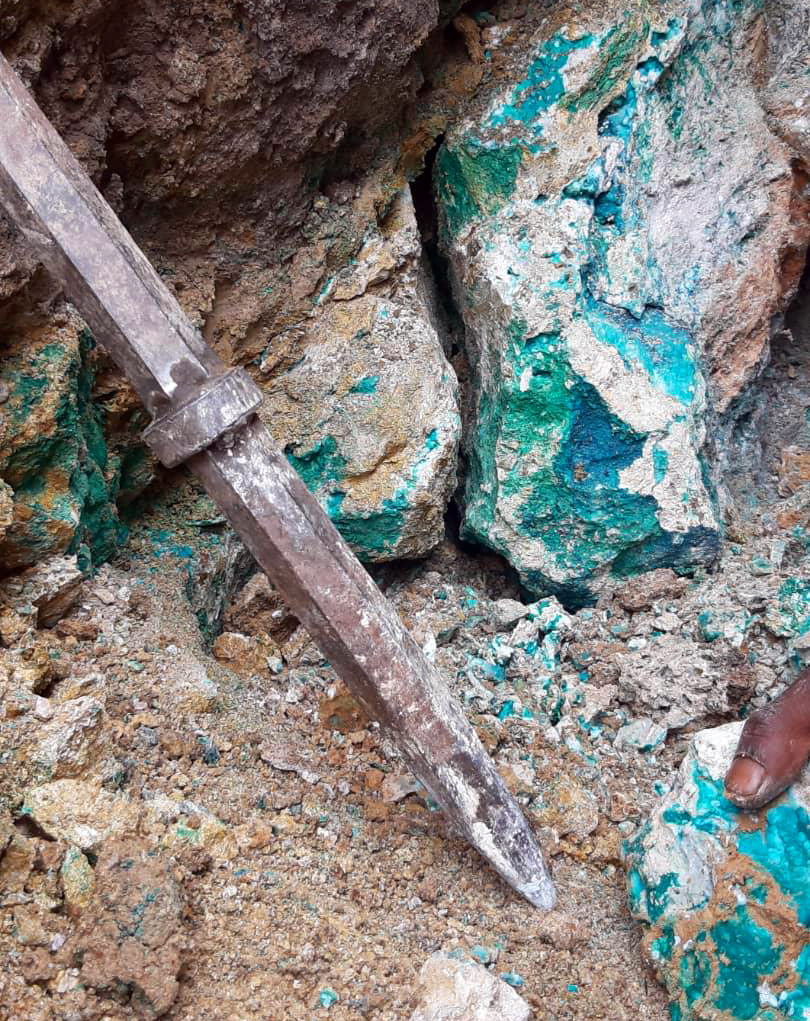
Brecciated dolomites in situ with cracks coated by blue veszelyite and green zincolibethenite.
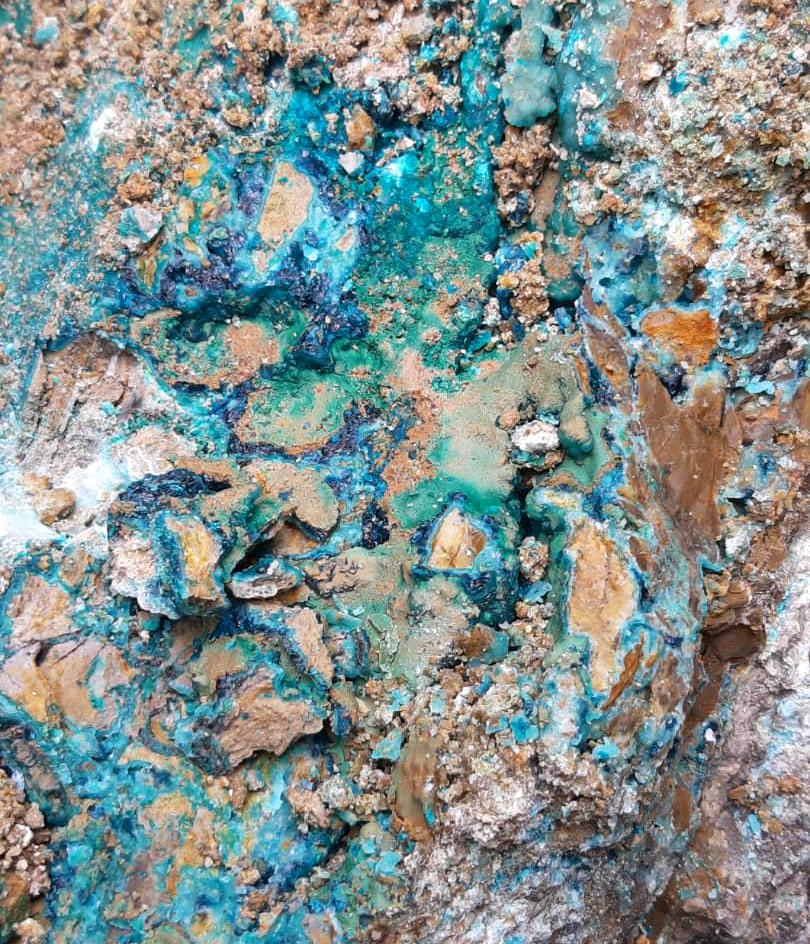
Brecciated dolomites in situ with vugs coated by dark blue veszelyite, green zincolibethenite and light blue hemimorphite.
Brecciated dolomite with vugs coated by hemimorphite and veszelyite.
MINERALS from PALABANDA
The mineral assemblage in Palabanda is diverse and for sure more species will be discovered from there in the future. All of the species are secondary minerals of the Zn and Cu, formed as supergene mineralization.
Veszelyite paragenesis from Palabdnda is typical for the species, and other associated phosphates, as well as hemimorphite, resembling the Black Pine mine in USA, or even more Laochang in China.
AURICHALCITE (Zn,Cu)5(CO3)2(OH)6
Aurichalcite is present in the western part of the hemimorphite zone just outside of it. In the hemimorphite zone it is formed as typical radial aggregates of the blue acicular crystals, growing on the hemimorphite. In the area located just east from the zone it forms thick crusts built by elongated bladed crystals, frequently overgrown by smithsonite.
Acicular aggregates of aurichalcite partly overgrown by smithsonite. Specimen 7 cm wide.
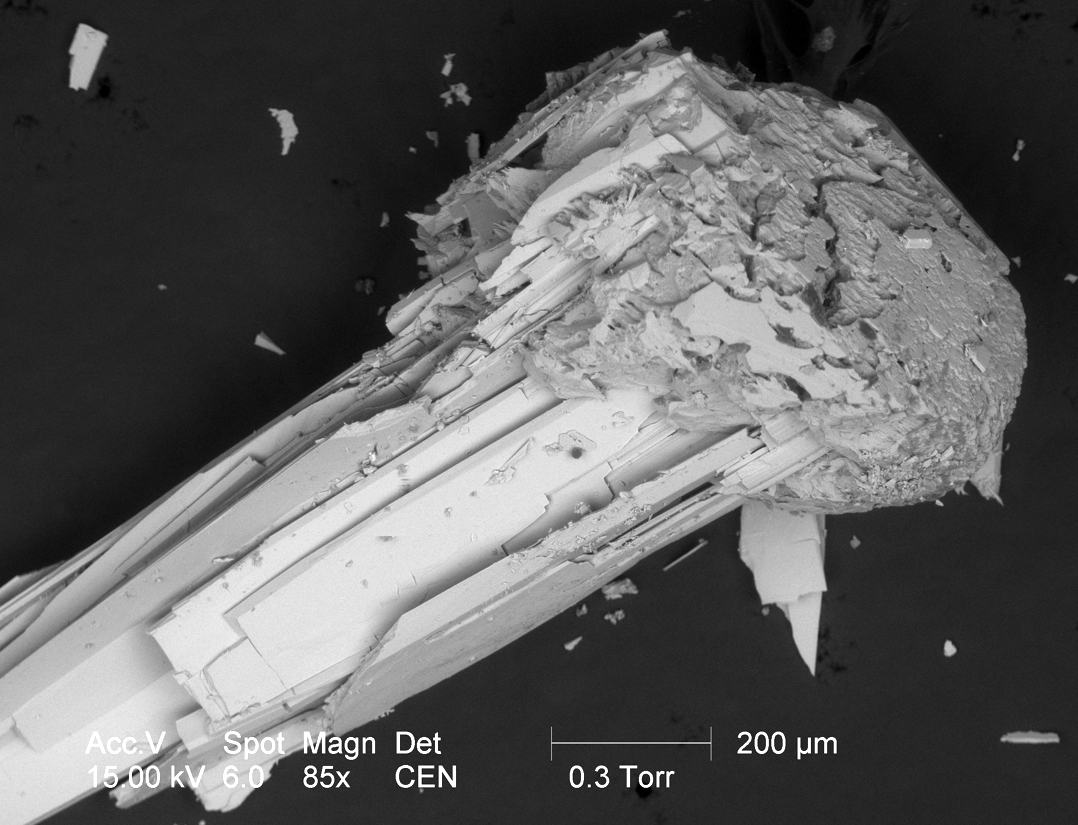
Scanning electron microscope image of aurichalcite overgrown by smithosnite.
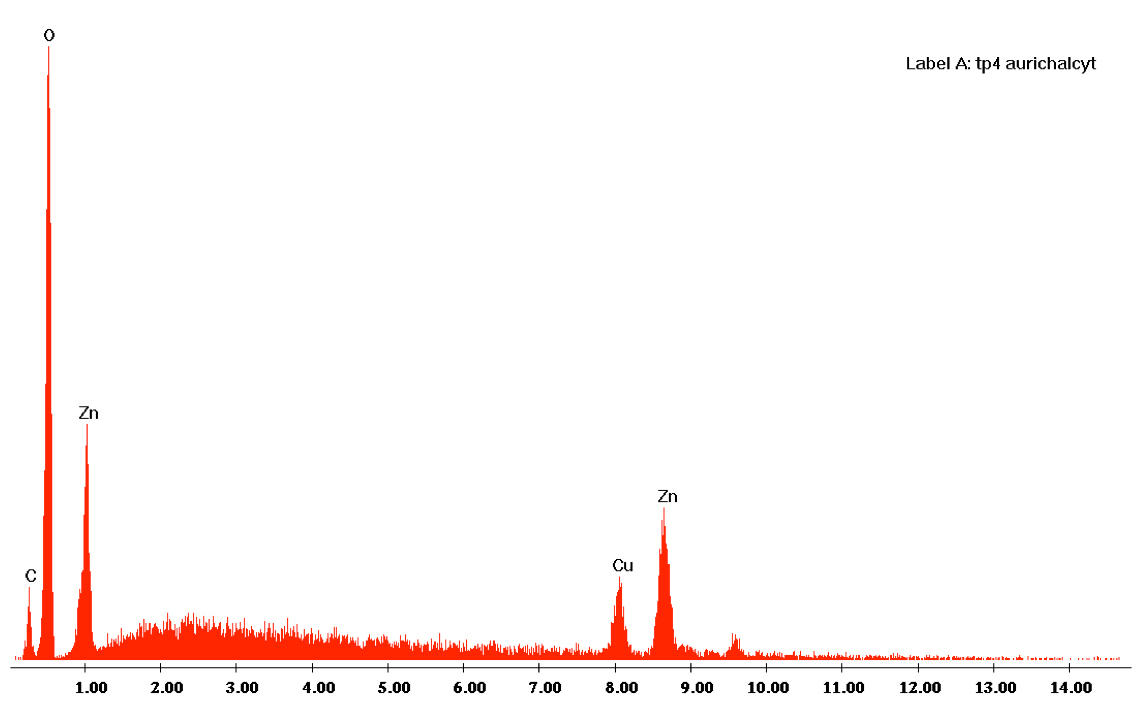
EDS spectra confirming the presence of aurichalcite from Palabanda.
CERUSSITE PbCO3
As far cerussite in Palabanda was observed in the malachite-cerussite zone, where it grows on the malachite. Cerussite is always formed as white to translucent flattened reticulated cyclic twins called commonly “snowflakes”. Usually their size is between 5-20 mm. Cerussite was not observed in the hemimorphite zone.
Freshly collected specimen of reticulated cerussite twins on malachite, Palabanda.
Freshly collected (in 2018) specimen of cerussite "snowflake" twins on velvety malachite. Specimen 14 cm.
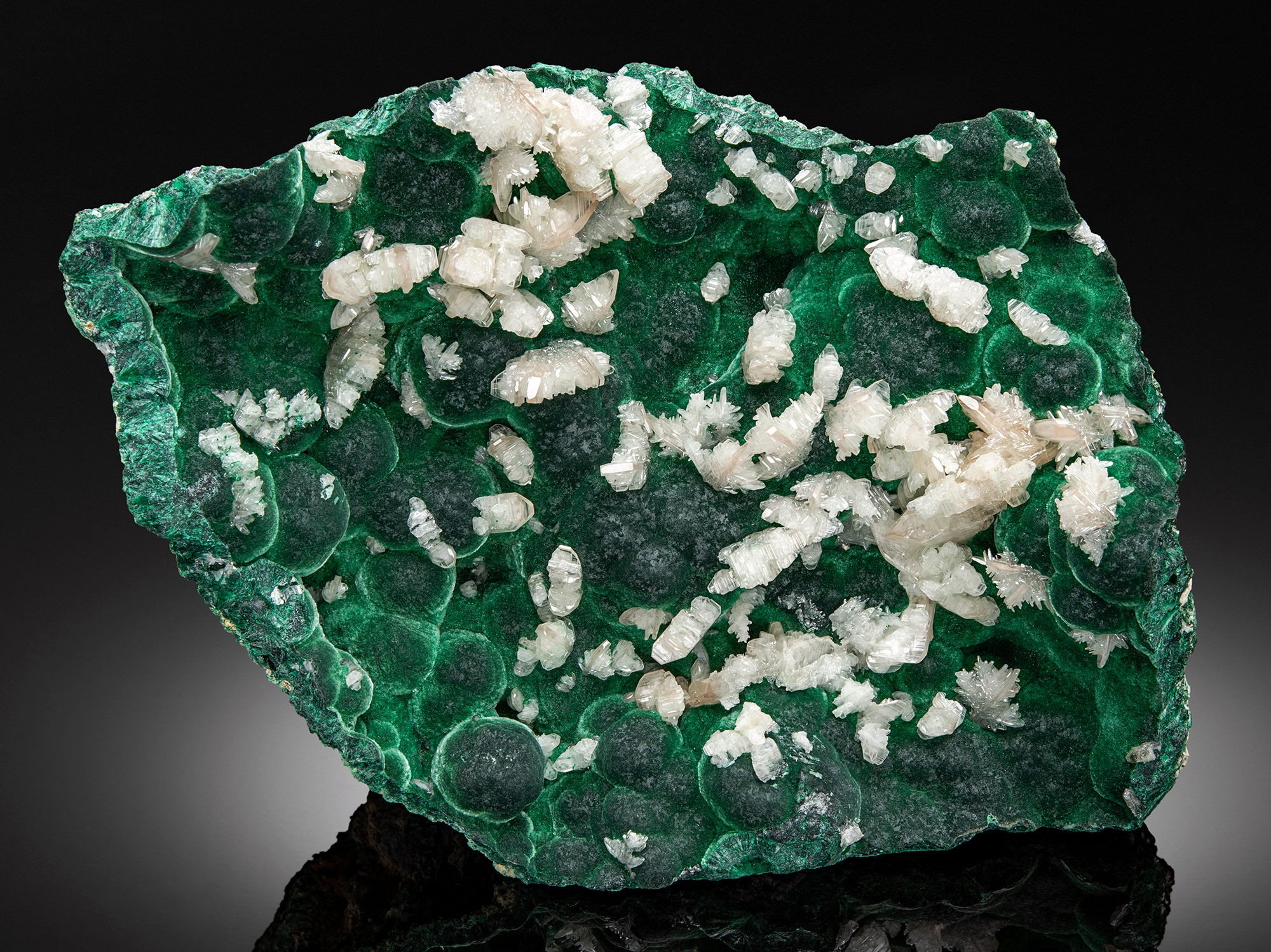
The same specimen as above after cleaning and trimming – reticulated cerussite "snowflake" twins on velvety malachite. Specimen 14 cm. M. Mauthner photo.
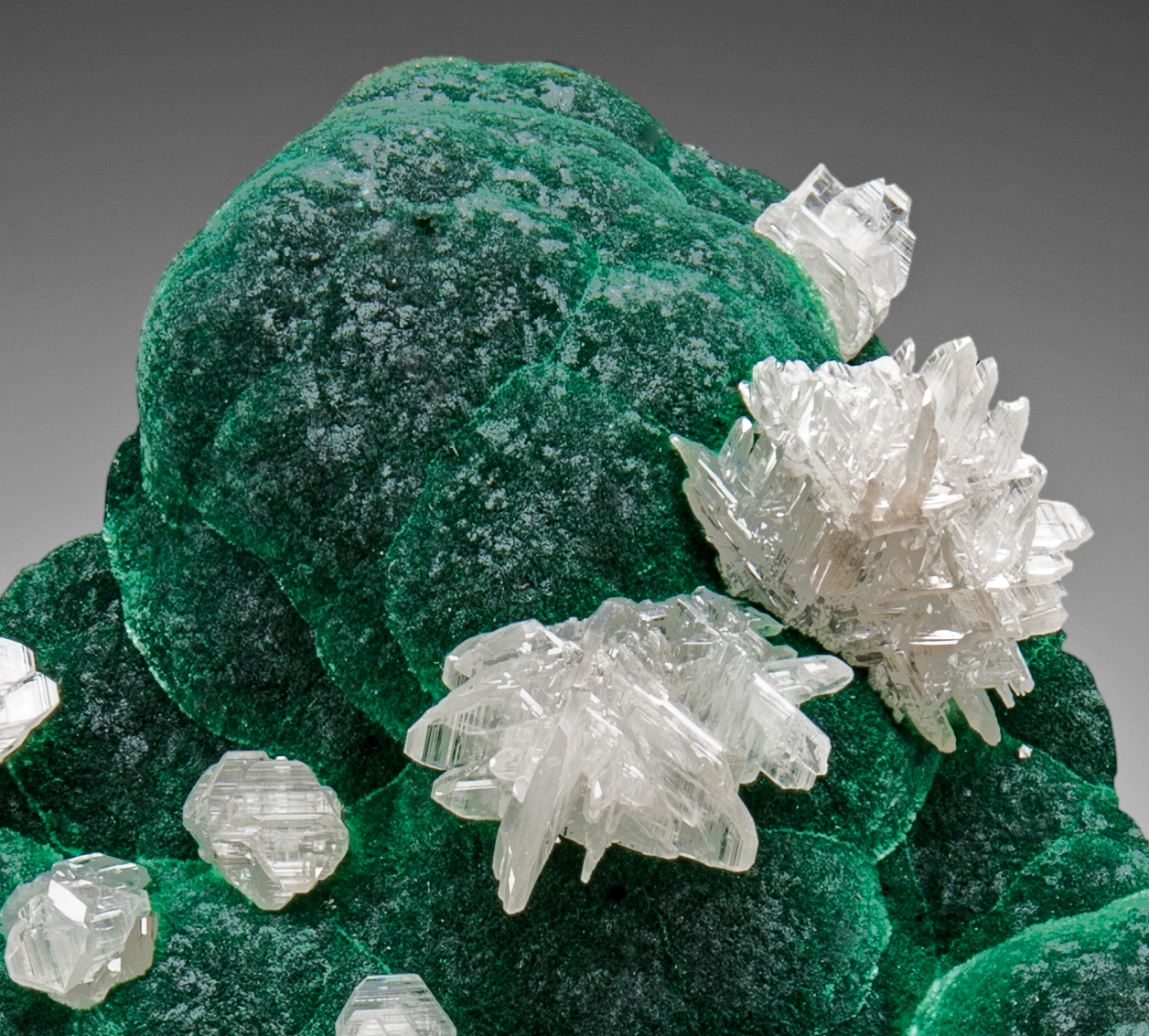
Reticulated cerussite "snowflake" twins on velvety malachite. Twins up to 1 cm. M. Mauthner photo.
HEMIMORPHITE Zn4Si2O7(OH)2 · H2O
Hemimorphite is one of the dominant minerals in the hemimorphite zone, and is the most common association with veszelyite. It is found in layered crusts made of parallel tabular crystals, with chisel shape terminations (observable on a microscopic scale). The thickness of the crusts vary from 1 mm to 1 cm (in extreme cases). Hemimorphite colors also vary from colorless, white, gray to intense blue. Occasionally, a hint of green is observed due to presence secondary Zn-Cu minerals. Frequently, in the middle of the thicker crusts there is a thin deep green layer which is confirmed to be zincolibethenite.
Hemimorphite crusts coat the majority of surfaces in the voids, coating clasts and pocket walls. The surface of the hemimorphite aggregates is frequently botryoidal in habit. In bigger pockets hemimorphite surfaces are sometimes very flat.
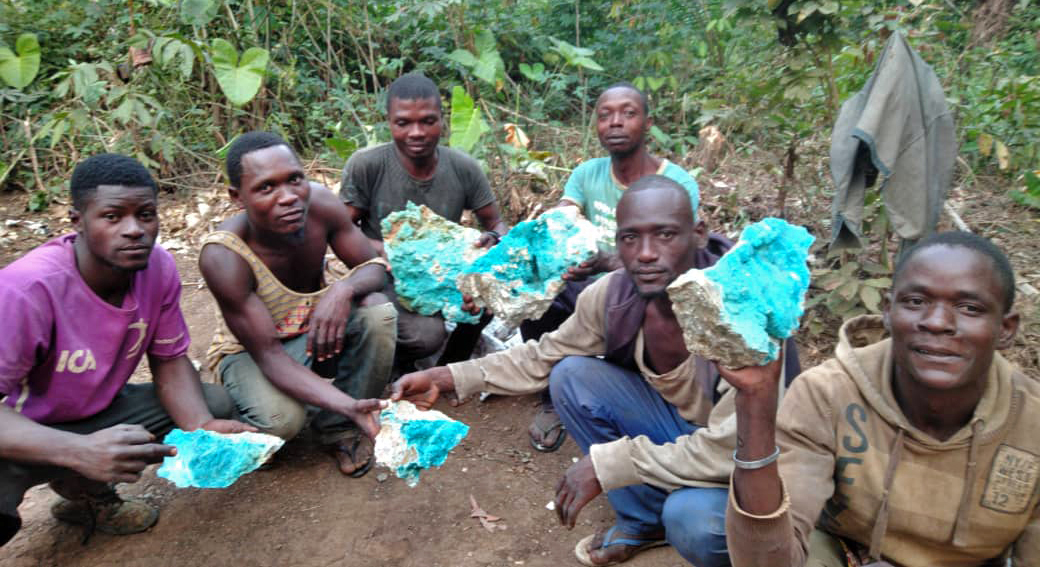
Our mining crew with freshly collected big specimens of blue hemimorphite.
Spheroidal aggregates of blue hemimorphite with small white smithsonite crystals.
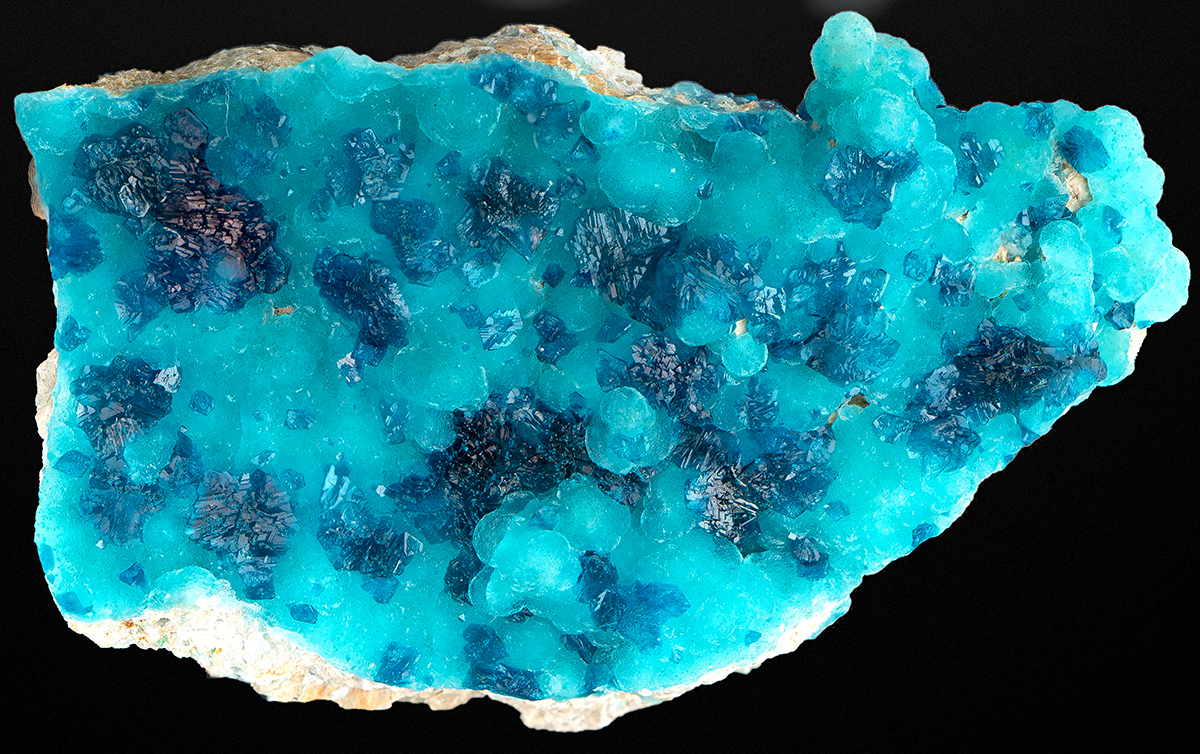
Spheroidal aggregates of blue hemimorphite with darker blue veszelyite crystals. Specimen 4.5 cm wide. J. Kl? photo.
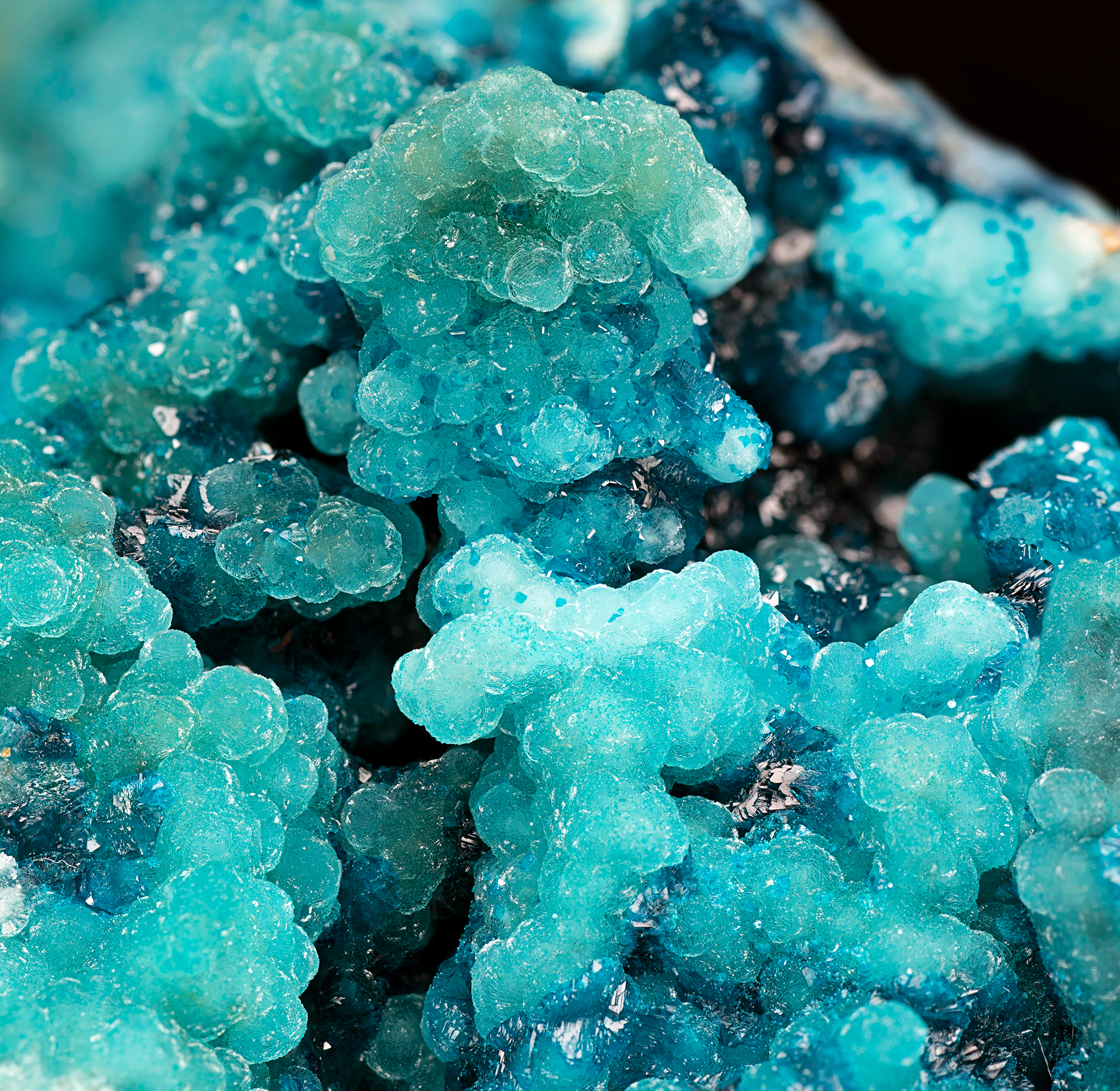
Spheroidal aggregates of blue hemimorphite with darker blue veszelyite crystals. Field of view 2 cm. M. Mauthner photo.
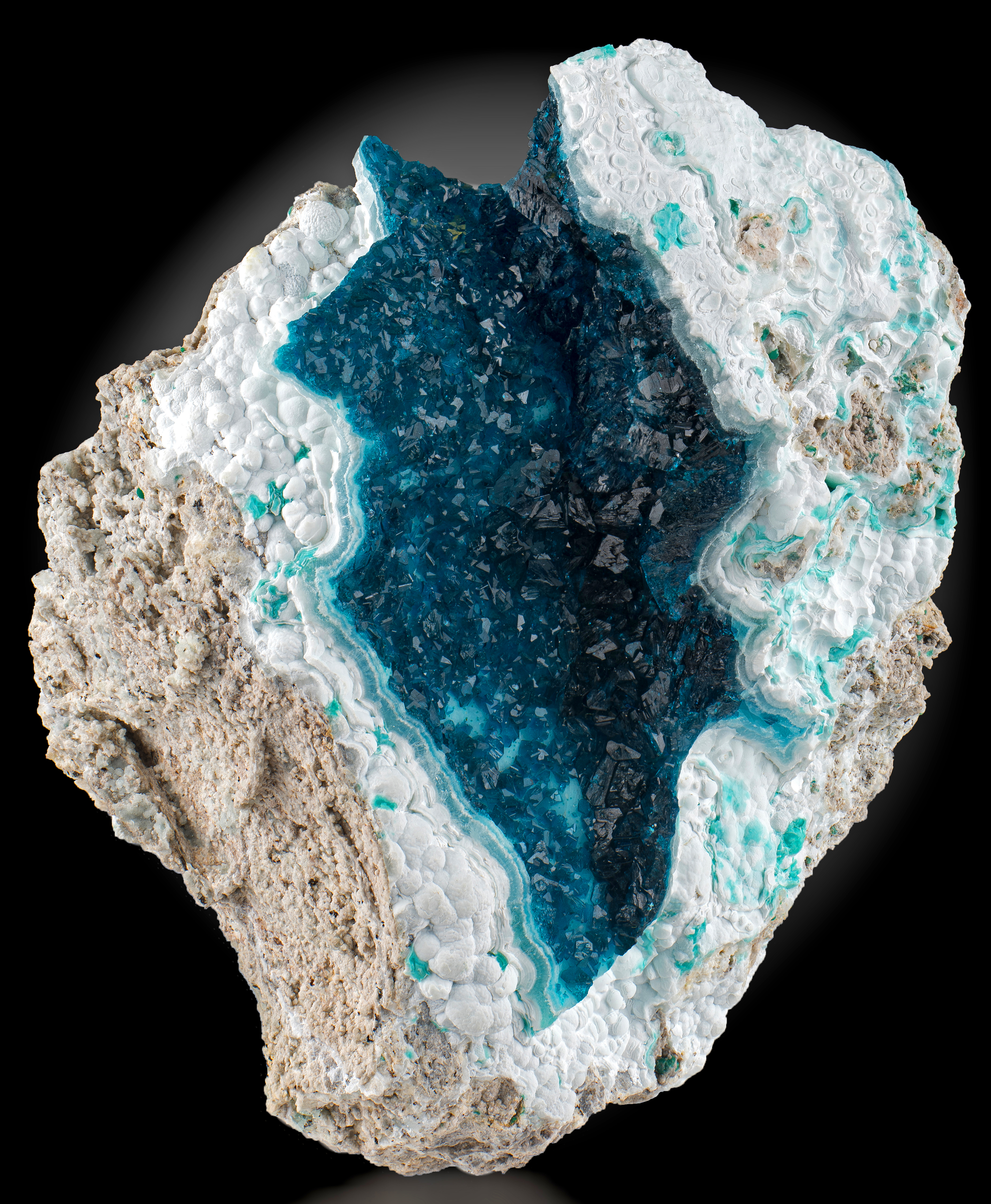
Spheroidal aggregates of white and color zoned hemimorphite with darker blue veszelyite crystals. 6.5 cm tall. J. Kl? photo.
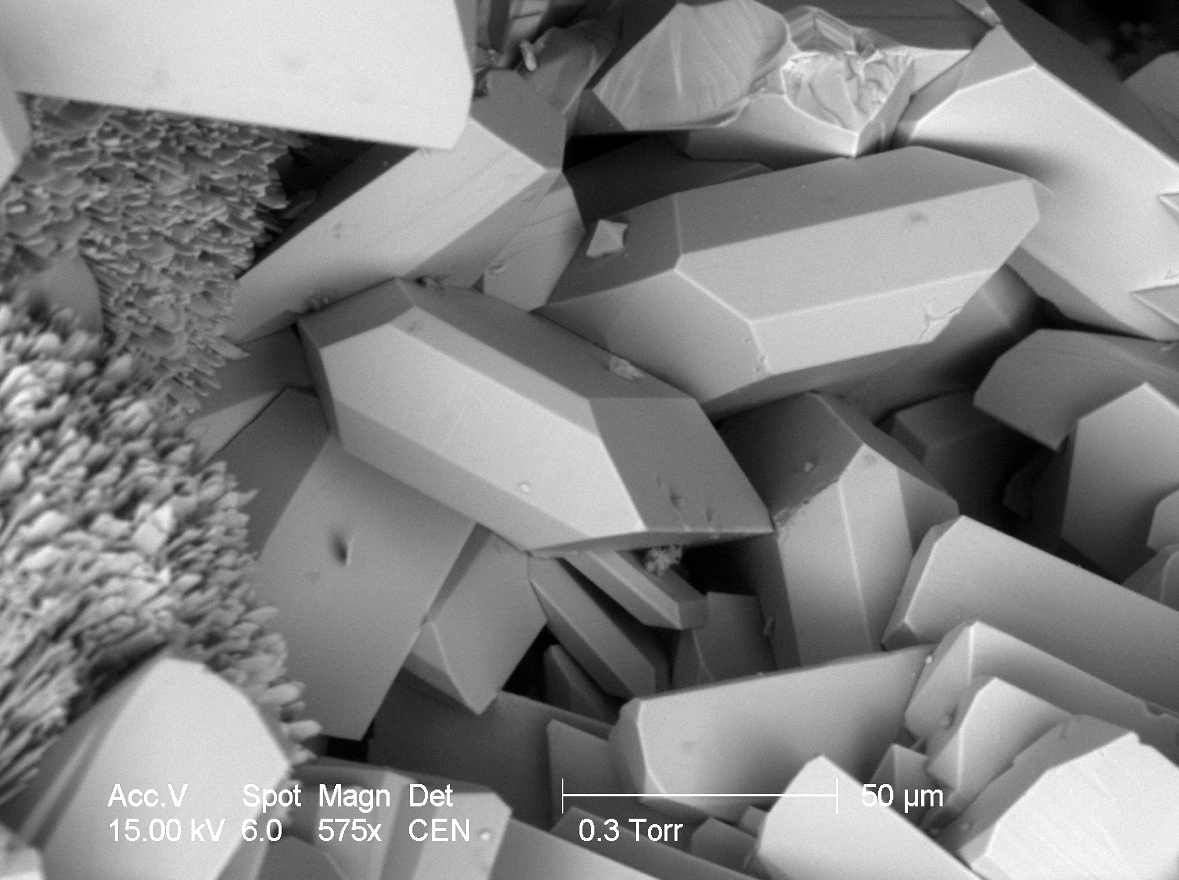
Scanning electron microscope image of hemimorphite crystals on zincolibethenite.
KIPUSHITE (Cu,Zn)5Zn(PO4)2(OH)6 · H2O
Kipushite is probably the most common mineral species in the veszelyite paragenesis after hemimorphite. It forms small blue sugary aggregates up to 0.2 cm, which grow on all other species. When it occurs on the hemimorphite it gives unusual blue-green halo to some specimens, and is usually barely visible with the naked eye. When coats the dark blue veszelyite it is much easier to observe, as lighter blue or blue-green sugary aggregates. Kipushite is present on all specimens, but only when its accumulations get big enough in volume it becomes visible for the naked eye.
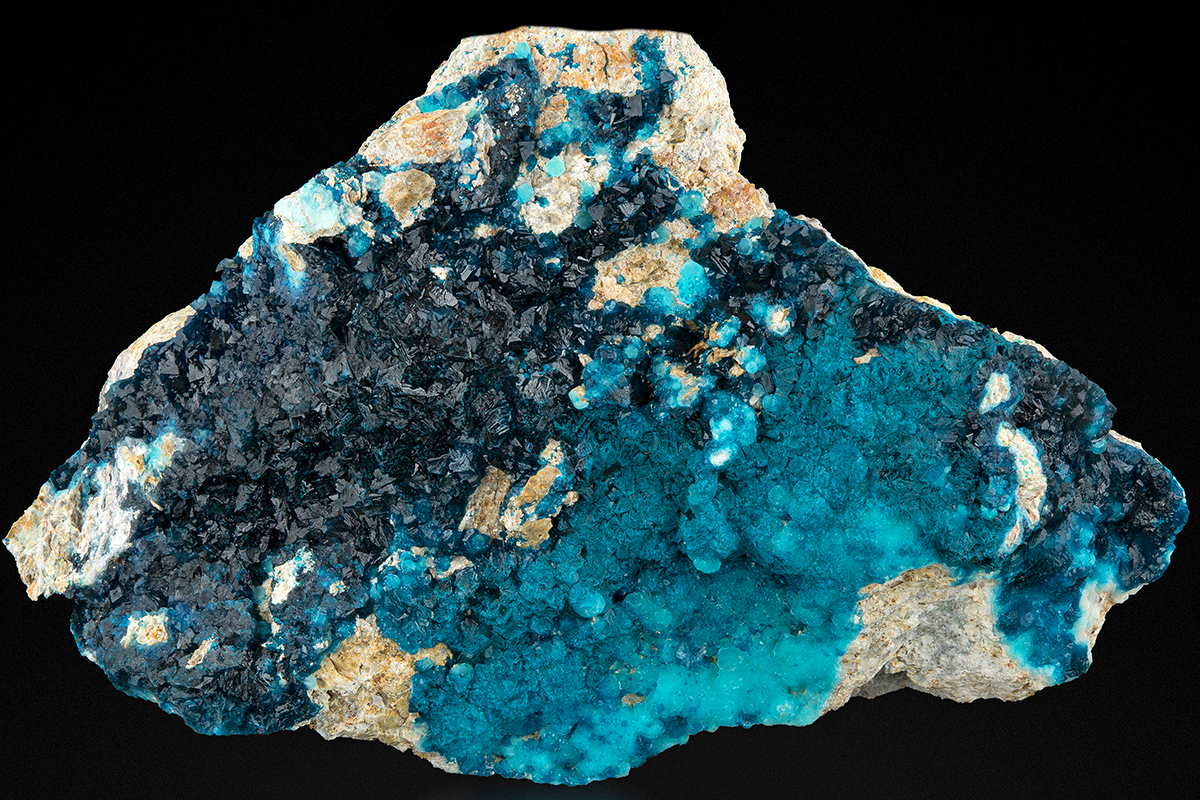
Veszelyite partly overgrown (on the right side of the specimen) by sugary blue kipushite. Specimen 13 cm wide. J. N. Kl? photo.
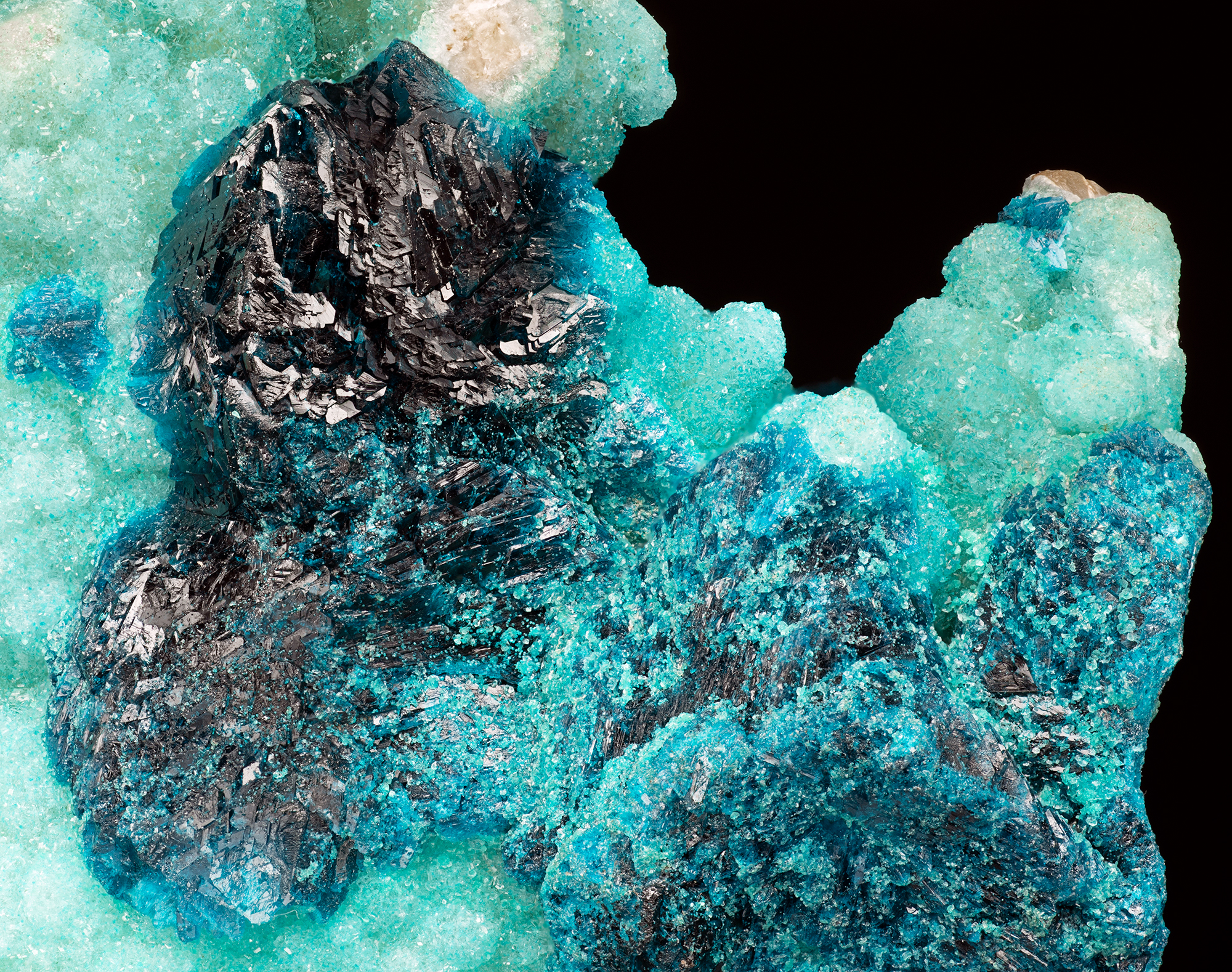
Sugary blue kipushite overgrowing veszelyite and hemimorphite. Veszelyite crystals up to 1.1 cm. M. Mauthner photo.
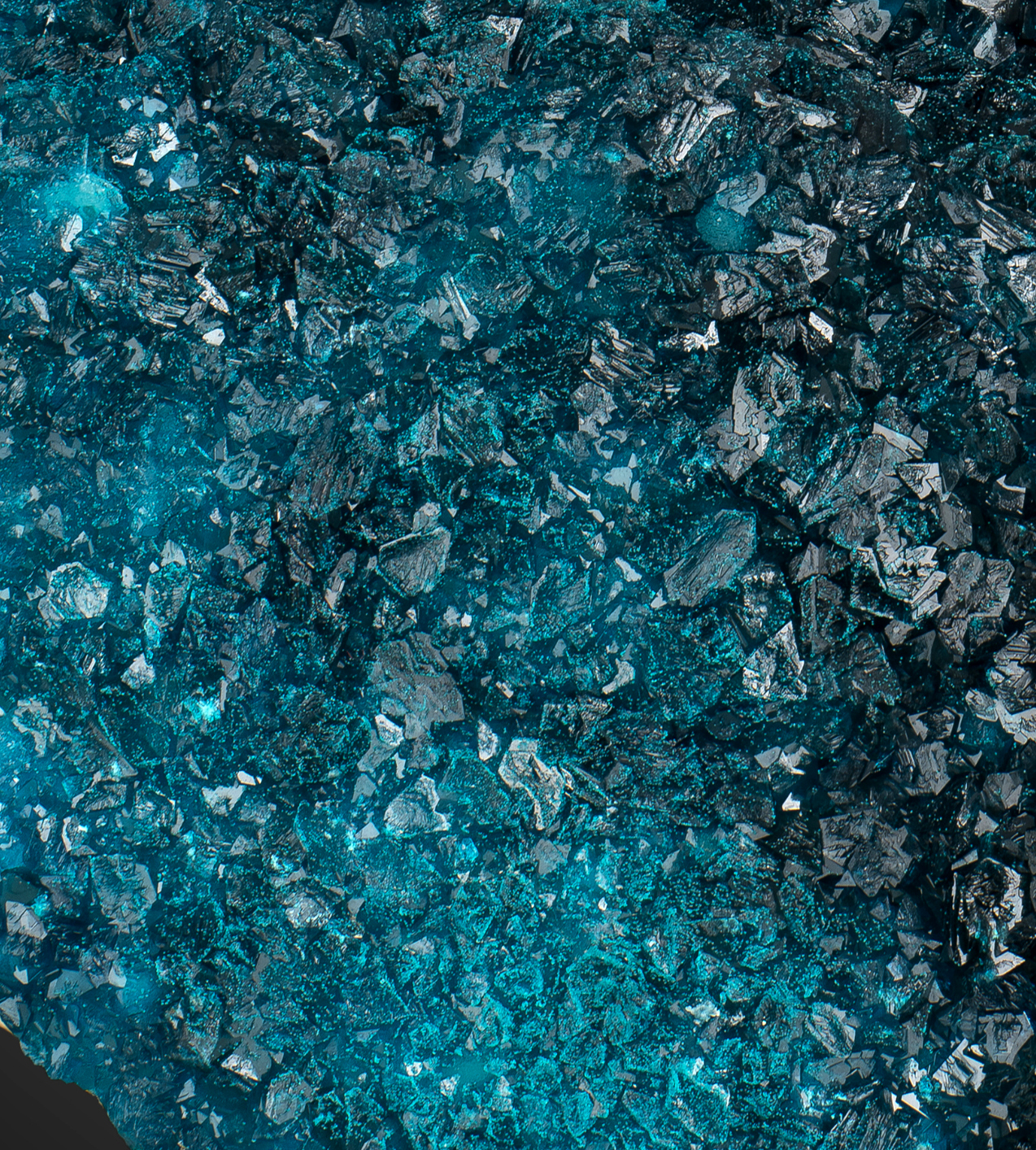
Sugary blue kipushite overgrowing veszelyite. Field of view 1.5 cm. J. N. Kl? photo.
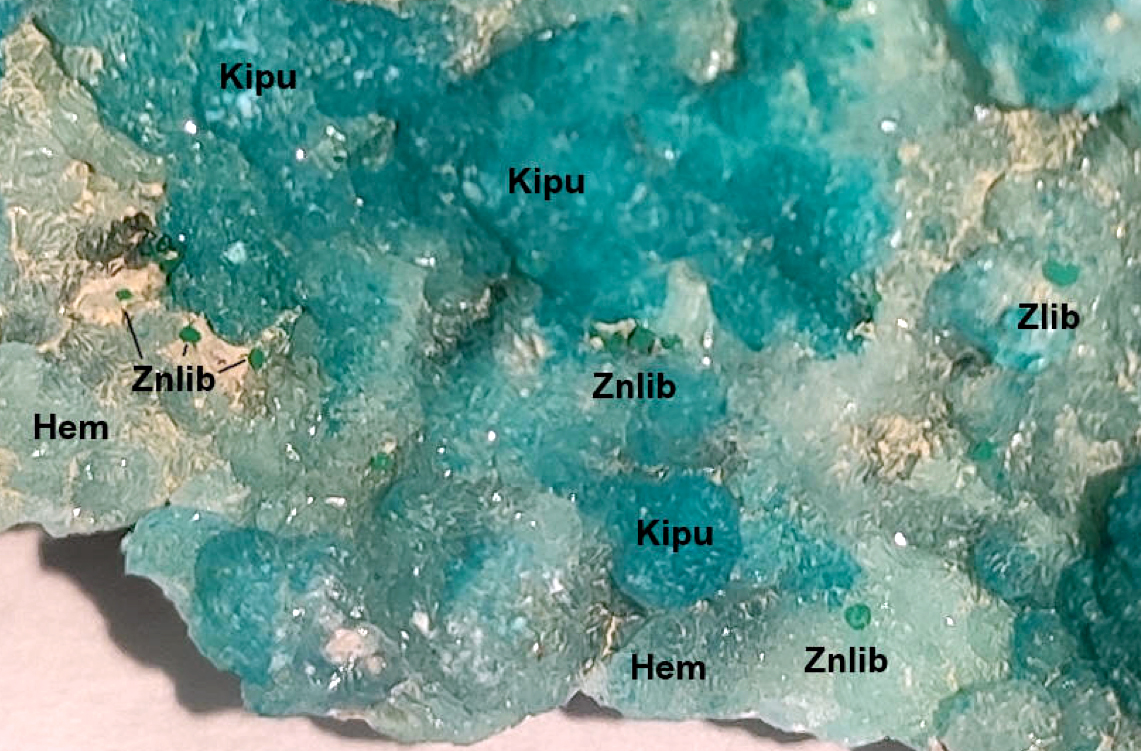
Blue kipushite (Kipu), green spheroidal zincolibethenite (Zinlib) on blue hemimorphite (Hem). On some specimens macroscopic differentiation of all blue-green minerals is very difficult. E. Sze??photo.

Scanning electron microscope image of kipushite (Kipu), zincolibethenite (Zinlib) and hemimorphite (Hem).
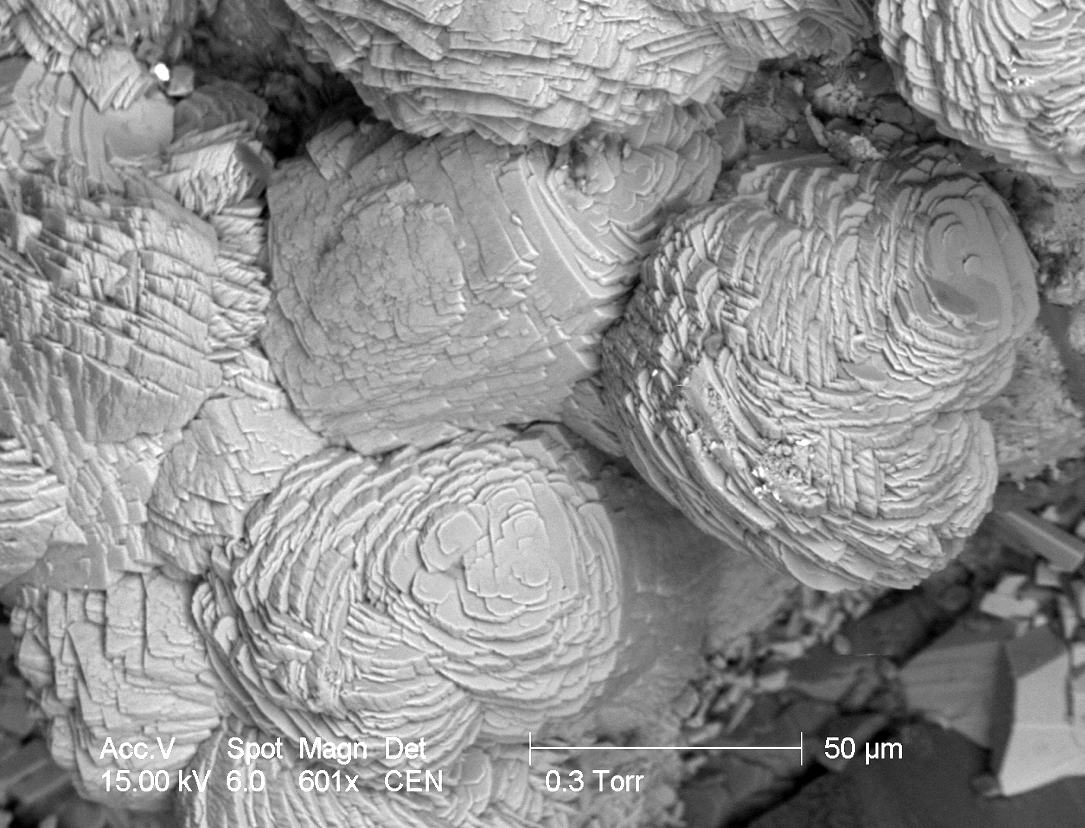
Scanning electron microscope image of aggregates of the kipushite crystals.
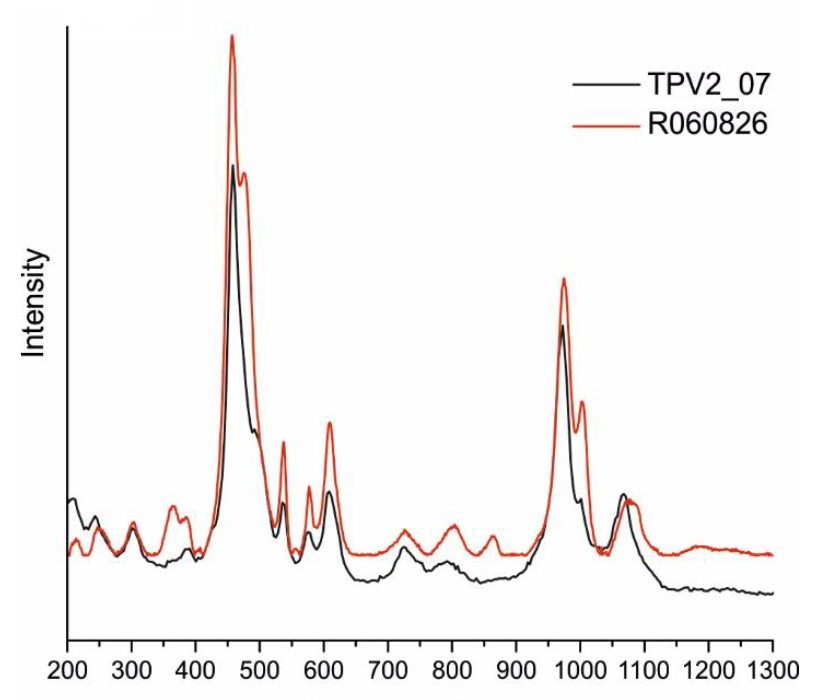
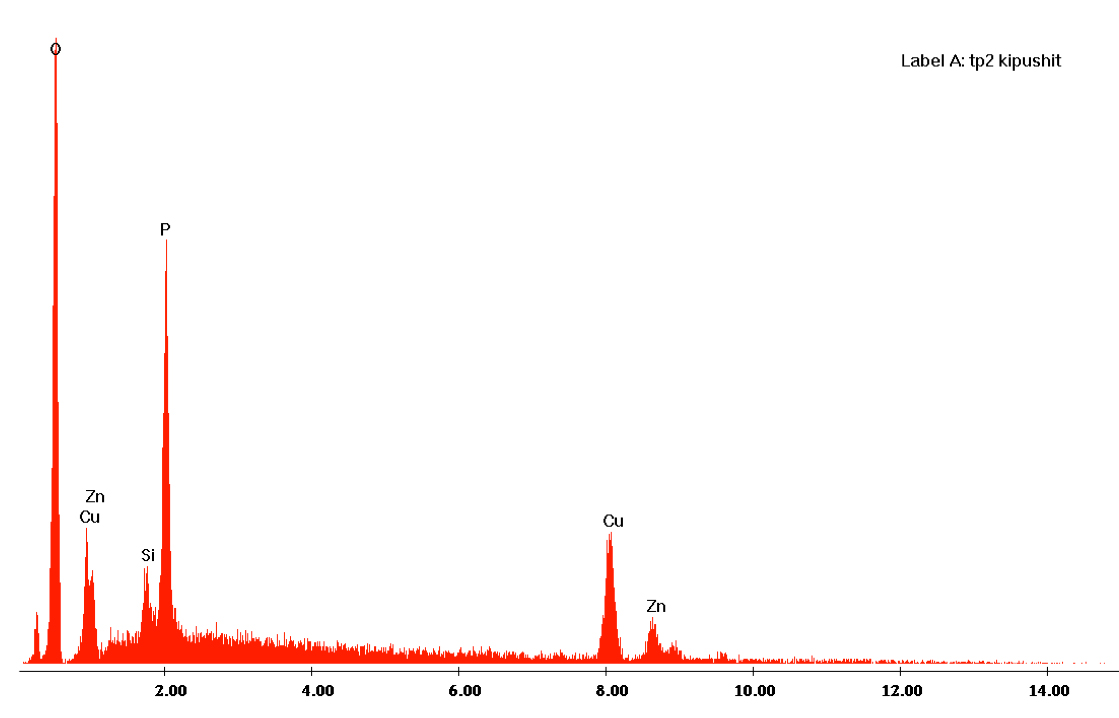
Raman and EDS spectra confirming presence of kipushite from Palabanda.
MALACHITE Cu2(CO3)(OH)2
Malachite is a common mineral in Palabanda, occurring all over the quarry as veins or crusts. The most interesting specimens of malachite come from the malachite-cerussite zone where it is covering breccia clasts in form of the crusts built by acicular crystals. In some areas crystals are packed densely forming hard surface, in others they are more hairy and then very susceptible to damage. Malachite so far is known to be associated almost exclusively with cerussite in Palabanda.
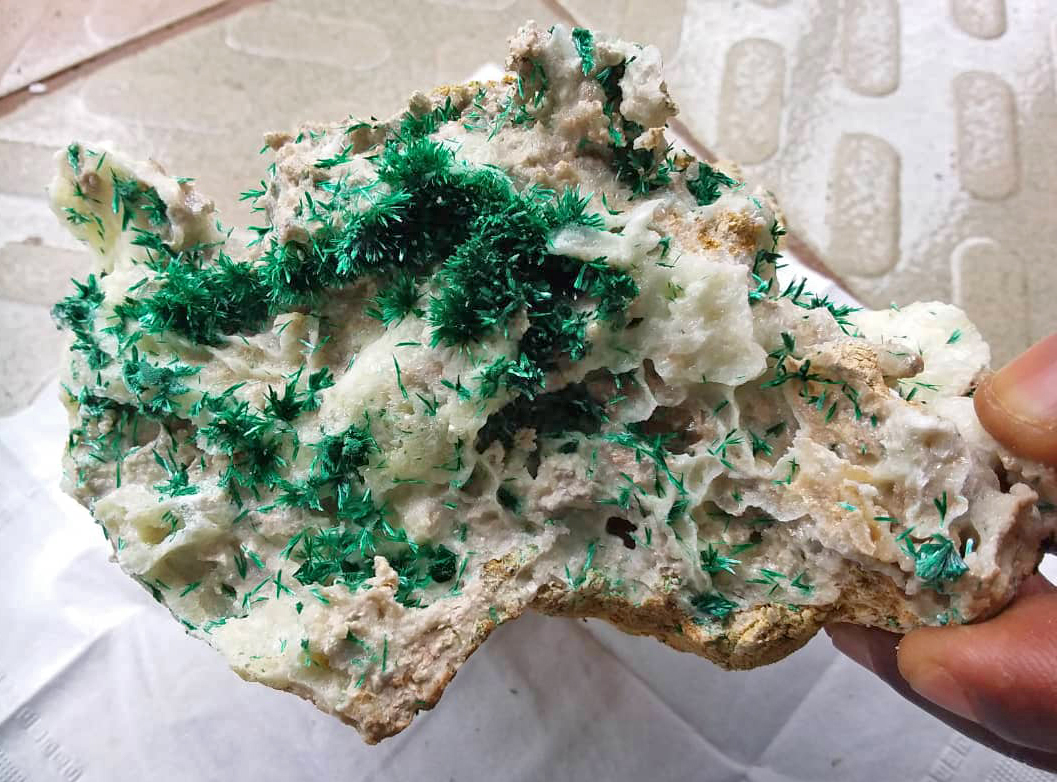
Freshly collected needle-shaped malachite probably on calcite.
Freshly collected velvety malachite with cerussite "snowflake" twins.
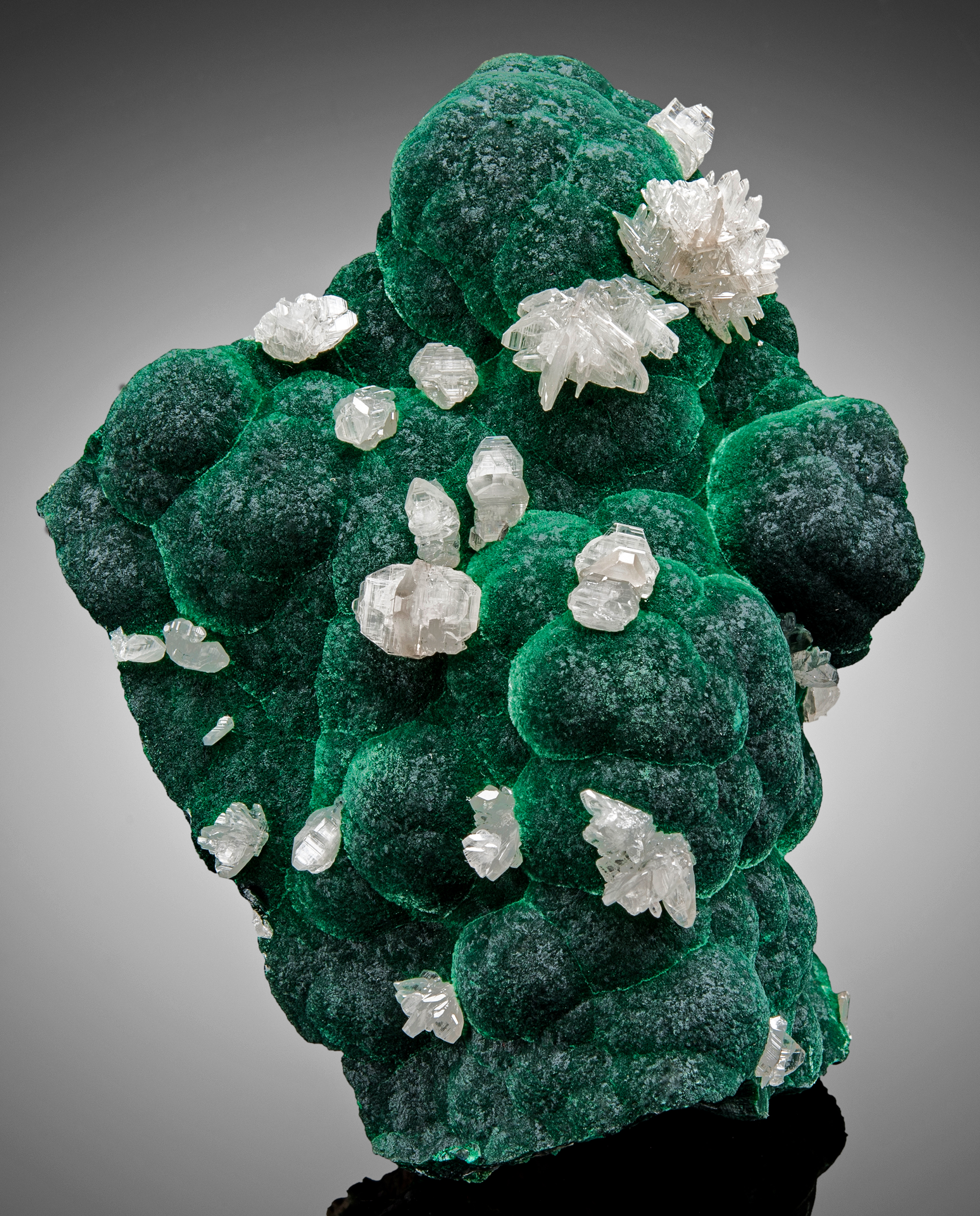
Kidney shaped malachite aggregates with cerussite "snowflake" twins. Specimen 5.8 cm tall. M. Mauthner photo.
SMITHSONITE ZnCO3
Although smithsonite is one of the most important ore minerals in the deposit, it is quite uncommon in the mineralization present in cavities. In the hemimorphite zone it is formed as white elongated rhombohedrons or their groups, usually up to 5 mm length. In the area to the east from the hemimorphite zone smithsonite grows on aurichalcite formed as spheroidal aggregates.
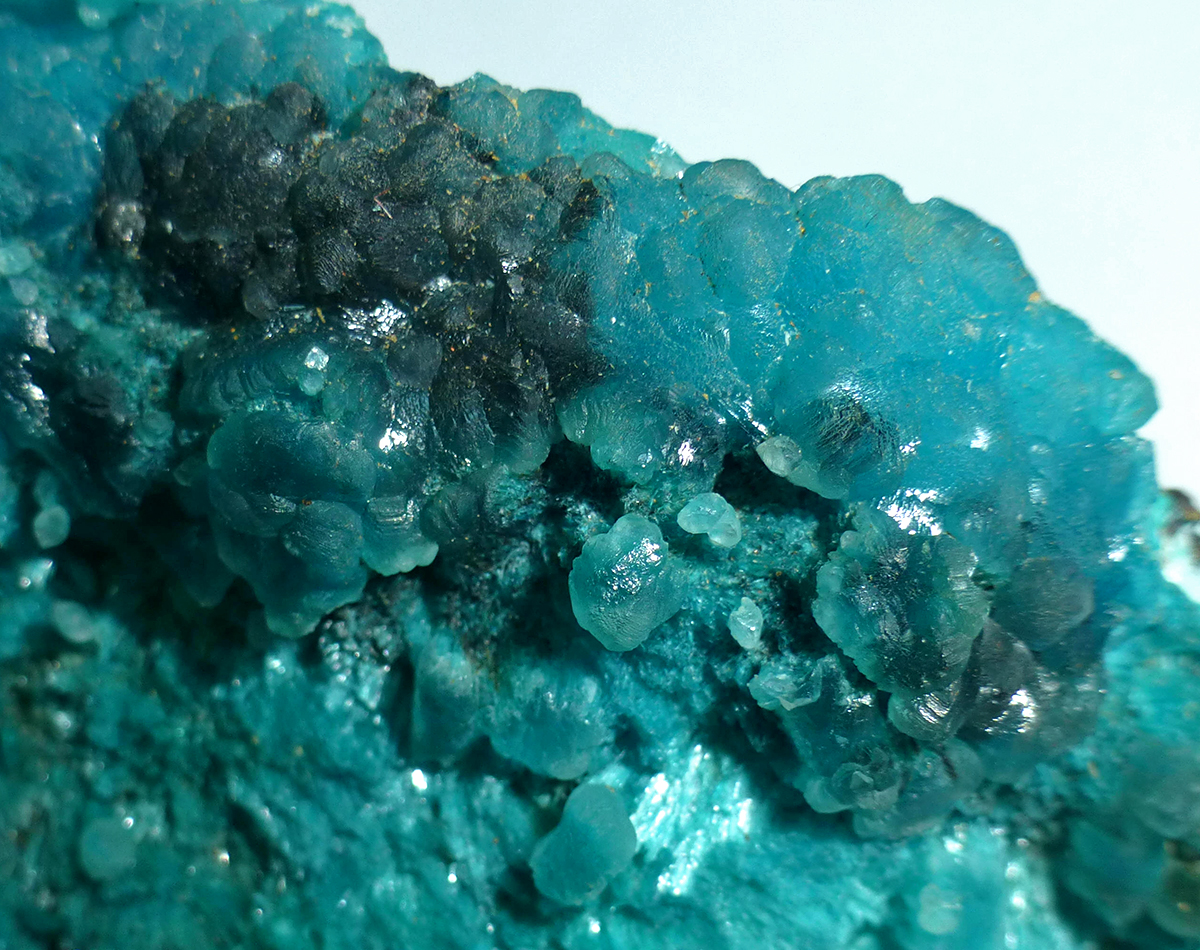
Smithsonite aggregates growing on aurichalcite. Field of view 3 cm.
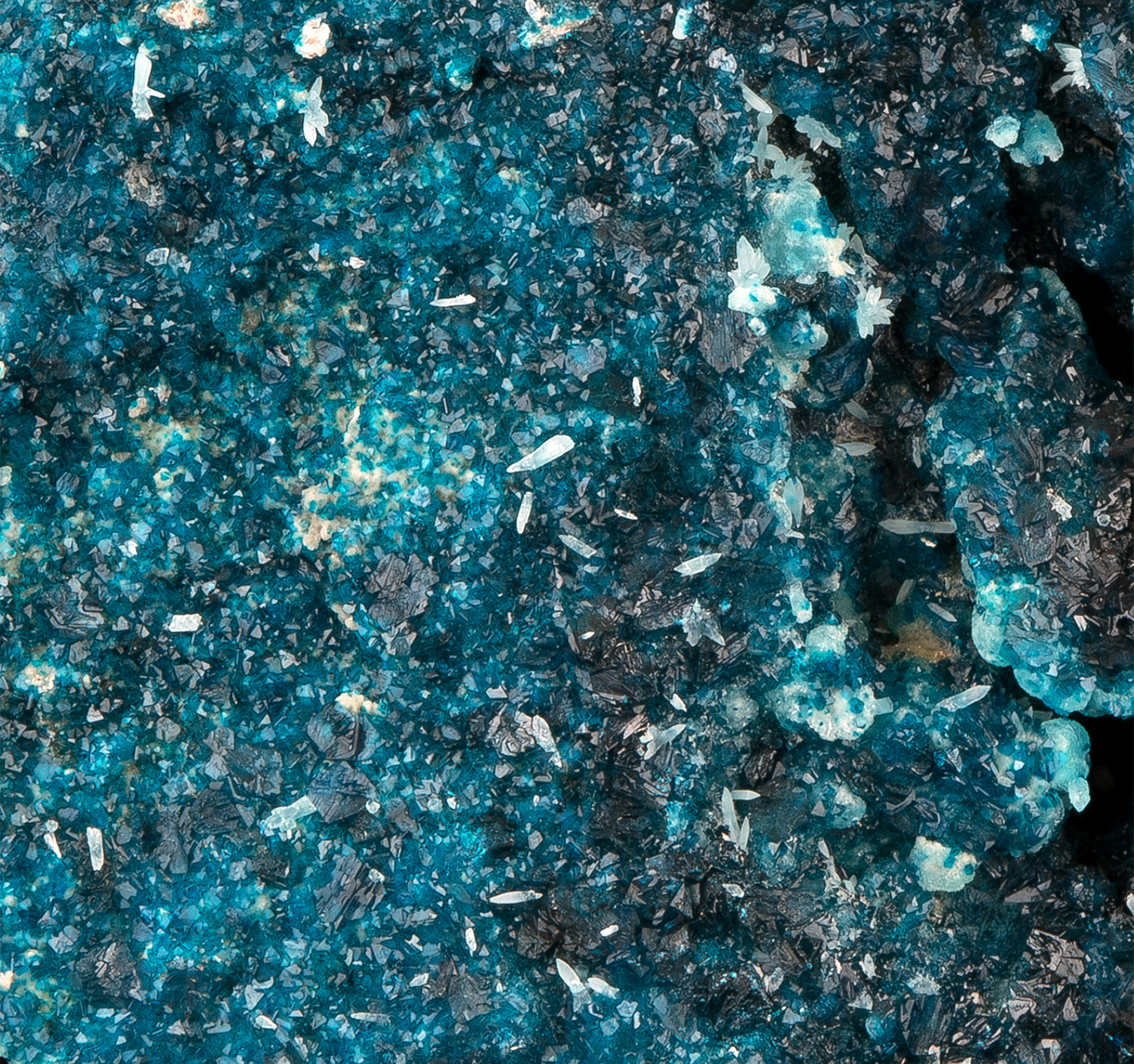
Smithsonite rhombohedrons (white) sprinkled on veszelyite. Field of view 4 cm. J. Kl? photo.
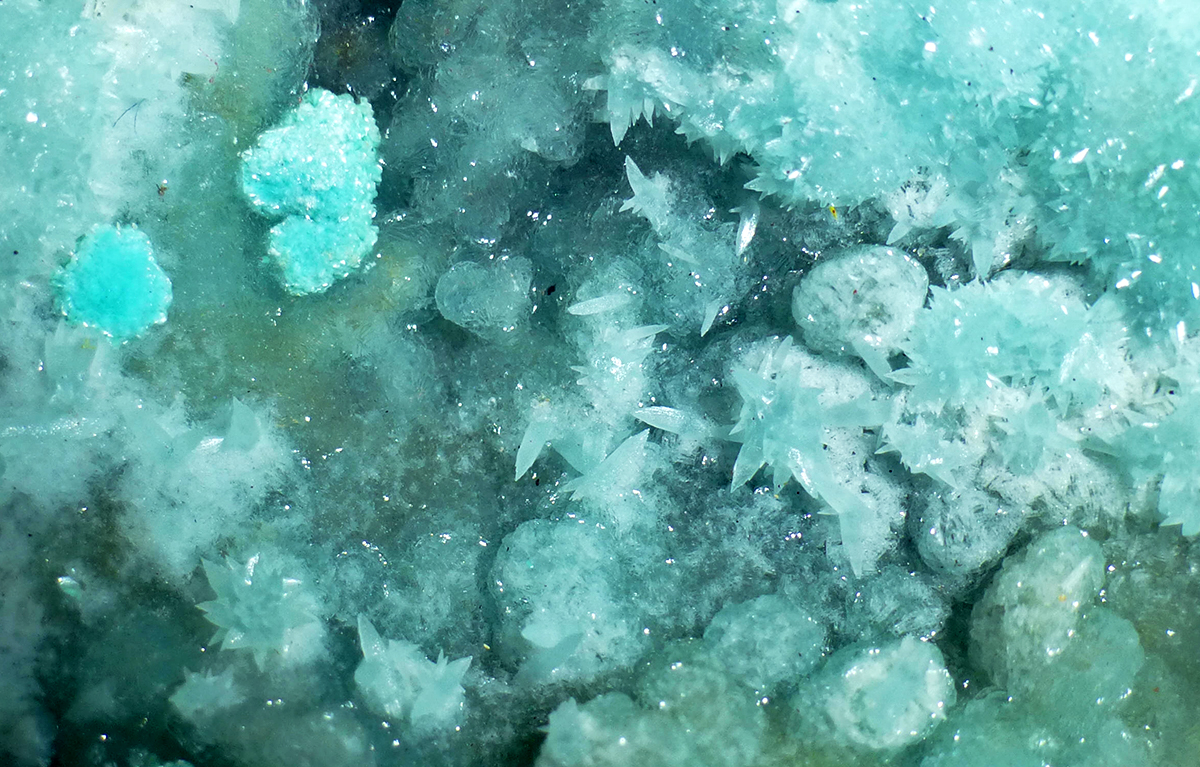
Smithsonite rhombohedrons sprinkled on hemimorphite, with hemispheroidal agregartes of aurichalcite. Field of view 4 cm. E. Sze??photo.
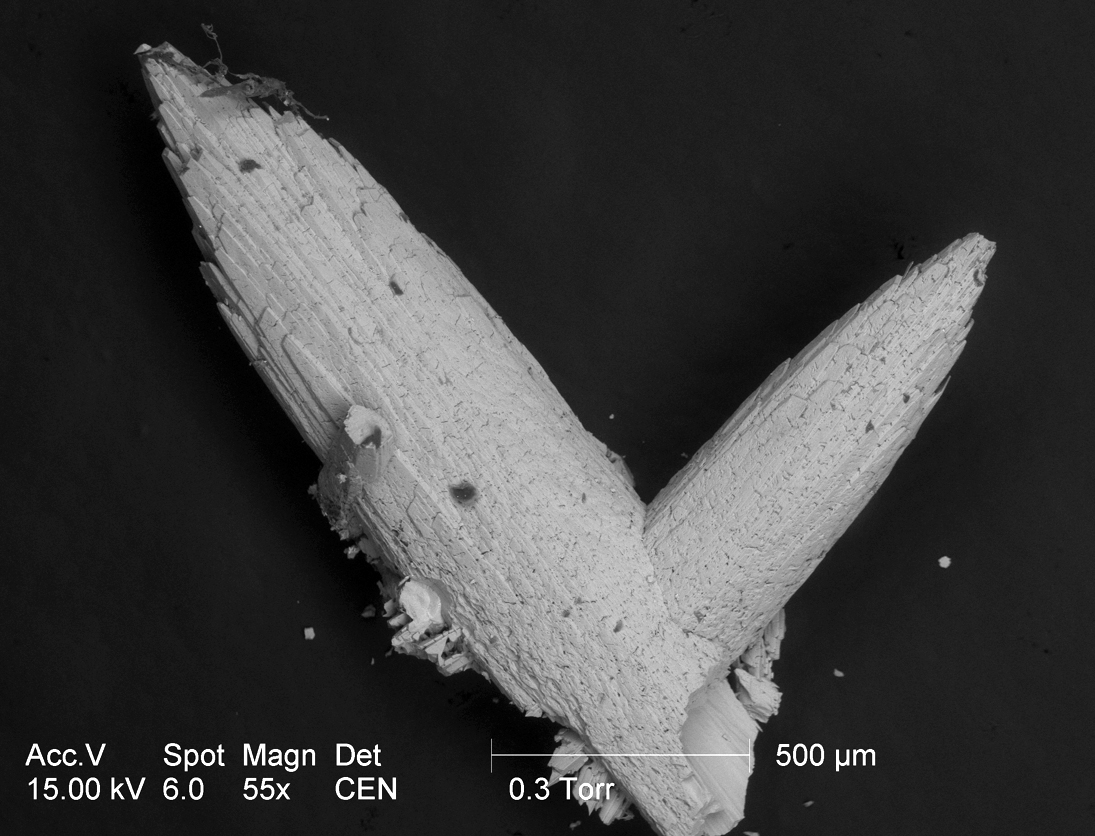
Scanning electron microscope photo of the smithsonite elongated rhombohedron. Size of the crystal about 1.5 mm.
VESZELYITE (Cu,Zn)2Zn(PO4)2 · 2H2O
The most interesting mineral species from Palabanda is veszelyite. It was found in only one small area of the hemimorphite zone, over a distance of about 1 m. The coverage of the veszelyite crystals was uneven in that zone – in some areas crystals were packed so dense that they formed 2-3 cm thick crusts (especially in the crevices of the cavities). In other places they were found as well separated crystals on hemimorphite.
The color of the veszelyite depends on the thickness of the crystals – small ones, or skeletal flat ones, are completely transparent and have bright sky blue color. When they get thicker the color goes to sapphire-blue and then to blueish-black in the biggest crystals. The luster on veszelyite is usually good or very good. Especially smaller crystals have great luster and frequently form a sparkly druse on hemimorphite.
The size of the veszelyite crystals varys from less than 1 mm to about 2 cm. Usually when crystal grow bigger they became more and more skeletal. This results in some cases as extreme skeletal growth manifesting as very flattened crystals.
Three general morphological types of the veszelyite crystals were observed. The first one is sharp, well formed pseudo-octahedral crystals, usually up to 7 mm. Unfortunately only a few specimens with larger crystals of that type where found; smaller 1-2 mm crystals are common in that habit. The second type exhibits more complex parallel intergrowths reaching up to 2 cm. They still have a general pseudo-octahedral shape, but are much more complex than first type. The third type show complex parallel intergrowths of numerous crystals, frequently skeletal, and other complex morphologies. In extreme cases of skeletal growth some of the crystals are 1 mm thick and 15 mm across.
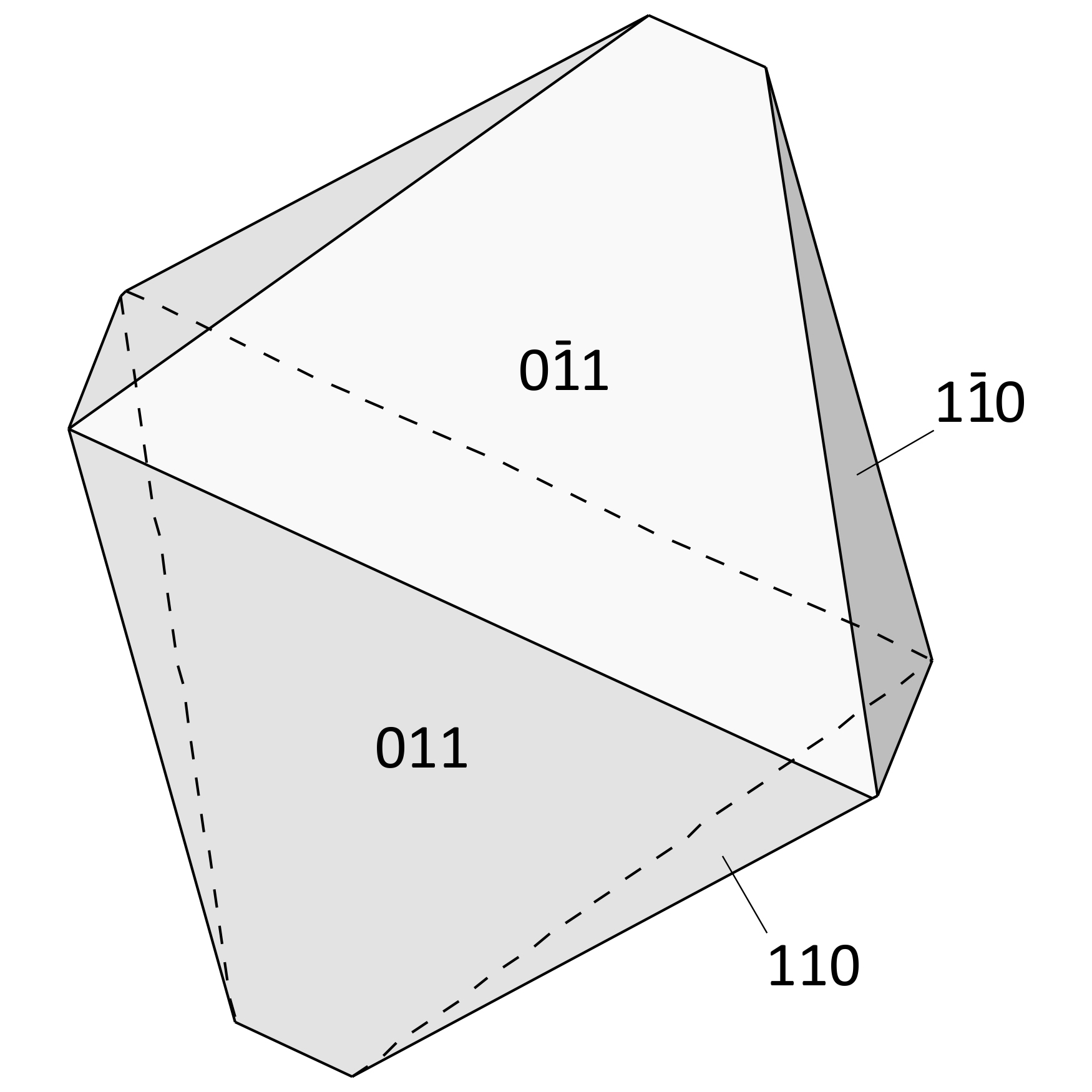
Crystallographic drawing of the idealized pseudo-octahedral habit of the monoclinic veszelyite. Drawing by A. Recnik.
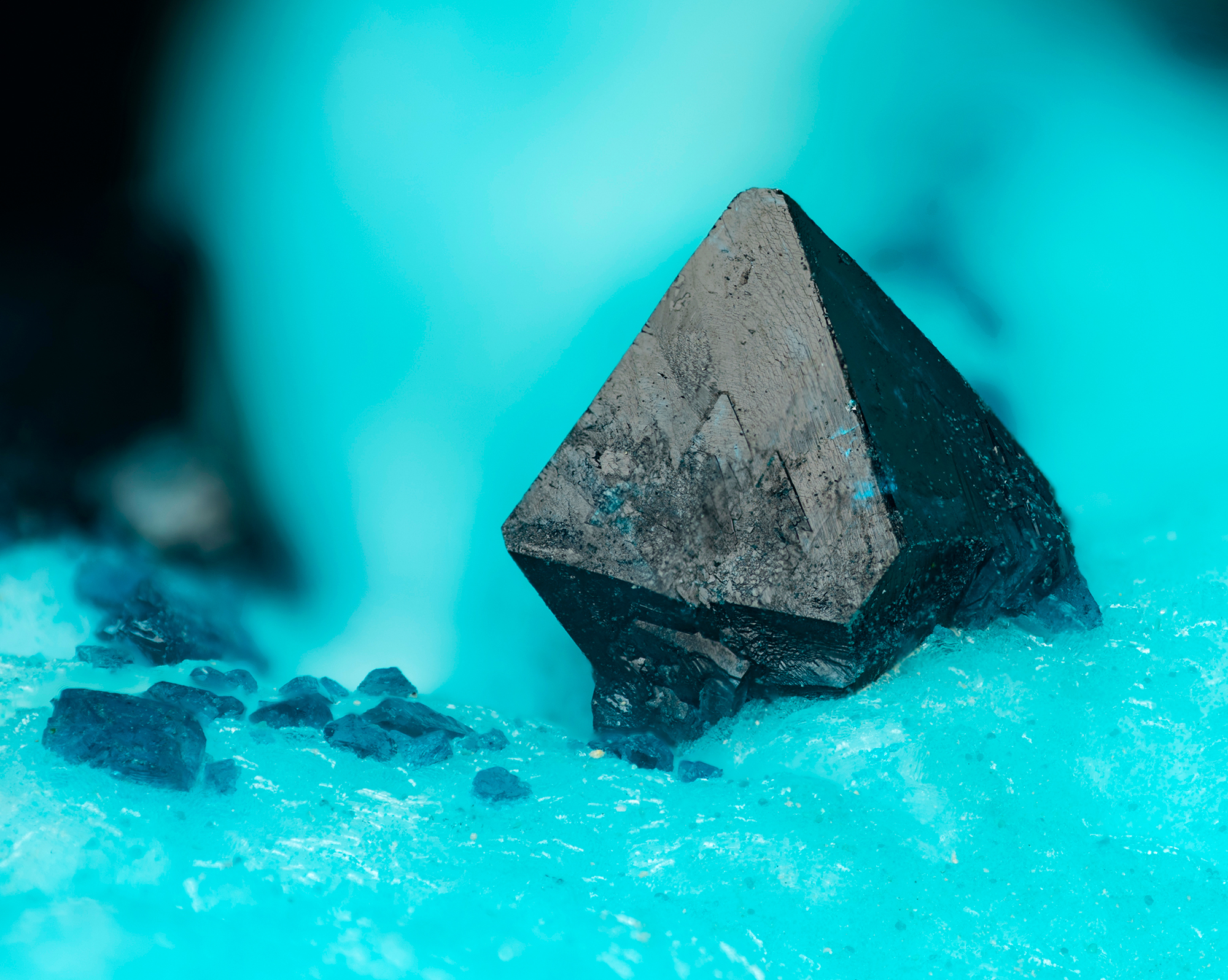
Sharp, well developed veszelyite crystals in pseudo-octahedral habit are among the rarest in specimens from Palabanda. Crystal 5 mm tall. M. Mauthner photo.
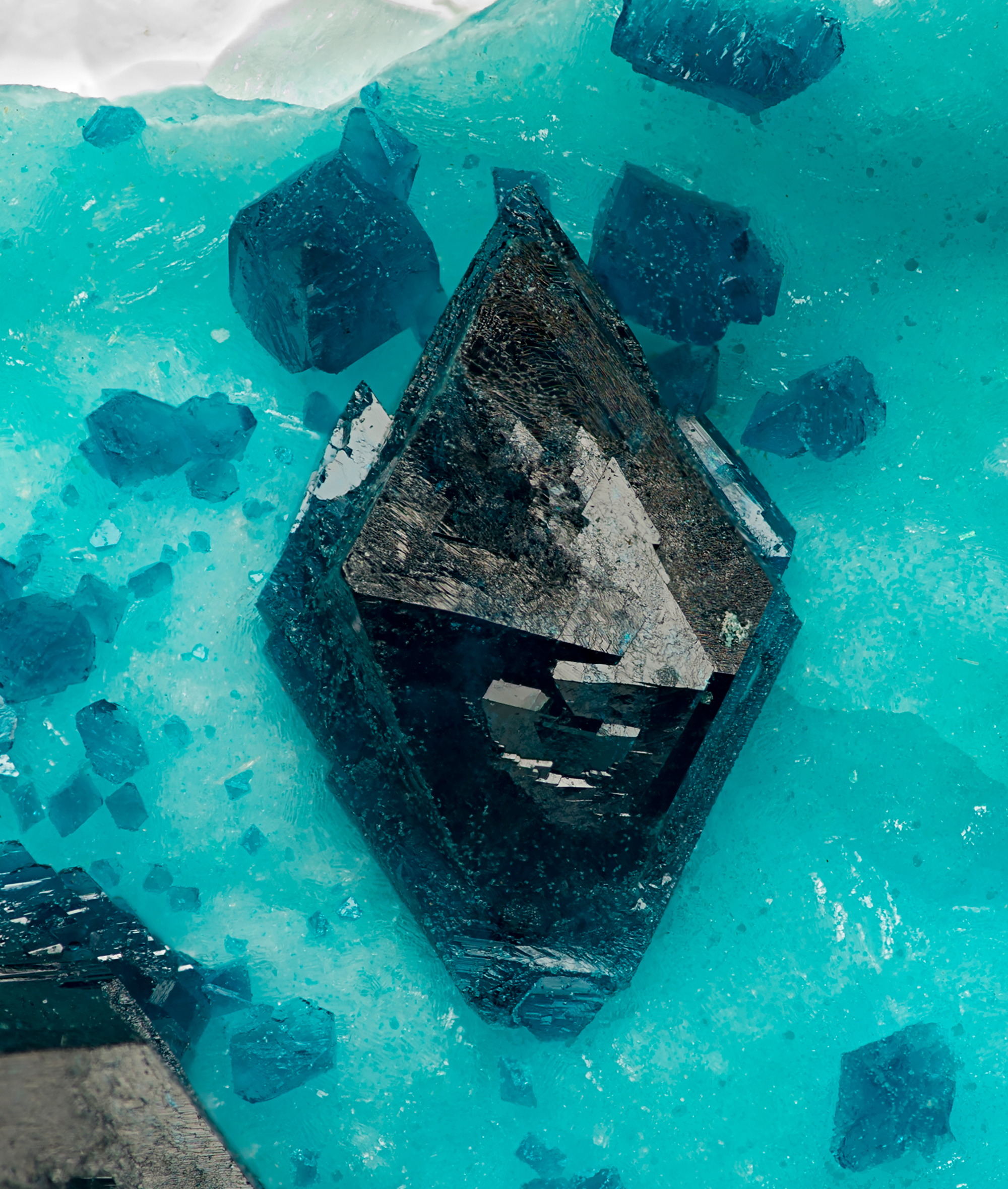
Doubly terminated, sharp, pseudo-octahedral veszelyite crystal on hemimoprhite. 7 mm tall. M. Mauthner photo.
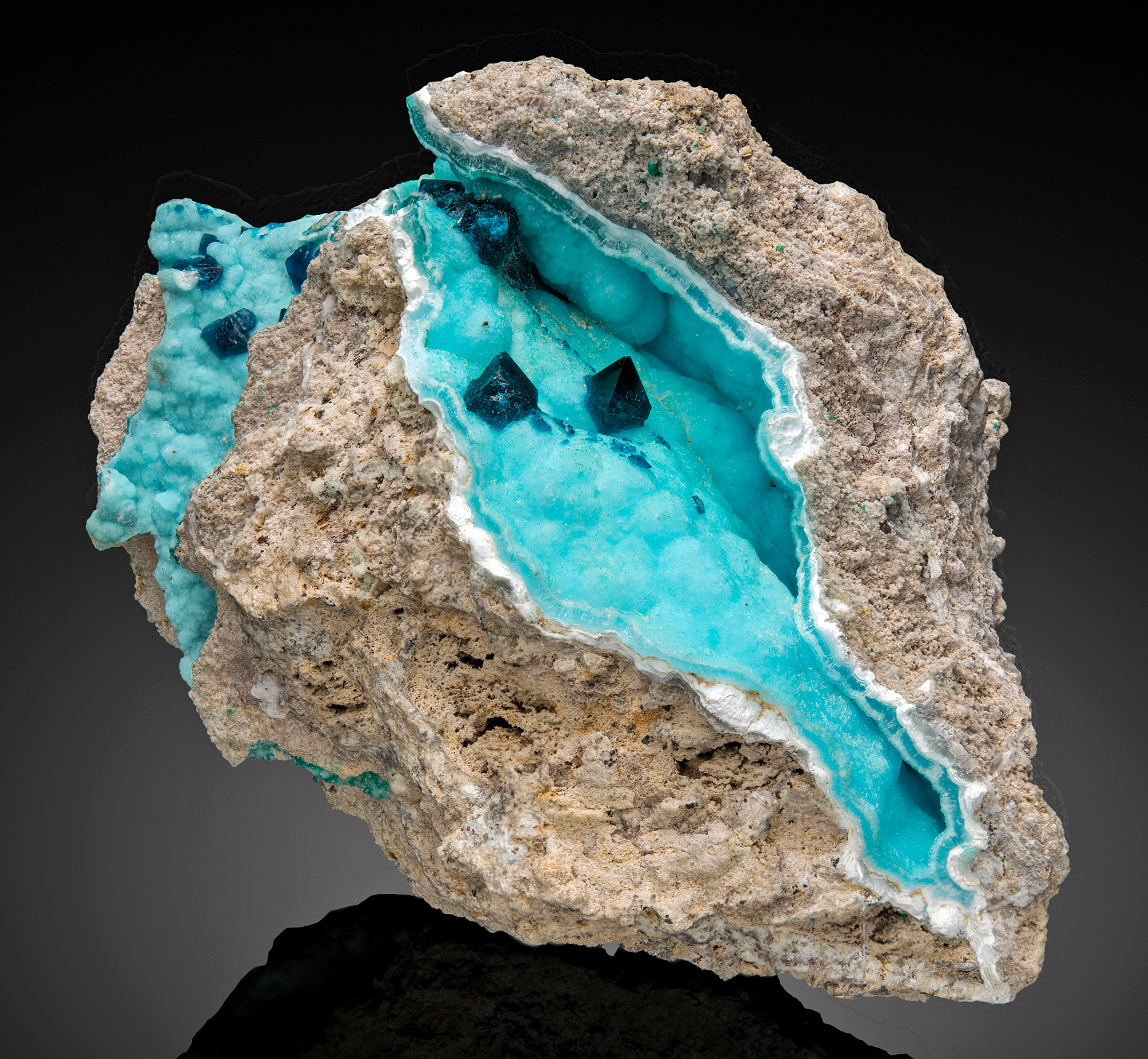
Well developed pseudo-octahedral veszelyite crystals on blue hemimorphite. Specimen 6.5 cm across. M. Mauthner photo.
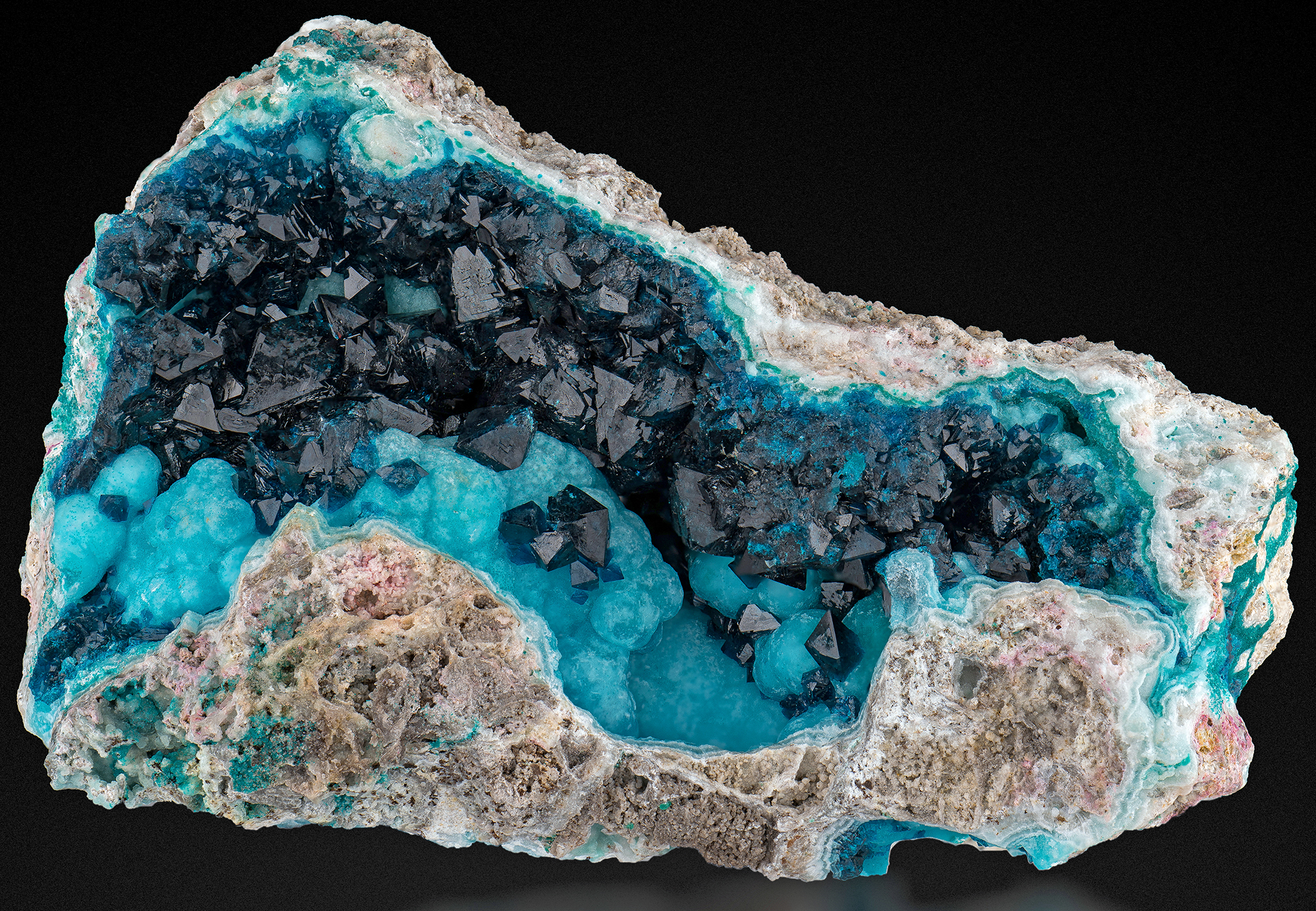
One of the specimens with well developed pseudo-octahedral veszelyite crystals on blue hemimorphite. Specimen 9 cm across. M. Mauthner photo. Spirifer collection. J. Kl? photo.
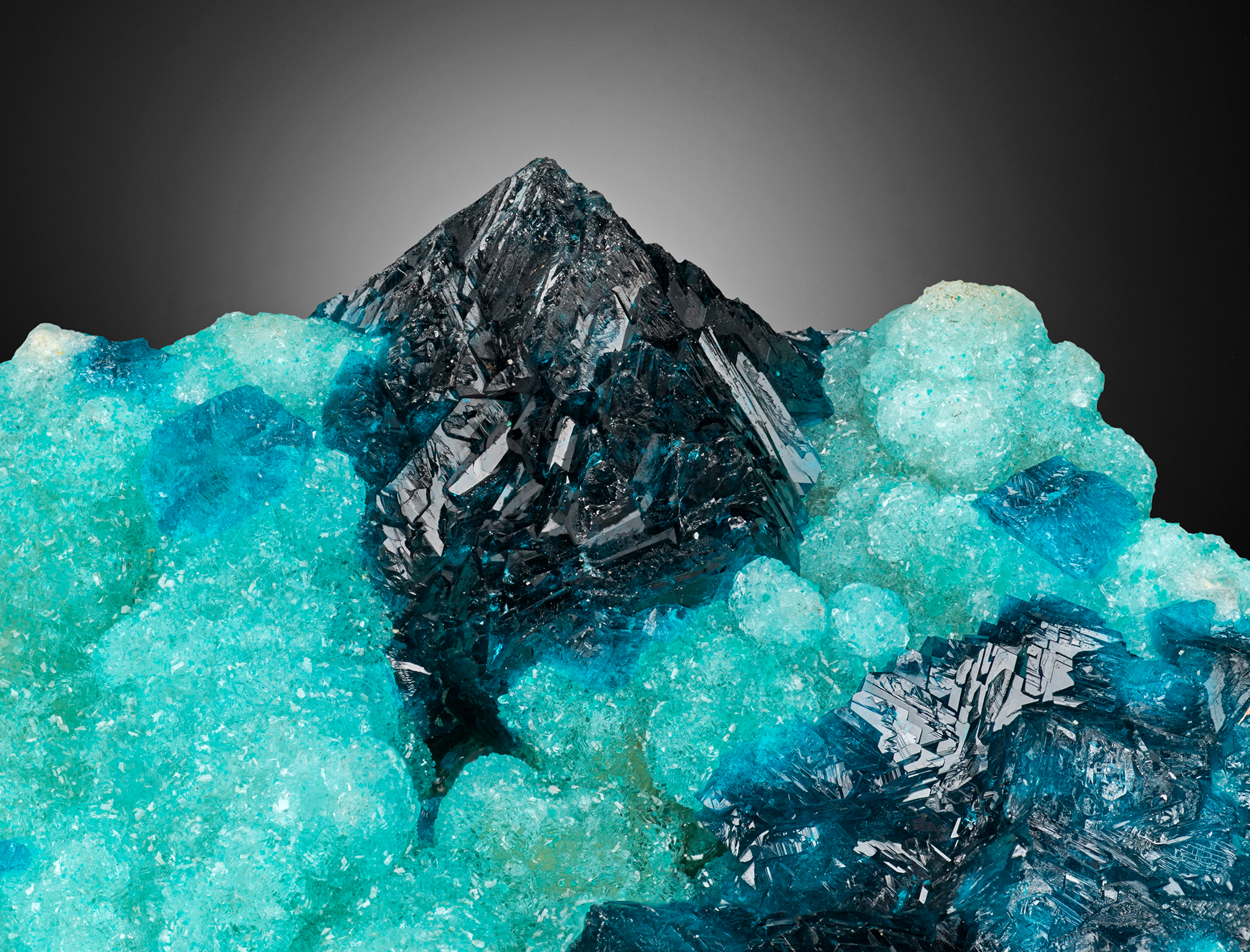
More complex parellel growth veszelyite crystals are more common, but still quite rare in Palabanda. Main crystal 1 cm tall. M. Mauthner photo.
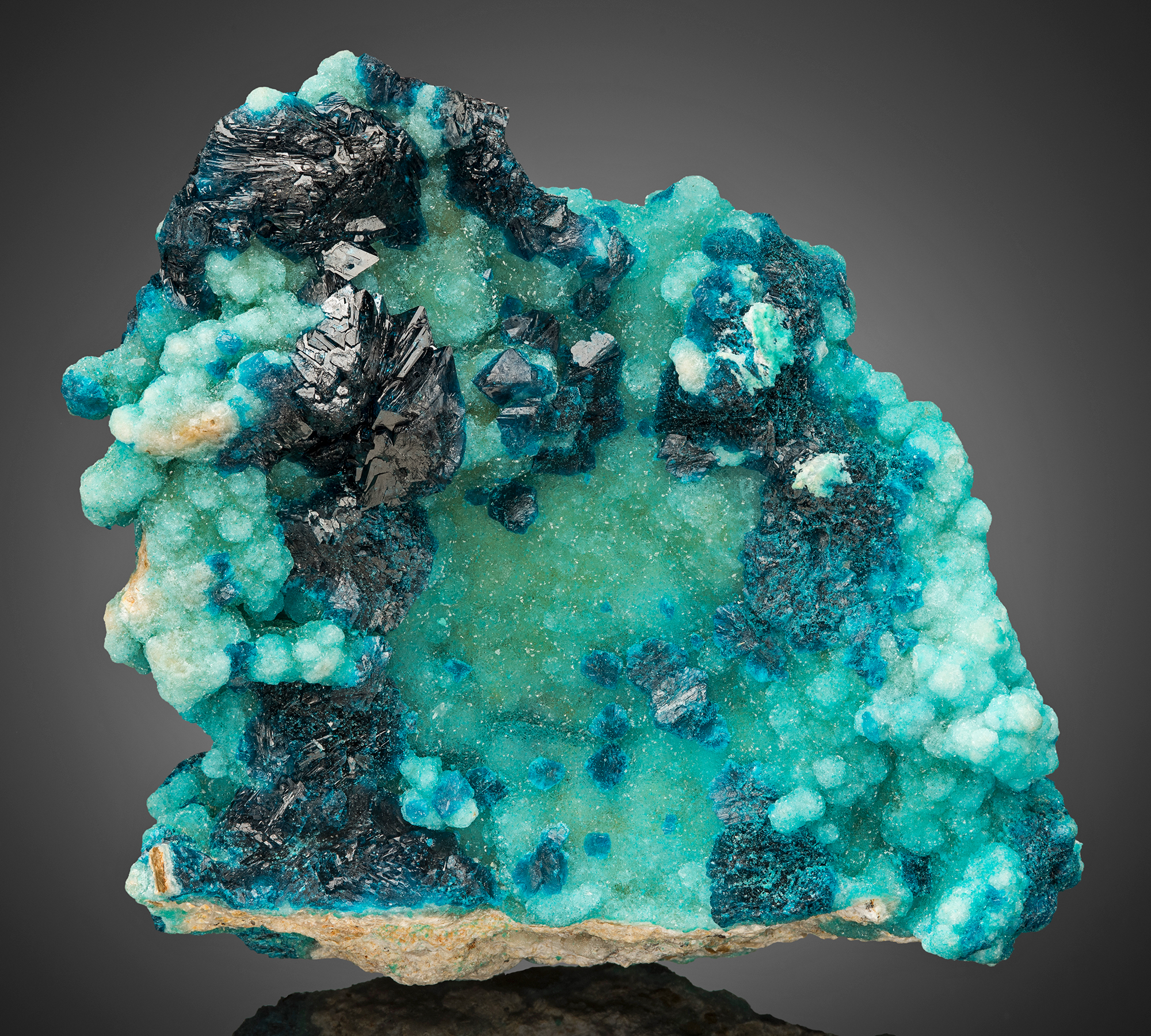
Complex parallel growth veszelyite crystals on hemimoprhite. Specimen 6 cm across. M. Mauthner photo.
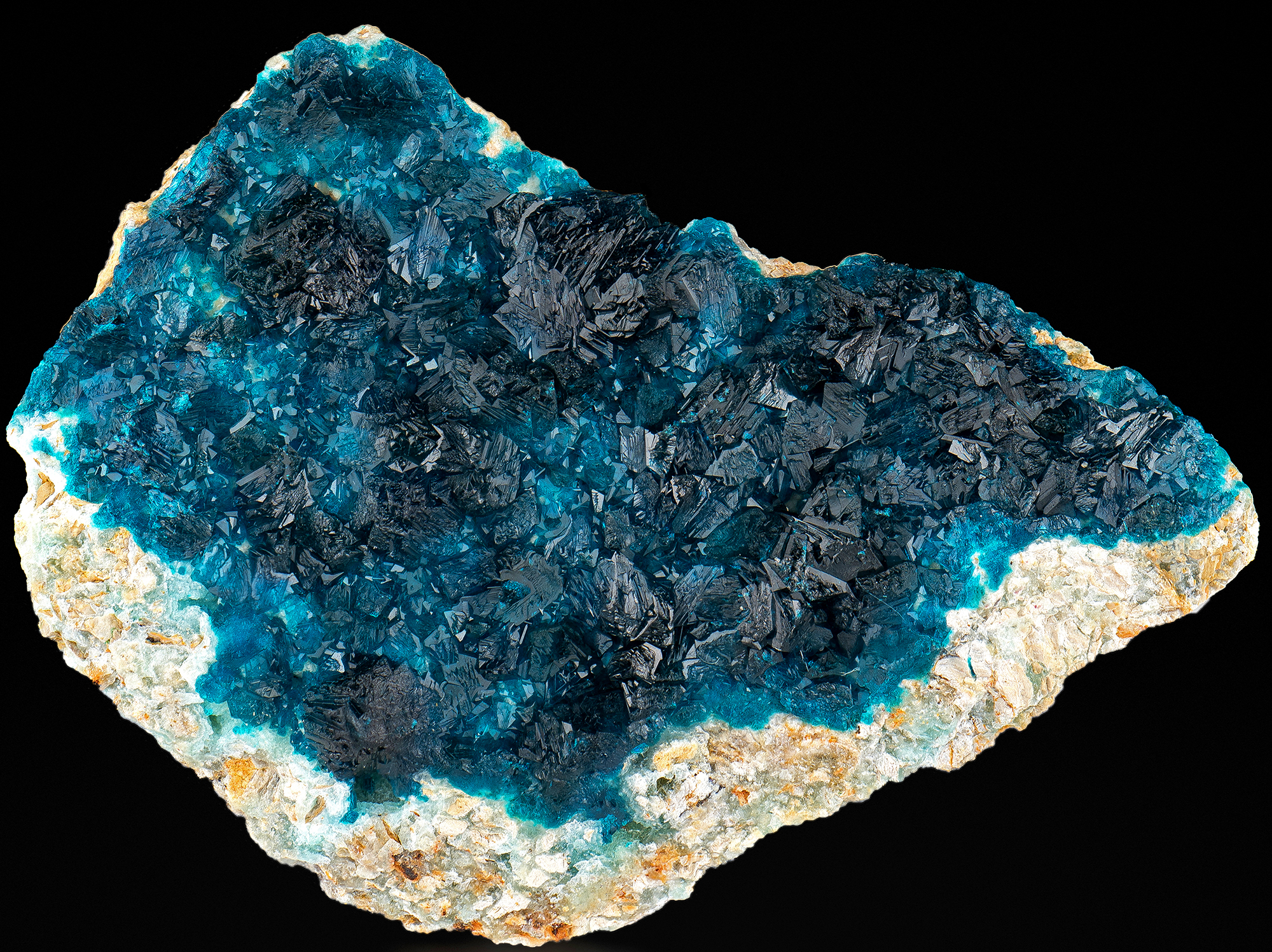
Complex parallel growth veszelyite crystals on hemimoprhite. Specimen 4.5 cm tall. J. Kl? photo.
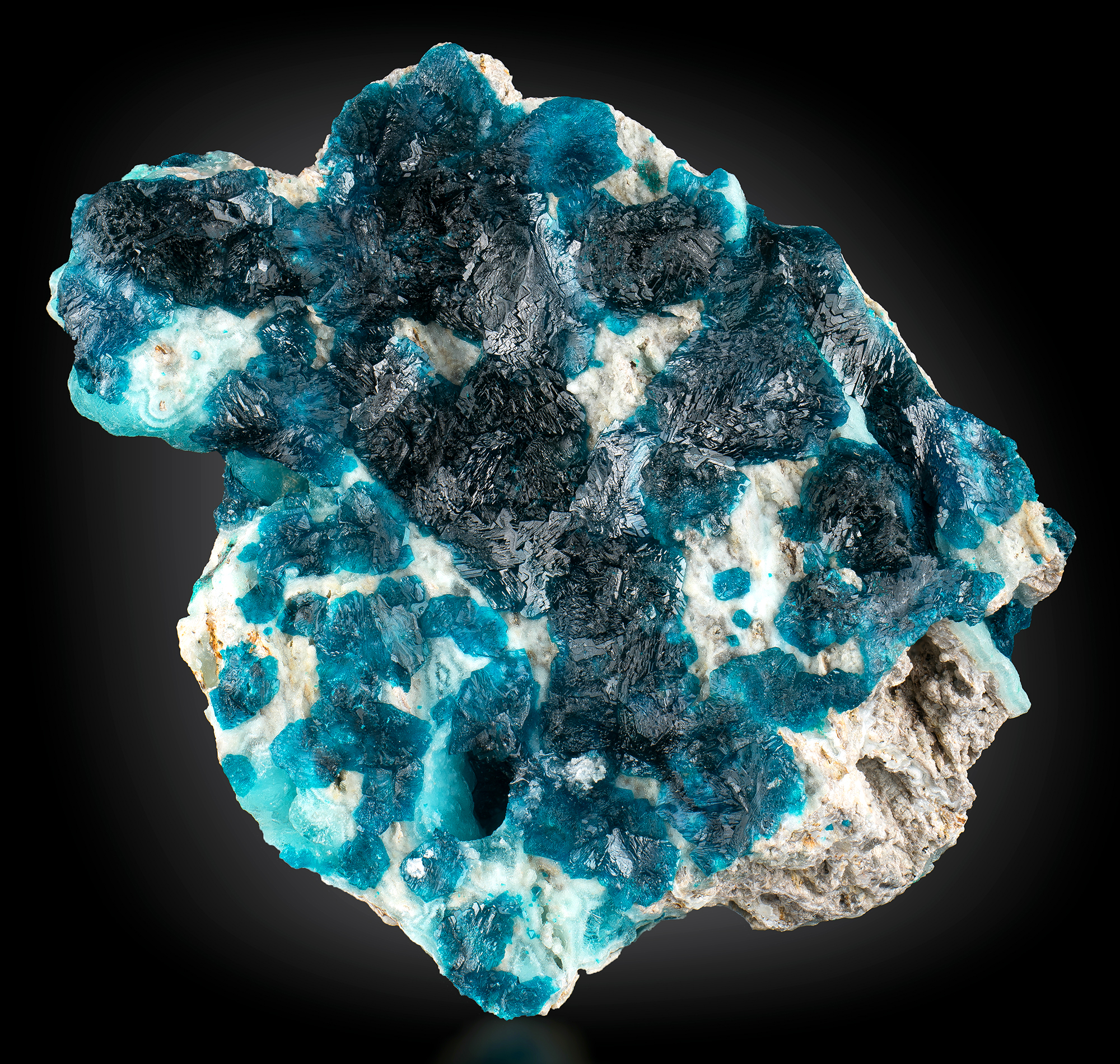
The most common in Palabanda are flattened complex parallel intergrowths of numerous skeletal crystals of veszelyite. Specimen 5 cm tall. J. N. Kl? photo.
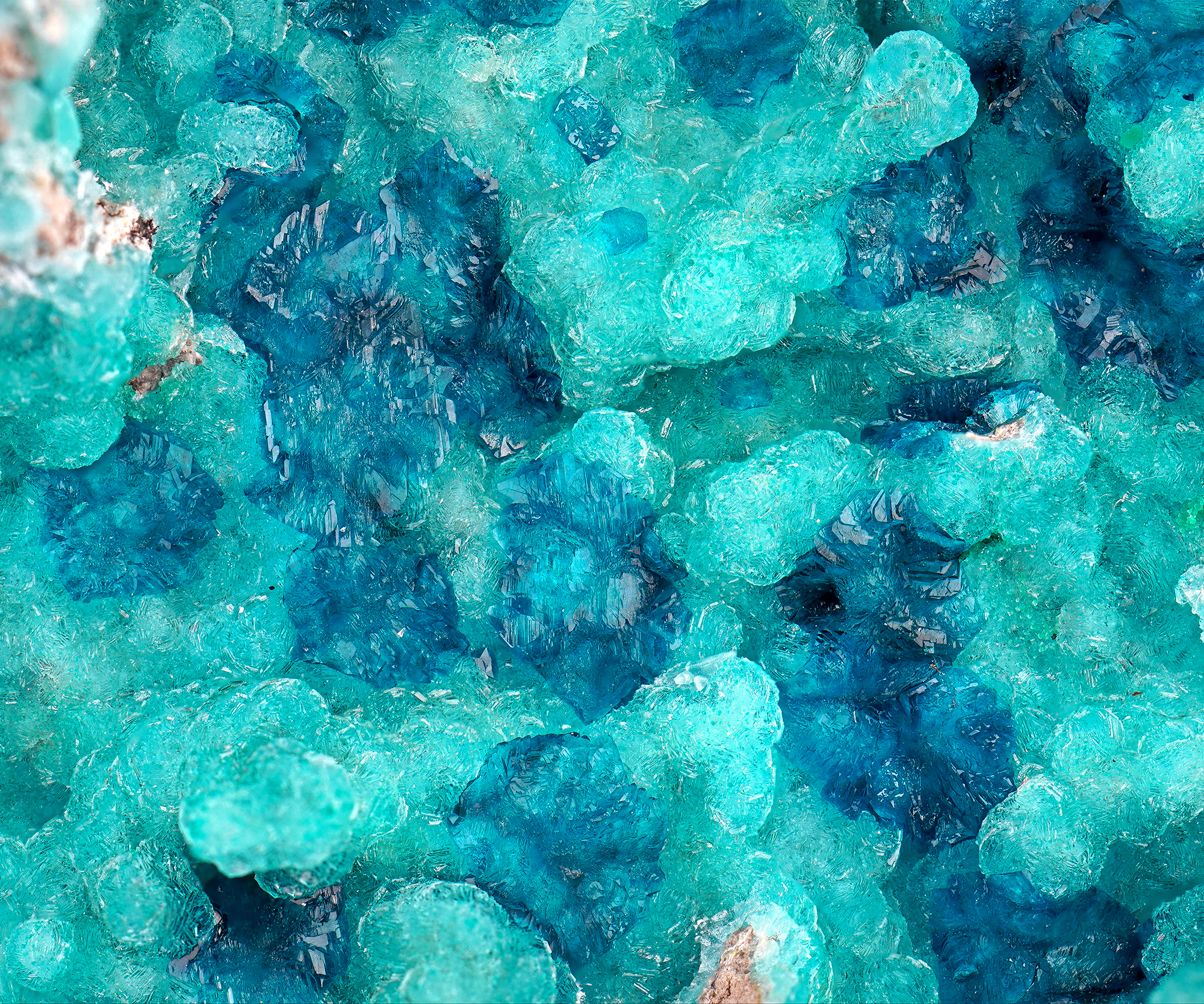
Transparent, flat, skeletal crystals of veszelyite on hemimorphite. Field of view 3 cm. J. N. Kl? photo.
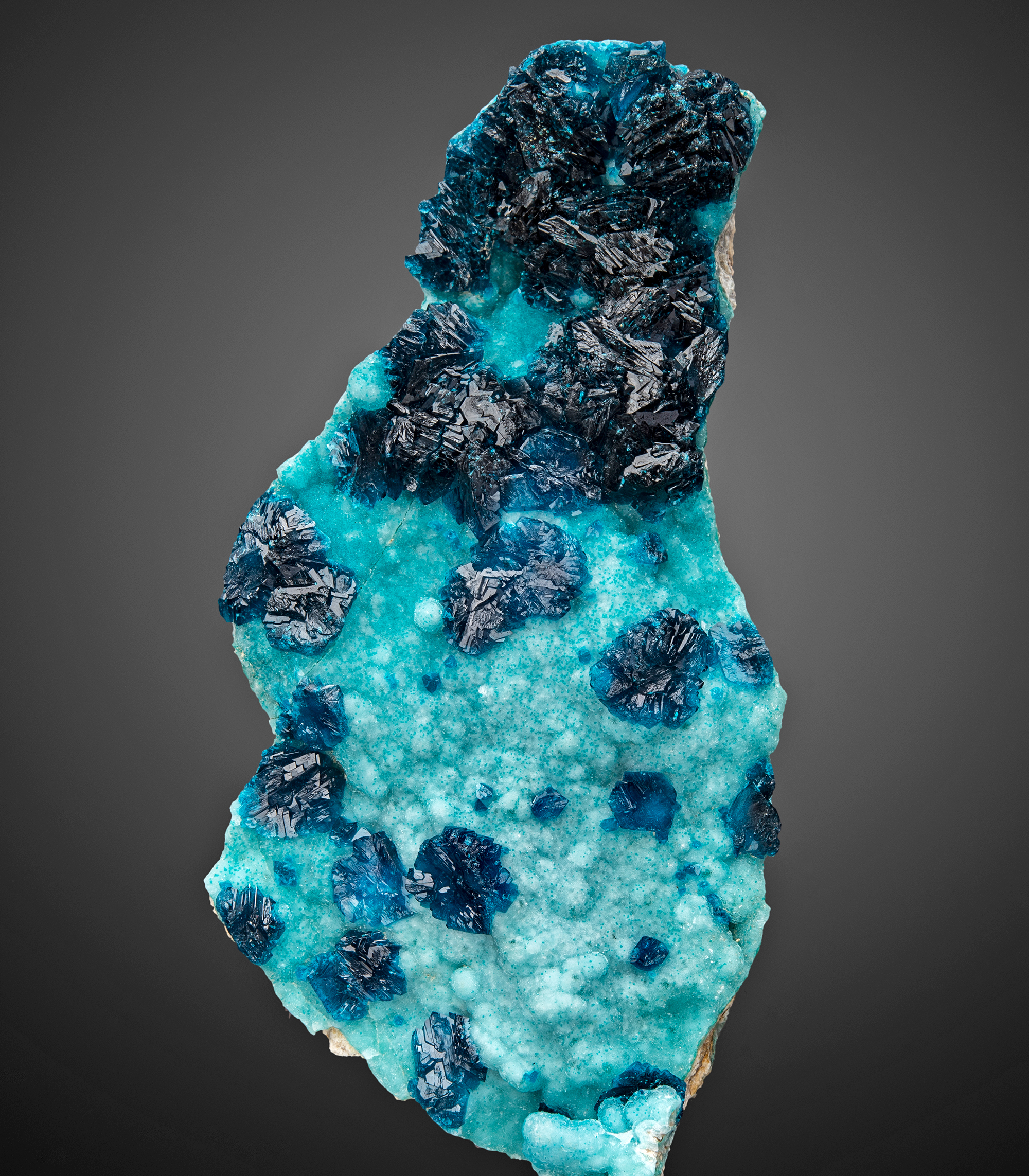
Flattened complex parallel intergrowths of skeletal crystals of veszelyite on hemimorphite. Specimen 6 cm tall. M. Mauthner photo.
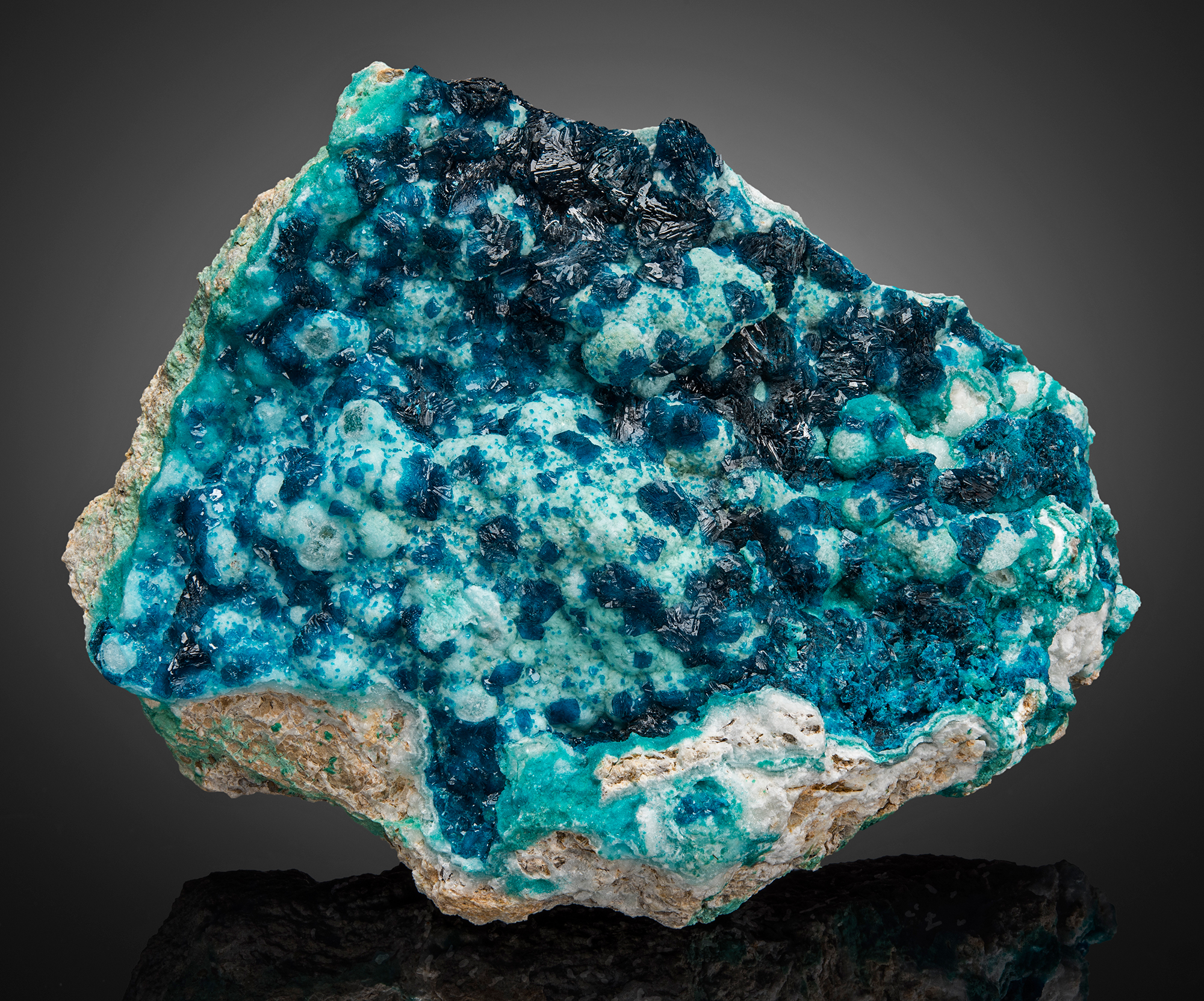
Dark blue veszelyite on bright blue hemimorphite, specimen 8.8 cm across. M. Mauthner photo.

Big specimen (17 cm across) specimen rich in complex veszelyite crystals on hemimorphite. J. N. Kl? photo.
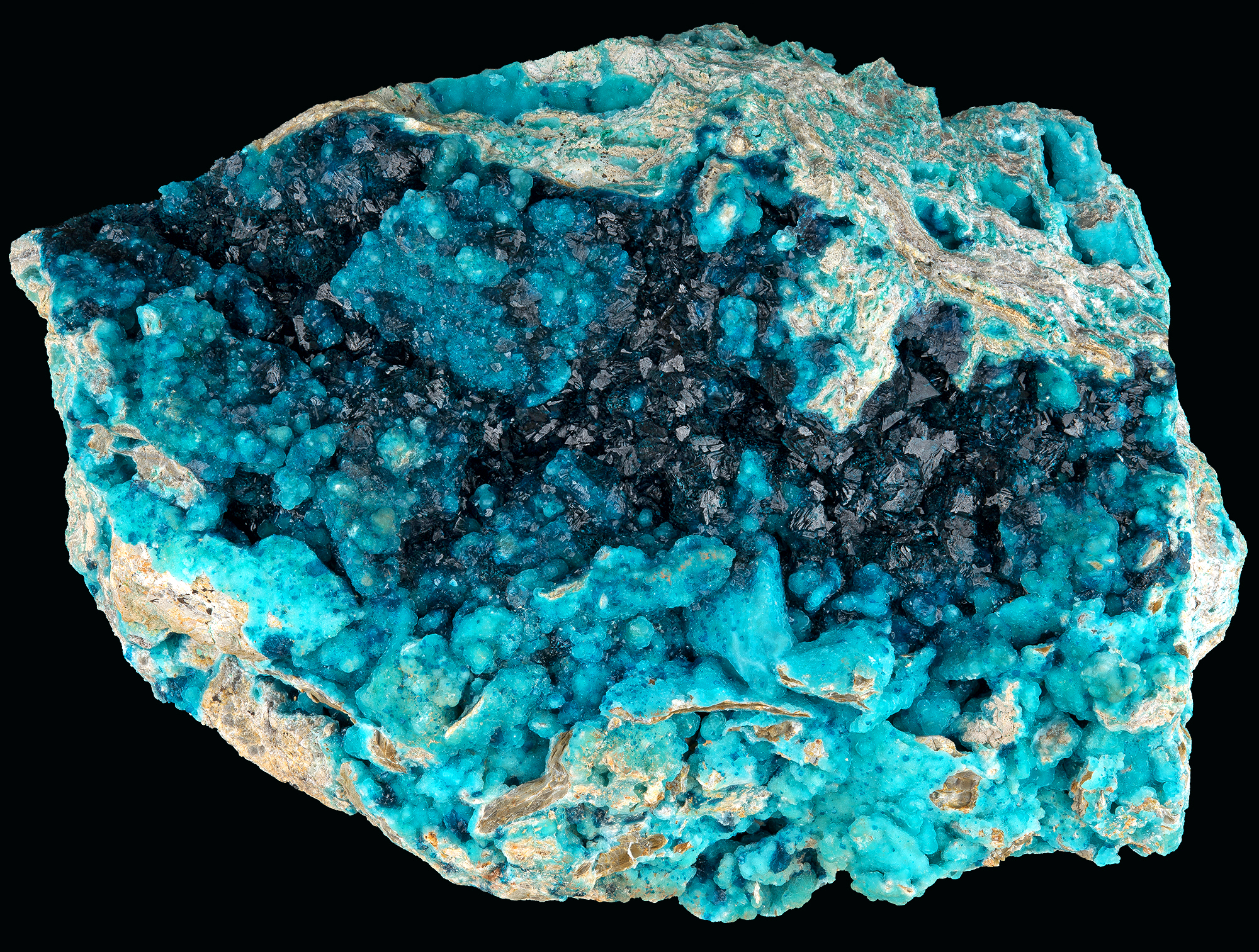
Spectacular specimen of well developed veszelyite crystals on hemimorphite, 18 cm wide. J. N. Kl? photo.
Same specimen in the video – well developed veszelyite crystals on hemimorphite, 18 cm wide.
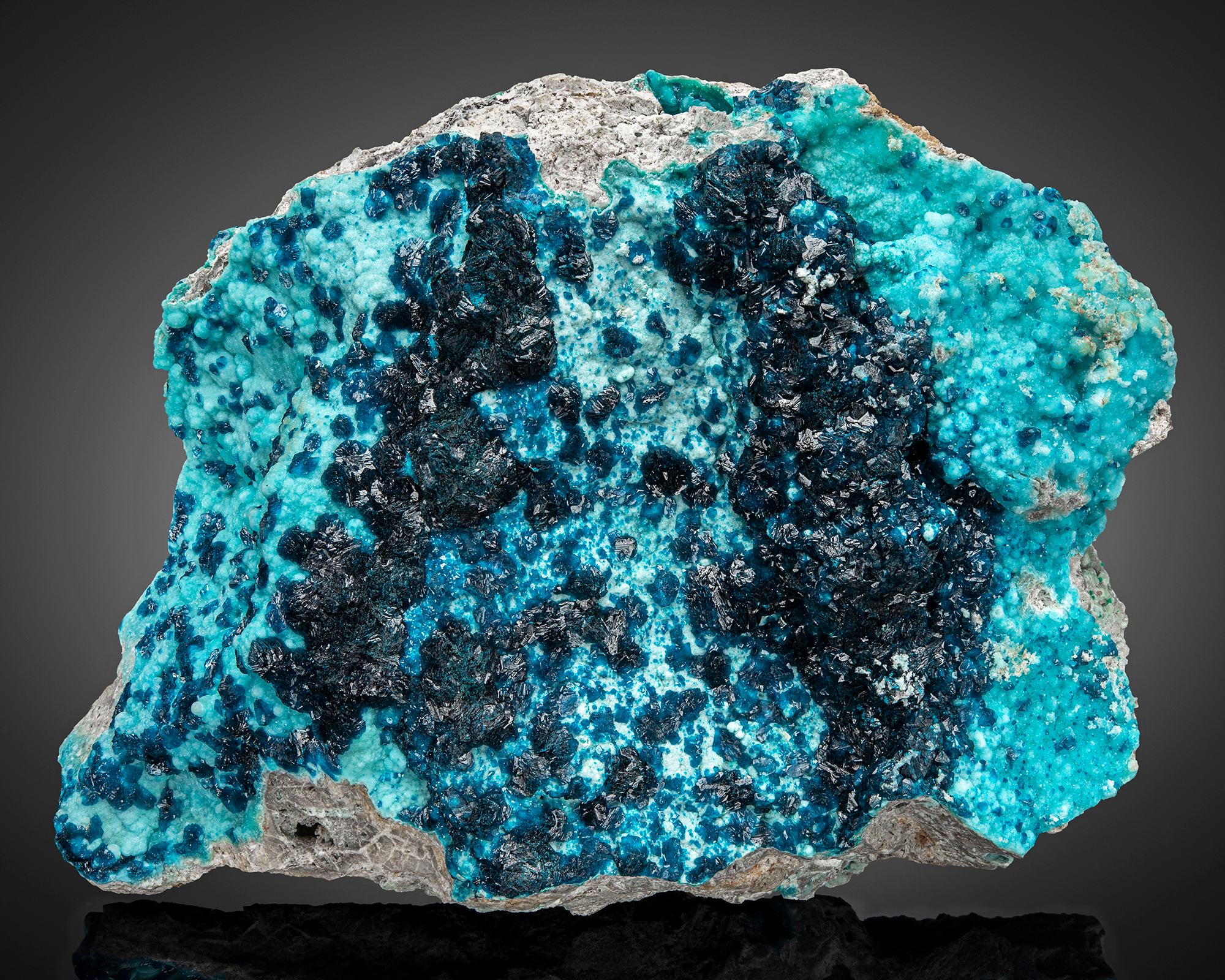
Spectacular specimen of veszelyite on hemimorphite, 16,5 cm wide. M. Mauthner photo.
Same specimen in the video – 16,5 cm wide.
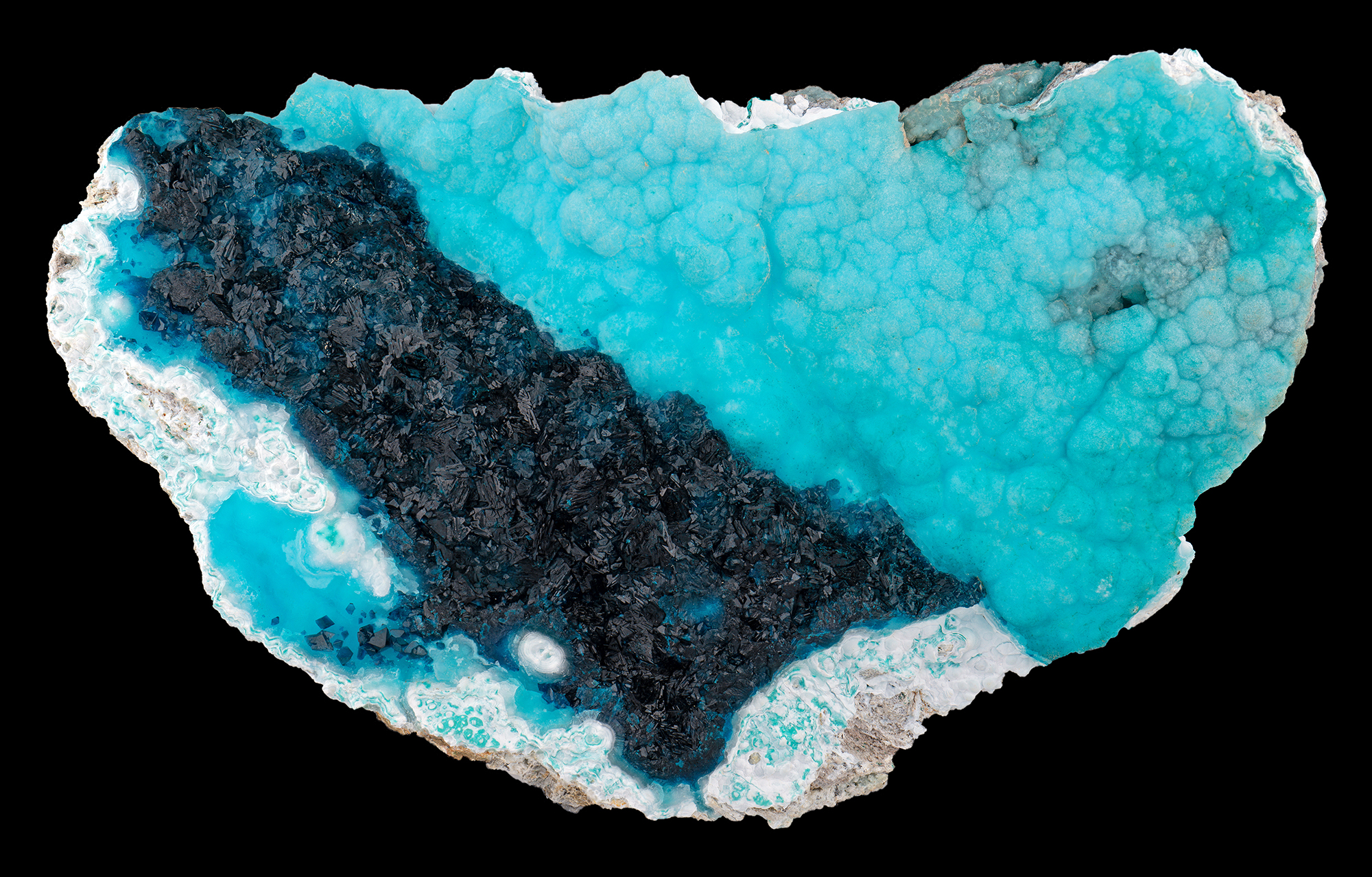
Spectacular specimen of veszelyite with striking blue hemimorphite, 16 cm wide. J. N. Kl? photo.
Same specimen in the video – veszelyite with striking blue hemimorphite, 16 cm wide.
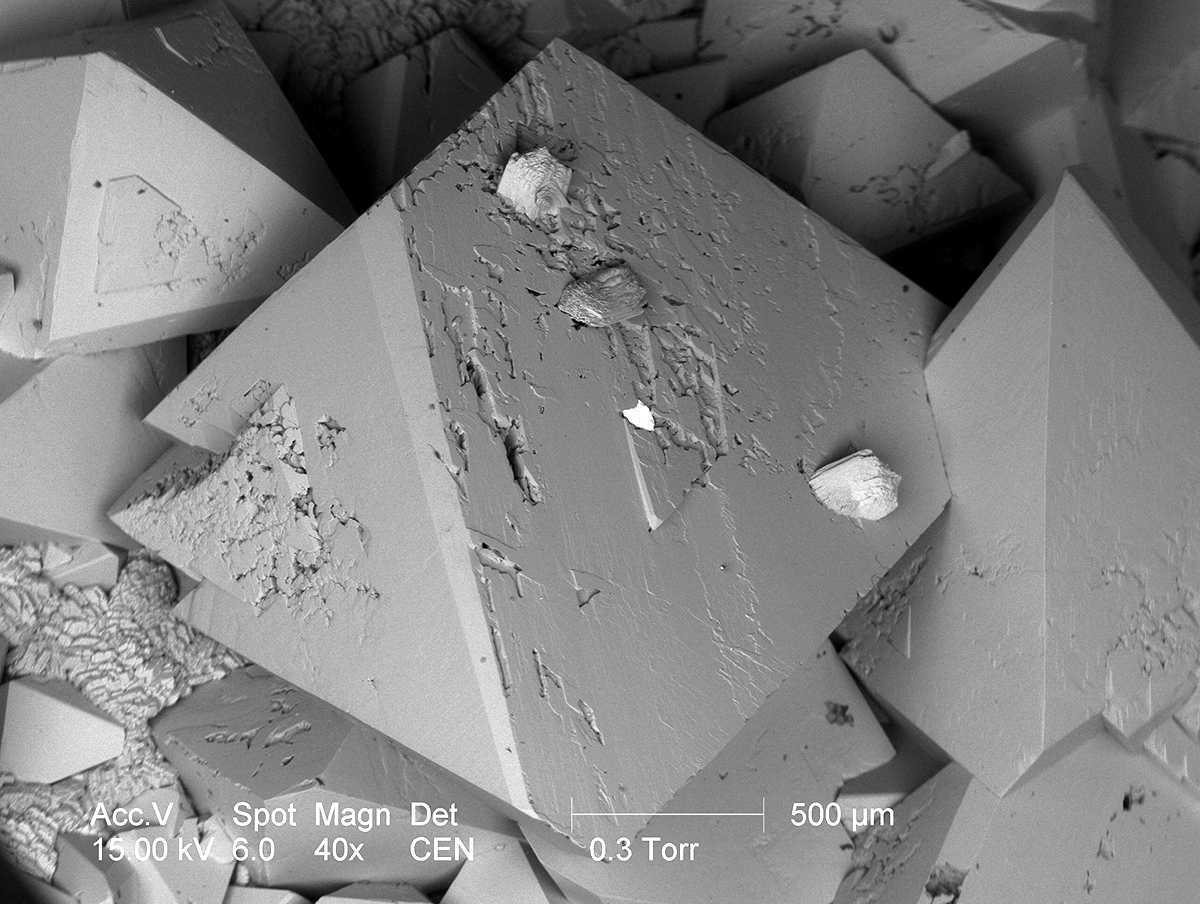
Scanning electron microscope image of the veszelyite crystals with small zincolibethenite aggregates growing on them. Note the first stages of the sceletal growth.
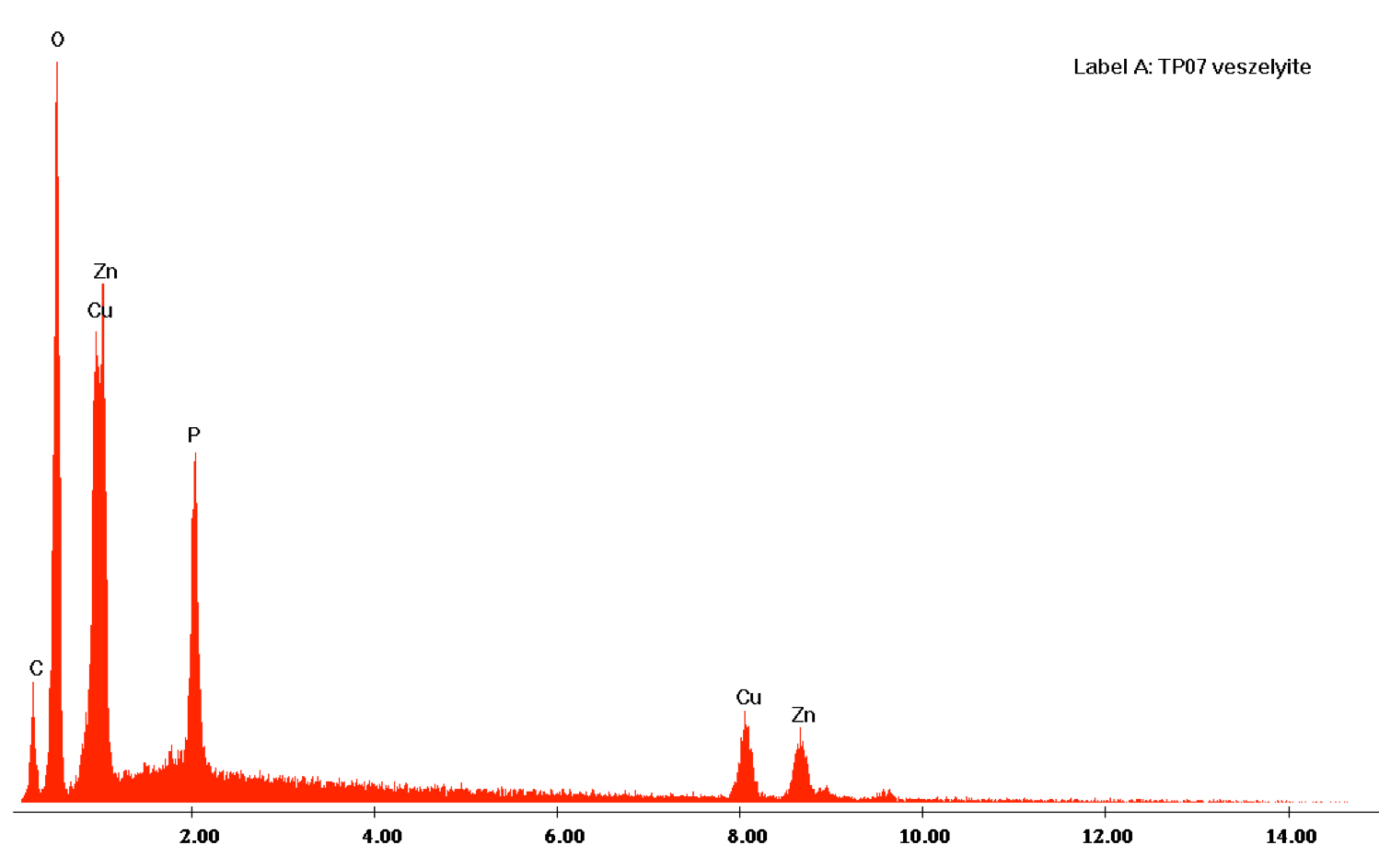
EDS spectra confirming dark blue crystals from Palabanda as veszelyite.
ZINCOLIBETHENITE CuZn(PO4)(OH)
Zincolibethenite is a common species in hemimorphite zone, and it occurs in two generations. The older one is usually embedded or occurring on older layers of hemimorphite, and formed as crusts. The second generation occurs as microscopic aggregates intergrown with the last stages of veszelyite growth. Visually zincolibethenite is the greenest of all mineral species present in the hemimorphite zone.
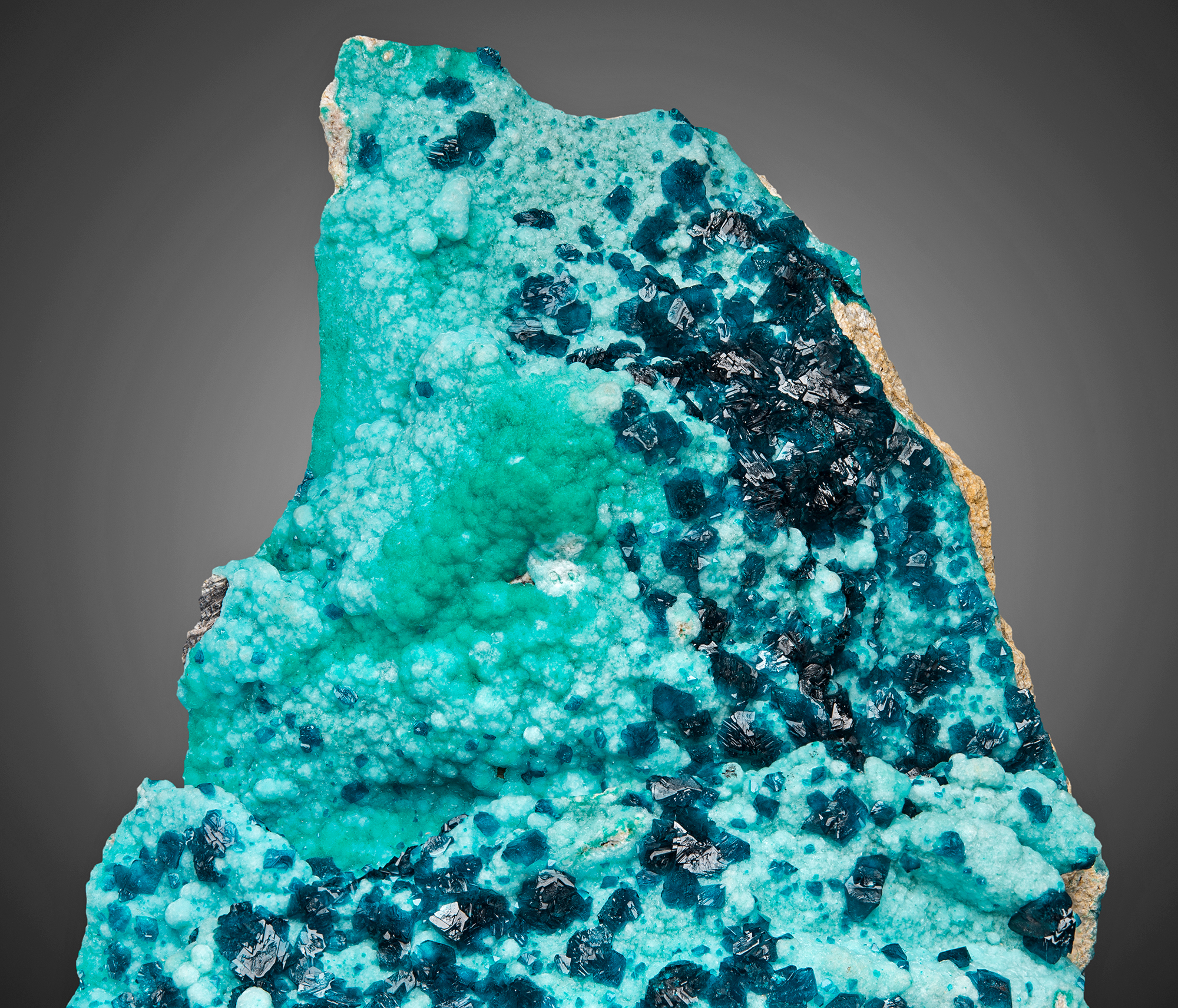
Green zincolibethenite (in the center) growing on the blue hemimorphite. Specimen 7 cm wide. M. Mauthner photo.
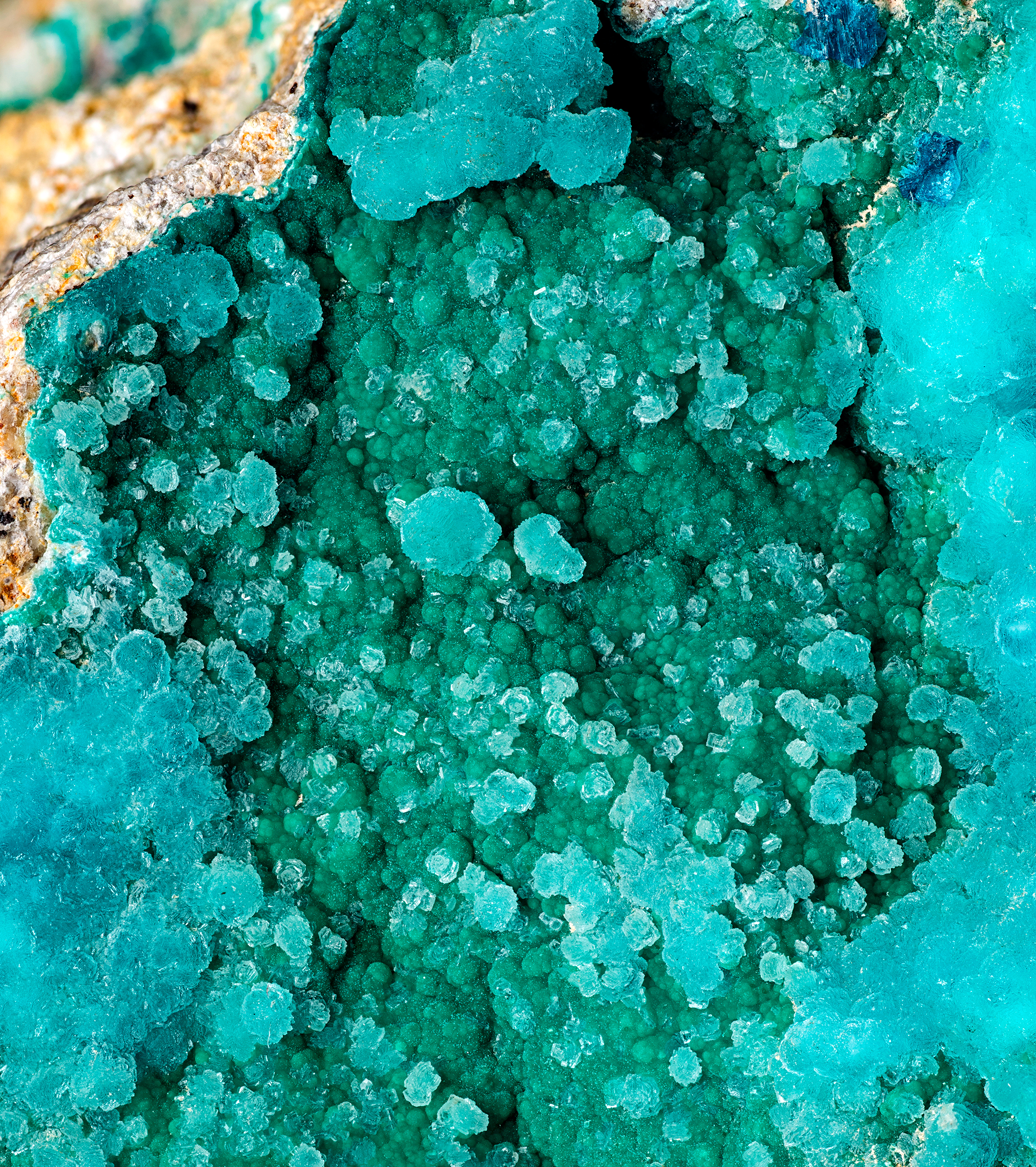
Green zincolibethenite partly overgrown by blue hemimorphite. Field of view 4 cm. M. Mauthner photo.
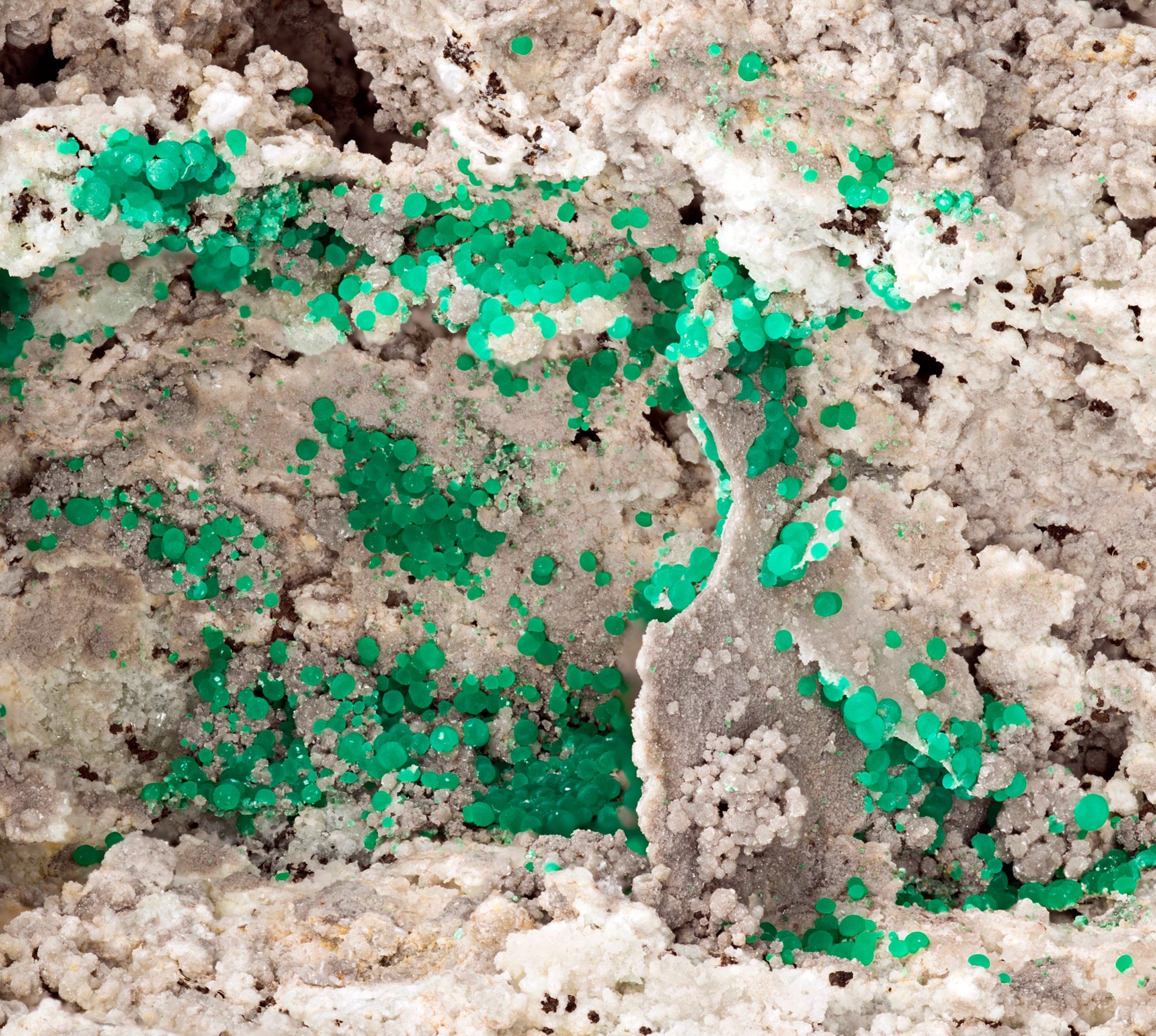
Spheroidal aggregates of zincolibethenite. Field of view 2 cm. M. Mauthner photo.
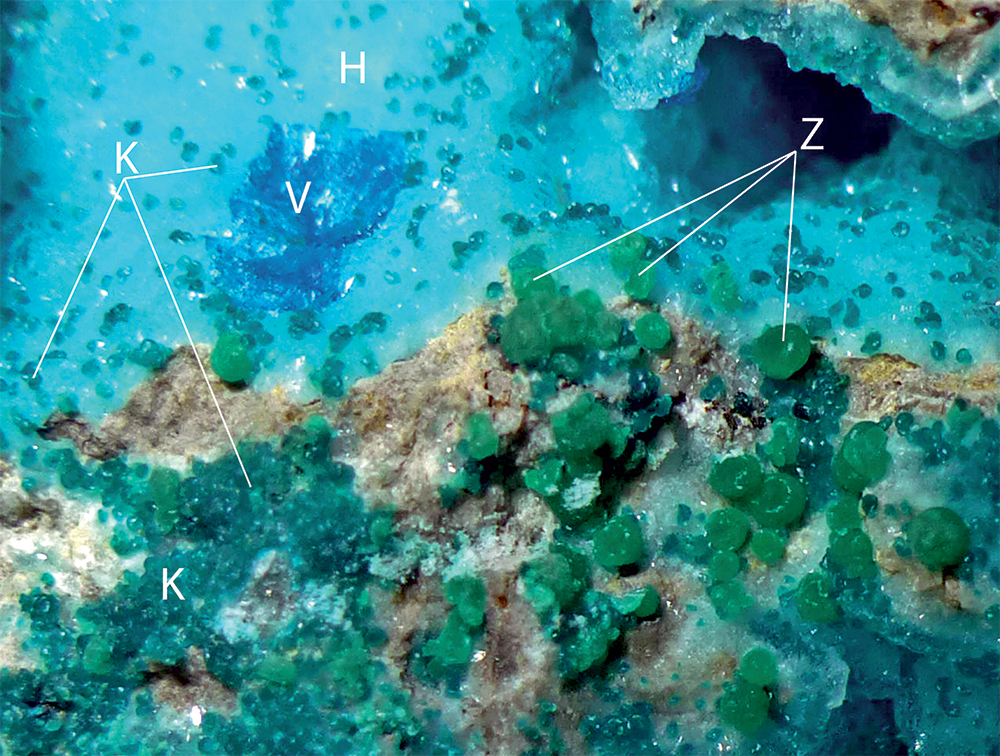
Green spheroidal zincolibethenite (Z) on blue hemimorphite (H) with blueish-green kipushite (K) and blue veszelyite (V). On some specimens macroscopic differentiation of all blue-green minerals is very difficult. E. Sze??photo.
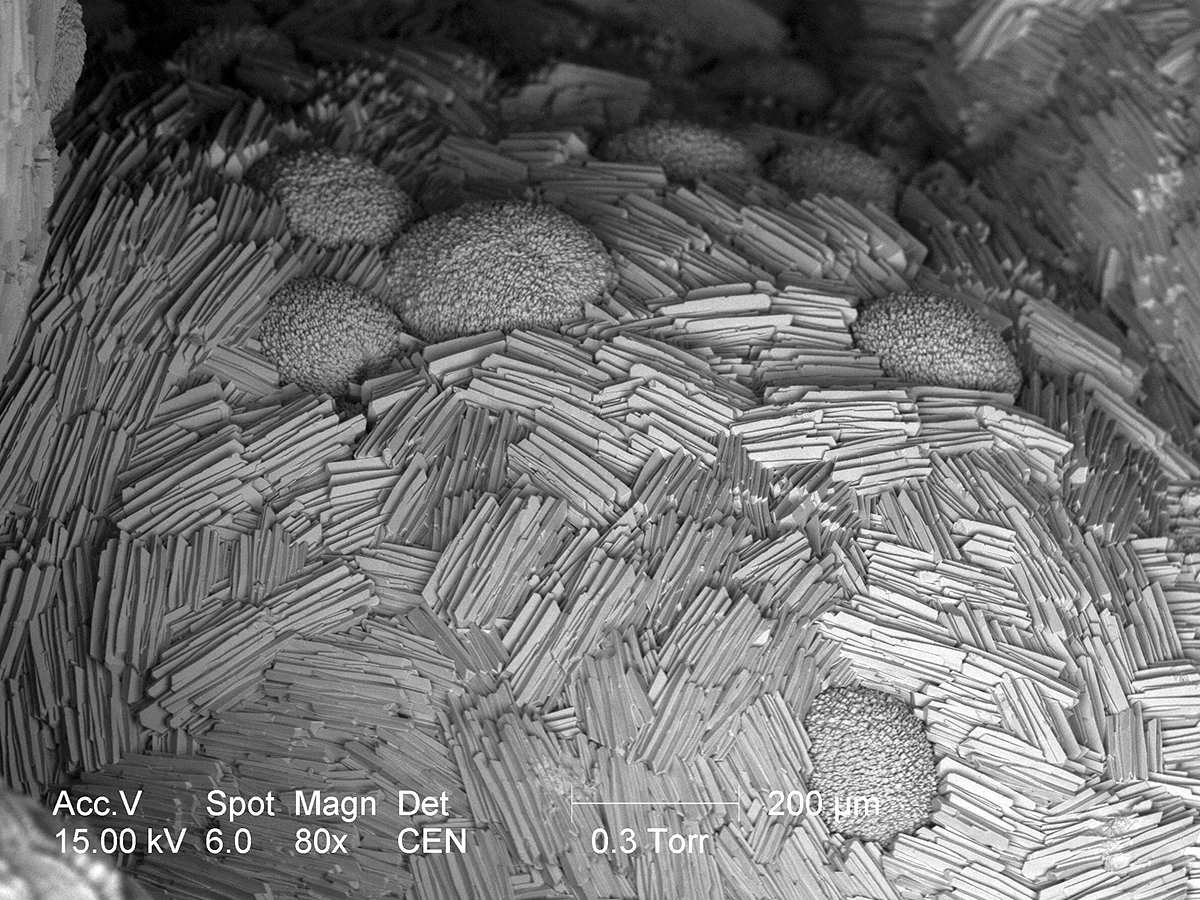
Scanning electron microscope image of the aggregates of zincolibethenite overgrown by hemimorphite.
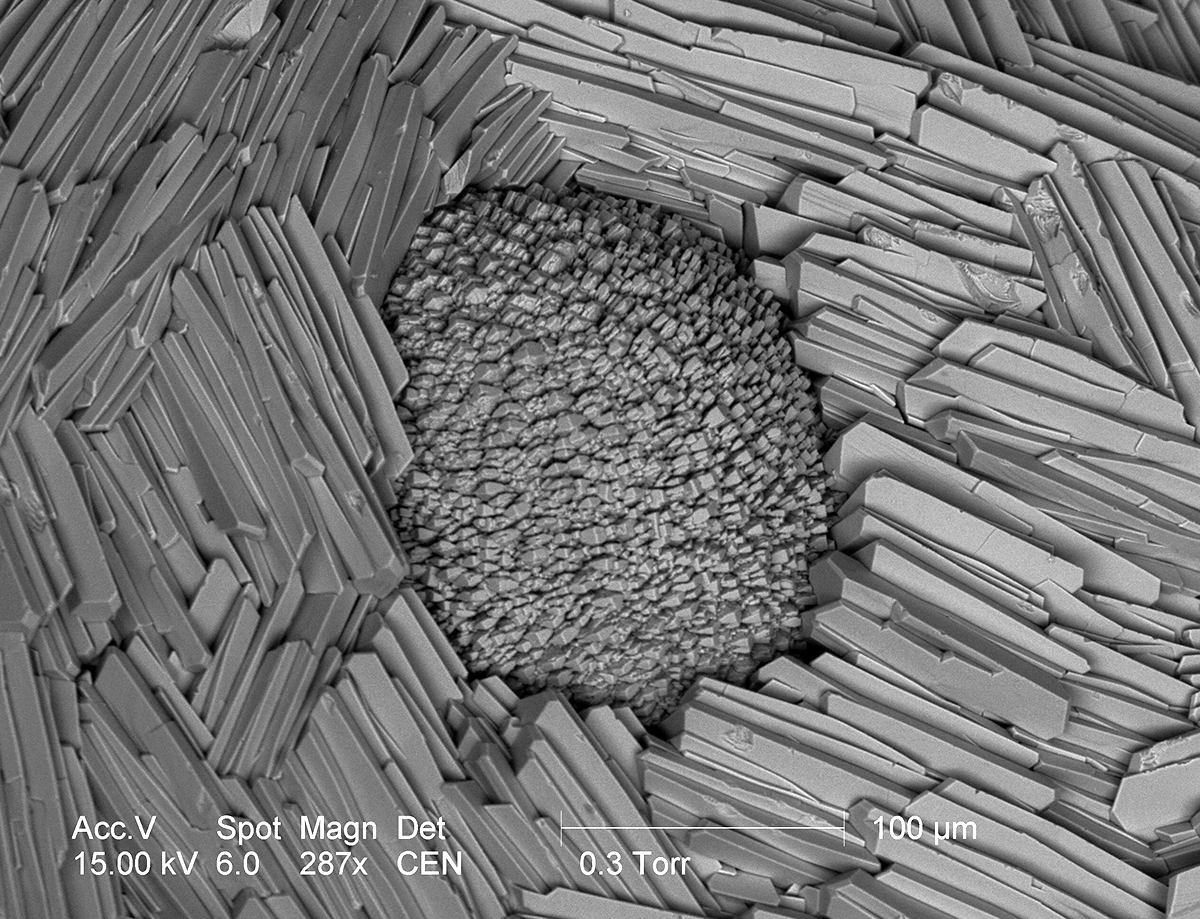
Scanning electron microscope image of the aggregates of zincolibethenite overgrown by hemimorphite.
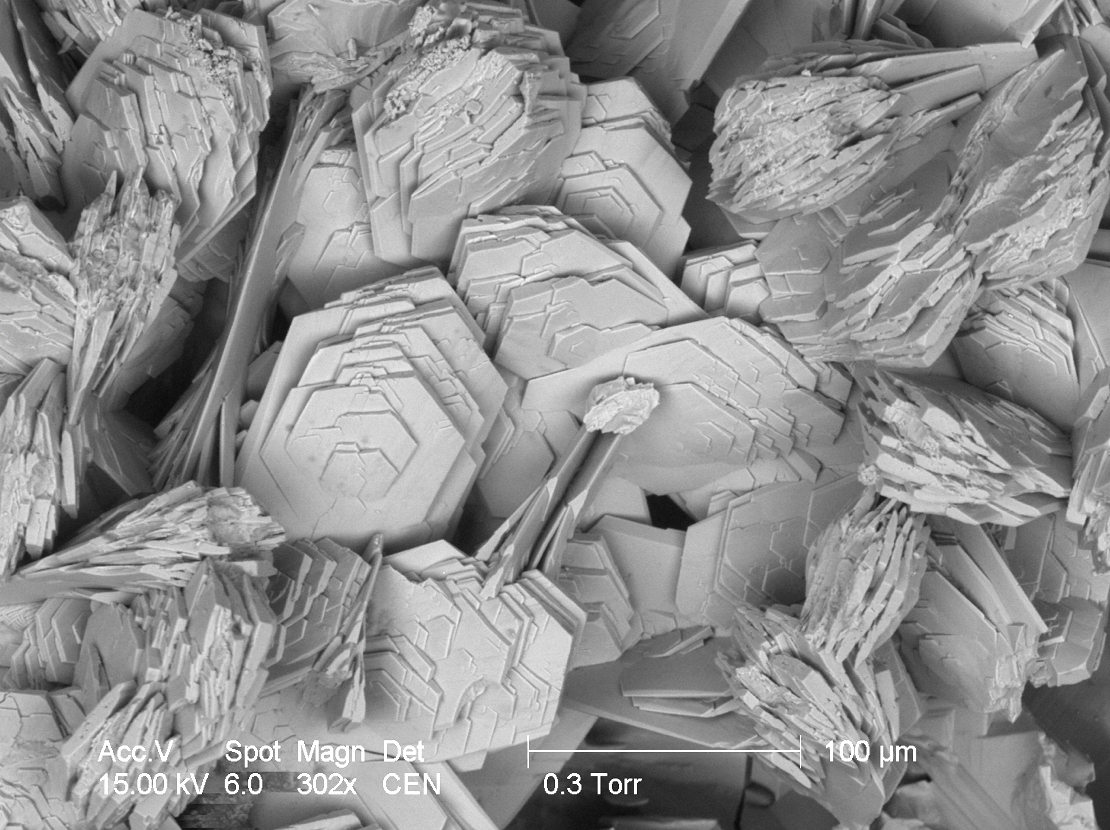
Scanning electron microscope image of the zincolibethenite crystals.
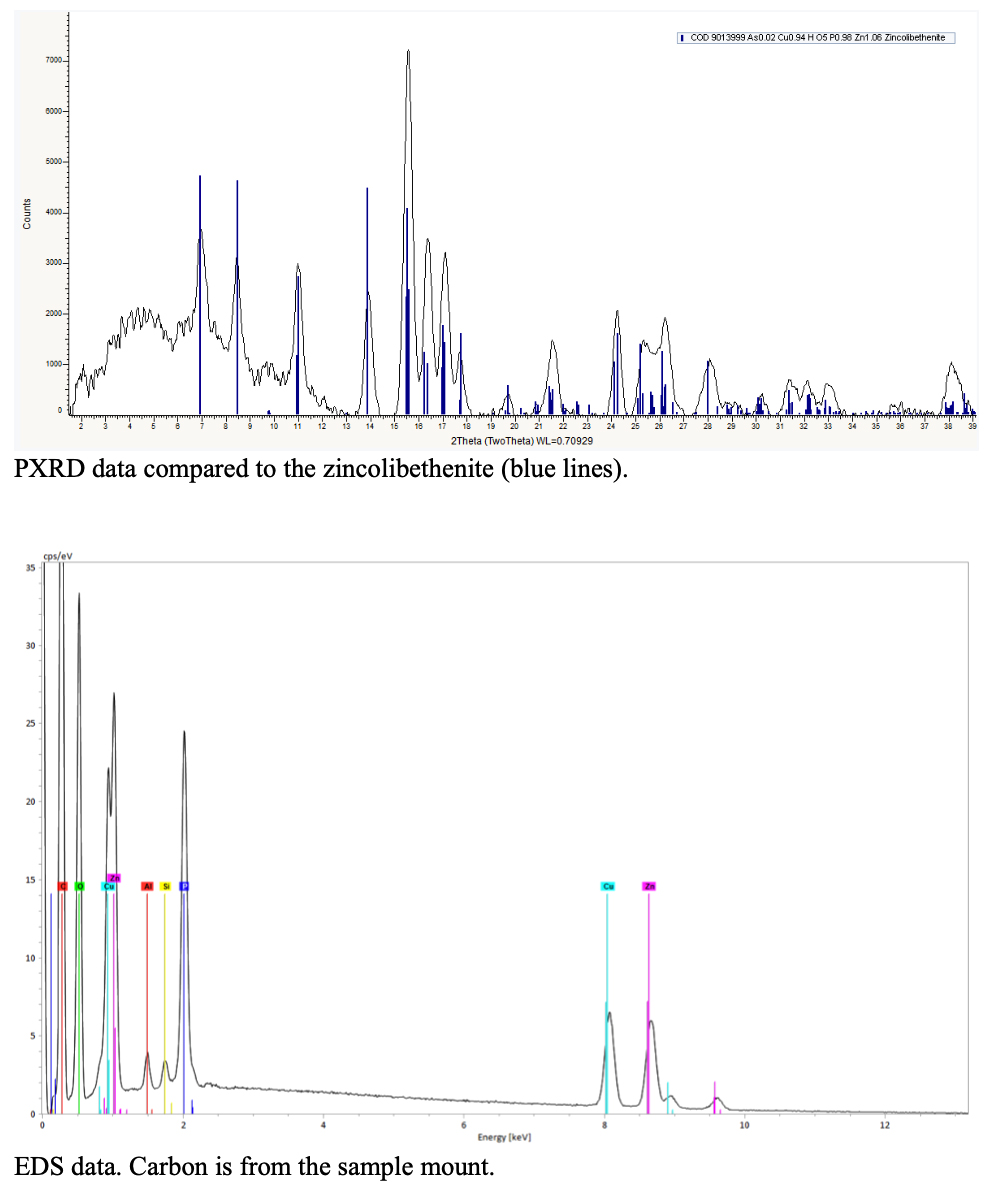
XRD and EDS spectra confirming the presence of the zincolibethenite in Palabanda.
CONCLUSIONS
The Republic of the Congo is a country which for sure will produce specimens from “classic” locations, as well as surprise collectors with new discoveries in the future.
The Palabanda quarry, as long as it remains abandoned, will produce only a small number of specimens collected by the local ore diggers. Although the veszelyite zone appears to be exhausted at this point, we cannot exclude that similar mineralization will be found in other places in the quarry or in the area.
Veszelyites from Palabanda are for sure an important find for the country, but also are some of the best specimens of this species known worldwide. In terms of the volume of the specimens and colorful association with hemimorphite and other phosphates they might be considered the world’s best.
Acknowledgements
Author would like to thank to dr Eligiusz Sze??and prof. John Rakovan for analyses and discussion and to prof. John Rakovan for the correction of the text.
| Comments |
| Fantastic article! Thanks so much for sharing this and your other collecting adventures. |
| David Dinsmore |
| 2020-10-12 21:02:01 |
| Awesome and comprehensive report.Thank you. Phillip@rapidsport and minerals. Cape Town. |
| Phillip Gray |
| 2020-10-12 22:12:49 |
| Congratulations on a superb article on the frontier. Well done, Tomek, and please extend my congratulations to your entire crew! Thank you for taking us on a virtual journey! |
| Tony L Potucek |
| 2020-10-13 02:17:54 |
| Fantastic..Great work.. 2020-10-1220:12:50 |
| Rocko Rosenblatt |
| 2020-10-13 02:51:55 |
| Great read. Shows that a great deal of time / effort and some luck is needed to find new material. I would have had to think twice before going into some of those mines. Great to see the local assistance provided. Thank you for the very informative report. Cheers Keith |
| keith compton |
| 2020-10-13 03:04:35 |
| An absolute joy to read! Thank you so much for sharing this. |
| Darren Court |
| 2020-10-13 03:21:15 |
| magnifique reportage et découverte |
| Alain Guillet |
| 2020-10-13 07:49:26 |
| Fascinating and beaitiful. Thank you! |
| Ron Jacobson |
| 2020-10-13 07:59:46 |
| very interesting read and absolutely stunning specimens ! |
| laurent jouffret |
| 2020-10-13 09:31:47 |
| A great read (as usual)! Congrats! |
| Roger Lang |
| 2020-10-13 10:01:06 |
| A wonderful, very informative write up and superb specimens. I thoroughly enjoyed reading it. |
| Gary Morse |
| 2020-10-13 20:52:42 |
| Very nice article. Thanks for the information on the locality and documenting it with great photos of the specimens recovered. |
| Doug Rambo |
| 2020-10-14 03:47:26 |
| Just picked one up! Really fantastic report on the new find. |
| Tama Higuchi |
| 2020-10-14 17:47:30 |
| Fantastic finds! As always, I thoroughly enjoyed reading the article, and I appreciate the effort you put into sharing the adventure along with the specimens. |
| Jonathan Woolley |
| 2020-10-14 20:30:46 |
| Amazing report and finds, Tom :-) |
| Petr Gadasa |
| 2020-10-15 12:29:25 |
| Congrats Tom! Awesome! I have been in the country almost 1 year but never got the opportunity to do it! Should be possible in a not so far future! |
| Nicolas Born alias Nicolas-geo |
| 2020-10-16 02:13:07 |
| Great article, well written with good photos related to the text. Congratulations on a successful expedition to deep Africa. Thanks for sharing with the mineral community! |
| JR in WV |
| 2020-10-16 17:25:18 |
| Brilliant stuff well done, like being in the Congo with you, keep up the good work. |
| Martin Watkins |
| 2020-10-17 02:39:13 |
| What an amazing adventure. Thanks for sharing your story! |
| Eugene De Guzman |
| 2020-11-25 06:57:19 |
| Wow, what an epic trip. The Congo looks crazy!!! Well worth it in the end. |
| Em and Dab |
| 2020-12-11 23:16:20 |
| Well done team, comprehensive coverage, what an adventure! Dr Paul Millsteed Broken Hill Australia. |
| Paul Millsteed |
| 2021-01-29 01:10:58 |
| Really fantastic, very well done work, perfectly documented and amazing finding. Thanks a lot for sharing. Mario |
| Mario Lazzerini Denchi |
| 2021-02-02 15:46:50 |
| thank you Tom and your team for this excellent report which allows us to discover an unusual mineralogy! |
| olivier bernard |
| 2021-02-03 13:37:44 |
| Really enjoyed this presentation, just love the specimens right up my street. |
| Steve Rust |
| 2021-04-07 20:46:21 |
| Très beau travail, superbe documentaire qui prouve que notre bonne vielle terre peut encore nous émerveiller. |
| Michut Regis |
| 2021-05-02 00:25:10 |
| Great article, Tomek! I appreciate the comprehensive mixture of everything from regional geology, mineral analyses, and the local people and working conditions. Every article on the source of specimens should be like this. |
| Alfredo Petrov |
| 2022-08-25 23:52:12 |
| Super interesting article. Many Thanks. |
| Thomas Neenan |
| 2022-09-12 15:48:23 |
| Moc krásná prezentace, parádní....gratuluji... |
| Marcel Vanek |
| 2022-10-14 17:17:38 |
| Thanks for publish this journey. I enjoy to view this. |
| Dharmawan |
| 2024-03-11 02:12:46 |
| How do you left the congo with those minerals? |
| Teo |
| 2025-10-02 18:13:59 |
NEW ARTICLES
TRAVELS & ARTICLES
- Mineral notes: Boltwoodite from Goanikontes, Namibia
- Pyrite find in Finland
- Mineral notes: New zircons and pyrochlores from Morocco
- Mineral notes: New natrolites from Morocco
- Mineral pottery by Dr. Justyna Domańska-Siuda
- Calcites from Malaysia
- Veszelyites and other minerals from Congo
- Travelling through Arizona & New Mexico, USA
- Halites from the Solno Salt Mine, Poland
- Secondary minerals from Maramureș, Romania
OUR PUBLICATIONS
- "Fluorites from Taourirt, Morocco" in Mineralogical Almanach
- "Calcites from Grabiszyce, Poland" in LRM 2018
- "Baryte" article in the extraLapis
- MINERALS - The Collectors Newspaper #9
- MINERALS - The Collectors Newspaper #8
- Solno halites article in the Mineralogical Record
- MINERALS - The Collectors Newspaper #7
- MINERALS - The Collectors Newspaper #6
- Mibladen monograph in the Mineralogical Record
- African Secrets book
